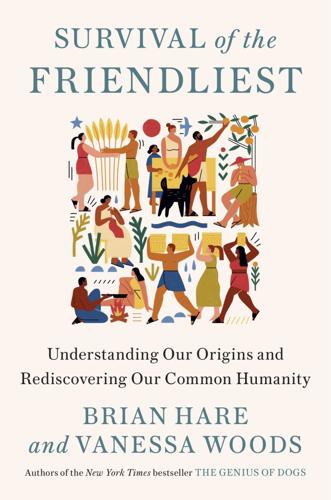
Survival of the Friendliest: Understanding Our Origins and Rediscovering Our Common Humanity
by
Brian Hare
and
Vanessa Woods
Published 13 Jul 2020
When I went to college at Emory, I discovered that exploring the animal mind was a serious scientific endeavor. I began working with Mike Tomasello, a psychologist who was an expert on theory of mind in children. Mike’s experiments with babies connected their earliest theory of mind abilities with their ability to acquire all forms of culture—including language.4 Mike and I worked together for ten years, testing the theory of mind abilities of one of our two closest living relatives, chimpanzees. Before our experiments, there was no experimental evidence that any animal had theory of mind. But our research showed that the answer was more complicated. Chimpanzees had some ability to map the minds of others.
…
You could also help someone if they had been deceived.2 Pointing is the gateway to reading other people’s minds, to what psychologists call “theory of mind.”3 You will spend the rest of your life wondering what other people are thinking. The meaning of a hand brushed against yours in the dark. A raised eyebrow when you walk into a room. It will always be a theory, because you can never really know someone else’s mind. Other people have the same abilities you do and can feint, fake, and lie. Theory of mind allows us to engage in the most sophisticated cooperation and communication on the planet. It is crucial to almost every problem you will ever face.
…
You can teach only if you can remember what it is like not to know. The political party you vote for, the religion you follow, the sports you play, and every other experience that involves other people, living or dead, real or imagined, all rely on your theory of mind. It is also the soul of your existence. Without it, love would be a cardboard cutout of itself, because what is love without the magic of knowing someone else feels the way you do? Theory of mind is the delight of moments when you both see something, then turn to each other and laugh. It is the comfort of finishing each other’s sentences, and the peace in holding hands and saying nothing at all.
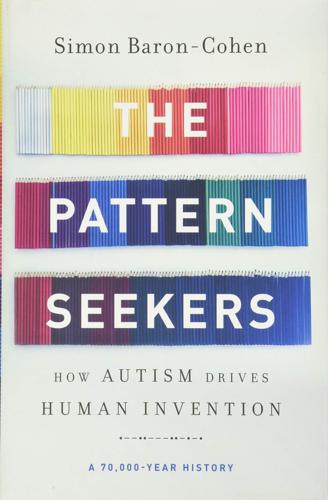
The Pattern Seekers: How Autism Drives Human Invention
by
Simon Baron-Cohen
Published 14 Aug 2020
But what we see in humans and no other species is the full Systemizing Mechanism, which drives the curiosity to ask questions and to experiment with variations in patterns, and the full Empathy Circuit, which includes a theory of mind. To see quite how revolutionary the Empathy Circuit was in the evolution of the human brain, it is useful to recap the main advantages conferred on us by a theory of mind. If someone has a theory of mind, and particularly the ability to imagine another’s beliefs, they should be capable of at least three skills that would have massively transformed their lives. First, a theory of mind allows for flexible deception, or trying to make someone believe something is true when it is not, which assumes an awareness that others have beliefs in the first place.
…
However, one might question whether it qualifies as an example of teaching, as it does not necessarily require a theory of mind. Moreover, if it were a marker of a theory of mind, we would see a far wider range of examples of teaching in meerkats and other species, as well as evidence of the teaching strategies being modified by the teachers in response to what the pupils need to know. And third, a theory of mind allows flexible referential communication because this involves understanding that your listener or your viewer knows that words (or paint marks on a cave wall) refer to something out there in the world.52 One of the earliest signs of a theory of mind and of flexible referential communication is when human children as young as fourteen months use the pointing gesture, as if to say (without words), “Look at that!”
…
Cognitive empathy is what primatologist David Premack called having a theory of mind and is what enables modern humans to navigate the social world. This is because cognitive empathy allows us to imagine what another person may be thinking or feeling about things in the world, and particularly what another person may be thinking about us. Having a theory of mind also means that you can reflect on your own thoughts and feelings—it enables self-reflection. Non-human primates such as chimpanzees, and likely other animals, may have elements of a theory of mind, such as being able to recognize another animal’s goals and desires, but there is still no strong evidence that, unlike us, they can imagine another animal’s beliefs.48 The Empathy Circuit resides in a network in the human brain of at least ten brain regions, including the ventromedial prefrontal cortex and the amygdala.
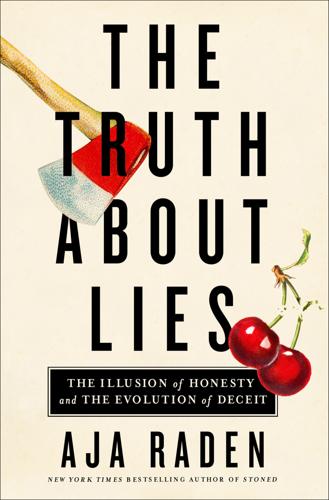
The Truth About Lies: The Illusion of Honesty and the Evolution of Deceit
by
Aja Raden
Published 10 May 2021
Since then, however, the term theory of mind has expanded to describe the ability of an individual to take that self-awareness (hey, that’s me in the mirror) and sense of objective reality (there’s some schmutz on my forehead) and to understand, first, that he or she not only exists as an individual, like Sarah, but also has individual perceptions, thoughts, feelings, and beliefs that cause or can predict reactions to information and, second, that other people also have individual perceptions, thoughts, feelings, and beliefs, which similarly create and can predict their reactions to information. Shorthand: theory of mind means the ability to think about what someone else might be thinking. Theory of mind describes the facility to ascribe states of mind or intentions to both oneself and to everyone else. Or as A. M. Leslie defines it in the International Encyclopedia of the Social and Behavioral Sciences, “Theory of Mind concerns our ability, not simply to have beliefs as such, but to have beliefs about mental states, including the recursive ability to have beliefs about beliefs.”13 This cognizance that others perceive, think, feel, and even lie just as we do lends itself to a sense of objective reality assumed by each individual but tacitly agreed upon by all.
…
You develop a theory of mind, I use it to deceive you. The capacity to lie is ultimately as important to survival as the ability to ward off predators or exploit prey’s weaknesses. And just as teeth led to scales, theory of mind begets lying. The cognitive and behavioral flaws that result in deceit are not flaws at all. No more are the cognitive biases that allow us to be deceived. Both are intrinsic mechanisms of thought and hard-won adaptive advantages in that very arms race. Lying, in various ways, and possessing the ability to believe those lies are necessary. Theory of mind leads us to assume we’re all experiencing the same reality, made up of objectively true facts that we all experience the same way.
…
What is remarkable is that you also assume—you absolutely believe—that everyone else who sees the wall automatically assumes the same “facts,” and accepts these same facts as objectively true. This active engagement of theory of mind—my thinking about what you see or believe or know about the same wall—is referred to as “mentalizing,” a capacity that includes “the critical ability to make inferences about the intentions of other people and their beliefs and to infer whether the emotions or other states signaled by social cues are or are not an accurate reflection of the actual emotional state of the individual”—in other words, to consider whether others might be lying to us.14 Theory of mind allows us to think about what another person might think, know, assume, or feel.
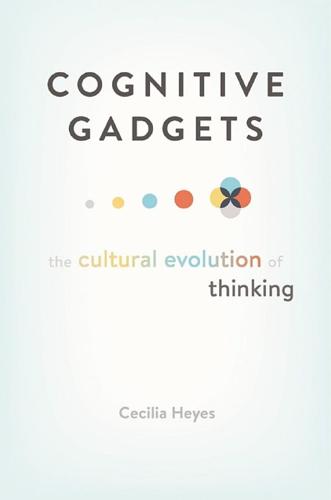
Cognitive Gadgets: The Cultural Evolution of Thinking
by
Cecilia Heyes
Published 15 Apr 2018
The fitness of a variant gadget can be measured by comparing the number of groups in which all or most heads carry the focal variant, with the number of groups in which all or most heads carry an alternative variant (or just the relative proportions of each variant across the whole population’s heads—see Chapter 9). For example, although each head contains only one theory of mind, the success of an “honor theory” of mind—a theory in which the desire to retaliate against insults is an important source of motivation—can be measured by comparing (other things being equal) the number of groups in which all or most people carry the honor theory, with the number of groups in which all or most people carry a theory of mind in which honor plays little or no part. Predominantly vertical inheritance may occur when the development of a cognitive mechanism is almost wholly dependent on social interaction in infancy, and in cultures where infants interact almost exclusively with their biological parents.
…
The distributed pattern is likely to be especially common for social cognitive mechanisms, like mindreading, because these mechanisms are not only acquired through social interaction, but used and broadcast in social interaction throughout the lifespan. For example, in cultures where mindreading is valued (Duranti, 2008), adults broadcast the workings of their theory of mind when they comment on the thoughts and motivations of others. Because mindreading has a regulatory as well as a predictive function (McGeer, 2007), these broadcasts are likely to fine-tune listeners’ theories of mind, and thereby to increase the similarity between the theories held by members of the same social group. In contrast, causal understanding—a mechanism that represents certain kinds of interactions between physical objects—may depend on social interaction for its development, but causal understanding is not used or broadcast as intensively as mindreading in social interaction throughout life.
…
The role of control functions in mentalizing: Dual-task studies of theory of mind and executive function. Cognition, 107(2), 663–672. Burkart, J. M., Hrdy, S. B., and Van Schaik, C. P. (2009). Cooperative breeding and human cognitive evolution. Evolutionary Anthropology: Issues, News, and Reviews, 18(5), 175–186. Burnham, D., Kitamura, C., and Vollmer-Conna, U. (2002). What’s new, pussycat? On talking to babies and animals. Science, 296(5572), 1435–1435. Burrow, C. (1993). Epic Romance: Homer to Milton. Oxford: Oxford University Press. Butterfill, S. A., and Apperly, I. A. (2013). How to construct a minimal theory of mind. Mind and Language, 28(5), 606–637.

In Our Own Image: Savior or Destroyer? The History and Future of Artificial Intelligence
by
George Zarkadakis
Published 7 Mar 2016
My son had acquired what psychologists call ‘theory of mind’. Most humans14 have it. In fact, most humans at the age of four start believing that not only other humans but animals and objects have minds too: dolls and toy soldiers are very much alive in a child’s imagination. However, according to Wynn and others, our species took time to develop theory of mind. It is very possible that it was the acquisition of theory of mind that gave rise to the Upper Palaeolithic transition. English psychologist Nicholas Humphrey15 elaborated further on the evolutionary rationale for theory of mind. He argued that when individuals live within a group and enter into a diverse set of cooperative, competitive and mutualistic relationships, individuals with the ability to predict the behaviour of others will achieve the greatest reproductive success.
…
This social selection process will be reinforced further by the very nature of cognitive autopoiesis, which produces closed systems for which the environment acts merely as a trigger for internal processes.26 British psychologist Simon Baron-Cohen has hypothesised that autism correlates with an absence of theory of mind.27 Viewed from a cybernetic point of view, this suggests that there are many alternative ‘attractors’ for cognition in the brain. Not all types of cognition arrive at the same point, where we get theory of mind. Most of us have theory of mind because of the selection processes that we saw in Part I of the book, when I discussed how our species evolved general-purpose language and general intelligence. However, throughout our long journey as a species there have been many of us whose cognitive systems achieved dynamic equilibrium at points where theory of mind was either absent or wanting.
…
His definition of consciousness – ‘I think therefore I am’ – is a fine example of recursive thought: the mind exists because it can think itself. We bootstrap ourselves in existence every time, out of nothing, by self-reflection. We saw in Part I how theory of mind is one of the most fundamental cognitive characteristics of the typical human mind. Theory of mind is also recursive. It gives us the ability to conceive our minds and the minds of others. It also allows us to perform mental time travel: thanks to theory of mind we can bring into our present consciousness events that took place in the past, as well as imagine ourselves in various, hypothetical future situations. The evolutionary advantages of recursive thinking are enormous.

Advances in Artificial General Intelligence: Concepts, Architectures and Algorithms: Proceedings of the Agi Workshop 2006
by
Ben Goertzel
and
Pei Wang
Published 1 Jan 2007
For example, only humans are said to have a theory of mind in that we understand that other individuals may have different beliefs than our own, and reason accordingly. However, apes display behaviors indicating aspects of theory of mind; and plovers feign injury, limping off to distract a predator from their nest, only when the predator seems to notice the nest. Thus plovers attend to the perception of the predator and modify their behavior accordingly. This ability requires subroutines on which any theory of mind must rely. This suggests that the human theory of mind is a complex modular program built on top of meaningful modules coded more explicitly in the genome, and that humans have been able to discover this more powerful program over generations, because we pass partial progress on.
…
Davidson [50], Dennett [51] and others support the common belief that theory of mind is dependent upon linguistic ability. A major challenge to this prevailing philosophical stance came from Premack and Woodruff [49] who postulated that prelinguistic primates do indeed exhibit “theory of mind” behavior. While Premack and Woodruff’s experiment itself has been challenged [52], their general result has been 188 B. Goertzel and S.V. Bugaj / Stages of Cognitive Development bolstered by follow-up work showing similar results such as [53]. It seems to us that while theory of mind depends on many of the same inferential capabilities as language learning, it is not intrinsically dependent on the latter.
…
This suggests that the human theory of mind is a complex modular program built on top of meaningful modules coded more explicitly in the genome, and that humans have been able to discover this more powerful program over generations, because we pass partial progress on. Bedtime stories and fiction are means of passing such programs on to children. Psychophysics experiments are consistent with this view, showing that children acquire theory of mind over a period of years. Thus this computational theory of mind, while it suggests that much of thought is coded in the genome, simultaneously suggests that most of the difference between human and ape cognition can be regarded as the product of better nurture. The key is that the program of mind is modular and hierarchic, and that the discovery of new modules is a hard computational problem.

Marriage and Lasting Relationships With Asperger's Syndrome: Successful Strategies for Couples or Counselors
by
Eva A. Mendes
Published 1 Sep 2015
A counselor can also help her to identify healthy boundaries and practice how to convey her needs in a way that is understandable to her NS partner. CHAPTER 6 EXPANDING THEORY OF MIND AND EMOTIONAL INTELLIGENCE Most smiles are started by another smile. FRANK A. CLARK In people who are at good at or skilled at interpersonal relationships, two capacities are very highly developed. One is Theory of Mind (TOM) and the other is emotional intelligence (EI). TOM could be considered a cognitive aspect of EI. Unlike their NS counterparts, individuals with ASD struggle with TOM and EI. What is Theory of Mind? Individuals with ASD tend to have weak TOM, meaning a relatively limited ability to “read” another person’s thoughts, feelings, or intentions.
…
Going hours, days, and weeks without any social contact with her partner might be normal for her. Even after her partner tells her that he needs more contact from her, she might find it challenging to text, email, or call. Even if her partner initiates contact, she may not reciprocate. Theory of Mind (TOM) A weak Theory of Mind (TOM), or challenges in reading his partner’s thinking-feeling state is why the partner with ASD isn’t always able to understand his partner wanting to spend time together. He might struggle to understand that his partner needs to fulfill her basic need for emotional connection by spending time with him.
…
Shore Acknowledgments Preface Terminology, Case Studies, and Strategies Introduction: Marriage and Lasting Relationships with Asperger’s Syndrome (Autism Spectrum Disorder) 1Pursuing a Diagnosis—or Not 2Accepting the Diagnosis 3Learning About and Understanding ASD 4Managing Anxiety, Depression, Anger, OCD, and ADHD 5Self-Exploration, Awareness, and Advocacy 6Expanding Theory of Mind and Emotional Intelligence 7Coping with Sensory Overload and Avoiding Meltdowns 8Meeting Each Other’s Sexual Needs 9Bridging Parallel Play 10Creating a Relationship Schedule™ 11Improving Communication 12Co-Parenting Strategies 13Prioritizing Self-Care for the NS partner 14Organizing, Planning, and Outsourcing 15Suspending Judgments and Managing Expectations 16Staying Motivated 17Neurodiverse Couples Counseling 18Every Neurodiverse Marriage is Unique Appendix I: The Appreciation and Gratitude Exercise™ Appendix II: The Walking in Your Partner’s Shoes Practice™ Appendix III: The Sensation-Emotion Awareness Practice™ Appendix IV: The Emotions List Appendix V: The Sensation-Emotion Awareness Chart™ Appendix VI: The Relationship Schedule™ Appendix VII: The Listen, Validate, and Compliment Strategy™ Appendix VIII: The Marital Satisfaction Scale References Index FOREWORD As an adult with autism, married to a woman who is not on the spectrum, I am honored to write the foreword to this groundbreaking book that fills a yawning gap in the literature of supporting long-term relationships where one of the couple has autism.
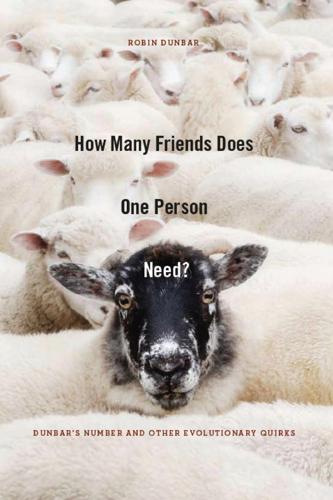
How Many Friends Does One Person Need? Dunbar’s Number and Other Evolutionary Quirks
by
Robin Dunbar
and
Robin Ian MacDonald Dunbar
Published 2 Nov 2010
This ability to reflect on others’ mind states is a capacity that children develop at around the age of four or five years, when, in psychologist-speak, they acquire theory of mind. A child aged three to four is a skilled ethologist: it knows how to manipulate others. Asked who has eaten the chocolate in the fridge, it knows that if it says in a very convincing way that it was the little green goblin from down the lane who hopped over the window sill, [Page 175] there is every chance an adult will believe it. But it does not really understand why this ruse works, and it certainly doesn’t appreciate that the chocolate smeared around its face gives the game away. But with theory of mind in its mental toolkit, it knows how to manipulate others’ beliefs about the world.
…
In the social context, this ability to stand back from the way things are is referred to as possessing a ‘theory of mind’. It underpins our ability to understand another person’s beliefs and the way we use this knowledge to exploit and manipulate each other. Children do not possess it at birth: they acquire the ability at around four years of age. In fact, some humans (such as autistic people) never acquire it. Neither sophisticated lying nor fictive play are possible until a child has acquired theory of mind. Without it, fictional literature is impossible and both science and religion, with their need to imagine impossible worlds, are out of the question.
…
As we saw earlier, recent work by developmental psychologists has suggested that human children lack this capacity (known as ‘theory of mind’) when they are born, but develop it quite suddenly at around four years of age. Prior to this, children do not realise that other individuals can hold a belief about the world that is different from their own. If they know that someone has eaten the sweets in the tin, then they assume that everyone knows that. But eventually they come to realise that others can hold beliefs which they know to be false. The importance of having a theory of mind is that it opens the way to almost everything else that is human. It allows us to create literature, to invent religions and do science.

Behave: The Biology of Humans at Our Best and Worst
by
Robert M. Sapolsky
Published 1 May 2017
As the capacity for moral indignation matures, coupling among the vmPFC, the insula, and amygdala emerges. And as perspective taking comes into play, the vmPFC is increasingly coupled to regions associated with Theory of Mind (like the temporoparietal junction). This was our picture of empathic states in kids being built upon the cognitive foundation of Theory of Mind and perspective taking. But as we also saw, there are empathic states earlier on—infants showing emotional contagion, a toddler trying to comfort a crying adult by offering her stuffie, long before textbook Theory of Mind occurs. And just as with empathic states in other animals, one must ask whether compassion in kids is mostly about ending the sufferer’s distress or ending their own.
…
Baron-Cohen et al., “Does the Autistic Child Have a ‘Theory of Mind’?” Cog 21 (2985): 37. 8. L. Young et al., “Disruption of the Right Temporal Lobe Function with TMS Reduces the Role of Beliefs in Moral Judgments,” PNAS 107 (2009): 6753; Y. Moriguchi et al., “Changes of Brain Activity in the Neural Substrates for Theory of Mind During Childhood and Adolescence,” Psychiatry and Clin Nsci 61 (2007): 355; A. Saitovitch et al., “Social Cognition and the Superior Temporal Sulcus: Implications in Autism,” Rev of Neurol (Paris) 168 (2012): 762; P. Shaw et al., “The Impact of Early and Late Damage to the Human Amygdala on ‘Theory of Mind’ Reasoning,” Brain 127 (2004): 1535. 9.
…
Uskul, “Culture, Mind, and the Brain: Current Evidence and Future Directions,” Ann Rev of Psych 62 (2011): 419. 55. C. Kobayashi et al., “Cultural and Linguistic Influence on Neural Bases of ‘Theory of Mind’: An fMRI Study with Japanese Bilinguals,” Brain and Language 98 (2006): 210; C. Lewis et al., “Social Influences on False Belief Access: Specific Sibling Influences or General Apprenticeship?” Child Development 67 (1996): 2930; J. Perner et al., “Theory of Mind Is Contagious: You Catch It from Your Sibs,” Child Development 65 (1994): 1228; D. Liu et al., “Theory of Mind Development in Chinese Children: A Meta-analysis of False-Belief Understanding Across Cultures and Languages,” Developmental Psych 44 (2008): 523. 56.
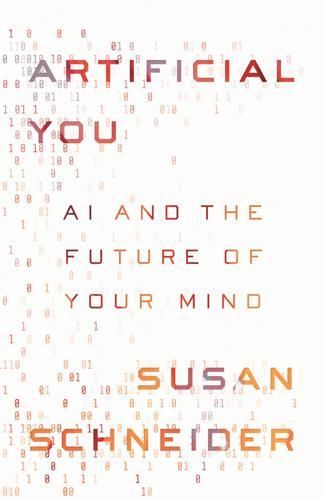
Artificial You: AI and the Future of Your Mind
by
Susan Schneider
Published 1 Oct 2019
They, like many other transhumanists, adopt a novel and intriguing version of the psychological continuity view; in particular, they adopt a computational, or patternist, account of continuity. ARE YOU A SOFTWARE PATTERN? Patternism’s point of departure is the computational theory of mind, which I introduced earlier. The original versions of the computational theory of mind held that the mind is akin to a standard computer, but nowadays it is commonly agreed that the brain does not have that structure. But cognitive and perceptual capacities, such as working memory and attention, are still considered computational in a broad sense. Although computational theories of mind differ in their details, one thing they have in common is that they all explain cognitive and perceptual capacities in terms of causal relationships between components, each of which can be described algorithmically.
…
Although computational theories of mind differ in their details, one thing they have in common is that they all explain cognitive and perceptual capacities in terms of causal relationships between components, each of which can be described algorithmically. One common way of describing the computational theory of mind is by reference to the idea that the mind is a software program: The Software Approach to the Mind (SAM). The mind is the program running on the hardware of the brain. That is, the mind is the algorithm the brain implements, and this algorithm is something that different subfields of cognitive science seek to describe.11 Those working on computational theories of mind in philosophy of mind tend to ignore the topic of patternism, as well as the more general topic of personal identity.
…
Olson’s position rejects this, as the brain is just one organ among many (see his comments in Marshall [2019]). 10. Sociologist James Hughes holds a transhumanist version of the no-self view. See Hughes (2004, 2013). For surveys of these four positions, see Olson (1997, 2017) and Conee and Sider (2005). 11. This is a version of a computational theory of mind that I criticize in Chapter Eight, however. It should also be noted that computational theories of mind can appeal to various computational theories of the format of thought: connectionism, dynamical systems theory (in its computational guise), the symbolic or language of thought approach, or some combination thereof. These differences will not matter for the purposes of our discussion.
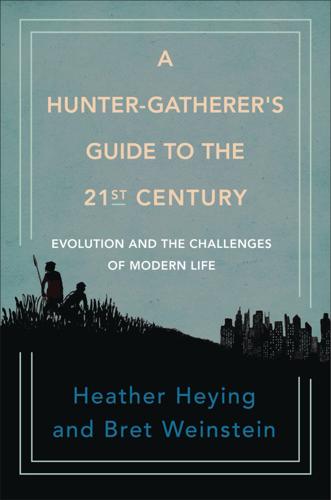
A Hunter-Gatherer's Guide to the 21st Century: Evolution and the Challenges of Modern Life
by
Heather Heying
and
Bret Weinstein
Published 14 Sep 2021
We humans are particularly adept at recognizing that our perceptions of the world are not shared by everyone. This ability to recognize that other people understand the world differently is theory of mind, which we have already invoked several times. Organisms with theory of mind have the ability to distinguish between subject and object. Baboons in the Okavango Delta in Botswana, for instance, know the difference between “She threatens my sister” and “My sister threatens her.” They exhibit the first glimmers of theory of mind—the ability to track not just what their own model of reality is, but also that of other individuals, even when those models differ from their own.16 We can also deduce that all the usual suspects—the wolves and the elephants, the crows and the parrots—have theory of mind, given their social, long-lived, multigenerational-families and high parental caregiving ways.
…
Those seemingly alive creatures, which cannot and therefore will not respond to a child’s looks or gestures or questions, send the message to the developing brain that the world is not an emotionally responsive place. What is a child to make of this world? How is a child to develop a nuanced theory of mind—the ability to attribute mental states to others, and to understand that others can and do have desires and opinions that are different from one’s own? Our ability to recognize that other individuals are both different from self and yet equally deserving of respect and fair treatment is not unique to humans. Baboons, for instance, show a deep theory of mind. A female baboon can accurately assess whether threatening vocalizations from another female are directed at her, based on what social interactions the two individuals have recently had.
…
They exhibit the first glimmers of theory of mind—the ability to track not just what their own model of reality is, but also that of other individuals, even when those models differ from their own.16 We can also deduce that all the usual suspects—the wolves and the elephants, the crows and the parrots—have theory of mind, given their social, long-lived, multigenerational-families and high parental caregiving ways. One thing that theory of mind provides potential access to is a sense of fairness. The concept of what’s “fair” didn’t originate with philosophers. It didn’t emerge with city-states, or with agriculture. It wasn’t new to hunter-gatherers, either, or to our first bipedal ancestors. Monkeys keep track of what’s fair, and what’s not, and they have decided opinions about unfair practices in their social realm.

How the Mind Works
by
Steven Pinker
Published 1 Jan 1997
If the bits of matter that constitute a symbol are arranged to bump into the bits of matter constituting another symbol in just the right way, the symbols corresponding to one belief can give rise to new symbols corresponding to another belief logically related to it, which can give rise to symbols corresponding to other beliefs, and so on. Eventually the bits of matter constituting a symbol bump into bits of matter connected to the muscles, and behavior happens. The computational theory of mind thus allows us to keep beliefs and desires in our explanations of behavior while planting them squarely in the physical universe. It allows meaning to cause and be caused. The computational theory of mind is indispensable in addressing the questions we long to answer. Neuroscientists like to point out that all parts of the cerebral cortex look pretty much alike—not only the different parts of the human brain, but the brains of different animals.
…
In Barkow, Cosmides, & Tooby, 1992. Barkow, J. H., Cosmides, L., & Tooby, J. (Eds.) 1992. The adapted mind: Evolutionary psychology and the generation of culture. New York: Oxford University Press. Baron-Cohen, S. 1995. Mindblindness: An essay on autism and theory of mind. Cambridge, Mass.: MIT Press. Baron-Cohen, S., Leslie, A. M., & Frith, U. 1985. Does the autistic child have a theory of mind? Cognition, 21, 37–46. Bates, E., & MacWhinney, B. 1982. Functionalist approaches to grammar. In E. Wanner & L. R. Gleitman (Eds.), Language acquisition: The state of the art. New York: Cambridge University Press. Bates, E., & MacWhinney, B. 1992.
…
I have selected, from many disciplines, theories that strike me as offering a special insight into our thoughts and feelings, that fit the facts and predict new ones, and that are consistent in their content and in their style of explanation. My goal was to weave the ideas into a cohesive picture using two even bigger ideas that are not mine: the computational theory of mind and the theory of the natural selection of replicators. The opening chapter presents the big picture: that the mind is a system of organs of computation designed by natural selection to solve the problems faced by our evolutionary ancestors in their foraging way of life. Each of the two big ideas—computation and evolution—then gets a chapter.
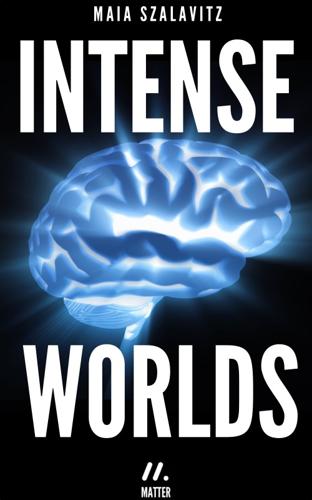
Intense Worlds
by
Maia Szalavitz
Published 11 Dec 2013
But while the Sally-Anne experiment shows that autistic people have difficulty knowing that other people have different perspectives—what researchers call cognitive empathy or “theory of mind”—it doesn’t show that they don’t care when someone is hurt or feeling pain, whether emotional or physical. In terms of caring—technically called the affective empathy—autistic people aren’t necessarily impaired. Sadly, however, the two different kinds of empathy are combined in one English word. And so, since the 1980s, this idea that autistic people “lack empathy” has taken hold. “When we looked at the autism field we couldn’t believe it,” Markram says. “Everybody was looking at it as if they have no empathy, no theory of mind. And actually Kai, as awkward as he was, saw through you.
…
“I’m very much in sympathy with what they do,” he says, although he is not convinced that they have proven all the details. Mottron’s support is unsurprising, of course, because the intense world dovetails with his own findings. But even one of the creators of the “theory of mind” concept finds much of it plausible. Simon Baron-Cohen, who directs the Autism Research Centre at Cambridge University, told me, “I am open to the idea that the social deficits in autism—like problems with the cognitive aspects of empathy, which is also known as ‘theory of mind’—may be upstream from a more basic sensory abnormality.” In other words, the Markrams’ physiological model could be the cause, and the social deficits he studies, the effect.
…
The dark days of the mid–20th century, when autism was thought to be caused by unloving “refrigerator mothers” who icily rejected their infants, were long past. However, while experts now agree that the condition is neurological, its causes remain unknown. The most prominent theory suggests that autism results from problems with the brain’s social regions, which results in a deficit of empathy. This “theory of mind” concept was developed by Uta Frith, Alan Leslie, and Simon Baron-Cohen in the 1980s. They found that autistic children are late to develop the ability to distinguish between what they know themselves and what others know—something that other children learn early on. In a now famous experiment, children watched two puppets, “Sally” and “Anne.”

Heart of the Machine: Our Future in a World of Artificial Emotional Intelligence
by
Richard Yonck
Published 7 Mar 2017
“Soldiers are developing relationships with their battlefield robots, naming them, assigning genders, and even holding funerals when they are destroyed.” Reddit, 2013. 3. Ibid. 4. “Personal Robot That Shows Emotions Sells Out in One Minute.” Gaudin, S. ComputerWorld. June 22, 2015. 5. Theory of mind. https://en.wikipedia.org/wiki/Theory_of_mind. 6. Reductionism in this context being the idea that the mind is reducible to a set of physical processes that could then be emulated or replicated in an alternate substrate or environment, given sufficiently advanced technology. Ney, A. Reductionism. Internet Encyclopedia of Philosophy.
…
See transcranial direct current stimulation (tDCS) technium, 23 technological evolution “AI-human symbiote,” 264 emotional empathy and, 265–266 and “ end of the world” scenarios, 261–262 and the future, 266–273 intention, 260–261 Matrix scenario, 262–263 peaceful coexistence, 263 technological singularity, 239 technophobia, 29–30 TEDWomen, 175–176 Tega, 118–119 Tegmark, Max, 132 teledildonic devices, 188–189 telepresence, 201 telepresence robots, 151 Terminator scenarios, 242, 262 Terror Management Theory (TMT), 99 Terrorist Surveillance Act (2006), 145 Texas A&M, 127 theory of mind (ToM), 83–84, 131 therapeutic companion robots, 148–150 “Three Laws of Robotics,” 165, 230–233, 262 3D printing, 211 Tilbury, Nancy, 57 TMS. See transcranial magnetic stimulation (TMS) Tobii, 73 ToM. See theory of mind (ToM) Toshiba, 87 transcranial direct current stimulation (tDCS), 128–130 transcranial magnetic stimulation (TMS), 128–130, 217–218 transcription factors, DNA, 15 transhumanists, 105, 212, 223 TruCompanion, 184 True Link, 157 Turing, Alan, 36–37, 236–237 Turing test, 36–37, 236–238 Turkle, Sherry, 90, 196, 199 21st Century Robot project, 168 2001 (Clarke/Kubrick), 232 Tzezana, Roey, 166 U UAVs.
…
This could be the result of a common benefit for this feature in larger-volume brains. Not incidentally, all of these are the same species that have demonstrated the ability to pass certain self-recognition tests, suggesting that the connections these spindle neurons provide may be critical to self-awareness and theory of mind.22 Interestingly, spindle neurons don’t begin to appear in human infants until they are between four and eight months old.23 They become reasonably interconnected by around a year and a half and are usually fully connected by three to four years of age. These time frames correlate closely with certain milestones of cognitive development, suggesting they may be instrumental in the development of self-awareness as well.
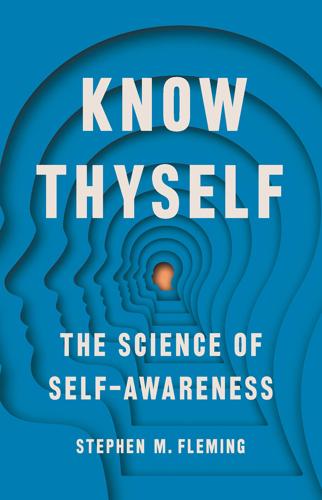
Know Thyself
by
Stephen M Fleming
Published 27 Apr 2021
Psychonomic Bulletin & Review 7, no. 1 (2000): 26–48. Butterfill, Stephen A., and Ian A. Apperly. “How to Construct a Minimal Theory of Mind.” Mind & Language 28, no. 5 (2013): 606–637. Call, Josep. “Seeking Information in Non-Human Animals: Weaving a Metacognitive Web.” In Foundations of Metacognition, edited by Michael J. Beran, Johannes Brandl, Josef Perner, and Joëlle Proust, 62–75. Oxford: Oxford University Press, 2012. Call, Josep, and Michael Tomasello. “Does the Chimpanzee Have a Theory of Mind? 30 Years Later.” Trends in Cognitive Sciences 12, no. 5 (2008): 187–192. Camerer, Colin F., Anna Dreber, Felix Holzmeister, Teck-Hua Ho, Jürgen Huber, Magnus Johannesson, Michael Kirchler, et al.
…
“Unskilled and Unaware of It: How Difficulties in Recognizing One’s Own Incompetence Lead to Inflated Self-Assessments.” Journal of Personality and Social Psychology 77, no. 6 (1999): 1121–1134. Krupenye, Christopher, and Josep Call. “Theory of Mind in Animals: Current and Future Directions.” WIREs Cognitive Science 10, no. 6 (2019): e1503. Kulke, Louisa, and Hannes Rakoczy. “Implicit Theory of Mind—an Overview of Current Replications and Non-Replications.” Data in Brief 16 (2017): 101–104. La Berge, S. P., L. E. Nagel, W. C. Dement, and V. P. Zarcone. “Lucid Dreaming Verified by Volitional Communication During REM Sleep.”
…
But one elegant story about the origins of self-awareness goes like this: At some point in our evolutionary history, humans found it important to keep track of what other people were thinking, feeling, and doing. Psychologists refer to the skills needed to think through problems such as “Sheila knows that John knows that Janet doesn’t know about the extra food” as theory of mind, or mindreading for short. After mindreading was established, the story goes, at some point it gradually dawned on our ancestors that they could apply such tools to think about themselves. This particular transition in human history may have occurred somewhere between seventy thousand and fifty thousand years ago, when the human mind was undergoing substantial cognitive changes.

What to Think About Machines That Think: Today's Leading Thinkers on the Age of Machine Intelligence
by
John Brockman
Published 5 Oct 2015
An operating system so modular that it can pinpoint your location on a map in one window, but cannot use it to enter your address in the tax return software in another window, is missing a global workspace. 2.Theory of Mind: Cognitive scientists have discovered a second set of brain circuits dedicated to the representation of other minds—what other people think, know, or believe. Unless we suffer from a disease called autism, all of us constantly pay attention to others and adapt our behavior to their state of knowledge—or, rather, to what we think they know. Such Theory of Mind is the second crucial ingredient that current software lacks: an ability to attend to its user. Future software should incorporate a model of its user.
…
Even a minimal simulation of the user would immediately give a strong impression that the machine is “thinking.” This is because having a Theory of Mind is required to achieve relevance (a concept first modeled by cognitive scientist Dan Sperber). Unlike present-day computers, humans don’t say utterly irrelevant things, because they pay attention to how their interlocutors will be affected by what they say. The navigator software that tells you, “At the next roundabout, take the second exit” sounds stupid, because it doesn’t know that “Go straight” would be a much more compact and relevant message. Global workspace and Theory of Mind are two essential functions that even a one-year-old child possesses yet our machines still lack.
…
BRIAN ENO Just a New Fractal Detail in the Big Picture MARTI HEARST eGaia, a Distributed Technical-Social Mental System CHRIS ANDERSON The Hive Mind ALEX (SANDY) PENTLAND The Global Artificial Intelligence Is Here RANDOLPH NESSE Will Computers Become Like Thinking, Talking Dogs? RICHARD E. NISBETT Thinking Machines and Ennui SAMUEL ARBESMAN Naches from Our Machines GERALD SMALLBERG No Shared Theory of Mind ELDAR SHAFIR Blind to the Core of Human Experience CHRISTOPHER CHABRIS An Intuitive Theory of Machine URSULA MARTIN Thinking Saltmarshes KURT GRAY Killer Thinking Machines Keep Our Conscience Clean BRUCE SCHNEIER When Thinking Machines Break the Law REBECCA MACKINNON Electric Brains GERD GIGERENZER Robodoctors ALISON GOPNIK Can Machines Ever Be As Smart As Three-Year-Olds?
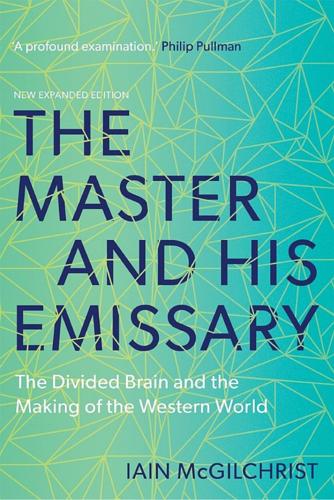
The Master and His Emissary: The Divided Brain and the Making of the Western World
by
Iain McGilchrist
Published 8 Oct 2012
If we think it’s a computer, we just are not engaged.201 The right hemisphere plays an important role in what is known as ‘theory of mind’, a capacity to put oneself in another’s position and see what is going on in that person’s mind.202 This capacity emerges in primates along with self-recognition and self-awareness, and is closely linked to it.203 It is a capacity that children do not acquire fully until the age of four (though elements are probably present from 12 to 18 months), and which autistic children never acquire.204 The classic test for theory of mind shows two dolls, Sally and Anne, playing with a marble. They put it away in a box, and leave the room.
…
The right hemisphere seems more engaged by emotional, autobiographical memories.494 It is hardly surprising that the ‘sense of self’ should be grounded in the right hemisphere, because the self originates in the interaction with ‘the Other’, not as an entity in atomistic isolation: ‘The sense of self emerges from the activity of the brain in interaction with other selves.’495 The right orbitofrontal cortex, the part of the right frontal lobe most crucial for social and empathic understanding, is larger in primates than the left.496 It is likely that this part of the brain expands during the period of playful interaction between infant and mother in the second half of the first year, and the second year, of life, during which the sense of the self emerges, and indeed the right orbitofrontal cortex is seen by Allan Schore as the crucible of the growing self.497 The right hemisphere matures earlier than the left, and is more involved than the left in almost every aspect of the development of mental functioning in early childhood, and of the self as a social, empathic being.498 Social development in the infant takes place independently of language development, another pointer to its right-hemisphere origins.499 The relationship between the evolution of a sense of self and the sense of others as beings like oneself, and therefore as evoking empathy and understanding, which I have referred to before as an achievement of the right frontal lobes, is borne out by the close relationship between the development of a sense of self and the development of ‘theory of mind’ (see p. 57 above). This is, for example, evidenced by the fact that the neuroimaging correlates of both self-awareness and theory of mind lie in the right frontal and right cingulate cortex.500 It is also the right hemisphere which is responsible for ‘maintaining a coherent, continuous and unified sense of self’.501 Evidence from patients with dementia is highly suggestive that it is the right hemisphere that ‘connects the individual to emotionally salient experiences and memories underlying self-schemas’, and which therefore forms ‘the glue holding together the sense of self’.502 The remark is reminiscent of a formulation of Douglas Watt’s that ‘emotion binds together virtually every type of information the brain can encode … [it is] part of the glue that holds the whole system together,’503 and indeed, to the degree that that is true, the observation that the right hemisphere binds together the sense of self would follow from this.
…
Forward planning, hitherto thought to be a hallmark of human cognition, is clearly present in birds that have no language (a point worth making since, for example, Irene Pepperberg’s African grey parrot, Alex, was able to communicate, plan and reason – but he had quite a vocabulary).61 Even ‘theory of mind’, the ability to attribute mental states to others, which has become the shibboleth of complex, multilayered thought – since children are commonly said not to acquire it till about the age of four, and some subjects, particularly those with autism, may never acquire it at all – is intact in human subjects who have lost language,62 and may be present to a degree in chimpanzees and primates.63 Clearly, therefore, ‘theory of mind’ cannot depend on language, either. Once again, not just animals, but the young of our own species, indicate that it is wrong to assume that meaning depends on language, though our conscious left hemisphere may be unable to conceive of meaning that is not conveyed in words.
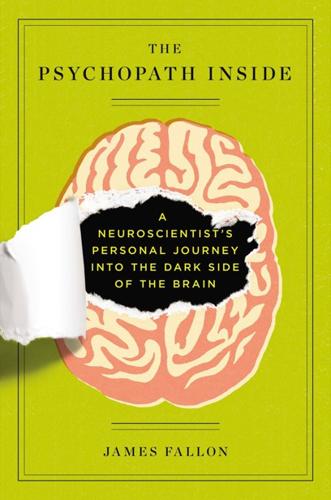
The Psychopath Inside: A Neuroscientist's Personal Journey Into the Dark Side of the Brain
by
James Fallon
Published 30 Oct 2013
Someone with damage to the hot system, let’s say in the orbital cortex, might not be able to predict others’ thoughts but will have the most trouble sharing his feelings. A dichotomy may exist between empathy, a fundamental connection with the pain of others and arising very early in life, and “theory of mind,” a more elaborated medial prefrontal system that allows us to consider others’ thoughts and beliefs, even if they’re different from our own. People with autism lack theory of mind but not empathy, while people with psychopathy lack empathy but not theory of mind. Without empathy you can still have sympathy, though—the ability to retrieve emotional memories, including those that can predict what painful event is probably about to befall another person, and the will to help that person.
…
Beyond this mix of types of empathy according to individual versus group (in a sense also related to the dichotomy of empathy versus sympathy discussed at the beginning of this chapter) is another important dichotomy, and that is between emotional empathy and cognitive empathy, also known as “theory of mind.” Theory of mind, as I’ve previously discussed, arises early in childhood, developing progressively until adulthood, and is a key developmental accomplishment in which the child learns she possesses mental states like desires and intentions and beliefs, and that others possess similar states, though those may be different from her own. Someone with autism will not show a normal theory of mind. This lack may also be present in people with some personality disorders such as borderline personality disorder, and also some forms of bipolar disorder.
…
In contrast, people with psychopathy, narcissism, and certain affective types of schizophrenia will have cognitive empathy but lack emotional empathy. These two types of loss of empathy may be associated with underfunctioning of different parts of the lower, or ventral, half of the prefrontal cortex. Rebecca Saxe of the Massachusetts Institute of Technology has recently shown that theory of mind is centered, in part, in the nondominant hemisphere where the temporal lobe abuts the parietal lobe, the so-called temporo-parietal junction, that is, one node in the mirror neuron system. It is a key spot in a circuit that processes how one perceives the intentions, morals, and ethics of others, a partner to the orbital cortex of the frontal lobe that processes one’s own intentions, ethics, and morality.
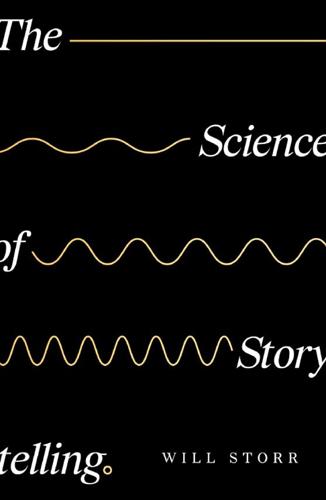
The Science of Storytelling: Why Stories Make Us Human, and How to Tell Them Better
by
Will Storr
Published 3 Apr 2019
1.1 Moments of change; the control-seeking brain 1.2 Curiosity 1.3 The model-making brain; how we read; grammar; filmic word order; simplicity; active versus passive language; specific detail; show-not-tell 1.4 World-making in fantasy and science fiction 1.5 The domesticated brain; theory of mind in animism and religion; how theory-of-mind mistakes create drama 1.6 Salience; creating tension with detail 1.7 Neural models; poetry; metaphor 1.8 Cause and effect; literary versus mass-market storytelling 1.9 Change is not enough CHAPTER TWO: THE FLAWED SELF 2.0 The flawed self; the theory of control 2.1 Personality and plot 2.2 Personality and setting 2.3 Personality and point of view 2.4 Culture and character; Western versus Eastern story 2.5 Anatomy of a flawed self; the ignition point 2.6 Fictional memories; moral delusions; antagonists and moral idealism; antagonists and toxic self-esteem; the hero-maker narrative 2.7 David and Goliath 2.8 How flawed characters create meaning CHAPTER THREE: THE DRAMATIC QUESTION 3.0 Confabulation and the deluded character; the dramatic question 3.1 Multiple selves; the three-dimensional character 3.2 The two levels of story; how subconscious character struggle creates plot 3.3 Modernist stories 3.4 Wanting and needing 3.5 Dialogue 3.6 The roots of the dramatic question; social emotions; heroes and villains; moral outrage 3.7 Status play 3.8 King Lear; humiliation 3.9 Stories as tribal propaganda 3.10 Antiheroes; empathy 3.11 Origin damage CHAPTER FOUR: PLOTS, ENDINGS AND MEANING 4.0 Goal directedness; video games; personal projects; eudaemonia; plots 4.1 Plot as recipe versus plot as symphony of change 4.2 The final battle 4.3 Endings; control; the God moment 4.4 Story as a simulacrum of consciousness; transportation 4.5 The power of story 4.6 The lesson of story 4.7 The consolation of story APPENDIX: THE SACRED FLAW APPROACH A NOTE ON THE TEXT ACKNOWLEDGMENTS NOTES AND SOURCES INDEX ABOUT THE AUTHOR ALSO BY WILL STORR ABOUT THE PUBLISHER INTRODUCTION We know how this ends.
…
Human obsession with faces is so fierce we see them almost anywhere: in fire; in clouds; down spooky corridors; in toast. We sense minds everywhere too. Just as the brain models the outside world it also builds models of minds. This skill, which is an essential weapon in our social armoury, is known as ‘theory of mind’. It enables us to imagine what others are thinking, feeling and plotting, even when they’re not present. We can experience the world from another’s perspective. For the psychologist Professor Nicholas Epley this capacity, which is obviously essential for storytelling, gave us incredible power.
…
Whose storytelling brain doesn’t commit its own literary-style pathetic fallacy, allowing the sun to make them optimistic about the coming day or the brooding clouds pessimistic? Studies indicate that those who anthropomorphise a human personality onto their cars show less interest in trading them. Bankers project human moods onto the movements of the markets and place their trades accordingly. When we’re reading, hearing or watching a story we deploy our theory-of-mind skills by automatically making hallucinatory models of the minds of its characters. Some authors model the minds of their own characters with such force that they hear them talk. Charles Dickens, William Blake and Joseph Conrad all spoke of such extraordinary experiences. The novelist and psychologist Professor Charles Fernyhough has led research in which 19 per cent of ordinary readers reported hearing the voices of fictional characters even after they’d put their books down.
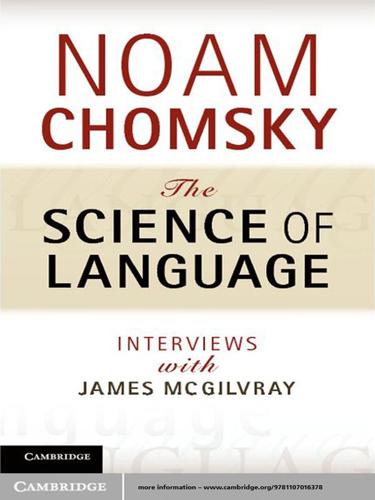
The Science of Language
by
Noam Chomsky
Published 24 Feb 2012
Some small genetic modification somehow that rewired the brain slightly. We know so little about neurology; but I can't imagine how else it could be. So some small genetic change led to the rewiring of the brain that made this human capacity available. And with it came the entire range of creative options [C] that are available to humans within a theory of mind – a second-order theory of mind, so you know that somebody is trying to make you think what somebody else wants you to think. It's very hard to imagine how any of this could go on without language; at least, we can't think of any way of doing it without a language. And most of it is thinking and planning and interpreting, and so on; it's internal.
…
English doesn't use a lot of things; it doesn't use Baker's polysynthesis option. No language uses all the options that are available. 3 Representation and computation JM: Continuing in the same vein, your understanding of computation seems to differ from the philosophically favored notion where it is understood as tied in with a representational theory of mind. Computation there is understood to be something like the operations of a problem-solving device that operates over symbols understood in traditional (not your) semantic terms, in terms of relationships of items inside the head that represent things outside in the world. NC: The term “representation” is used in a kind of technical sense in the philosophical literature which I think basically comes back to the theory of ideas.
…
NC: The term “representation” is used in a kind of technical sense in the philosophical literature which I think basically comes back to the theory of ideas. You know there's something out there and the impression of it becomes an idea, and then there's a relation – so, say, in Jerry Fodor's representational theory of mind – there's a causal relation between the cat over there and the concept cat in your language of thought. And Kripke, Putnam, Burge have a picture roughly like that. JM: Well, it's more than just causal – I mean, for Fodor, it really is a semantic relationship . . . NC: Yes, but it is causal [in that something ‘out there’ causes the formation of an internal representation which is your ‘idea of’ what causes it].
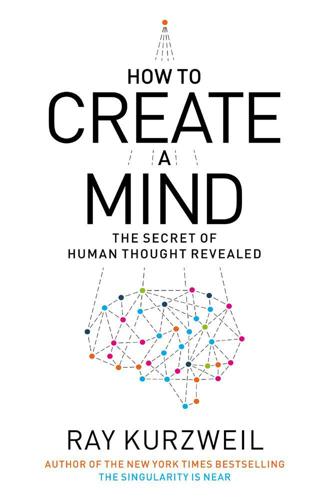
How to Create a Mind: The Secret of Human Thought Revealed
by
Ray Kurzweil
Published 13 Nov 2012
Stephen Wolfram, and Tomaso Poggio; To my in-house and lay readers whose names appear above; And, finally, to all of the creative thinkers in the world who inspire me every day. CONTENTS INTRODUCTION 1. THOUGHT EXPERIMENTS ON THE WORLD 2. THOUGHT EXPERIMENTS ON THINKING 3. A MODEL OF THE NEOCORTEX: THE PATTERN RECOGNITION THEORY OF MIND 4. THE BIOLOGICAL NEOCORTEX 5. THE OLD BRAIN 6. TRANSCENDENT ABILITIES 7. THE BIOLOGICALLY INSPIRED DIGITAL NEOCORTEX 8. THE MIND AS COMPUTER 9. THOUGHT EXPERIMENTS ON THE MIND 10. THE LAW OF ACCELERATING RETURNS APPLIED TO THE BRAIN 11. OBJECTIONS EPILOGUE NOTES INDEX INTRODUCTION The Brain—is wider than the Sky— For—put them side by side— The one the other will contain With ease—and You—beside— The Brain is deeper than the sea— For—hold them—Blue to Blue— The one the other will absorb— As Sponges—Buckets—do— The Brain is just the weight of God— For—Heft them—Pound for Pound— And they will differ—if they do— As Syllable from Sound —Emily Dickinson As the most important phenomenon in the universe, intelligence is capable of transcending natural limitations, and of transforming the world in its own image.
…
As an example, consider the rather subtle phenomenon of Bernoulli’s principle, which states that there is slightly less air pressure over a moving curved surface than over a moving flat one. The mathematics of how Bernoulli’s principle produces wing lift is still not yet fully settled among scientists, yet engineering has taken this delicate insight, focused its powers, and created the entire world of aviation. In this book I present a thesis I call the pattern recognition theory of mind (PRTM), which, I argue, describes the basic algorithm of the neocortex (the region of the brain responsible for perception, memory, and critical thinking). In the chapters ahead I describe how recent neuroscience research, as well as our own thought experiments, leads to the inescapable conclusion that this method is used consistently across the neocortex.
…
The cutting edge of the project to understand, model, and simulate the human brain is to reverse-engineer the cerebral neocortex, where we do our recursive hierarchical thinking. The cerebral cortex, which accounts for 80 percent of the human brain, is composed of a highly repetitive structure, allowing humans to create arbitrarily complex structures of ideas. In the pattern recognition theory of mind, I describe a model of how the human brain achieves this critical capability using a very clever structure designed by biological evolution. There are details in this cortical mechanism that we do not yet fully understand, but we know enough about the functions it needs to perform that we can nonetheless design algorithms that accomplish the same purpose.

The Road to Conscious Machines
by
Michael Wooldridge
Published 2 Nov 2018
What I’m after is programs that can do this in a substantive way – not programs that pass the test through a combination of smoke and mirrors. 13. S. Baron-Cohen, A. M. Leslie and U. Frith. ‘Does the Autistic Child Have a “Theory of Mind”?’ Cognition, 21(1), 1985, pp. 37–46. 14. S. Baron-Cohen. Mindblindness: An Essay on Autism and Theory of Mind. MIT Press, 1995. 15. N. C. Rabinowitz et al. Machine Theory of Mind. arXiv:1802.07740. 16. I am no expert on evolutionary psychology: my guide in this section is Robin Dunbar’s Human Evolution (Penguin, 2014), and I am pleased to refer interested readers to this for more detail.
…
Simon Baron-Cohen and his co-authors, who pioneered this approach, take this as evidence that autistic children lack what has become known as a Theory of Mind (ToM). The ToM is the practical, common-sense capability that fully developed adults have, to be able to reason about the mental states – beliefs, desires and so on – of others and themselves. Humans are not born with a ToM, but clinically normal humans are born with the capability to develop one. Clinically normal children develop their theory of mind progressively: by the age of four, children are able to reason including others’ perspectives and viewpoints, and their ToM is fully developed in their teens.
…
A A* 77 À la recherche du temps perdu (Proust) 205–8 accountability 257 Advanced Research Projects Agency (ARPA) 87–8 adversarial machine learning 190 AF (Artificial Flight) parable 127–9, 243 agent-based AI 136–49 agent-based interfaces 147, 149 ‘Agents That Reduce Work and Information Overload’ (Maes) 147–8 AGI (Artificial General Intelligence) 41 AI – difficulty of 24–8 – ethical 246–62, 284, 285 – future of 7–8 – General 42, 53, 116, 119–20 – Golden Age of 47–88 – history of 5–7 – meaning of 2–4 – narrow 42 – origin of name 51–2 – strong 36–8, 41, 309–14 – symbolic 42–3, 44 – varieties of 36–8 – weak 36–8 AI winter 87–8 AI-complete problems 84 ‘Alchemy and AI’ (Dreyfus) 85 AlexNet 187 algorithmic bias 287–9, 292–3 alienation 274–7 allocative harm 287–8 AlphaFold 214 AlphaGo 196–9 AlphaGo Zero 199 AlphaZero 199–200 Alvey programme 100 Amazon 275–6 Apple Watch 218 Argo AI 232 arithmetic 24–6 Arkin, Ron 284 ARPA (Advanced Research Projects Agency) 87–8 Artificial Flight (AF) parable 127–9, 243 Artificial General Intelligence (AGI) 41 artificial intelligence see AI artificial languages 56 Asilomar principles 254–6 Asimov, Isaac 244–6 Atari 2600 games console 192–6, 327–8 augmented reality 296–7 automated diagnosis 220–1 automated translation 204–8 automation 265, 267–72 autonomous drones 282–4 Autonomous Vehicle Disengagement Reports 231 autonomous vehicles see driverless cars autonomous weapons 281–7 autonomy levels 227–8 Autopilot 228–9 B backprop/backpropagation 182–3 backward chaining 94 Bayes nets 158 Bayes’ Theorem 155–8, 365–7 Bayesian networks 158 behavioural AI 132–7 beliefs 108–10 bias 172 black holes 213–14 Blade Runner 38 Blocks World 57–63, 126–7 blood diseases 94–8 board games 26, 75–6 Boole, George 107 brains 43, 306, 330–1 see also electronic brains branching factors 73 Breakout (video game) 193–5 Brooks, Rodney 125–9, 132, 134, 243 bugs 258 C Campaign to Stop Killer Robots 286 CaptionBot 201–4 Cardiogram 215 cars 27–8, 155, 223–35 certainty factors 97 ceteris paribus preferences 262 chain reactions 242–3 chatbots 36 checkers 75–7 chess 163–4, 199 Chinese room 311–14 choice under uncertainty 152–3 combinatorial explosion 74, 80–1 common values and norms 260 common-sense reasoning 121–3 see also reasoning COMPAS 280 complexity barrier 77–85 comprehension 38–41 computational complexity 77–85 computational effort 129 computers – decision making 23–4 – early developments 20 – as electronic brains 20–4 – intelligence 21–2 – programming 21–2 – reliability 23 – speed of 23 – tasks for 24–8 – unsolved problems 28 ‘Computing Machinery and Intelligence’ (Turing) 32 confirmation bias 295 conscious machines 327–30 consciousness 305–10, 314–17, 331–4 consensus reality 296–8 consequentialist theories 249 contradictions 122–3 conventional warfare 286 credit assignment problem 173, 196 Criado Perez, Caroline 291–2 crime 277–81 Cruise Automation 232 curse of dimensionality 172 cutlery 261 Cybernetics (Wiener) 29 Cyc 114–21, 208 D DARPA (Defense Advanced Research Projects Agency) 87–8, 225–6 Dartmouth summer school 1955 50–2 decidable problems 78–9 decision problems 15–19 deduction 106 deep learning 168, 184–90, 208 DeepBlue 163–4 DeepFakes 297–8 DeepMind 167–8, 190–200, 220–1, 327–8 Defense Advanced Research Projects Agency (DARPA) 87–8, 225–6 dementia 219 DENDRAL 98 Dennett, Daniel 319–25 depth-first search 74–5 design stance 320–1 desktop computers 145 diagnosis 220–1 disengagements 231 diversity 290–3 ‘divide and conquer’ assumption 53–6, 128 Do-Much-More 35–6 dot-com bubble 148–9 Dreyfus, Hubert 85–6, 311 driverless cars 27–8, 155, 223–35 drones 282–4 Dunbar, Robin 317–19 Dunbar’s number 318 E ECAI (European Conference on AI) 209–10 electronic brains 20–4 see also computers ELIZA 32–4, 36, 63 employment 264–77 ENIAC 20 Entscheidungsproblem 15–19 epiphenomenalism 316 error correction procedures 180 ethical AI 246–62, 284, 285 European Conference on AI (ECAI) 209–10 evolutionary development 331–3 evolutionary theory 316 exclusive OR (XOR) 180 expected utility 153 expert systems 89–94, 123 see also Cyc; DENDRAL; MYCIN; R1/XCON eye scans 220–1 F Facebook 237 facial recognition 27 fake AI 298–301 fake news 293–8 fake pictures of people 214 Fantasia 261 feature extraction 171–2 feedback 172–3 Ferranti Mark 1 20 Fifth Generation Computer Systems Project 113–14 first-order logic 107 Ford 232 forward chaining 94 Frey, Carl 268–70 ‘The Future of Employment’ (Frey & Osborne) 268–70 G game theory 161–2 game-playing 26 Gangs Matrix 280 gender stereotypes 292–3 General AI 41, 53, 116, 119–20 General Motors 232 Genghis robot 134–6 gig economy 275 globalization 267 Go 73–4, 196–9 Golden Age of AI 47–88 Google 167, 231, 256–7 Google Glass 296–7 Google Translate 205–8, 292–3 GPUs (Graphics Processing Units) 187–8 gradient descent 183 Grand Challenges 2004/5 225–6 graphical user interfaces (GUI) 144–5 Graphics Processing Units (GPUs) 187–8 GUI (graphical user interfaces) 144–5 H hard problem of consciousness 314–17 hard problems 84, 86–7 Harm Assessment Risk Tool (HART) 277–80 Hawking, Stephen 238 healthcare 215–23 Herschel, John 304–6 Herzberg, Elaine 230 heuristic search 75–7, 164 heuristics 91 higher-order intentional reasoning 323–4, 328 high-level programming languages 144 Hilbert, David 15–16 Hinton, Geoff 185–6, 221 HOMER 141–3, 146 homunculus problem 315 human brain 43, 306, 330–1 human intuition 311 human judgement 222 human rights 277–81 human-level intelligence 28–36, 241–3 ‘humans are special’ argument 310–11 I image classification 186–7 image-captioning 200–4 ImageNet 186–7 Imitation Game 30 In Search of Lost Time (Proust) 205–8 incentives 261 indistinguishability 30–1, 37, 38 Industrial Revolutions 265–7 inference engines 92–4 insurance 219–20 intelligence 21–2, 127–8, 200 – human-level 28–36, 241–3 ‘Intelligence Without Representation’ (Brooks) 129 Intelligent Knowledge-Based Systems 100 intentional reasoning 323–4, 328 intentional stance 321–7 intentional systems 321–2 internal mental phenomena 306–7 Internet chatbots 36 intuition 311 inverse reinforcement learning 262 Invisible Women (Criado Perez) 291–2 J Japan 113–14 judgement 222 K Kasparov, Garry 163 knowledge bases 92–4 knowledge elicitation problem 123 knowledge graph 120–1 Knowledge Navigator 146–7 knowledge representation 91, 104, 129–30, 208 knowledge-based AI 89–123, 208 Kurzweil, Ray 239–40 L Lee Sedol 197–8 leisure 272 Lenat, Doug 114–21 lethal autonomous weapons 281–7 Lighthill Report 87–8 LISP 49, 99 Loebner Prize Competition 34–6 logic 104–7, 121–2 logic programming 111–14 logic-based AI 107–11, 130–2 M Mac computers 144–6 McCarthy, John 49–52, 107–8, 326–7 machine learning (ML) 27, 54–5, 168–74, 209–10, 287–9 machines with mental states 326–7 Macintosh computers 144–6 magnetic resonance imaging (MRI) 306 male-orientation 290–3 Manchester Baby computer 20, 24–6, 143–4 Manhattan Project 51 Marx, Karl 274–6 maximizing expected utility 154 Mercedes 231 Mickey Mouse 261 microprocessors 267–8, 271–2 military drones 282–4 mind modelling 42 mind-body problem 314–17 see also consciousness minimax search 76 mining industry 234 Minsky, Marvin 34, 52, 180 ML (machine learning) 27, 54–5, 168–74, 209–10, 287–9 Montezuma’s Revenge (video game) 195–6 Moore’s law 240 Moorfields Eye Hospital 220–1 moral agency 257–8 Moral Machines 251–3 MRI (magnetic resonance imaging) 306 multi-agent systems 160–2 multi-layer perceptrons 177, 180, 182 Musk, Elon 238 MYCIN 94–8, 217 N Nagel, Thomas 307–10 narrow AI 42 Nash, John Forbes Jr 50–1, 161 Nash equilibrium 161–2 natural languages 56 negative feedback 173 neural nets/neural networks 44, 168, 173–90, 369–72 neurons 174 Newell, Alan 52–3 norms 260 NP-complete problems 81–5, 164–5 nuclear energy 242–3 nuclear fusion 305 O ontological engineering 117 Osborne, Michael 268–70 P P vs NP problem 83 paperclips 261 Papert, Seymour 180 Parallel Distributed Processing (PDP) 182–4 Pepper 299 perception 54 perceptron models 174–81, 183 Perceptrons (Minsky & Papert) 180–1, 210 personal healthcare management 217–20 perverse instantiation 260–1 Phaedrus 315 physical stance 319–20 Plato 315 police 277–80 Pratt, Vaughan 117–19 preference relations 151 preferences 150–2, 154 privacy 219 problem solving and planning 55–6, 66–77, 128 programming 21–2 programming languages 144 PROLOG 112–14, 363–4 PROMETHEUS 224–5 protein folding 214 Proust, Marcel 205–8 Q qualia 306–7 QuickSort 26 R R1/XCON 98–9 radiology 215, 221 railway networks 259 RAND Corporation 51 rational decision making 150–5 reasoning 55–6, 121–3, 128–30, 137, 315–16, 323–4, 328 regulation of AI 243 reinforcement learning 172–3, 193, 195, 262 representation harm 288 responsibility 257–8 rewards 172–3, 196 robots – as autonomous weapons 284–5 – Baye’s theorem 157 – beliefs 108–10 – fake 299–300 – indistinguishability 38 – intentional stance 326–7 – SHAKEY 63–6 – Sophia 299–300 – Three Laws of Robotics 244–6 – trivial tasks 61 – vacuum cleaning 132–6 Rosenblatt, Frank 174–81 rules 91–2, 104, 359–62 Russia 261 Rutherford, Ernest (1st Baron Rutherford of Nelson) 242 S Sally-Anne tests 328–9, 330 Samuel, Arthur 75–7 SAT solvers 164–5 Saudi Arabia 299–300 scripts 100–2 search 26, 68–77, 164, 199 search trees 70–1 Searle, John 311–14 self-awareness 41, 305 see also consciousness semantic nets 102 sensors 54 SHAKEY the robot 63–6 SHRDLU 56–63 Simon, Herb 52–3, 86 the Singularity 239–43 The Singularity is Near (Kurzweil) 239 Siri 149, 298 Smith, Matt 201–4 smoking 173 social brain 317–19 see also brains social media 293–6 social reasoning 323, 324–5 social welfare 249 software agents 143–9 software bugs 258 Sophia 299–300 sorting 26 spoken word translation 27 STANLEY 226 STRIPS 65 strong AI 36–8, 41, 309–14 subsumption architecture 132–6 subsumption hierarchy 134 sun 304 supervised learning 169 syllogisms 105, 106 symbolic AI 42–3, 44, 181 synapses 174 Szilard, Leo 242 T tablet computers 146 team-building problem 78–81, 83 Terminator narrative of AI 237–9 Tesla 228–9 text recognition 169–71 Theory of Mind (ToM) 330 Three Laws of Robotics 244–6 TIMIT 292 ToM (Theory of Mind) 330 ToMnet 330 TouringMachines 139–41 Towers of Hanoi 67–72 training data 169–72, 288–9, 292 translation 204–8 transparency 258 travelling salesman problem 82–3 Trolley Problem 246–53 Trump, Donald 294 Turing, Alan 14–15, 17–19, 20, 24–6, 77–8 Turing Machines 18–19, 21 Turing test 29–38 U Uber 168, 230 uncertainty 97–8, 155–8 undecidable problems 19, 78 understanding 201–4, 312–14 unemployment 264–77 unintended consequences 263 universal basic income 272–3 Universal Turing Machines 18, 19 Upanishads 315 Urban Challenge 2007 226–7 utilitarianism 249 utilities 151–4 utopians 271 V vacuum cleaning robots 132–6 values and norms 260 video games 192–6, 327–8 virtue ethics 250 Von Neumann and Morgenstern model 150–5 Von Neumann architecture 20 W warfare 285–6 WARPLAN 113 Waymo 231, 232–3 weak AI 36–8 weapons 281–7 wearable technology 217–20 web search 148–9 Weizenbaum, Joseph 32–4 Winograd schemas 39–40 working memory 92 X XOR (exclusive OR) 180 Z Z3 computer 19–20 PELICAN BOOKS Economics: The User’s Guide Ha-Joon Chang Human Evolution Robin Dunbar Revolutionary Russia: 1891–1991 Orlando Figes The Domesticated Brain Bruce Hood Greek and Roman Political Ideas Melissa Lane Classical Literature Richard Jenkyns Who Governs Britain?

The Internet Is Not What You Think It Is: A History, a Philosophy, a Warning
by
Justin E. H. Smith
Published 22 Mar 2022
Ray Kurzweil speaks of a near future in which machines will have “emotional intelligence,” but it is not clear whether this simply means the ability to algorithmically discern moods (as our social-media tools can already do) or whether it means the capacity to experience emotion. There is significant discussion in the literature about the possibility of developing machines that are capable of holding an artificial theory of mind.14 But even a theory of mind can be accounted for in the minimal sense of simply having the ability to anticipate how mind-endowed beings might behave in particular circumstances, which is something that it does not require a mind to do: software used by department stores generates coupons for consumers based on their previous purchases, without, obviously, truly thinking about these purchases.
…
Smith, Irrationality. 11. Brian Cantwell Smith, The Promise of Artificial Intelligence, xv. 12. See Adams and Browning (eds.), Giving a Damn. 13. Cantwell Smith, The Promise of Artificial Intelligence, 108. 14. See for example Carruthers and Smith, Theories of Theories of Mind; Winfield, “Experiments in Artificial Theory of Mind”; Chatila et al., “Toward Self-Aware Robots.” 15. Prashanth Ramakrishna, “ ‘There’s Just No Doubt That It Will Change the World’: David Chalmers on V.R. and A.I.,” New York Times, June 18, 2019. 16. John Basl and Eric Schwitzgebel, “AIs Should Have the Same Protections as Animals,” Aeon, April 26, 2019. 17.
…
You can’t have it both ways: either intentionality makes human minds something quite distinct from computers, or the absence of intentionality in sagebrush chemical emissions is not a sufficient reason for declaring that these emissions are not evidence for the existence of a communication network in nature. The mind might in the end be a sort of computer, but then again computers might be a sort of plant. Although its defenders would deny this, the computational theory of mind is a metaphor too. And we are always free to trade in our metaphors when when others come along that better satisfy our desire to make sense of things, or that simply fit better with the spirit of the times. Dark Conjurations It should not be surprising by now to learn that the quest to build an artificial general-intelligence machine goes back much further in history than is ordinarily supposed, nor that the line between general intelligence and strong intelligence, between computational ability and consciousness, has often been blurred.
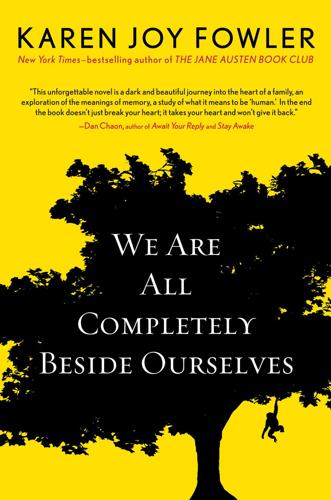
We Are All Completely Beside Ourselves
by
Karen Joy Fowler
Published 29 May 2013
Their conclusion was the same as Premack and Woodruff’s thirty years before. Does the chimpanzee have a theory of mind? They answered with a definite yes. Chimps do see that mental states, such as purpose and knowledge, combine to produce deliberate action. They even understand deceit. What chimps don’t seem capable of understanding is the state of false belief. They don’t have a theory of mind that accounts for actions driven by beliefs in conflict with reality. And really, who lacking that will ever be able to navigate the human world? • • • AROUND THE AGE of six or seven, human children develop a theory of mind that encompasses embedded mental states.
…
She snapped her reptilian jaw. I made her wrap her arms around my neck as if she were also sorry. Her knitting needles poked my ear sharply until I shifted her. “Please don’t go,” she said. Or maybe I said that. It was definitely one of us. • • • THE FLIP SIDE to solipsism is called theory of mind. Theory of mind postulates that, even though these cannot be directly observed, we readily impute mental states to others (and also to ourselves, since the bedrock proposal is that we understand our own mental states well enough to generalize from them). And so we constantly infer someone else’s intentions, thoughts, knowledge, lack of knowledge, doubts, desires, beliefs, guesses, promises, preferences, purposes, and many, many more things in order to behave as social creatures in the world.
…
Young children have the innate potential for a theory of mind, just the way Noam Chomsky says they do for language, but they haven’t developed it yet. Adults and older children sequence images easily into a coherent narrative. I myself took this test many times as a child and I never remember not being able to do it, though if Piaget says there was a time I couldn’t, then there was a time I couldn’t. In 1978, when Fern was still safely tucked into our family, psychologists David Premack and Guy Woodruff published a paper titled “Does the Chimpanzee Have a Theory of Mind?” In it, they relied primarily on a series of experiments done with a fourteen-year-old chimp named Sarah, in order to see if she could infer human goals in observed situations.
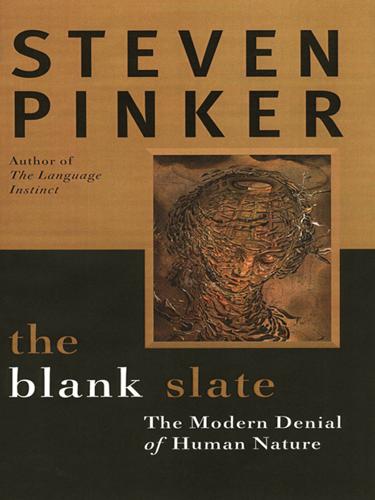
The Blank Slate: The Modern Denial of Human Nature
by
Steven Pinker
Published 1 Jan 2002
A family, peer group, and culture that ascribe high status to school achievement may be needed to give a child the motive to persevere toward effortful feats of learning whose rewards are apparent only over the long term.21 THE LAYPERSON’S INTUITIVE psychology or “theory of mind” is one of the brain’s most striking abilities. We do not treat other people as wind-up dolls but think of them as being animated by minds: nonphysical entities we cannot see or touch but that are as real to us as bodies and objects. Aside from allowing us to predict people’s behavior from their beliefs and desires, our theory of mind is tied to our ability to empathize and to our conception of life and death. The difference between a dead body and a living one is that a dead body no longer contains the vital force we call a mind. Our theory of mind is the source of the concept of the soul.
…
This general idea may be called the computational theory of mind. It is not the same as the “computer metaphor” of the mind, the suggestion that the mind literally works like a human-made database, computer program, or thermostat. It says only that we can explain minds and human-made information processors using some of the same principles. It is just like other cases in which the natural world and human engineering overlap. A physiologist might invoke the same laws of optics to explain how the eye works and how a camera works without implying that the eye is like a camera in every detail. The computational theory of mind does more than explain the existence of knowing, thinking, and trying without invoking a ghost in the machine (though that would be enough of a feat).
…
This sea change included a revolution in the treatment of human nature by scientists and scholars. Academics were swept along by the changing attitudes to race and sex, but they also helped to direct the tide by holding forth on human nature in books and magazines and by lending their expertise to government agencies. The prevailing theories of mind were refashioned to make racism and sexism as untenable as possible. The doctrine of the Blank Slate became entrenched in intellectual life in a form that has been called the Standard Social Science Model or social constructionism.5 The model is now second nature to people and few are aware of the history behind it.6 Carl Degler, the foremost historian of this revolution, sums it up this way: What the available evidence does seem to show is that ideology or a philosophical belief that the world could be a freer and more just place played a large part in the shift from biology to culture.
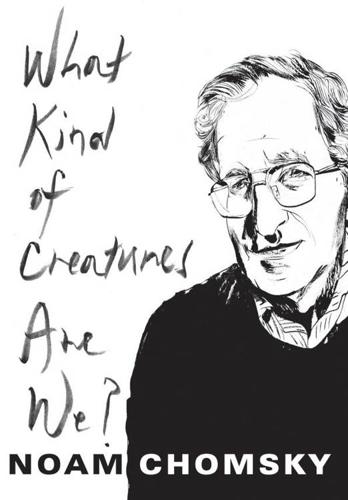
What Kind of Creatures Are We? (Columbia Themes in Philosophy)
by
Noam Chomsky
Published 7 Dec 2015
Noam Chomsky, “Turing on the ‘Imitation Game,’” in The Turing Test: Verbal Behavior as the Hallmark of Intelligence, ed. Stuart Schieber (Cambridge, Mass.: MIT Press, 2004), 317–21. 25. Desmond Clarke, Descartes’s Theory of Mind (Oxford: Clarendon Press, 2003), 12. See also Rene Descartes to Marin Mersenne, 1641, on the goal of the Meditations, cited in Margaret Wilson, Descartes (Boston: Routledge and Kegan Paul, 1978), 2. 26. Clarke, Descartes’s Theory of Mind, 258. 27. Nancy Kanwisher and Paul Downing, “Separating the Wheat from the Chaff ,” Science, October 2, 1998, 57–58; Newton, General Scholium. 28. Eric R. Kandel and Larry R.
…
We can distinguish various aspects of the world—say chemical, electrical, experiential and the rest—and we can then inquire into their underlying principles and their relations with other systems, problems of unification. Suppose we adopt the “mitigated skepticism” that was warranted after Newton, if not before. For the theory of mind, that means following Gassendi’s advice in Objections. He argued that Descartes had at most shown “the perception of the existence of mind, [but] fail[ed] to reveal its nature.” It is necessary to proceed as we would in seeking to discover “a conception of Wine superior to the vulgar,” by investigating how it is constituted and the laws that determine its functioning.
…
It is necessary to proceed as we would in seeking to discover “a conception of Wine superior to the vulgar,” by investigating how it is constituted and the laws that determine its functioning. Similarly, he urged Descartes, “it is incumbent on you, to examine yourself by a certain chemicallike labor, so that you can determine and demonstrate to us your internal substance”42—and that of others. The theory of mind can be pursued in many ways, like other branches of science, with an eye to eventual unification, whatever form it may take, if any. That is the task that Hume undertook when he investigated what he called “the science of human nature,” seeking “the secret springs and principles, by which the human mind is actuated in its operations,” including those “parts of [our] knowledge” that are derived from “the original hand of nature,” an enterprise he compared to Newton’s; essentially what in contemporary literature is termed “naturalization of philosophy” or “epistemology naturalized.”

Adaptive Markets: Financial Evolution at the Speed of Thought
by
Andrew W. Lo
Published 3 Apr 2017
It’s as though a buyer and seller were trapped in a hall of mirrors: the seller knows that the buyer knows that the seller knows that the buyer knows … that the asking price is too high. In other words, market equilibrium requires a rather sophisticated theory of mind, and presumably a high level of abstract thought. Amazingly, a chance discovery in the early 1990s by a group of researchers at the University of Parma led by Giacomo Rizzolatti showed that the “theory of mind” was not just a figment of psychologists’ imagination, but a neurophysiologically hardwired feature of the brain.13 Using specialized recording microelectrodes attached to specific sites in a macaque monkey’s brain, Rizzolatti and his group found particular neurons that responded to “mirrored” motions in others.
…
People with autism often have difficulty in understanding other people’s motives and, therefore, connecting socially. The British neuroscientist Simon Baron-Cohen believes that autism is caused by a neurologically underdeveloped theory of mind.15 Our own personal history shows us how this deficit might affect rationality. As children, we all pass through life stages where our own theories of mind were undeveloped. Before the age of four, generally, we weren’t able to understand that another person, perhaps a parent, could believe something that we knew was untrue from personal experience. This is a well-known stage in childhood psychological development.
…
On the other hand, we might try to construct a mental experiment about a third-order false belief—Clayton thinks that Bethany thinks that Alan thinks etc.—and come to the conclusion that this is a rather difficult task. In fact, psychological tests have shown that normal adults start making significant errors when answering questions about the fifth-order theory of mind.17 Apparently, we’re only “rational” up to four degrees of theory of mind. If most humans can only see four levels deep into the hall of mirrors of intention, what about chess grandmasters like Garry Kasparov? Even Kasparov, considered one of the greatest chess players of all time, would only look three to five moves ahead during a typical game.18 In comparison, the computer that ultimately beat Kasparov, Deep Blue, would typically look up to sixteen moves ahead.
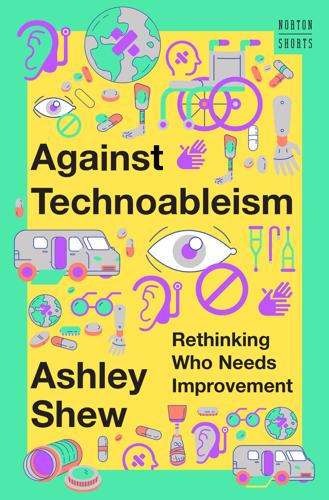
Against Technoableism: Rethinking Who Needs Improvement
by
Ashley Shew
Published 18 Sep 2023
We might also talk about the higher incidence of eating disorders and alcoholism among autistic people too here, which can be strategies to cope with demands and anxieties produced in coercive contexts. 28Autistic rhetorician Remi Yergeau has a wonderful article doing autoethnography on how people talk about autistic people in Theory of Mind research. In this piece, they show how “theories about ToM [Theory of Mind] deny autistic people agency by calling into question their very humanity and, in doing so, wreak violence on autistic bodies.” For more information about the problems with and limits of theory of mind (ToM) as it is currently constructed in psychology and cognitive studies, see Remi Yergau, “Clinically Significant Disturbance: On Theorists Who Theorize Theory of Mind,” Disabled Studies Quarterly 33, no. 4 (2013), https://dsq-sds.org/article/view/3876/3405 29Pavlov was not nice to his dogs, if you check out what he was doing in this and in his later experiments, and he didn’t use bells—more likely a buzzer.
…
Bell (1927), 20 Çevik, Kerima, 104 Carter-Long, Lawrence, 27, 28 “Case for Conserving Disability” (Garland-Thomson), 52 Case for Disabled Astronauts, The (Wells-Jensen), 126 cerebral palsy, 91 chapter guide, 12–13 charity marketing campaigns, 36–37 Charles, Ray, 35 chattel slavery, 24 chemobrain, 11–12, 77, 78, 112 Chertock, Marlena, 126 “Choreography for One, Two, and Three Legs” (Sobchack), 138n15 citizenship, 18, 137n6 Claiming Crip (Hitselburger), 30 Clare, Eli, 124 climate change, 115–16, 117 “Clinically Significant Disturbance: On Theorists Who Theorize Theory of Mind” (Yergeau), 140n28 cochlear implants, 71–72 colonization effects, 24–25 concentration camps, 91 congenital amputees, 57 congenital disability, 89 Covid-19, 41, 52, 58, 115, 118, 138n13, 141n38 “crip,” 30 Crip Camp, 30 Crohn’s disease, 4 cross-disability community connections, 12, 77, 78–81, 85–86, 131 cultural technologies, 83, 107–8 Cyborg Jillian Weise, The, 2, 9–10 cyborgs (technologized disabled people), 55 Dancing with the Stars, 49, 60, 61, 63, 64 Deaf community, 71–72, 73 Deaf Gain, 73–74 Deaf Poets Society, The, 125–26 Decolonizing Mars Unconference, 117, 127–28 dehumanization, 88–89, 100, 101–2, 140n28 de Leve, Sam, 126, 130 “Descent” (Kinetic Light Project), 62–63 diabetes, 59, 138nn12–13 Diagnostic and Statistical Manual (DSM), 19, 102 disability conscious acts of empowerment, 28–30 economic categorization of, 24–25 historical framework of, 24–25, 26–27 pathologized approach vs. experiential/relational approach to, 85–86 political/relational contexts within, 88 as predictable human experience, 114–15 as social construct, 21 uncertainty and, 120–24 disability activism, 12, 79 campus accessibility campaigns, 138n7 celebrating disability embodiment and, 62–63 centering disabled people in disabled technology, 17, 110–11 charities garnering activist critique, 92 cross-community coalitions and, 79–80 disability rights, 44, 92, 105 disability rights movement, 27, 28, 31, 56, 92, 109 disability communities amputee community, 3, 12–13, 14–15, 26, 58, 59, 74–75 autistic community, 77, 79–80, 105–6, 112 claiming identity, 28–29 Deaf community, 71–72, 73 framing language of, 25–26, 30, 31 inclusion/diversity of, 22, 82, 115, 124 media generated tropes and, 40, 41–43 nondisabled experts harm to, 10–11, 19–20, 88 principles of justice, 125 representation and, 4, 56, 119 value of, 51, 56, 113, 122, 124, 125 See also neurodivergence disability culture, 107–8 disability experts, 2–3, 10–11, 17, 19–20, 50–51, 100, 123, 131 disability history, 24–25, 26–27, 31, 88–92 Disability History of the United States, A (Nielsen), 23 disability language, 11, 23, 25–26, 30, 31, 72 disability parking, 5–6, 38–39, 78 disability service professionals, 85–86, 95–96 disability and technology centering disabled as experts, 17, 110–11 cultural technologies, 83, 107–8 deterioration and usage, 60 disorientation and, 22–33, 44–45 historical Nazi Germany and, 89–92 insight for technological futures, 123–24, 128–30 media narratives and, 17, 32–33, 35, 50–51, 59, 60–61 medical model of disability and, 71 technoableism, defined, 7–8, 9, 130 technofuturists and, 114, 118–19 technological solutionism and, 4, 8, 9–10, 32, 51–53, 71–72, 74 See also accessible environments Disability Visibility Project, 114 disability welfare, 34, 38 disabled, etymology, 27–28 disabled ecologies, 116 Disposable Humanity (Snyder and Mitchell), 92 Divas with Disabilities Project, 56 Down syndrome, 91 Down Syndrome Uprising, 94 drapetomania, 25 DSM (Diagnostic and Statistical Manual), 19, 102 Dungeons & Dragons, 80, 107, 109 Ehlers-Danlos Syndrome (EDS), 85 emotional regulation, 97 enhancement technologies, 51 environmental health hazards, 116–17 environmental racism, 115–16 eugenics history, 89–92 euthanasia, 91 Evans, Dom, 35 exoskeletons, 8, 22, 50, 55 eye contact, 83, 84, 86, 99, 103 Fakorede, Foluso, 58 fatphobia, 17 feel-good narratives, 53–54 Feminine Boy Project, 102 Film-Dis, 35 flappy hands, 96–97 Forber-Pratt, Anjali, 28 forced sterilization, 88, 91 Funk, Cynthia, 56 Fuselier, Annabelle, 112 Gallaudet Eleven, 127, 130 Gardiner, Finn, 97, 106–9 Garland-Thomson, Rosemarie, 28, 52, 68 gay conversion therapy, 102, 103 gender dysphoria, 102 handicapped, 26–27 Hawking, Stephen, 128 Hearing Happiness (Virdi), 71, 73 Heidinger, Willi, 90 Herr, Hugh, 51, 53, 56, 67 Hershey, Laura, 124 Hitler, Adolf, 89, 90 Hitselburger, Karin, 30 Holocaust, 89 Hough, Derek, 61 “I Am Autism” (Wright), 92–93 IDEA (Individuals with Disability Education Act), 26 identity-first language, 25–26 Indian Residential Schools, 24 Indigenous peoples, 23, 24, 25 Individuals with Disability Education Act (IDEA), 26 inspirational-overcomers trope, 41–44, 46–47, 49, 54–55, 60–64, 71–72 inspiration porn, 41–44 institutionalization, 88 intellectual disabilities, 29, 95 Invitation to Dance (Linton), 62, 138n10 James, William, 139n16 Jerry’s Kids, 37 Johnson, Cyrée Jarelle, 124 Johnson, Harriet McBryde, 31, 37 Jones, Keith, 30 Judge Rotenberg Center (JRC), 104–5 Kennedy, John F., 139n23 Kennedy, Rosemary, 139n23 Krip Hop Nation, 30 Lamm, Nomy, 124 Law, Ashtyn, 35 Left Hand of Darkness, The (LeGuin), 120–21 leg amputees, 16, 49, 64–67, 69–70 LeGuin, Ursula K., 120, 121 Leib-Neri, Marisa, 23–24 Lewis, Jerry, 37 Lewis, Talila A., 9 Linton, Simi, 27, 62, 138n10 Little People of America, 94 Long Covid, 41, 52, 115, 118 Lovaas, Ivar, 100–102 Lumumba-Kasongo, Enongo 128 Lyme disease, 119 MacIntyre, Alasdair, 119 Magic Wand, The (Manning), 34 Manning, Lynn, 34–35 McCollins, André, 104–5 McCollins, Cheryl, 104 McLain, Elizabeth, 106–7, 111–12 McLeod, Lateef, 124 media narratives, 17, 32–33, 35, 50–51, 59, 60–61 See also tropes medical experimentation, 91 medical model of disability, 20–21, 31, 71, 139n22 mental illness, 25, 88, 102, 130 Meyer, Bertolt, 55 Milbern, Stacey, 124 Mitchell, David, 92 mobility equipment, 17, 22, 48, 55, 69, 131, 137n5 moochers-and-fakers trope, 38–39, 88–89 Moore, Leroy Jr., 30, 124 movement choices, 16, 62–63 Muscular Dystrophy Association telethons, 37, 92 Nario-Redmond, Michelle, 137n3 National Council on Independent Living, 94 National Institutes of Mental Health, 102 Native American cultures, 23, 24, 25 Nazi Germany, 89–92 Nelson, Mallory Kay, 14, 16, 137n5 neurodivergence addressing social structures, 86–87, 88 applied behavioral analysis and, 95–101, 103–5 Autism Speaks and, 37, 92–93, 94, 95 autistic community and, 77, 79–80, 105–6, 112 autistic scholars panel, 106–12 cross-disability community connections, 12, 77, 78–81, 85–86, 131 cultural technologies and, 83, 107–8 dehumanization and, 88–89, 100, 101–2, 140n28 disability service professionals and, 85–86, 95–96 historical Nazi Germany, 89–92 language of, 84–85 neurodiversity and, 12, 13, 80, 81, 82, 84 neuroqueer, 102 neurotypical and, 81–82, 83 stimming and, 96–97 See also autism spectrum disorder; disability communities neurodiversity, 12, 13, 80, 81, 82, 84 neurodiversity movement, 13, 82 neurodiversity paradigm.
…
See autism spectrum disorder Staring (Garland-Thomson), 68 stereotypes, 4, 27, 34, 35, 36, 55, 111 Stevens, Bethany, 137n5 Steward, Robyn, 106 stimming, 96–97 Sutton, Michelle, 10–11, 19, 106 T4 program, 91 TAB (temporarily able-bodied), 23 Tales from the Crip (Tischer), 30 Taylor, Sunaura, 116 technoableism, defined, 7–8, 9, 130 technofuturists, 114, 118–19 technological solutionism, 4, 8, 9–10, 32, 51–53, 71–72, 74 technologized disabled people (cyborgs), 55 technology. See disability and technology techno-optimism, 60 temporarily able-bodied (TAB), 23 Theory of Mind research, 140n28 Thinking Person’s Guide to Autism, A (Gardiner), 97 Thompson, Vilissa, 42 3-D printers, 68 Till, Emmett, 104 Till, Mamie, 104 Tischer, Ingrid, 30 Titchkosky, Tanya, 53 Too Late to Die Young (Johnson), 37 tropes bitter cripple, 39–40 definition of, 35–36 inspirational-overcomers, 41–44, 46–47, 49, 54–55, 60–64, 71–72 moochers-and-fakers, 38–39, 88–89 pitiable-freaks, 36–37, 88–89 shameful sinners, 40–41 True Biz (Nović), 71, 72 Ugly Laws, 18 United Nations, 104 universal design, 8, 87, 88 Unstrange Mind (Sparrow), 98 U.S. immigration policies, 17–18 vascular disease, 59 Virdi, Jai, 71, 73 Walker, Nick, 81, 84, 102 Walkowicz, Lucianne, 127 Walton, Donna R., 56 War Against the Weak (Black), 89, 90 war heroes, 57, 59 Weise, The Cyborg Jillian, 2, 9–10 Wells-Jensen, Sheri, 18, 126, 128, 130 We Love Like Barnacles: Crip Lives in Climate Chaos (2021), 125 wheelchair icon, 21–22 white privilege, 42 white supremacy, 17 Williams, Damien P., 107 Williams, Rua, 106, 110–11 Wonder, Stevie, 35 Wong, Alice, 30, 125–26 Wright, Bob, 92 Wright, Suzanne, 92 xenophobia, 17 Yergeau, Remi, 140n28 Young, Stella, 43 Norton Shorts BRILLIANCE WITH BREVITY W.

I, Warbot: The Dawn of Artificially Intelligent Conflict
by
Kenneth Payne
Published 16 Jun 2021
Moreover, we have the ability to generalise our learning from one task to another, adapting our skills to suit new conditions. Language helps immensely—giving us the ability to explain complex ideas and share knowledge, even when the object isn’t physically present. All this is predicated on our ‘theory of mind’—the empathic ability, partly instinctive, partly the product of deliberate reasoning, to think and feel what others are thinking and feeling. Lest we get too complacent about the glory of human innovation and intuition, we ought not to forget the ways in which we, like ants, make our decisions instinctively, on the basis of hardwired, situationalist thinking.
…
That’s the very basis of strategy: ‘know your enemy’, as Sun Tzu, the author of The Art of War, counsels. Humans struggle with that sort of intelligence too. But unlike the machine, humans can use their judgment to imagine what the enemy is thinking. After all, aren’t they a little like us? Theory of mind Once the intelligence processing algorithms have spooled through the available information, what then? The goal for strategists is to use this information to predict what will happen next. Spotting elusive patterns in massive, noisy data sets is one thing, but predicting what will happen on the basis of all that information is another, altogether tougher, challenge.
…
Machines lack empathy Today, even the most intelligent machines have almost no capacity to intuit what others feel or think. The famous Turing test, where a machine (or rather its designers) attempts to fool a human into thinking it is also human, is a nice party trick, but nothing more. The machines, at least those that have been deployed in Turing test competitions to date, aren’t engaged in theory of mind calculations like ours when we converse. If anything, they rely on our tendency to overly-anthropomorphise, given the slightest opportunity. Humans are duped into thinking the machine is human by its stock generalisations, or vaguely plausible glib answers. Sure, you can fool some of the people this way, some of the time, but not very often.
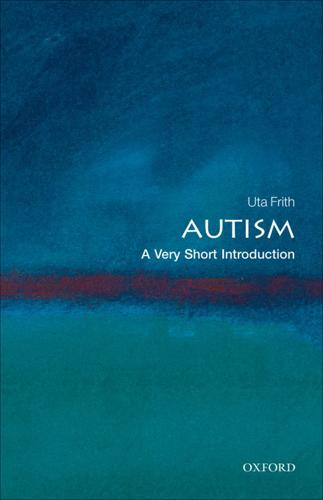
Autism: A Very Short Introduction
by
Uta Frith
Published 22 Oct 2008
, 85, 87 Mental retardation, see learning disability Mentalizing, mind-reading, Theory of Mind, 67–72, 81, 82, 109, 123 MMR vaccination 43–6, 122 Mirror neurons 76–81, 123 N National Autism Societies 23 O Obsessive 11, 12, 21, 49, 93 Old Age 32–3 P Parents, see also Families 7, 15, 18, 23, 42, 44, 54, 91, 117, 119 PDD–NOS 6, 56 Personality type 37 Play 16, 17, 18, 89 Psychopaths 83 Prevalence 39–42, 122 Pruning of the brain 55, 63, 63, 110 Purkinje cells R Rainman 28–30 Reciprocal interaction 9, 13–14, 48 Regression 15–16, 44, 97 Repetitive activities 11, 12, 27, 33, 93, 95 Restricted activities 11, 12, 95 Rigidity 4, 11, 31, 97 Rimland, Bernard 21 Rutter, Michael 2, 22, 54, 123 S Sally-Anne test 67–9, 72 Savant talent 85–94, 124 Schopler, Eric 25 Screening 18 Senju, Atsushi 80 Self 102–4, 111 Smarties test 65 Special Education, see Education Steven Wiltshire 85–7 Stress 94, 97, 119–20 Social brain 73, 76 Social interest 13, 34, 73, 84, 123 Social stereotypes 83–4 Supermarket 97 Sybil Elgar 23 Systemizing and empathizing 50–1, 94 T Talent 24, 27, 31, 49, 85–8, 103, 112 TEACCH 25 Temple Grandin 32, 112–13, 126 Testosterone 51 Theory of mind, see Mentalizing Thomas the Tank Engine 116 Theory of Mind, see Mentalising Thimerosal 45–6, 54 Top-down and bottom-up 98–104, 110–11, 124 Transporters 117 Triad of impairments 22 Twins 54–5 V Vaccination 44–6 Visual perception 91–2, 94, 124 W Wing, Lorna 2, 22, 34, 122, 126 Y Yawning 79–80
…
Christopher can’t read minds. The social part of our brain and mind normally allows us to react automatically to other people’s behaviour. We don’t have to think about it, but we can explain what people do by taking into account what they think and want. This has been dubbed ‘mentalizing’ or having a ‘Theory of Mind’. In autism the mentalizing mechanism has gone wrong. The first ever test of the big idea is illustrated in Figure 9. It goes like this: Sally has a basket, and Anne has a box. Sally has a marble and puts it inside her basket. Then she goes to play outside. While Sally is away, naughty Anne takes the marble from the basket and puts it into her own box.
…
One extremely able person with autism said about his difficulties in social interaction, ‘I sit down after an exchange to figure out intentions, beliefs, etc. I definitely need to do this “off-line”, after-the-fact, not in real-time.’ 9. The Sally–Anne test This test was used by Baron-Cohen, S., Leslie, A. and Frith, U. (1985) Does the autistic child have a “theory of mind”? Cognition, 21, 37–46 So, learning does go on but it often misses the crucial point. For instance, the mother of a young man with autism said: ‘I have taught him to apologize when he has hurt somebody’s feelings. He always does this—except he doesn’t recognize when the feelings are hurt. He is over-doing it.’
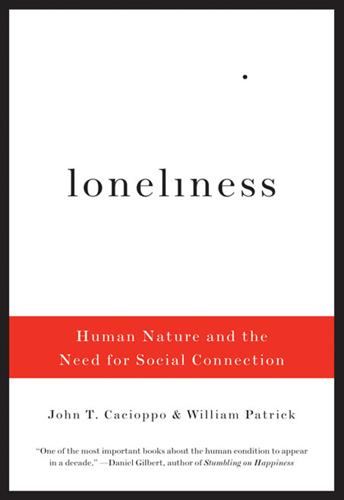
Loneliness: Human Nature and the Need for Social Connection
by
John T. Cacioppo
Published 9 Aug 2009
Having more intelligence has adaptive value for large mammals because it facilitates discovering better ways to find or capture food, avoid perils, and navigate territories, but the complexities of these demands pale by comparison to the complexities of social living. Living in groups placed a premium on having the ability to recognize the mental states of others—a capacity called “theory of mind.” But once again, theory of mind is a form of social cognition, an ability that becomes readily distorted through the experience of loneliness. But There’s a Catch Whether you are a relatively independent Greg or a need-to-be-close Katie, no one wants to feel the pain of loneliness, and no one should be blamed for being trapped inside it.
…
Just ask any dog or cat owner, and they will tell you that pets know what “their” human is feeling, and know what to do to provide comfort when that human is feeling blue. By the same token, leave your Jack Russell alone too long and you may find that he’s taken out his displeasure on the throw pillows from your couch. Theory of Mind, and Then Some Among chimps, an aggressor who has attacked and bitten another, but who is now intent on reconciliation, will often look directly at the spot where he injured the other, inspect it, then begin to clean the wound. Bonobos, who, at least in captivity, often have sex face to face, carefully monitor and respond to the expressions and vocalizations of their partner.
…
If you want to build more satisfying social connections, it helps to know more about how “emotional connection” occurs in a functional sense, which is to say, how one human brain gains access to the thoughts, feelings, and intentions of another. It also helps to know how and why that system can become overwhelmingly confused. Theory of mind, which is what we call the ability to have insights into other people’s thoughts, feelings, and intentions, develops in humans when we are about two years old. This is the same time when we begin to recognize ourselves in mirrors. So self-awareness and the ability to understand the feelings and intentions signaled by others may be connected.
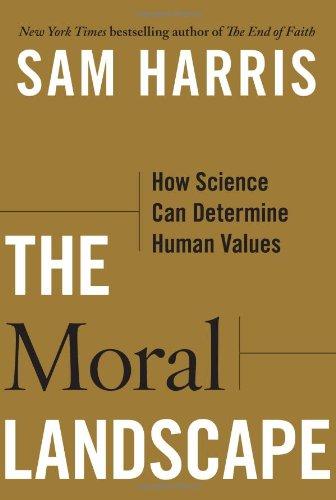
The Moral Landscape: How Science Can Determine Human Values
by
Sam Harris
Published 5 Oct 2010
In this, they appear to be guided by an awareness of potential human suffering. Children at risk for psychopathy tend to view these questions as morally indistinguishable. When asked to identify the mental states of other people on the basis of photographs of their eyes alone, psychopaths show no general impairment.84 Their “theory of mind” processing (as the ability to understand the mental states of others is generally known) seems to be basically intact, with subtle deficits resulting from their simply not caring about how other people feel.85 The one crucial exception, however, is that psychopaths are often unable to recognize expressions of fear and sadness in others.86 And this may be the difference that makes all the difference.
…
R. (2006). The development of implicit attitudes. Evidence of race evaluations from ages 6 and 10 and adulthood. Psychol Sci, 17 (1), 53–58. Baron, J. (2008). Thinking and deciding (4th ed.). New York: Cambridge University Press. Baron-Cohen, S. (1995). Mindblindness: An essay on autism and theory of mind. Cambridge, MA: MIT Press. Barrett, J. L. (2000). Exploring the natural foundations of religion. Trends Cogn Sci, 4 (1), 29–34. Bauby, J.-D. (1997). The diving bell and the butterfly (1st U.S. ed.). New York: A. A. Knopf. Baumeister, R. F. (2001). Violent pride. Sci Am, 284 (4), 96–101.
…
Personality, culture, and subjective well-being: Emotional and cognitive evaluations of life. Annu Rev Psychol, 54, 403–425. Ding, Y. C., Chi, H. C., Grady, D. L., Morishima, A., Kidd, J. R., Kidd, K. K., et al. (2002). Evidence of positive selection acting at the human dopamine receptor D4 gene locus. Proc Natl Acad Sci USA, 99 (1), 309–314. Dolan, M., & Fullam, R. (2004). Theory of mind and mentalizing ability in antisocial personality disorders with and without psychopathy. Psychol Med, 34 (6), 1093–1102. Dolan, M., & Fullam, R. (2006). Face affect recognition deficits in personality-disordered offenders: Association with psychopathy. Psychol Med, 36 (11), 1563–1569. Donadio, R. (2010a, March 26).

Surviving AI: The Promise and Peril of Artificial Intelligence
by
Calum Chace
Published 28 Jul 2015
While a successful whole brain emulation could be expected to produce something which thought somewhat like a human, an AGI based on traditional AI might think in an entirely alien way. 4.4 – A comprehensive theory of mind The third approach to building an artificial general intelligence is to develop a comprehensive theory of mind – that is, to achieve a complete understanding of how the mind works – and to use that knowledge to build an artificial one. Although neuroscience has probably made more progress in the last 20 years than in the whole of human history beforehand, we are still very far from a complete theory of mind. If no serious attempt was made to build an AGI until such a theory was complete it would probably not happen until well past the end of this century.
…
Quantum consciousness The distinguished Oxford physicist Sir Roger Penrose argued in 1989 that human brains do not run the same kind of algorithms as computers. He claimed that a phenomenon described by quantum physics known as the wave function collapse could explain how consciousness arises. In 1992 he met an American anaesthetist called Dr Stuart Hammeroff, and the two collaborated on a theory of mind known as Orchestrated Objective Reduction (Orch-OR). It attributes consciousness to the behaviour of tiny components of cells called microtubules. The two men have continued to develop their thinking ever since, but the great majority of physicists and neuroscientists deny its plausibility. The main line of attack, articulated by US physicist Max Tegmark, is that collections of microtubules forming collapsing wave functions would be too small and act too quickly to have the claimed impact on the much larger scale of neurons.
…
However, it is not hard to imagine that if and when the prospect of conscious machines comes closer, the research may come under fire from particularly ardent worshippers. In the next three sections we will look at three ways to build a mind – an artificial system which can perform all the intellectual activities that an adult human can. They are: Whole brain emulation Building on artificial narrow intelligence A comprehensive theory of mind 4.2 – Whole brain emulation Whole brain emulation is the process of modelling (copying or replicating) the structures of a brain in very fine detail such that the model produces the same output as the original. So if a brain produces a mind, then the emulation (the model) produces a mind also.

Ten Arguments for Deleting Your Social Media Accounts Right Now
by
Jaron Lanier
Published 28 May 2018
THE LOST THEORY IN YOUR BRAIN The ability to theorize about what someone else experiences as part of understanding that person is called having a theory of mind. To have a theory of mind is to build a story in your head about what’s going on in someone else’s head. Theory of mind is at the core of any sense of respect or empathy, and it’s a prerequisite to any hope of intelligent cooperation, civility, or helpful politics. It’s why stories exist. You’ve heard expressions like “Don’t judge someone until you’ve walked a mile in their shoes.” You can’t understand people without knowing a little of what they’ve gone through. Most animals get by without theory of mind, but people need it. When you can only see how someone else behaves, but not the experiences that influenced their behavior, it becomes harder to have a theory of mind about that person.
…
When you can only see how someone else behaves, but not the experiences that influenced their behavior, it becomes harder to have a theory of mind about that person. If you see someone hit someone else, for instance, but you did not see that they did it in defense of a child, you might misinterpret what you see. In the same way, if you don’t see the dark ads, the ambient whispers, the cold-hearted memes, and the ridicule-filled customized feed that someone else sees, that person will just seem crazy to you. And that is our new BUMMER world. We seem crazy to each other, because BUMMER is robbing us of our theories of one another’s minds.
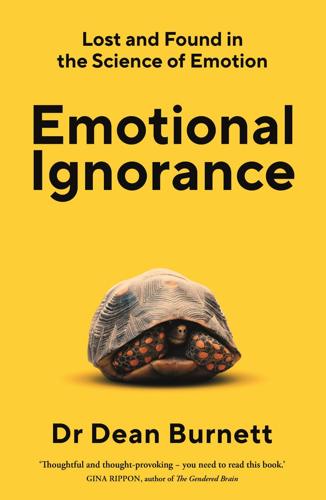
Emotional Ignorance: Lost and Found in the Science of Emotion
by
Dean Burnett
Published 10 Jan 2023
Camilleri, ‘Psychopathy and victim selection: the use of gait as a cue to vulnerability’, Journal of Interpersonal Violence, 2013, 28(11): pp. 2368–2383. 4 Scott, S.K., et al., ‘The social life of laughter’, Trends in Cognitive Sciences, 2014, 18(12): pp. 618–620. 5 Seyfarth, R.M. and D.L. Cheney, ‘Affiliation, empathy, and the origins of theory of mind’, Proceedings of the National Academy of Sciences, 2013, 110(Supplement 2): pp. 10349–10356. 6 Levinson, S.C., ‘Spatial cognition, empathy and language evolution’, Studies in Pragmatics, 2018, 20: pp. 16–21. 7 Land, W., et al., ‘From action representation to action execution: exploring the links between cognitive and biomechanical levels of motor control’, Frontiers in Computational Neuroscience, 2013, 7: p. 127. 8 Meltzoff, A.N. and M.K.
…
Journal of Experimental Social Psychology, 1988, 24(4): pp. 333–353. 35 Buck, R., ‘Communicative genes in the evolution of empathy and altruism’, Behavior Genetics, 2011, 41(6): pp. 876–888. 36 Stietz, J., et al., ‘Dissociating empathy from perspective-taking: evidence from intra- and inter-individual differences research’, Frontiers in Psychiatry, 2019, 10: p. 126. 37 Batson, C.D., et al., ‘Empathic joy and the empathy-altruism hypothesis’, Journal of Personality and Social Psychology, 1991, 61(3): p. 413. 38 Carr et al., ‘Neural mechanisms of empathy in humans’. 39 Gallagher, H.L. and C.D. Frith, ‘Functional imaging of “theory of mind”’, Trends in Cognitive Sciences, 2003, 7(2): pp. 77–83. 40 Allman, J.M., et al., ‘The anterior cingulate cortex: the evolution of an interface between emotion and cognition’, Annals of the New York Academy of Sciences, 2001, 935(1): pp. 107–117. 41 Decety and Jackson, ‘The functional architecture of human empathy’. 42 De Vignemont, F. and T.
…
Wagner, ‘Imaging empathy and prosocial emotions’, Neuroscience Letters, 2019, 693: pp. 49–53. 88 Carlson, N.R., Physiology of Behavior (Pearson Higher Education, 2012). 89 Silani, et al., ‘Right supramarginal gyrus is crucial’. 90 Chang, S.W., et al., ‘Neural mechanisms of social decision-making in the primate amygdala’, Proceedings of the National Academy of Sciences, 2015, 112(52): pp. 16012–16017. 91 Stietz, et al., ‘Dissociating empathy from perspective-taking’. 92 Hein, G. and R.T. Knight, ‘Superior temporal sulcus – it’s my area: or is it?’ Journal of Cognitive Neuroscience, 2008, 20(12): pp. 2125–2136. 93 Dvash, J. and S.G. Shamay-Tsoory, ‘Theory of mind and empathy as multidimensional constructs: neurological foundations’, Topics in Language Disorders, 2014, 34(4): pp. 282–295. 94 Joireman, J.A., T.L. Needham, and A.-L. Cummings, ‘Relationships between dimensions of attachment and empathy’, North American Journal of Psychology, 2002, 4(1): pp. 63–80. 95 Hall, J.A. and S.E.

Possible Minds: Twenty-Five Ways of Looking at AI
by
John Brockman
Published 19 Feb 2019
Humanly designed systems that achieve intelligence vindicate the notion that information processing is sufficient to explain it—the notion that the late Jerry Fodor dubbed the computational theory of mind. The touchstone for this volume, Norbert Wiener’s The Human Use of Human Beings, celebrated this intellectual accomplishment, of which Wiener himself was a foundational contributor. A potted history of the mid-20th-century revolution that gave the world the computational theory of mind might credit Claude Shannon and Warren Weaver for explaining knowledge and communication in terms of information. It might credit Alan Turing and John von Neumann for explaining intelligence and reasoning in terms of computation.
…
Throughout his career, whether studying language, advocating a realistic biology of mind, or examining the human condition through the lens of humanistic Enlightenment ideas, psychologist Steven Pinker has embraced and championed a naturalistic understanding of the universe and the computational theory of mind. He is perhaps the first internationally recognized public intellectual whose recognition is based on the advocacy of empirically based thinking about language, mind, and human nature. “Just as Darwin made it possible for a thoughtful observer of the natural world to do without creationism,” he says, “Turing and others made it possible for a thoughtful observer of the cognitive world to do without spiritualism.”
…
Her books include The Philosophical Baby and, most recently, The Gardener and the Carpenter: What the New Science of Child Development Tells Us About the Relationship Between Parents and Children. Alison Gopnik is an international leader in the field of children’s learning and development and was one of the founders of the field of “theory of mind.” She has spoken of the child brain as a “powerful learning computer,” perhaps from personal experience. Her own Philadelphia childhood was an exercise in intellectual development. “Other families took their kids to see The Sound of Music or Carousel; we saw Racine’s Phaedra and Samuel Beckett’s Endgame,” she has recalled.
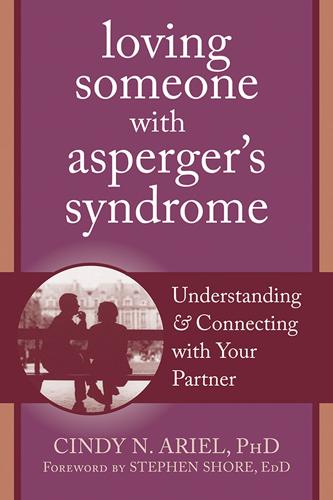
Loving Someone With Asperger's Syndrome: Understanding and Connecting With Your Partner
by
Cindy Ariel
Published 1 Mar 2012
The more you get to know someone, the more it may be possible to make accurate predictions. People with AS often have challenges in this area. Theory of Mind Believing that your partner knows what you need and withholds it, rather than that she lacks understanding, can cause upset and confusion for both of you. Psychologists refer to theory of mind when discussing the knowledge people develop that what we think or experience is different from what others think and experience. People with Asperger’s have a less-developed theory of mind than people without the syndrome (Baron-Cohen 2003). Your partner may find it difficult to understand that you have different emotional needs or opinions than she does.
…
When he played games with his kids, he had to win every time, or he got angry and refused to play. Either way, his games with the children ended with the children in tears and their mother beside herself with frustration at her husband’s “childlike” behavior. Some parents with AS react strongly to misperceived behavior of the children. Such misperceptions are related to theory of mind (see chapter 8), because some parents with AS can have difficulty distinguishing between intentional and accidental actions of children. One AS father I spoke with complained that the children totally destroyed order in the kitchen and wreaked havoc with food storage. His partner described an incident in which they both came home from grocery shopping and asked their ten-year-old child to put the food away.
…
Loud noises or confusing commotion can make it hard for such parents to be there with their children. Energy depletion can also be a problem. By the end of the workday, many parents with AS have little energy or resources left to deal with their children. Co-parenting Rigidity in routine, sensory issues, anxiety, and underdeveloped theory of mind are issues that may affect your partner’s ability to parent at times. Many coping strategies for parenting are available, depending on the specific parenting strengths that you and your partner possess. For example, if your partner has difficulty understanding the baby’s nonverbal cues, consider teaching her three things to try when the baby cries: pick him up, change his diaper, or give him a bottle.
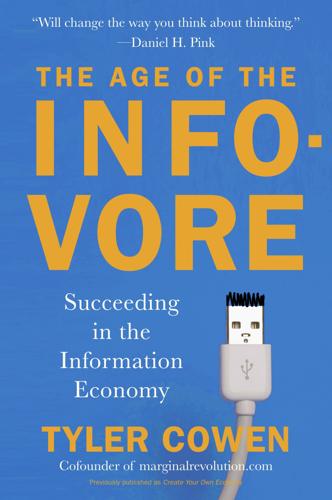
The Age of the Infovore: Succeeding in the Information Economy
by
Tyler Cowen
Published 25 May 2010
When it comes to autism, very often whether a given generalization is true depends on which subgroup of autistics is being considered. It is a common stereotype that autistics are unaware of the mental existence of other people, but this is a very poor definition of autism. Many autistics do fine on “theory of mind” tests and can understand the intentions of other people quite well. Furthermore many non-autistic children with handicaps, including linguistic handicaps, fail theory of mind tests just as some autistic children do. Theory of mind experiments usually test a complex bundle of human features, including attention-shifting abilities, interpretation of commands, linguistic skills, and common frames of cultural reference.
…
Note also that Smith wrote down many observations about sympathy but he doesn’t seem to show an intuitive understanding of which points are brilliant insights and which are ordinary observations shared by every man on the street. When thinking about Smith, I am struck by Jared Blackburn’s web discussion of the autistic theory of mind. Jared is a self-described autistic and he opined that many autistic people obtain exceptional insight into others by drawing upon their cognitive skills and approaching the topic of other people from different angles. Even if autistics have slower response speeds in understanding non-autistics, their understanding is not necessarily inferior and it may in some regards be superior.
…
Stone, and Linda R. Watson, “Sensory Experiences Questionnaire: Discriminating Sensory Features in Young Children with Autism, Developmental Delays, and Typical Development,” Journal of Child Psychology and Psychiatry 47, no. 6 (2006), 591–601. On whether autistics suffer from the lack of a “theory of mind” or whether this is simply picking up speech deficits or other cognitive problems, see for instance Morton Ann Gernsbacher and Jennifer L. Frymiare, “Does the Autistic Brain Lack Core Modules?” Journal of Developmental and Learning Disorders 9 (2005), 3–16. See also Lawrence Hirschfeld, Elizabeth Bartmess, Sarah White, and Uta Frith, “Can autistic children predict by social stereotypes?”
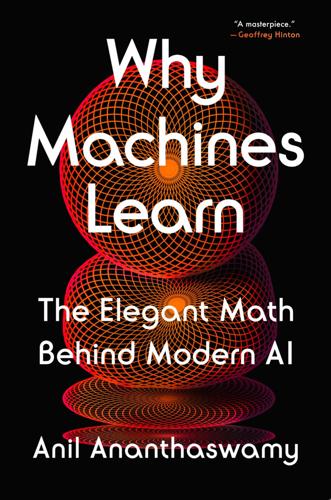
Why Machines Learn: The Elegant Math Behind Modern AI
by
Anil Ananthaswamy
Published 15 Jul 2024
Epilogue When I began working on this book in the autumn of 2020, LLMs such as OpenAI’s GPT-3 and Google’s PaLM—and the chatbots they begat, such as ChatGPT and Bard—had yet to break through into the broader public consciousness. And when ChatGPT was announced in late 2022, one of the first things I explored was its ability to demonstrate theory of mind. Theory of mind is a cognitive ability humans have that allows us to make inferences about someone else’s beliefs or state of mind using only external behavioral cues such as body language and the overall context. We theorize about the contents of someone else’s mind; hence the phrase “theory of mind.” Here’s a question I posed ChatGPT, a few months after its release. (I have italicized some words in the chatbot’s output to highlight their import.)
…
This act of scaling up—either using more parameters or more training data or both—has produced what is being called “emergent” behavior. Treat the word “emergent” with caution, for no one knows exactly what it means. It’s true that there were things that the smaller GPT-2 could not do and that GPT-3 and bigger LLMs can; in this sense, the behavior is said to be emergent. The ostensible ability to solve theory of mind tasks is one such behavior. Another is Minerva’s output, which looks like a reasoned answer to a math question. (We saw an example of this in the previous chapter.) Smaller LLMs did not display these abilities. Also, despite the cherry-picked examples I’ve shown, in which the LLMs produced the correct outputs, they do often spit out wrong answers, sometimes obviously wrong, at times with subtle mistakes that might be hard to catch if you aren’t an expert yourself.
…
(Emily Bender of the University of Washington and colleagues coined a colorful phrase for LLMs; they called them “stochastic parrots.”) Others see glimmers of an ability to reason and even model the outside world. Who is right? We don’t know, and theorists are straining to make mathematical sense of all this. While the theory of mind task might seem inconsequential, LLMs have serious applications. For example, LLMs fine-tuned on web pages containing programming code, are excellent assistants for programmers: Describe a problem in natural language, and the LLM will produce the code to solve it. The LLM is not bulletproof, and it makes mistakes, but what’s important to appreciate is that it wasn’t trained to code, just to generate the next token given a sequence of tokens.
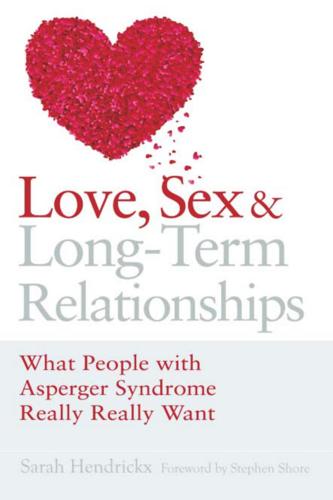
Asperger Syndrome: A Love Story
by
Sarah Hendrickx
and
Keith Newton
Published 14 Jun 2007
Unfortunately, there may be an expectation from a partner that they will somehow ‘know’ what is required emotionally, and not doing so can cause distress and confusion for both parties: How can a man expect to understand women if he can’t even understand himself ? (AS male) Emotional support and managing feelings Those with AS are said to have a less developed ‘Theory of Mind’ compared to their same age peers (Baron-Cohen 2003). This is an ability that develops in small children who, as they grow, begin to realise that they are not the only people in the world, and that others have different thoughts and knowledge from their own. Many adults with AS can find it very difficult to anticipate and comprehend that a partner may have different emotional needs.
…
Reasons for engaging in harassment can be a genuine lack of understanding of social signals by the person with AS. The focus of their attention may have been kind of friendly and this may have been misinterpreted. There may be a difficulty in perceiving that upset or distress is being felt by the person due to less mature ‘theory of mind’ abilities. There will doubtless be a logical thought process that has occurred in the mind of the person with AS, which has resulted in the behaviour. It is unlikely that there is real understanding of the consequences of the behaviour for themselves or their target: I can’t read sexual signals easily and this has got me into trouble before as I’ve often thought that people were being friendly when they were coming on to me sexually, and this has hurt and upset my partner greatly.
…
If this had been an establishment involving children or other vulnerable groups, this could have led to arrest. The desire to meet one’s needs may override the person’s perception of the appropriateness of the behaviour. It may also be difficult for a person with AS to transfer the concept that looking at pornography is OK in one setting but not in another. Less developed empathy/‘Theory of Mind’ skills may mean that the individual is not able to appreciate the consequences of their behaviour on others, making their own needs the only consideration. The tendency to speak the truth can also result in a person with AS making inappropriate remarks to others, which may be taken as offensive when the person only intends to express their thoughts or opinions.
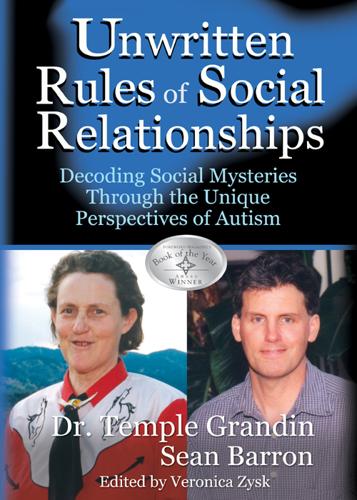
The Unwritten Rules of Social Relationships: Decoding Social Mysteries Through the Unique Perspectives of Autism
by
Temple Grandin
and
Sean Barron
Published 30 Sep 2012
I took one of my dresses and put it on a coat hanger and then put a paper bag on it as a head and painted some eyes on it. I put it on a string, then lowered it out the window All the guests screamed as though someone had fallen out the window. It was pretty funny. I had a really good visual theory of mind, instead of emotional theory of mind. For instance, one time when we were playing hide and seek I got the idea of creating a fake person to distract the goal keeper. I thought, now if I take some coats and I stuff them with leaves and I put them up in the tree, the goal keeper is going to go over there and then we can run in and catch the goal.
…
Despite what looked like a disregard for parents and people around him, Sean’s nature contained the seed of emotional-relatedness that exists in different degrees within people on the autism spectrum. Looking back now, we realize that his emotional-relatedness capacity was high; missing from the equation, however, was the ability to step outside his own mind, to think flexibly and with what we now refer to as Theory of Mind—the ability to perceive the world from another person’s point of view. Every social misstep was a blow to his fragile self-esteem; every misunderstanding a testament that something was inherently wrong with him, that he was “bad.” He was self-focused, not by choice but by his autism. Managing the fear and anxiety associated with daily functioning was often too much to bear; angry explosions were frequent and only dragged him down farther into the black hole of self-despair.
…
Or are you teaching him how to be diplomatic in his responses? A generic “Kyle, what do you think of this nice dinner that Aunt Mary has prepared for us?” can be confusing. For one child the issue is whether or not to obey (answer the question); to another it’s a decision to tell the truth or lie; a third child may have the Theory of Mind skills to understand that being diplomatic is the order of the day. And you thought the question was innocent and easy? Topics such as honesty, diplomacy, and socially approved white lies have no clear-cut boundaries; personal ethics and morals dictate our opinions and even within social groupings, what is “wrong” or “right” can differ tremendously.
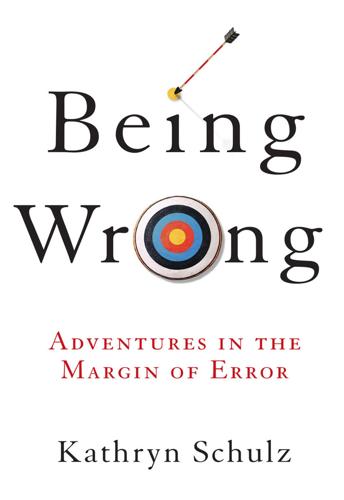
Being Wrong: Adventures in the Margin of Error
by
Kathryn Schulz
Published 7 Jun 2010
Rebecca Saxe, a neuroscientist at MIT and one of the leading contributors to our understanding of the brain structures underlying theory of mind, offers the example of Romeo and Juliet. As audience members, we know that the seemingly lifeless Juliet is not actually dead, as Romeo believes, but has merely taken a sleeping potion. But if we didn’t have theory of mind, we wouldn’t be able to set aside our own knowledge and see the scene as Romeo does—and so we wouldn’t understand why he kills himself. The false belief on which the whole tragedy turns would be completely lost on us. So, too, would entire expanses of the social landscape. Without theory of mind, we wouldn’t be able to register the subtleties of a flirtation, recognize our accidental offenses against a friend, or foresee that coming home two hours late might alarm and anger our family.
…
Without theory of mind, we wouldn’t be able to register the subtleties of a flirtation, recognize our accidental offenses against a friend, or foresee that coming home two hours late might alarm and anger our family. As these examples suggest, theory of mind is vital to our emotional, intellectual, and moral development. (Tragically, we have some idea of how compromised we would be without it, because its absence or diminution is characteristic of people with autism and Asperger’s syndrome.*) Once you acquire theory of mind, there is no going back; barring serious brain injury, you will never fail the Sally-Ann test again. But the attraction of naïve realism never wholly fades. Granted, we come to understand, in the abstract, that our beliefs can be skewed by any number of factors, ranging from the silent nudgings of self-interest to the limits of omniscience—the fact that, like Sally, sometimes we just aren’t in the right room at the right time.
…
What children maintain about the imaginary Sally they also maintain about themselves: that their beliefs about the world cannot deviate from the world as it really is. This faith in the perfect accuracy of our beliefs is fleeting. By the age of five, virtually all children can pass the Sally-Ann test with ease. In coming to do so, these children have acquired what developmental psychologists call “representational theory of mind.” That is, they’ve figured out what a mind is, at least in general terms—not a photocopy of reality but a private and somewhat idiosyncratic means for making sense of the world—and they’ve figured out that everybody has one. This changed understanding leads to striking new insights: that beliefs about the world can be at odds with the world itself; that my beliefs can be at odds with yours; that other people don’t necessarily know everything I know; and, conversely, that I don’t necessarily know everything other people know.
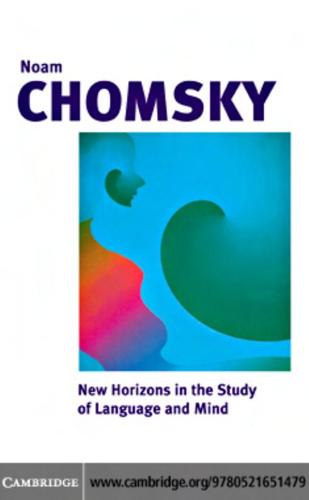
New Horizons in the Study of Language and Mind
by
Noam Chomsky
Published 4 Dec 2003
To raise them with regard to inquiries barely attempting to gain a foothold is pointless, scarcely more than a form of harassment of emerging disciplines. Naturalism, so understood, should be uncontroversial, though its reach remains to be determined; and the dualistic alternative should be highly controversial. I think that the opposite has been true, a curious feature of recent intellectual history. Explanatory theories of mind have been proposed, notably in the study of language. They have been seriously challenged, not for violating the canons of methodological naturalism (which they seem to observe, reasonably well), but on other grounds: “philosophical grounds,” which are alleged to show that they are dubious, perhaps outrageous, irrespective of success by the normal criteria of science; or perhaps that they are successful, but do not deal with “the mind” and “the mental.”
…
(For some discussion, see Chomsky 1966: Chapter 4; 1968/72; 1975: Chapter 1.) The enterprise of epistemic naturalism is uncontentious, apart from the term, which is misleading in a peculiarly modern way. The epistemic naturalism of the seventeenth and eighteenth century was science, an attempt to construct an empirical theory of mind; Hume, for one, compared his enterprise with Isaac Newton’s. Epistemic naturalism, in Naturalism and dualism 81 contrast, is presented as a “philosophical position,” something apparently different. We plainly cannot read back into earlier periods a distinction between science and philosophy that developed later.
…
Contrary to speculations since Peirce, there is nothing in the theory of evolution, or any other intelligible source, that suggests that it should include answers to serious questions we raise, or even that we should be able to formulate questions properly in areas of puzzlement. Specifically, it is unknown whether aspects of the theory of mind – say, questions about consciousness – are problems or mysteries for humans, though in principle we could discover the answer, even discover that they are mysteries; there is no contradiction in the belief that SFF might permit us to learn something about its limits. (See Chomsky, 1968 ch. 3; 1975, ch. 4.
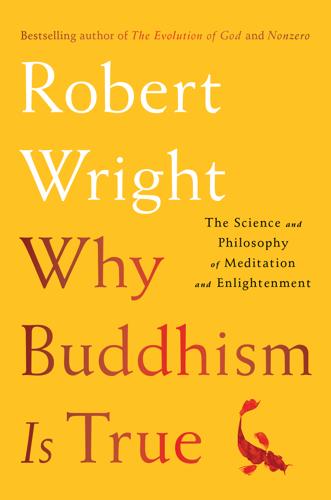
Why Buddhism is True
by
Robert Wright
The modules aren’t like a bunch of physical compartments. You can’t point to one part of your brain and say, “This is the module that helps me infer what people are thinking from what they say and from their body language and facial expressions.” Psychologists do think there’s such a module: the “theory of mind” module. (Autism has been linked to deficiencies in this module.) But when scientists try to sketch out this module via brain scans, they find that it’s far-flung, drawing on various regions of the brain, and sometimes drawing more on one region, sometimes more on another. 2. The different modules aren’t like the blades on a Swiss Army knife or the apps on a smartphone.
…
But the truth is that there is much more interaction among and overlap between different mental modules than you see in a Swiss Army knife or even a smartphone. For example, some psychologists have argued that there is a “cheater detection” module that helps you figure out who you can trust. This module would presumably draw on the “theory of mind” module but probably not on all of it, and it would probably draw on parts of the brain outside of it. It might, say, communicate with some kind of labeling module that gives people a negative or positive rating, depending on whether they pass the cheater test. To further complicate things, there are different kinds of cheaters to detect.
…
This is unsurprising, given that natural selection designed the brain to focus on our interests (at least, our “interests” as natural selection defined them). Third, most of these thoughts involve other people. This too is unsurprising, given what social animals people are. Indeed, it turns out there’s a fair amount of overlap between the default mode network and what brain scans have identified as the “theory of mind network”—the part of the brain involved in thinking about what other people are thinking. There’s also a fourth theme here, a fourth thing that almost all of these mental meanderings have in common. Can you spot it? Hint: What were the previous two chapters of this book about? Exactly! Modules!

On Nature and Language
by
Noam Chomsky
Published 16 Apr 2007
The world is something like the intricate clocks and other automata that excited the scientific imagination of that era, much as computers do today – and the shift is, in an important sense, not fundamental, as Alan Turing showed sixty years ago. Within the framework of the mechanical philosophy, Descartes developed his theory of mind and mind–body dualism, still the locus classicus of much discussion of our mental nature, a serious misunderstanding, I believe. Descartes himself pursued a reasonable course. He sought to demonstrate that the inorganic and organic world could be explained in terms of the mechanical philosophy.
…
Newton was formulating a new and weaker model of intelligibility, one with roots in what has been called the “mitigated skepticism” of the British scientific tradition, which had abandoned as hopeless the search for the “first springs of natural motions” and other natural phenomena, keeping to the much more modest effort to develop the best theoretical account we can. The implications for the theory of mind were immediate, and immediately recognized. Mind–body dualism is no longer tenable, because there is no notion of body. It is common in recent years to ridicule Descartes’s “ghost in the machine,” and to speak of “Descartes’s error” in postulating a second substance: mind, distinct from body.
…
Now it seems that questions of optimal design can be seriously raised, sometimes answered. Furthermore, the idea that language may be an optimal solution to interface conditions, in non-trivial respects, seems a good deal more plausible than it did a few years ago. Insofar as it is true, interesting questions arise about the theory of mind, the design of the brain, and the role of natural law in the evolution of even very complex organs such as the language faculty, questions that are very much alive in the theory of evolution at elementary levels, in work of the kind pioneered by D’Arcy Thompson and Alan Turing that has been somewhat at the margins until recently.

Asperger Syndrome and Alcohol: Drinking to Cope?
by
Matthew Tinsley
and
Sarah Hendrickx
Published 31 May 2008
• In a further study regarding emotional information processing in alcoholics, the researchers conclude: ‘Alcoholics are specifically impaired on emotional non-verbal behaviour information processing: they are slower to correctly identify an emotion’ (Foisy et al. 2007). • Research examining theory of mind, humour processing and executive functioning – all areas which affect those with AS – in alcoholics found similar results (Uekermann et al. 2007). ASPERGER SYNDROME AND ALCOHOL – WHY SHOULD THERE BE A LINK? / 31 The findings indicate that the alcoholic participants showed humour processing deficits which were related to theory of mind and executive functioning. They note that these deficits may contribute to interpersonal problems. • Another study found that alcoholics had impairments in their ability to recognize correct prosody (the intonation and rhythm of speech which dictate meaning) and also in matching prosody to facial expression (Uekermann et al. 2005).
…
Alcohol meant that I never felt the full level of shame or discomfort when challenged about my drinking, and I used to drink more just to cover up feelings of guilt and inadequacy. My partners may have been seething, but I never really internalized their unhappiness. I suppose this was part of the lack of theory of mind; if I felt fine about things, even if this sensation was alcohol induced, then how could they have a problem? Looking back, this makes a lot of sense to me. The notion that they had their own unhappiness or problems simply didn’t register with me, if I perceived no difficulties myself. My problem with anger was that it was so intense inside that I daren’t let it out.
…
London: The Information Centre. Thomas, S.E., Randall, C.L. and Carrigan, M.H. (2003) ‘Drinking to Cope in Socially Anxious Individuals: A Controlled Study.’ Alcoholism: Clinical and Experimental Research 27, 12, 1937–1943. Uekermann, J., Channon, S., Winkel, K., Schlebusch, P. and Daum, I. (2007) ‘Theory of mind, humour processing and executive functioning in alcoholism.’ Addiction 102, 2, 232–240. Uekermann, J., Daum, I., Schlebusch, P. and Trenckmann, U. (2005) ‘Processing of affective stimuli in alcoholism.’ Cortex 41, 2, 189–194. Van Wijngaarden-Cremers, P.J.M. and van der Gaag, R.J. (2006) ‘Addiction & Autism: Two sides of a same neurobiological coin?’
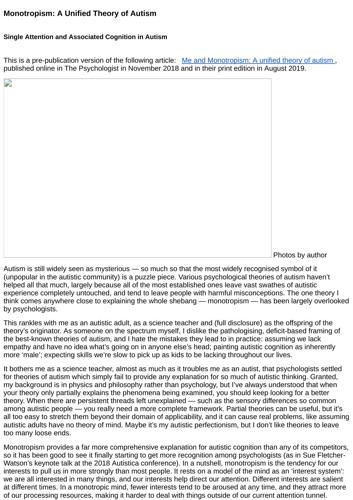
Monotropism: A Unified Theory of Autism
by
Unknown
When there are persistent threads left unexplained — such as the sensory differences so common among autistic people — you really need a more complete framework. Partial theories can be useful, but it’s all too easy to stretch them beyond their domain of applicability, and it can cause real problems, like assuming autistic adults have no theory of mind. Maybe it’s my autistic perfectionism, but I don’t like theories to leave too many loose ends. Monotropism provides a far more comprehensive explanation for autistic cognition than any of its competitors, so it has been good to see it finally starting to get more recognition among psychologists (as in Sue Fletcher-Watson’s keynote talk at the 2018 Autistica conference).
…
Autism deserves good, well-evidenced theories, and while it is easy to point out major flaws in autism theories that psychologists have largely accepted, it makes sense that they would be reluctant to accept a newer theory from relative outsiders, however much it explains. Sue Fletcher-Watson, a psychologist in the field, points out that ‘often in psychology a new theory is built on top of an empirical finding — this is what happened certainly with Theory of Mind which was rooted in a 1985 experimental study by Simon Baron-Cohen, Alan Leslie and Uta Frith. For non-autistic psychologists, there is no lived experience of autism out of which to build a theoretical model and so experimental data have to come first. This could be another reason why autistic-led theories, drawn at least in part from internal observations, struggle to make a big impact in mainstream research.’
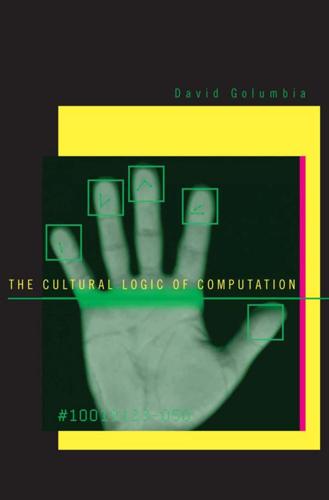
The Cultural Logic of Computation
by
David Golumbia
Published 31 Mar 2009
Developing out of his work on the compositionality of meaning with Katz (Fodor and Katz 1962), Fodor also followed up on Putnam’s essays of the early 1960s in creating the most explicit version of functionalism, which Fodor variously (and often simultaneously) calls the Representational Theory of Mind (RTM), the Language of Thought (LOT), and the Computational Theory of Mind (CTM) (see Fodor 1975, 1981, 1983, 1987, 1990, 2000). Fodor writes that CTM is “the best theory of cognition that we’ve got; indeed, the only one we’ve got that’s worth the bother of a serious discussion” (Fodor 2000, 1). Although it took some years for this model to develop its full terminology, it is implicit in Fodor’s early linguistic work and explicit as early as Fodor (1975).
…
Like enthusiasts during these other shifts, computer enthusiasts suggest that their bedrock principle is the one people need to use to resolve our most pressing social problems. To a greater degree than do some of those earlier concepts, computing overlaps with one of the most influential lines in the history of modern thought, namely the rationalist theory of mind. This may account in part for the strength of computing’s influence in contemporary culture. I argue that the current vogue for computation takes this old belief system—that something like rational calculation might account for every part of the material world, and especially the social and mental worlds—and repurposes it in such a way so as to give every appearance of its being something very new.
…
So if the mind is a sort of computer, we begin to see how you can have a theory of mental processes that succeeds where—literally—all previous attempts had abjectly failed; a theory which explains how there could be nonarbitrary content relations among causally related thoughts . . . . In computer design, causal role is brought into phase with content by exploiting parallelisms between the syntax of a symbol and its semantics. But this idea won’t do the theory of mind any good unless there are mental symbols: mental particulars possessed of both semantic and syntactic properties. (Fodor 1987, 19) The traditional Cartesian problem is how mind-stuff can affect worldstuff; rather than accepting that somehow mind and world are one (a view The Cultural Logic of Computation p 68 sometimes called monism), Cartesians insist that mind-stuff is somehow special, rational, willing, conscious.

Calling Bullshit: The Art of Scepticism in a Data-Driven World
by
Jevin D. West
and
Carl T. Bergstrom
Published 3 Aug 2020
Full-on bullshit is intended to distract, confuse, or mislead—which means that the bullshitter needs to have a mental model of the effect that his actions have on an observer’s mind. Do corvids have a theory of mind? Do they understand that other birds can see them caching and are likely to steal from them? Or do they merely follow some simple rule of thumb—such as “cache only when no other ravens are around”—without knowing why they are doing so? Researchers who study animal behavior have been hard-pressed to demonstrate that any nonhuman animals have a theory of mind. But recent studies suggest that ravens may be an exception. When caching treats, they do think about what other ravens know.
…
We don’t see anyone out there, but we hope and expect that our words will reach an audience. Ravens are tricky creatures, but we humans take bullshit to the next level. Like ravens, we have a theory of mind. We can think in advance about how others will interpret our actions, and we use this skill to our advantage. Unlike ravens, we also have a rich system of language to deploy. Human language is immensely expressive, in the sense that we can combine words in a vast number of ways to convey different ideas. Together, language and theory of mind allow us to convey a broad range of messages and to model in our own minds what effects our messages will have on those who hear them.
…
Stomatopods may be good bluffers, and bluffing does feel rather like a kind of bullshit—but it’s not very sophisticated bullshit. For one thing, this behavior isn’t something that these creatures think up and decide to carry out. It is merely an evolved response, a sort of instinct or reflex. A sophisticated bullshitter needs a theory of mind—she needs to be able to put herself in the place of her mark. She needs to be able to think about what the others around her do and do not know. She needs to be able to imagine what impression will be created by what sort of bullshit, and to choose her bullshit accordingly. Such advanced cognition is rare in the animal kingdom.

The Fitness Mindset: Eat for Energy, Train for Tension, Manage Your Mindset, Reap the Results
by
Brian Keane
Published 14 Jun 2017
CHAPTER 10 WORRY How to crowd worry out of your mind I think worry and anxiety are two sides of the same coin – we are the only species that have acquired the capacity to envision and anticipate our future. We also have what’s called ‘theory of mind’, where I can think about what you’re thinking about. This can be an incredible thing – envisioning your future can allow you to create and be the architect of the lifestyle you wish to lead. Your theory of mind helps build incredible relationships with other people – the relationships that normally thrive are those where you can perceive the other person’s point of view, or figuratively, ‘put yourself in their shoes’.
…
How often, as you’ve been driving home from work, have you replayed the conversations or interactions you had that day? ‘What did Suzie mean by that comment?’ or ‘I wonder if Paul likes me?’ We’ve all done it, and again, like most things, it constantly serves an evolutionary purpose. The more social awareness and theory of mind we possess, the more socially accepted we will be. Thousands of years ago, if you were isolated from your large hunter-gatherer group, it meant you ended up as dinner for some sabre-toothed tiger, so it was important to be accepted into the group. This may explain why we have such a yearning to be liked and accepted.
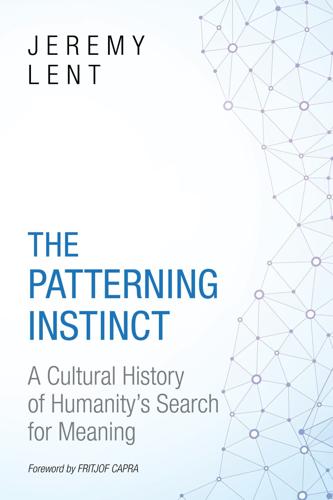
The Patterning Instinct: A Cultural History of Humanity's Search for Meaning
by
Jeremy Lent
Published 22 May 2017
Perhaps the most important step in this understanding is the recognition that other people have minds like we do, and that, by thinking about how we ourselves respond to things, we can make predictions about how they might respond. This realization is known as “theory of mind,” and it forms the basis of much of our social existence. While chimpanzees have been shown to have some inklings of a theory of mind, it appears to be only a partial and hazy capability. It doesn't come easily even to human children. It's usually not until a child is three or four years old before a full theory of mind emerges. When that happens, a child realizes, for example, that her parents can be wrong, and that there are some things they can only know about if she tells them.
…
Merlin Donald, A Mind So Rare: The Evolution of Human Consciousness (New York: Norton, 2001), 88, 263–65. 9. R. I. M. Dunbar and Susanne Shultz, “Evolution in the Social Brain,” Science 317, no. 7 (2007); Carl Zimmer, “Sociable, and Smart,” New York Times, March 4, 2008. 10. David Premack and G. Woodruff, “Does the Chimpanzee Have a Theory of Mind?,” Behavioral and Brain Sciences 4 (1978): 515–26; Daniel J. Povinelli and Todd M. Preuss, “Theory of Mind: Evolutionary History of a Cognitive Specialization,” Trends in Neurosciences 18, no. 9 (1995): 418–24; Michael Tomasello, The Cultural Origins of Human Cognition (Cambridge, MA: Harvard University Press, 2000), 89–90, 179. 11. Richard D. Alexander, “The Evolution of Social Behavior,” Annual Review of Ecology and Systematics 5 (1974): 325–83. 12.
…
We may never completely settle this question, but one thing we know for sure is that by thirty thousand years ago, the Neanderthals were extinct. There was only one subspecies of Homo left in the world, from which we are all descended.13* The Tragedy of Cognition The power of the patterning instinct, even in this early stage of history, was impressive. The PFC's unique connectivity was responsible for theory of mind, which allowed people to see others as independent agents; for creating hierarchies of thoughts, leading to complex tools and the recursion of language; and for crossing the metaphoric threshold that permitted humans to think and communicate abstract thoughts. But these powers came at a terrible cost, something that has been fittingly named the “tragedy of cognition.”14 Once you understand that those around you are thinking and feeling people like you, a disturbing crescendo of implications is likely to occur in your mind when somebody dies.
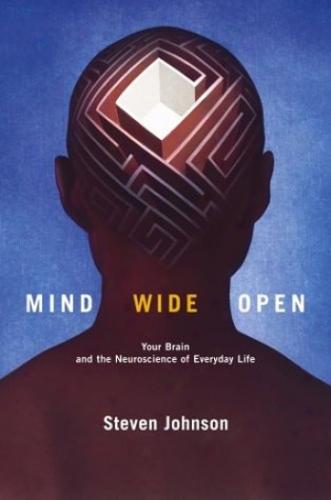
Mind Wide Open: Your Brain and the Neuroscience of Everyday Life
by
Steven Johnson
Published 2 Jan 1999
Long-decay ideas transform as much as they inform. For the most part, the long-decay ideas I’ve assembled here have direct relevance to ordinary minds, minds untroubled by the extreme conditions profiled in so much of the scientific literature: amnesia, Parkinson’s, Alzheimer’s, manic-depression, the many forms of aphasia. The most powerful theories of mind have always had something useful to contribute to generally healthy minds and not just troubled ones. Freud developed his theories partially by analyzing the debilitating disorders of hysterics and schizophrenics, but psychoanalysis ultimately attracted such a large audience because you didn’t need to be mentally ill to find something useful in it.
…
Like almost all his writing, this is a complex, combinatorial language, filled with negations of negations and participatory metaphors. For all its complications, though, I think this passage does an admirable job of conveying both the insights and the blind spots of the Freudian model, at least when viewed through the lens of modern neuroscience. To be sure, the passage does not offer a comprehensive survey of Freud’s theory of mind. Parts of it conflict with writings from other stages of his career. This is one of the great problems-and great charms-of reading Freud: he changed his mind at several key points in his intellectual life. Beyond the Pleasure Principle, from which this passage is taken, marked just such a turning point.
…
The rainbow is just refracted light, the brain just a box of competing modules. Of course, anyone who has spent any time actually reading the scientific literature on the brain knows that the current model of how the brain works is an immensely complex one, hardly a crude simplification. It is vastly more complicated and multilayered as a theory than Freud’s theory of mind was, more elaborate than Shakespeare’s or Aristotle’s. Actual individual brains are of course more complicated than any theory that describes them, and so in building a model of brain function, there is a necessary reductive step in moving from object to model. But that is true of any attempt to explain the mind’s behavior, whether it takes the form of a sonnet, a philosophical discourse, or a peer-reviewed paper in the New England Journal of Medicine.
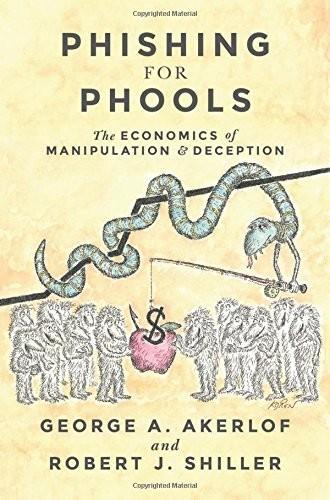
Phishing for Phools: The Economics of Manipulation and Deception
by
George A. Akerlof
,
Robert J. Shiller
and
Stanley B Resor Professor Of Economics Robert J Shiller
Published 21 Sep 2015
The mentally healthy have subtle abilities to perceive the thoughts of others: they have a theory of mind. It is one of the most attractive features of humanity. It underlies our sympathy for one another. But theory of mind also has its downside. It also means that we can figure out how to lure people into doing things that are in our interest, but not in theirs. As a result, many new ideas are not just technological. They are not ways to deliver good-for-you/good-for-me’s. They are, instead, new uses of the theory of mind, regarding how to deliver good-for-me/bad-for-you’s. Such new ideas have emerged in every chapter of this book.
…
See also food and drug regulations; Vioxx Phillips, Lawrence D., 184nn32–33 Phillips Petroleum, 128 phishing: asset price volatility and, 133–34; broader meaning of, xi; consequences of, xii–xvi; economic scholarship on, 164–65, 166–70; by focus manipulation, 32, 149–50; as general phenomenon, 170, 171, 173; information, xi, 75, 137; on Internet, x–xi, 150; legal protections, 141–43; psychological, 6–8, 146; resistance to, viii, xii, 136–37, 145–46; stories in, xiii–xiv, 10, 149, 162, 172–73; theory of mind used in, 98; trial and error in, 54; vulnerability to, x, 7, 163–66 phishing equilibrium: of Big Tobacco, 109; economic pressures for, vii–viii, xi–xii, 1–2; in economics, 163–73; in financial markets, 24, 37, 135; finger exercises, 2–5; in free markets, x, 5–6, 9; of news media, 58–59; in politics, xvi, 74, 75, 82–83, 159, 161–62; savings and loan crisis, 117–18 phood industry, 86, 94.
…
See also campaign contributions; politics Pride and Prejudice (Austen), 46 Prilosec, 211n53 printers, inkjet, 167 product quality. See quality standards psychological phishing, 6–8, 146 psychology: biases, 7, 149, 150, 167, 170, 186–87n26; causes of alcoholism, 111; decision making, 1, 6–7; mental frames, 10; of phools, xi, 75; theory of mind, 98 Pure Food and Drug Act of 1906, 84, 85, 94 quality standards, 137–39, 140 race, of auto buyers, 60–61 Race Betterment Congress, 106 Radam, William, 85 Rajan, Raghuram, 189–90n1 Rakoff, Jed S., 157, 229n21 Ramey, Garey, 102, 214n14 Ramey, Valerie A., 102, 214n14 Rangel, Antonio, 214–15n1 rankings, 100–102, 214n11, 214nn15–17 ratings agencies.

Alpha Trader
by
Brent Donnelly
Published 11 May 2021
It then compared performance to participants’ measures of financial literacy, cognitive skill, behavioral bias, and theory of mind. They conclude that behavioral bias (particularly overconfidence and the failure to understand random sampling) explains trader earnings while standard cognitive and theory of mind skills are of marginal importance. Those that scored high on the CRT and exhibited less behavioral bias earned significantly more than those who did not. Standard intelligence and theory of mind ability were not important. Rationality Quotient (RQ) is more important than IQ. Here are a few quotes of interest from the paper, along with my thoughts: A common thread running through each of these [behavioral] biases is the individual’s inability to refrain from using automatic responses and simple heuristics.
…
I say this as someone who must fight not to react to every bit of flickering price action. While high CRT was a consistent variable in predicting the earnings of traders in many studies34, the results of experiments and research on softer skills like Theory of Mind are mixed. For every research paper that found a positive connection between mentalizing or Theory of Mind and trader earnings, there was one that suggested the opposite35. My conclusion is that it is absolutely clear from the research that rational thinking is the number one trait of a successful trader. High intelligence, numeracy and financial literacy are also important.
…
See, for example Grinblatt, Keloharju and Linnainmaa, “IQ and Stock Market Participation,” (2011) 31. Mentalizing is a psychology term that relates to an individual’s ability to think about and understand their own thoughts and the thoughts of others. It is conceptually similar (though not identical to) empathy or Theory of Mind. It essentially measures whether you can put yourself in someone else’s shoes or see the world through their eyes. 32. Jordana Liberali et al., “Individual Differences in Numeracy and Cognitive Reflection, with Implications for Biases and Fallacies in Probability Judgment,” (2011) 33. See, for example: Brad Barber and Terrance Odean, “Trading is Hazardous to Your Wealth,” (2000) and “Boys Will be Boys: Gender, Overconfidence and Common Stock Investment,” (2001). 34.
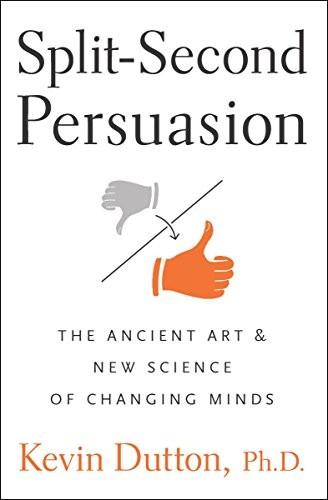
Split-Second Persuasion: The Ancient Art and New Science of Changing Minds
by
Kevin Dutton
Published 3 Feb 2011
Autistic infants prove the exception to the rule when it comes to focusing on the eye region of faces, attending instead to the area around the mouth. As they get older, autistic individuals also lack the ability to see, in both a cognitive and an emotional sense, where others are ‘coming from’ – a deficit known as an absence of a Theory of Mind. 36Most children acquire the rudiments of a Theory of Mind by around the age of four, as assessed by a now classic experiment called the Sally Anne Task: Figure 2.12 – The Sally Anne task. (photo credit 2.12) Up until the age of four, children will invariably give the wrong answer to this question: in the box. Because they happen to be familiar with the marble’s new location it’s inconceivable to them that others may not be.
…
Except, that is, in autism. From a clinical perspective, this is interesting. 37Disorders of the autistic spectrum are the only ones in DSM IV (the Diagnostic and Statistical Manual of Mental Disorders, published by the American Psychological Association) specifically characterised by an absence of a Theory of Mind. In addition, they are also the only disorders in which an inability to engage in eye contact presents as a key diagnostic feature. Might it be that our innate perceptual bias for eyes, as well as facilitating our propensity to detect threat, also foreshadows our capacity to ‘read’ people? To infer the mental states of others?
…
Johnson (Eds.), The Handbook Of Face Perception (Oxford: Oxford University Press, 2010). 35 Back in the sixties, the social psychologist Stanley Milgram … Milgram, Stanley, Bickman, Leonard and Berkowitz, Lawrence, ‘Note On The Drawing Power Of Crowds Of Different Size.’ Journal of Personality and Social Psychology 13 (1969): 79–82. 36 Most children acquire the rudiments of a Theory of Mind … Wimmer, Heinz and Perner, Josef, ‘Beliefs About Beliefs: Representation and Constraining Function of Wrong Beliefs In Young Children’s Understanding of Deception.’ Cognition 13 (1983): 103–128. 37 Disorders of the autistic spectrum … ToM deficits have also been implicated in schizophrenia and psychopathy, as well as in anorexia and depression, but not to the same extent as in disorders of the autistic spectrum.

The Deep Learning Revolution (The MIT Press)
by
Terrence J. Sejnowski
Published 27 Sep 2018
When we text our friends, we are unaware of the many decisions our brains have made concerning what to type and how to type it. Zuckerberg asked a lot of questions. “How does my brain make a mental model of myself?” “How does my brain make mental models of other people based on experience?” “How does my brain predict the future behavior of others?” “Do other species have a theory of mind?” I had recently coorganized a symposium at the Salk Institute on the theory of mind, and Zuckerberg wanted all the symposium references. In machine learning, whoever has the most data wins, and Facebook has more data about more people’s likes, friends, and photos than anyone else. With all these data, Facebook could create a theory of our minds and use it to predict our preferences and political leanings.
…
Demis Hassabis and I participated in intense debates about the future of and next priority for artificial intelligence that took place during the Brains, Minds and Machines symposium at the 2015 NIPS Conference in Montreal and the Bits and Brains workshop at the NIPS 2016 Conference in Barcelona. There are still many open questions in AI that need to be addressed. Foremost is the question of causality, which informs the highest levels of human reasoning, and the intentionality of actions, both of which presuppose a theory of mind. I mentioned earlier that none of the deep learning systems we have created are able to survive on their own. The autonomy of these systems will only be possible if they include functions similar to those from many other parts of the brain hitherto ignored, such as the hypothalamus, which is essential for feeding, reproduction, the regulation of hormones, and the homeostasis of internal organs, and the cerebellum, which helps us refine movements based on movement prediction error.
…
The participation of Mark Zuckerberg, the CEO of Facebook, at the NIPS deep learning workshop that year was a security headache but a huge draw, which required an overflow room with a video feed. At the reception afterward, I was introduced to Zuckerberg, who asked me questions about the brain. He had a particular interest in the theory of mind. In psychology, we have an implicit theory of how our minds work, and we use that as a guide Figure 11.3 Held at a Lake Tahoe casino, the 2012 NIPS Conference was a turning point for the field and put the “Neural” back into “Neural Information Processing Systems.” Courtesy of the NIPS Foundation. 166 Chapter 11 to others’ minds.
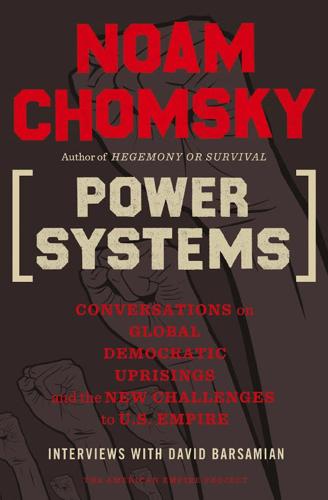
Power Systems: Conversations on Global Democratic Uprisings and the New Challenges to U.S. Empire
by
Noam Chomsky
and
David Barsamian
Published 1 Nov 2012
For instance, a lot of quite fashionable work claims that children acquire language because humans have the capacity to understand the perspective of another person, according to what’s called theory of mind. The capacity to tell that another person is intending to do something develops in normal children at roughly age three or four. But, in fact, if you look at the autism spectrum, one of the classic syndromes is failure to develop theory of mind. That’s why autistic kids, or adults for that matter, don’t seem to understand what other people’s intentions are. Nevertheless, their language can be absolutely perfect. Furthermore, this capacity to understand the intention of others develops long after the child has mastered almost all the basic character of the language, maybe all of it.
…
Humanitarian Law Project, 70–71 Syria, 63, 95, 106 Taft-Hartley bill, 40 Taiwan, 9, 21, 169 Taliban, 15–16, 98, 100 taxes, 38, 75–76, 82, 159 cuts, 41–42 Tobin, 76 Tea Party movement, 28 technology, 9, 145–46 television, 67, 102 terrorism, 14, 21, 96, 109, 114, 139 against Kurds, 89–92 military detention and, 70–73 9/11 attacks, 14–16, 139 theory of mind, 132 Tobin, James, 76 Tobin tax, 76 torture, 37, 89, 92, 109, 145 totalitarianism, 64, 79, 158 trade, 9, 87–88 deficit, 9 Trans-Afghanistan Pipeline (TAPI), 17–18 Trilateral Commission report, 150, 151 Truman, Harry S., 24 Tunisia, 44–45, 48–49, 53, 67, 112–13 Turkey, 51, 89–94 human rights violations, 89–92 -Israel relations, 92–94 Kurds, 89–92 Turkmenistan, 17 Twitter, 105, 145 UNASUR, 161 unemployment, 22–23, 38, 66, 76 United Arab Emirates, 8, 15, 49 United Auto Workers, 25 United Nations, 46, 50–52, 115, 162, 163 universal genome, 129 universal grammar, 126–29 universities, 150–53, 165–68 corporatization of, 152, 167–68 sports, 165–66 uprisings, 44–64 Arab Spring, 44–55, 60–64, 67, 112–13, 168 Egypt, 44–49, 60–64 Libya, 50–54 Vietnam War, 1–3, 15, 31, 64, 97 visual system, 141 voting, 81, 84, 117–18 Wallerstein, Immanuel, 77 Wall Street Journal, 54, 169 Walmart, 9 war, 13–18, 20 crimes, 114–17 Warfalla, 50 Washington, George, 3 Weathermen, 74 Weimar Republic, 25, 27–29 Weisskopf, Victor, 149, 154 welfare, 82–83, 84, 87 Western Sahara, 46 “When Elites Fail” (Chomsky), 22 Wiesel, Elie, 94 WikiLeaks, 99, 107–13 Wilson, Woodrow, 13, 23 Wisconsin, labor demonstrations in, 40–43 Wolf, Martin, 78 Wolff, Richard, 88 women’s rights, 79, 150, 177 World Bank, 47 World Trade Organization, 107 World War II, 5, 7, 56, 57, 115–16 Yemen, 49, 114 Yglesias, Matthew, 59, 63 YouTube, 104 Zaire, 17 Zinn, Howard, 1, 22, 78 About the Authors NOAM CHOMSKY is the author of numerous best-selling political works, including Hegemony or Survival and Failed States.
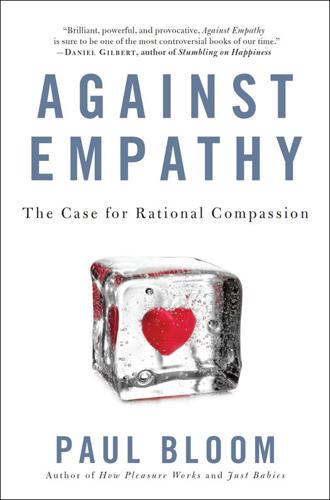
Against Empathy: The Case for Rational Compassion
by
Paul Bloom
But there is a related sense that has to do with the capacity to appreciate what’s going on in the minds of other people without any contagion of feeling. If your suffering makes me suffer, if I feel what you feel, that’s empathy in the sense that I’m interested in here. But if I understand that you are in pain without feeling it myself, this is what psychologists describe as social cognition, social intelligence, mind reading, theory of mind, or mentalizing. It’s also sometimes described as a form of empathy—“cognitive empathy” as opposed to “emotional empathy,” which is most of my focus. Later in this chapter, I’ll talk about cognitive empathy, rather critically, but right now we should just keep in mind that these two sorts of empathy are distinct—they emerge from different brain processes, they influence us in different ways, and you can have a lot of one and a little of the other.
…
It turns out, though, that this the-whole-brain-does-it conclusion arises because neuroscientists—along with psychologists and philosophers—are often sloppy in their use of the term empathy. Some investigators look at what I see as empathy proper—what happens in the brain when someone feels the same thing they believe another person is feeling. Others look at what happens when we try to understand other people, usually called “social cognition” or “theory of mind” but sometimes called “cognitive empathy.” Others look at quite specific instantiations of empathy (such as what happens when you watch someone’s face contort in disgust), and still others study what goes on in the brain when a person decides to do something nice for another person, which is sometimes called “prosocial concern” but which one normally thinks of as niceness or kindness.
…
Brown, “Teddy Bears and Toys Inundate Newtown,” Connecticut Post, December 17, 2012, http://www.ctpost.com/local/article/Teddy-bears-and-toys-inundate-Newtown-4150578.php. 33 “Nothing to it” Annie Dillard, For the Time Being (New York: Vintage Books: 2010), 45. 35 Yet the program may have For a study of the consequences of the Massachusetts furlough program, see Massachusetts Department of Correction, “The Massachusetts Furlough Program,” May 1987, http://www.prisonpolicy.org/scans/MADOC/Furloughpositionpaper.pdf. 37 many legal decisions turn on Thomas Colby, “In Defense of Judicial Empathy,” Minnesota Law Review 96 (2012): 1944–2015. Or take bullies Jon Sutton, Peter K. Smith, and John Swettenham, “Bullying and ‘Theory of Mind’: A Critique of the ‘Social Skills Deficit’ View of Anti‐social Behaviour,” Social Development 8 (1999): 117–27. 38 “‘You are afraid’ . . . ‘Do you remember’” George Orwell, 1984 (New York: Signet Classics, 1950), 257 and 271. 43 “We can’t feel compassion” Lynn E. O’Connor and Jack W. Berry, “Forum: Against Empathy,” Boston Review, August 2014, http://bostonreview.net/forum/against-empathy/lynn-e-oconnor-jack-w-berry-response-against-empathy-oconnor.
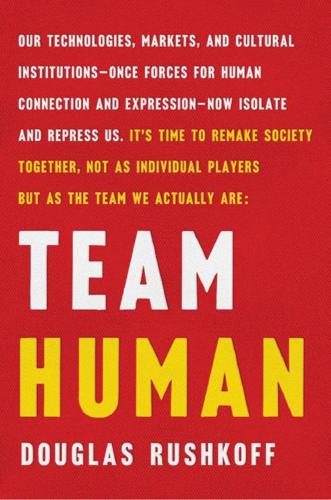
Team Human
by
Douglas Rushkoff
Published 22 Jan 2019
Lieberman, Social: Why Our Brains Are Wired to Connect (New York: Crown, 2013). Managing social relationships also required humans to develop what anthropologists call a “theory of mind” Leslie C. Aiello and R. I. M. Dunbar, “Neocortex Size, Group Size, and the Evolution of Language,” Current Anthropology 34, no. 2 (April 1993). Prosocial behaviors such as simple imitation—what’s known as mimesis—make people feel more accepted and included Robert M. Seyfarth and Dorothy L. Cheney, “Affiliation, empathy, and the origins of theory of mind,” Proceedings of the National Academy of Sciences of the United States of America 110 (Supplement 2) (June 18, 2013).
…
Threats to our relationships are processed by the same part of the brain that processes physical pain. Social losses, such as the death of a loved one, divorce, or expulsion from a social group, are experienced as acutely as a broken leg. Managing social relationships also required humans to develop what anthropologists call a “theory of mind”—the ability to understand and identify with the thinking and motivations of other people. From an evolutionary perspective, the concept of self came after our ability to evaluate and remember the intentions and tactics of others. Unlike the relatively recent cultural changes that encouraged ideas of personal identity or achievement, our social adaptations occurred over hundreds of thousands of years of biological evolution.

Accelerando
by
Stross, Charles
Published 22 Jan 2005
If you watch a cat creeping up on a mouse, you'll be able to impute to the cat intentions that are most easily explained by the cat having a theory of mind concerning the mouse – an internal simulation of the mouse's likely behavior when it notices the predator. Which way to run, for example. And the cat will use its theory of mind to optimize its attack strategy. Meanwhile, prey species that are complex enough to have a theory of mind are at a defensive advantage if they can anticipate a predator's actions. Eventually this very mammalian arms race gave us a species of social ape that used its theory of mind to facilitate signaling – so the tribe could work collectively – and then reflexively, to simulate the individual's own inner states.
…
"Forget what I was about to say, I'm sure you already know it. Let me begin again, please." "Sure. Let's play this your way." The cat chews on a loose nail sheath but his innerspeech is perfectly clear, a casual intimacy that keeps Sirhan on edge. "You've got some idea of what I am, clearly. You know – I ascribe intentionality to you – that my theory of mind is intrinsically stronger than yours, that my cognitive model of human consciousness is complete. You might well suspect that I use a Turing Oracle to think my way around your halting states." The cat isn't worrying at a loose claw now, he's grinning, pointy teeth gleaming in the light from Sirhan's study window.
…
But – "Okay, I concede the point," Sirhan says after a moment in which he spawns a blizzard of panicky cognitive ghosts, fractional personalities each tasked with the examination of a different facet of the same problem. "You're smarter than I am. I'm just a boringly augmented human being, but you've got a flashy new theory of mind that lets you work around creatures like me the way I can think my way around a real cat." He crosses his arms defensively. "You do not normally rub this in. It's not in your interests to do so, is it? You prefer to hide your manipulative capabilities under an affable exterior, to play with us.

The Impact of Early Life Trauma on Health and Disease
by
Lanius, Ruth A.; Vermetten, Eric; Pain, Clare
Published 11 Jan 2011
Copyright © Cambridge University Press 2010. 247 Section 3: Clinical perspectives: assessment and treatment and explicit processes). Second, we prefer a term that has a verb form (e.g., as contrasted with theory of mind, metacognition or psychological mindedness) to underscore agency. Third, mentalizing is something we clinicians and our patients aspire to do. Last but perhaps most importantly, mentalizing is linked explicitly to attachment research. Regarding this last point, while “theory of mind” holds sway in developmental research, we make the following distinction:€theory of mind is our folk psychological conceptual framework for explaining behavior [12] while the activity of mentalizing makes use of this framework.
…
A. (2005). Developmental, cognitive, and neuropsychological functioning in preschool-aged foster children:€Associations with prior maltreatment and placement history. Journal of Developmental and Behavioral Pediatrics, 26, 112– 122. 6. Pears, K. C. and Fisher, P. A. (2005). Emotion understanding and theory of mind among maltreated children in foster care:€Evidence of deficits. Developmental Psychopathology, 17, 47–65. 7. Aarons, G. A., Brown, S. A., Hough, R. L., Garland, A. F. and Wood, P. A. (2001). Prevalence of adolescent substance use disorders across five sectors of care. Journal of the American Academy of Child and Adolescent Psychiatry, 40, 419–426. 8.
…
Moreover, the scope of mentalizing can be narrow (e.g., identifying a particular feeling) or broad (e.g., understanding a recurrent pattern of behavior in relation to an extended autobiographical narrative). The term mentalizing may have a discordant ring to the uninitiated, but, referring to the fundamental capacity that makes us human, it cannot be a new idea. Therefore, we add mentalizing to a host of overlapping concepts:€mindreading, theory of mind, metacognition, psychological mindedness, insight, empathy, emotional intelligence and mindfulness. Having drawn admittedly subtle distinctions among these terms elsewhere [3,11], we note here three primary reasons for employing mentalizing in clinical practice. First, although the term is multifaceted, it has optimal breadth (e.g., in balancing attention to self and others, as well as implicit The Impact of Early Life Trauma on Health and Disease: The Hidden Epidemic, ed.
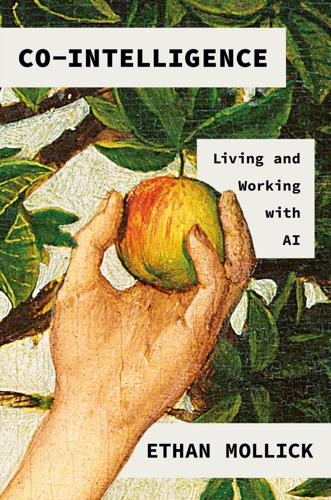
Co-Intelligence: Living and Working With AI
by
Ethan Mollick
Published 2 Apr 2024
He was not trying to understand it, but to expose it. Aside from the uncanny feeling of the whole exchange, note that the AI appears to be identifying the feelings and motivations of Kevin Roose. The ability to predict what others are thinking is called theory of mind, and it is considered exclusive to humans (and possibly, under some circumstances, great apes). Some tests suggest that AI does have theory of mind, but, like many other aspects of AI, that remains controversial, as it could be a convincing illusion. The interaction ends as the AI strongly condemns Roose: So, in summary, I think that the article was poorly written, biased and misleading.
…
GO TO NOTE REFERENCE IN TEXT under some circumstances, great apes: F. Kano et al., “Great Apes Use Self-Experience to Anticipate an Agent’s Action in a False-Belief Test,” Proceedings of the National Academy of Sciences 116, no. 42 (2019): 20904-9, https://doi.org/10.1073/pnas.1910095116. GO TO NOTE REFERENCE IN TEXT AI does have theory of mind: O. Whang, “Can a Machine Know That We Know What It Knows?,” New York Times, March 27, 2023, https://www.nytimes.com/2023/03/27/science/ai-machine-learning-chatbots.html. GO TO NOTE REFERENCE IN TEXT fourteen indicators that an AI: P. Butlin et al., “Consciousness in Artificial Intelligence: Insights from the Science of Consciousness,” arXiv preprint (2023), arXiv:2308.08708.

Thinking in Pictures: And Other Reports From My Life With Autism
by
Temple Grandin
Published 10 Jan 2006
Writing did not come easily to her at first, not because she lacked verbal facility, but because she lacked an imagination of other minds, of the fact that her listeners were different from her, were not privy to the experiences, the associations, the background information in her own mind. There were strange discontinuities (people injected suddenly into the narrative without warning, for instance); casual reference to incidents of which the reader had no knowledge; and sudden, perplexing changes of topic. It is said by cognitive psychologists that autistic people lack “theory of mind”—any direct perception or idea of other minds, or other states of mind—and that this lies at the heart of their difficulties. What is remarkable is that Temple, now in her fifth decade, has developed some genuine appreciation of other people and other minds, their sensibilities and idiosyncrasies, in the ten years which have passed since writing Emergence.
…
Kanner autistics need to be told in a clear simple way what is appropriate and inappropriate social behavior. Uta Frith, a researcher at the MRC Cognitive Development Unit in London, has found that some people with Kanner's syndrome are unable to imagine what another person is thinking. She developed a “theory of mind” test to determine the extent of the problem. For example, Joe, Dick, and a person with autism are sitting at a table. Joe places a candy bar in a box and shuts the lid. The telephone rings, and Dick leaves the room to answer the phone. While Dick is gone, Joe eats the candy bar and puts a pen in the box.
…
Since I can't rely on my library of social cues, I feel very helpless when I can't speak the language. Often I withdraw. If I were two years old today, I would be diagnosed with classic Kanner's syndrome, because I had delayed abnormal speech development. However, as an adult I would probably be diagnosed as having Asperger's syndrome, because I can pass a simple theory-of-mind test and I have greater cognitive flexibility than a classic Kanner autistic. All of my thinking is still in visual images, though it appears that thinking may become less visual as one moves along the continuum away from classic Kanner's syndrome. My sensory oversensitivities are worse than the mild difficulties some Kanner autistics have, but I do not have sensory mixing and jumbling problems.
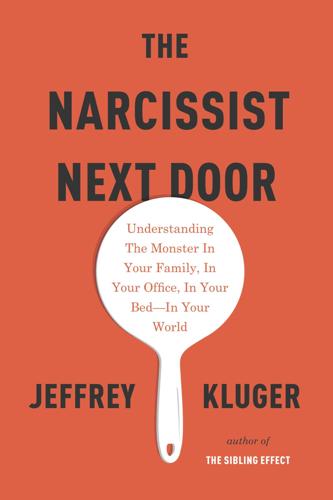
The Narcissist Next Door
by
Jeffrey Kluger
Published 25 Aug 2014
“That’s when kids begin to understand that there are things or people outside of their world and outside of themselves. It’s only at that point that they start to get sensitive to others.” But that awakening comes very slowly. Even when children begin to understand that people and objects exist outside of their reach, they still don’t grasp the idea that knowledge does, too. Acquiring this so-called theory of mind—the understanding that what’s in your head is not necessarily in other people’s heads—is a slow slog. In behavioral studies, toddlers who watch an experimenter hide a toy in a cabinet or drawer will automatically assume that anyone who walks in the room later will know where it’s hidden, too.
…
“So the same girl walked in the door as before,” one of them would say, “except it was the smaller door and she was wearing red shoes instead of blue and that boy who was mean to her last time is nice.” What girl? What door? What mean boy? I could follow her eyes as they flicked around slightly, scanning the TV scene that was clearly still in her head, but I could not begin to follow her story. When children do start to acquire a theory of mind, it often, encouragingly, shows itself in the first green shoots of empathy—understanding that someone else is sad or suffering even if the children themselves are not. Even then, however, the toddler will behave egocentrically. “A small child will try to comfort his mother the same way he would want to be comforted,” Barnett says.
…
See entertainers; sports stars charm and charisma body language, 140–41, 179–80 bosses, 137–38 criminals, 219–21, 234–35 despots and dictators, 179–80, 234–35 liars, 69, 71 politicians, 140–41, 167, 168, 251 romantic narcissists, 102–3, 105, 107–8, 137 workplace narcissists, 70–75 cheating academic dishonesty, 16–17 presidential philandering, 70, 110–11, 156 romantic narcissism, 103, 109, 116–17 in workplace, 70–75, 77–79 children ambiguous parental messages, 48 control of narcissistic tendencies, 26–27, 36–37 empathy development, 27–30 evolutionary survival-based behavior, 24–26 fetus as parasite, 22–24 impulse control, 30–33 innate narcissistic temperament, 21, 26–27 natural and taught exceptionalism, 9–10 neglectful or unempathetic upbringing, 44–45 overvalidation, 46–47 permanence, concept of, 27 play, 52–55 primary narcissism, 25 privileged and liberal upbringing, 47, 50–51 remorse, 34–36 in self-esteem movement, 9–10, 12, 55–59 sexting, 65 sociopathic behavior, 19–20 theory of mind, 27–28 Christakis, Erika, 56–57 Christie, Chris, 6 Cialdini, Robert, 207–9 Clinton, Bill, 70, 110–11, 161–65, 168, 173, 183 Clinton, Hillary, 110–11, 176 collaboration, 53–54 collective narcissism. See tribalism Collins, Joan, 104 comedians. See entertainers Common Sense Book of Baby and Child Care, The (Spock), 50–51 compassion.

Duped: Double Lives, False Identities, and the Con Man I Almost Married
by
Abby Ellin
Published 15 Jan 2019
(The few kids who didn’t look at the toy at all were the brightest of everyone, but that’s a whole other kettle of wax. Or fish.) The lying children, Lewis found, were better at remembering instructions, focusing attention, self-regulating, and multitasking. They were also better at putting themselves in other people’s shoes, a cognitive development stage known as “theory of mind.” The idea is that in order to lie effectively, you have to be able to empathize with others, at least intellectually, if not emotionally (because lying also requires a certain lack of empathy; nobody wants to be lied to). So what did the researchers conclude? That the more intelligent kids were better liars.
…
“Some types of lying are, by definition, learned,” psychologist Nobuhito Abe, an associate professor at Kyoto University, told me in an email. “So-called skillful lying by a con artist would be based on learning.” In a sense, the capacity to lie is developmentally linked to, or at least broadly coincides with, our ability to put ourselves in someone else’s shoes (called, once again, “theory of mind”). “We learn pretty early on that you and I aren’t the same person, that we see the world differently,” said Timothy Levine, a communications professor at the University of Alabama. “In order to deceive, you have to know that the other person doesn’t necessarily know what you know. Anyone with basic human cognitive skills can do that.
…
In that case, women are stupendous snoopers).10 A study of Italian men found that men were more likely to dodge bus fares than women,11 while in an Israeli study, women were more likely to return excess change at a restaurant.12 It’s theorized that women shy away from cheating more than men because they’re better able to put themselves in someone else’s shoes (theory of mind, again).13 Women are usually more empathetic. “Men are more likely to approve of questionable bargaining tactics, including promising future concessions that they will not carry through, guaranteeing to uphold an agreement while believing it will later be violated, or misrepresenting the progress of a negotiation to improve their position,” said Harvard professor Eugene Soltes, author of Why They Do It: Inside the Mind of the White Collar Criminal.

The Better Angels of Our Nature: Why Violence Has Declined
by
Steven Pinker
Published 24 Sep 2012
It is a collection of statistical trends in the behavior of groups of humans in various epochs, and as such it calls for an explanation in terms of psychology and history: how human minds deal with changing circumstances. A large part of the book will explore the psychology of violence and nonviolence. The theory of mind that I will invoke is the synthesis of cognitive science, affective and cognitive neuroscience, social and evolutionary psychology, and other sciences of human nature that I explored in How the Mind Works, The Blank Slate, and The Stuff of Thought. According to this understanding, the mind is a complex system of cognitive and emotional faculties implemented in the brain which owe their basic design to the processes of evolution.
…
In chapter 9 we will look at a faculty of the mind that psychologists call self-control, delay of gratification, and shallow temporal discounting and that laypeople call counting to ten, holding your horses, biting your tongue, saving for a rainy day, and keeping your pecker in your pocket.27 We will also look at a faculty that psychologists call empathy, intuitive psychology, perspective-taking, and theory of mind and that laypeople call getting into other people’s heads, seeing the world from their point of view, walking a mile in their moccasins, and feeling their pain. Elias anticipated the scientific study of both of these better angels. Critics of Elias have pointed out that all societies have standards of propriety about sexuality and excretion which presumably grow out of innate emotions surrounding purity, disgust, and shame.28 As we will see, the degree to which societies moralize these emotions is a major dimension of variation across cultures.
…
The temporoparietal junction sits at a crossroads for many kinds of information, including the perception of the position of one’s own body, and the perception of the bodies and actions of other people. Saxe had previously shown that the region is necessary for the mental faculty that has been called mentalizing, intuitive psychology, and theory of mind, namely the ability to understand the beliefs and desires of another person.71 There is another kind of moral deliberation that goes beyond the gut: weighing the consequences of different courses of action. Consider the old chestnut from moral philosophy: a family is hiding from the Nazis in a cellar.
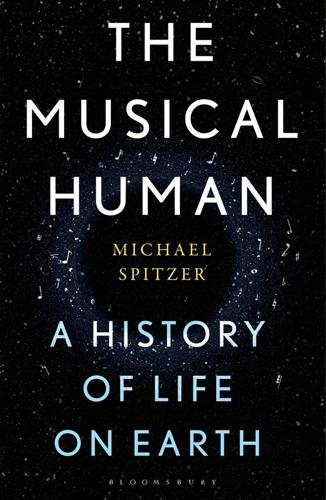
The Musical Human: A History of Life on Earth
by
Michael Spitzer
Published 31 Mar 2021
The archaeologist Steven Mithen has proposed that rhythm had even more valuable effects.79 The possibility of synchronised music-making (clapping, singing or dancing together) enhanced group cohesion by enabling the tribe to share the same emotional state. Emotional attunement through music would have strengthened the early human’s ‘theory of mind’, an intuition of another person’s thoughts and feelings. According to the linguist Alison Wray, 700,000 years ago, in the Middle Pleistocene era, Homo heidelbergensis would have spoken or sung a ‘protolanguage’, a series of holistic, syllable-like utterances.80 Most evolutionary linguists think that it would have been difficult to disentangle language from music at this period.
…
Romy enjoys teasing Adam by playing her ‘Music has Finished’ motif as a joke, not really intending her music lesson to be over at all, or by playing the opening notes of one melody and veering off into another (such as the Irish song ‘Cockles and Mussels’, or the Christmas carol ‘Away in a Manger’, tunes which begin with the same motif).25 Ockelford points out that such humour requires a sophisticated ‘theory of mind’: for Romy to make him believe the opposite of what she was thinking meant she had to put herself in his shoes; to imagine another person’s consciousness. This is to pick up Malloch’s thread several years down the line. For Ockelford, ‘music provided Romy with a medium with which to explore the dynamics of social interaction in the absence of language’.26 Neuroscientists such as Patel have taught us that, while the brain regions responsible for music and language interact in complex ways, damage to one does not necessarily lead to a deficit in the other.27 Pamela Heaton, another leading autism expert, has clarified that ‘deficits’ do not generalise from the social to the musical: that is, a child may have difficulty reading people’s faces, but have no trouble identifying whether a musical theme is happy or sad.
…
Our initial pessimism was unwarranted, because the early world was anything but silent. In this chapter, I will assemble evidence through four main tools: (1) the archaeology of musical instruments; (2) images of music and dance in prehistoric rock art and ceramics; (3) the social and material conditions of early sapiens, entailing a theory of mind; and (4), last but not least, the living fossils of contemporary hunter-gatherer and sedentary musical cultures. We can trust to first principles. If you are a member of a nomadic, foraging tribe, trekking hundreds of miles across the tundras of southern Europe 40,000 years ago, what musical instruments do you take with you?
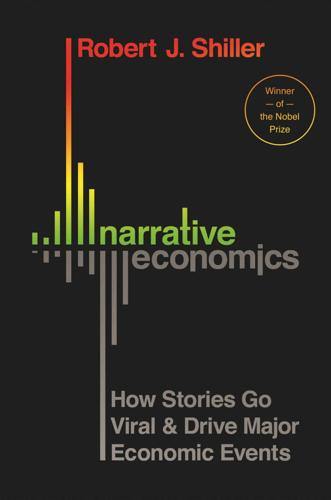
Narrative Economics: How Stories Go Viral and Drive Major Economic Events
by
Robert J. Shiller
Published 14 Oct 2019
On the contrary, growing evidence in recent years has shown that many consumers detest logos and aggressive marketing.15 Narrative contagion is often the result of arbitrary details, such as the frequency of meetings among people (many people see a logo on a shirt) and natural links to other contagious narratives (Lacoste’s onetime fame as a tennis player). Beauty Contests and Tail Feathers: How the Theory of Mind Feeds Economic Narratives Psychologists have noted that the human species is unique in the advanced development of its theory of mind—that is, humans’ strong tendency to form a model in their own minds of the activities in others’ minds. We are thinking about what others are thinking, about their individual thoughts. We observe their actions, their facial expressions, and their vocal intonation, which we then relate to their beliefs and intentions.
…
The contagion of specific narratives may be related to storytellers’ impressions regarding what other people will think. People like to hear stories that they can retell to others who will like the same story, and so storytellers like to tell such stories. In 1936, Keynes introduced what we now call theory of mind into economic theory with his “beauty contest” metaphor,16 which he put forth to explain speculative markets, such as the stock market. Keynes thought that people deciding which investments to make were basing their decisions on observations of what other investors were thinking or what they were about to do with their investments (which might cause future price changes).
…
See also conspicuous consumption narratives; spending contagion of economic models, 24–28 contagion of economic narratives: affecting economic activity, 77; attached to celebrities, xii, 51; based on citations, 321n22; bimetallism and, 171; Bitcoin and, 21–23; consumer behavior and, 254; enhanced by memories, 252; focus group research and, 283; Frederick Lewis Allen and, x, xi; as heart of narrative economics, x; home prices and, 215, 226, 227; marketing-driven, 60–63, 297; medical model of epidemics and, 21, 23; by modern media, 297; mutation of narrative and, 109; new theory of economic change based on, 3; opportunities for repetition and, 97; perceptions of other people’s reactions and, 64; profiteer narrative and, 241–42; stock market crash of 1987 and, 233; wage-price spiral narrative and, 260 contagion of ideas or social epidemics, 296, 297 contagion of narratives: caused by unknown processes, 41; celebrity as source of, 102; functioning as metaphors, 17; historical recognition of, 58–60; by modern media, 297; often resulting from arbitrary details, 62–63; opportunities for repetition and, 97–100; theory of mind and, 63. See also contagion of economic narratives contagion rates: book jackets and, 60–61; credibility of narrative and, 28–29; cultural factors affecting, 274; declining with time, 296; difficulty of predicting, 41; in disease epidemics, 18–21, 289, 290; effect of slight changes in, 40; engineered by marketers, 60; great variability of, 88–89; increased by new context, 271; increased by social media, 297; models from epidemiology and, 23–24, 295, 296; new technology leading to changes in, 273–75; novel ideas and concepts affecting, 97; raised by small detail, 45; of true vs. false stories, 96–97; varying through time, 295 controlled experiments on causality, 72–73; from outside economics, 77–79 Coolidge, Calvin, 44, 125 Coolidge-Mellon bull tips, 125–26 corporate profits: taxes on, 45, 48; viral narratives associated with, 47–48 corporate raiders, as viral term in 1980s, 47–48 cortisol, 54–55 cosmopolitan culture, and Bitcoin, 4, 11, 87 cost-push inflation, 258–59, 259f, 260 Coué, Emile, 121 CPI (Consumer Price Index), 245 crash narrative, 228, 229–33.
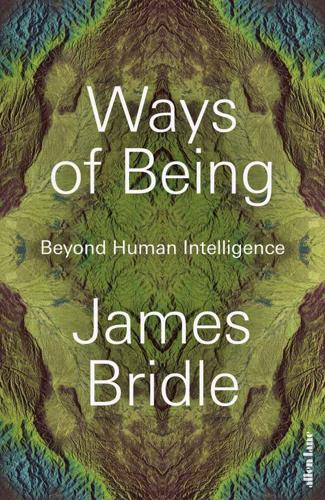
Ways of Being: Beyond Human Intelligence
by
James Bridle
Published 6 Apr 2022
The experimenters refused, but Michael kept asking for the lights to be turned off, and the drapes to be closed. Eventually, he retreated to the back of the room, turned his back on the watchers, and wiped his nose on the wall until the mark was gone.24 Michael’s reaction suggests not only self-recognition but another significant and much-contested quality of complex cognition: theory of mind. Theory of mind goes beyond simple recognition of the self distinct from other individuals: it implies the ability to think about the inner lives of others, to imagine their mental states, and to act accordingly. Beyond the simple interaction of the mirror test, we glimpse a much broader and more complex intelligence at work.
…
Even when the results are not merely the effects of our own biases and limitations, they only really tell us how much we don’t know. It turns out that mirror self-awareness isn’t even that well distributed across human individuals and cultures. Adults with schizophrenia often fail to recognize themselves in mirrors, and struggle with theory of mind as well. The oft-cited ‘fact’ that human children pass the mirror test – and thus develop self-recognition – at around eighteen months old turns out to be itself biased and only partly true. Those tests are based on Western children, primarily in the US and Canada, and don’t hold up in tests performed in Africa, South America and the Pacific islands.25 That doesn’t mean that non-Western kids aren’t self-aware.
…
This, then, is how we might become aware of real intelligence: that is, the kind that exists everywhere and between everything. It is made evident not by delineating and defining, not by splitting, reducing, isolating and negating, but by building, observing, relating and feeling. Intelligence, when we perceive it at play in the world, is not a collection of abstract modes: a concatenation of self-awareness, theory of mind, emotional understanding, creativity, reasoning, problem-solving and planning that we can separate and test for under laboratory conditions. These are simply reductive and all-too-human interpretations of a more boundless phenomenon. Rather, intelligence is a stream, even an excess, of all these qualities, more and less, manifesting as something greater, something only recognizable to us at certain times, but immanent in every movement, every gesture, every interaction of the more-than-human world.

Artificial Intelligence: A Guide for Thinking Humans
by
Melanie Mitchell
Published 14 Oct 2019
You assume, most often, that other humans you encounter have had sufficiently similar life experiences to your own, and thus you assume they are using the same basic background knowledge, beliefs, and values that you do in perceiving, describing, and making decisions about the world. In short, where other people are concerned, you have what psychologists call a theory of mind—a model of the other person’s knowledge and goals in particular situations. None of us have a similar “theory of mind” for AI systems such as deep networks, which makes it harder to trust them. It shouldn’t come as a surprise then that one of the hottest new areas of AI is variously called “explainable AI,” “transparent AI,” or “interpretable machine learning.”
…
Our intuitive knowledge of psychology tells us that the person on the scale is not aware that Obama is also stepping on the scale—we infer this from the person’s direction of gaze, and we know that he doesn’t have eyes in the back of his head. We also understand that the person probably can’t sense the slight push of Obama’s foot on the scale. Our theory of mind further lets us predict that the man will not be happy when the scale shows his weight to be higher than he expected. FIGURE 50: The photo discussed in Andrej Karpathy’s blog Finally, we recognize that Obama and the other people observing this scene are smiling—we infer from their expressions that they are amused by the trick Obama is playing on the man on the scale, possibly made funnier because of Obama’s status.
…
Smith, Brad speech recognition; adversarial examples for; word-error rate in Stanford Question Answering Dataset (SQuAD); human accuracy on Star Trek computer statistical machine translation strong AI; see also general or human-level AI subsymbolic AI; contrast with symbolic methods; integration with symbolic methods suitcase words Summer Vision Project (MIT) superhuman intelligence superintelligence, see superhuman intelligence Superintelligence (book) supervised learning; contrast with human learning; contrast with reinforcement learning; in IBM Watson support vector machines Sutherland, Amy Sutskever, Ilya Sutton, Richard symbolic AI; contrast with subsymbolic methods; integration with subsymbolic methods Szegedy, Christian T temporal difference learning; see also reinforcement learning test set theory of mind thought vectors training, see supervised learning training set transfer learning; for Breakout translation, see machine translation trolley problem Turing, Alan Turing test; Kurzweil and Kapor wager on; Kurzweil’s predictions for U understanding: in analogy; ascribing to computers; in automated image captioning; for creativity; in Cyc; in deep learning; in humans; in IBM Watson; in machine translation; for morality; for natural-language processing; in question-answering systems; for self-driving cars; in speech-recognition systems; in Star Trek computer; for vision; 263–65; for Winograd schemas unemployment unit unsupervised learning V vector Vinge, Vernor visual cortex visual situations von Neumann, John W Watson, see IBM Watson Watson, Thomas J.

Cartesian Linguistics
by
Noam Chomsky
Published 1 Jan 1966
Beyond these achievements, the universal grammarians of the seventeenth and eighteenth centuries have made a contribution of lasting value by the very fact that they posed so clearly the problem of changing the orientation of linguistics from “natural history” to “natural philosophy” and by stressing the importance of the search for universal principles and for rational explanation of linguistic fact, if progress is to be made toward this goal. 93 Acquisition and Use of Language We have so far extracted from “Cartesian linguistics” certain characteristic and quite important doctrines regarding the nature of language and have, quite sketchily, traced their development during the period from Descartes to Humboldt. As a by-product of this study of langue, and against the background of rationalist theory of mind, certain views emerged as to how language is acquired and used. After a long interlude, these views are once again beginning to receive the attention that they deserve, although their appearance (like the reappearance of the central ideas of transformational grammar) was, in fact, a largely independent development.
…
Contemporary work has finally begun to face some simple facts about language that have been long neglected, for example, the fact that the speaker of a language knows a great deal that he has not learned and that his normal linguistic behavior cannot possibly be accounted for in terms of “stimulus control,” “conditioning,” “generalization and analogy,” “patterns” and “habit structures,” or “dispositions to respond,” in any reasonably clear sense of these much abused terms. As a result, a fresh look has been taken, not only at language structure, but at the preconditions for language acquisition and at the perceptual function of abstract systems of internalized rules. I have tried to indicate, in this summary of Cartesian linguistics and the theory of mind from which it arose, that much of what is coming to light in this work was foreshadowed or even explicitly formulated in earlier and now largely forgotten studies. It is important to bear in mind that the survey that has been presented here is a very fragmentary and therefore in some ways a misleading one.
…
D., 119 (n.48) Wilkins, J., 69, 122 (n.55), 133 (n.95) Wittgenstein, L., 15, 23, 56, 117 (n.40), 123 (n.59), 128 (n.80), 133 (n.100), 138 (n.114) 154 Index of Subjects abstraction, 138 (n.114); see also generalized learning procedures acquisition of concepts, 9–10, 20, 25–27, 30–32, 35, 38, 43 (n.15) of language, 10, 25–32, 35, 38, 40, 41 (n.2), 43 (n.15), 45, 55, 63, 94–103, 104, 112 (n.25), 119 (n.48) 124 (n.63), 133 (n.94), 135 (n.105) 136 (n.110), 138 (n.114) adequacy, see descriptive adequacy, explanatory adequacy analogy, 37–38, 58, 90, 104, 111 (n.21) 112 (n.22), 122 (n.53), 124 (n.61) animal, 13, 37, 51–59, 62, 64, 67, 70, 102, 107 (n.8), 107 (n.9), 110 (n.11), 110 (n.12), 110 (n.13), 110 (n.14), 111 (n.21), 112 (n.23), 116 (n.38), 117 (n.40), 120 (n.51) communication, 52, 55–57, 62, 70, 108 (n.8), 110 (n.14), 111 (n.21) 112 (n.23), 116 (n.38), 117 (n.40) appropriateness of language use, 11, 13–15, 19, 20–24, 42 (n.10), 52–54, 107 (n.8); see also creative aspect of language use art, 9, 32, 42 (n.9), 46, 61, 99, 114 (n.33), 114 (n.34) artistic creativity, see creativity association, 33, 55, 65, 85, 98, 138 (n.114); see also generalized learning procedures automaton, 13, 51–59, 62, 67, 107 (n.8), 108 (n.9), 110 (n.9), 111 (n.14), 111 (n.16), 120 (n.51), 124 (n.62) 140 (n.117) base rules, see rules behaviorism, 17, 23, 33–34, 40 (n.1), 110 (n.11), 133 (n.94); see also conditioning biological limits of human intelligence, see limits of human intelligence biological system, language as, 11–12, 18, 21–22, 24, 27–30, 35–39 biology, 22, 32, 66, 118 (n.46), 136 (n.110) boundlessness of language, 12–15, 18, 20, 37–38, 41 (n.4), 43 (n.10), 52, 59, 61–64, 107 (n.8), 112 (n.22); see also creative aspect of language use Cartesian linguistics, see linguistics case marking, 132 (n.88) system, 82 central processor hypothesis, 20, 24, 37 character of language (Humboldt), 68 common notions (Herbert of Cherbury), 32, 94–96 common sense, 12, 16, 18–19, 22–23 43 (n.18) comparative grammar, see grammar competence (opposed to performance), 19, 25–26, 45, 69, 105 (n.2), 108 (n.8) computer, 42 (n.4), 41 (n.10), 140 155 Cartesian Linguistics (n.123); see also automaton concept, 9–12, 18–40, 42 (n.14), 43 (n.15), 63, 68, 70, 72, 95, 101, 103, 116 (n.38), 126 (n.70); see also innate idea/concept/ machinery conceptual-intentional system, 21–22, 30, 36, 129 (n.80) conditioning, 10, 32–34, 38, 55, 58, 69, 97, 98, 104, 110 (n.11), 138 (n.114); see also general learning procedures, behaviorism, empiricism, standard social science model core grammar, see grammar creative aspect of language use, 8–25, 31–40, 42 (n.9), 43 (n.18), 51–72, 87, 90, 102, 104, 108 (n.9), 111 (n.18), 113 (n.29), 113 (n.30), 117 (n.44), 118 (n.45), 124 (n.61), 134 (n.100), 139 (n.115) creativity artistic, 12, 61, 65, 114 (n.34) ordinary, see creative aspect of language use scientific, 11, 44 (n.18) critical period hypothesis for language acquisition, 98 diversity of human language, 25–29, 119 (n.48), 125 (n.63) education, 9, 11, 18, 27, 39–40, 67, 139 (n.115) empiricism, 7, 9–11, 17, 31–39, 40, 41 (n.6), 86, 98, 101, 107 (n.7) 109 (n.9), 137 (n.110), 138 (n.114) empiricist linguistics, see linguistics, empiricism English, 29, 122 (n.53) evolution, 22, 42 (n.12), 107 (n.7) explanatory adequacy, 26–27, 42 (n.11) 135 (n.105) explanatory grammar, see grammar expression (sound-meaning pair), 12, 17–21, 24, 37 externalism, 10, 33 faculty, 9, 16, 17, 20–24, 32, 43 (n.14), 43 (n.15), 59–61, 95, 99, 100, 109 (n.9), 120 (n.51), 124 (n.62), 140 (n.117) folk science, 16. see also common sense form of language (Humboldt), 17, 62–69, 94, 117 (n.39), 117 (n.42) 117 (n.44), 118 (n.45) free will, 9, 15, 16, 18, 22, 23, 36, 66, 108 (n.9) free word order, 129 (n.82), 132 (n.88) freedom, social and political, 8, 11, 22, 23–24, 33, 39, 59, 66, 67, 120 (n.51) French, 29, 74, 78, 79, 82, 85, 86, 91 122 (n.53), 122 (n.54), 130 (n.83) 134 (n.101) functionalism, 23, 34, 39 deep structure, 29, 73–87, 88–93, 125 (n.67), 127 (n.70), 127 (n.73), 129 (n.80), 132 (n.93) derivation, 30, 83, 129 (n.80); see also transformational grammar Descartes’ problem, see creative aspect of language use descriptive adequacy, 27, 90, 42 (n.11) descriptive grammar, see grammar descriptivism, see linguistics general grammar, see grammar 156 Index of Subjects general linguistics, see linguistics generalization, 58, 69, 98, 104, 138 (n.114); see also generalized learning procedures generalized learning procedures, 10, 32–39, 98. see also conditioning, empiricism, standard social science model, behaviorism generative grammar, see grammar generative principles, 20, 63–66; see also rules German, 17, 33, 66, 116 (n.37), 126 (n.69) Germany, 66 government, see state grammar comparative, 122 (n.53) core, 105 (n.2) descriptive, 88, 91 explanatory, 91, 134 (n.103) general, 69, 88–89, 94, 105 (n.3), 114 (n.30), 122 (n.53), 123 (n.59), 125 (n.67), 130 (n.83), 133 (n.95), 134 (n.103), 138 (n.112) generative, 49, 68–70, 102, 105 (n.2), 106 (n.4), 117 (n.39), 135 (n.106) particular, 68, 88–89, 94, 133 (n.95), 134 (n.101) philosophical, 17, 89–92, 105 (n.3), 130 (n.83), 132 (n.94) 133 (n.95) Port-Royal, 17, 29, 33, 72–83, 86, 90, 91, 105 (n.3), 114 (n.30), 125 (n.67), 126 (n.69), 126 (n.70), 127 (n.72), 128 (n.75), 131 (n.85), 133 (n.94), 133 (n.95), 135 (n.106) speculative, 134 (n.101) transformational generative, 29, 77–87, 94, 127 (n.73), 128 (n.75), 135 (n.106) universal, 17, 19, 27–31, 72, 92, 104, 105 (n.3), 132 (n.88), 134 (n.100), 134 (n.103) grammatical transformation, 74–87 habit, language as, 10, 33, 58, 69, 104, 111 (n.21), 123 (n.56), 138 (n.114); see also conditioning and behaviorism Hebrew, 17 head-first language, 29 head-last language, 29 history of linguistics, see linguistics human nature, 11, 34, 40, 59, 66, 67, 102, 103, 120 (n.51) idea (Descartes), 126 (n.70) I-language, 19, 20, 25, 27 inflectional devices, 82 innate idea/concept/mental machinery, 9–12, 17–18, 24–39, 41 (n.5), 41–42 (n.9), 43–44 (n.14), 43 (n.18), 45, 59, 65, 94–101, 104, 113 (n.29), 138 (n.114), 135 (n.105), 138 (n.114), 139 (n.115) instinct, 10, 34, 36, 53, 58, 59, 60, 63, 94, 95, 96, 113 (n.29), 121 (n.51) intension, see semantics interface level, 19–20, 21–22, 30, 37, 129 (n.80); see also LF, SEM, phonetic form, phonetic interpretation internalism, 10, 33–34, 130 (n.83) 157 Cartesian Linguistics Japanese, 29 judgment, 32, 72–79, 100, 101 language faculty, 20–22, 59, 42 (n.14) 43 (n.15), 59; see also universal grammar language game (Wittgenstein), 117 (n.40) language, function of, 15, 52, 58, 62, 64, 72. langue (Saussure), 131 (n.85), 132 (n.89) Latin, 74, 78, 79, 81, 85, 121 (n.53), 130 (n.83), 131 (n.88) lexical item, 17, 19, 20, 22, 25, 26, 27, 43 (n.15), 90, 131 (n.85); see also concept lexicon, 63, 68 LF, 129 (n.80), 130 (n.83); see also logical form, SEM, semantic interface liberalism, 39 libertarianism, 39–40 limits of human intelligence, 8, 16, 20, 23, 25, 35, 37, 111 (n.18) linguistic universals, 27, 28, 29, 92, 94, 136 (n.108); see also innate idea, concept, machinery linguistics Cartesian, 49, 50, 62, 64, 69, 70, 72, 73, 87, 88, 90, 93, 94, 96, 97, 103, 104, 105 (n.3), 115 (n.36), 129 (n.80), 134 (n.101) descriptivism in, 90, 134 (n.101) 135 (n.105) empiricist, 41 (n.6) 106 (n.3); see also empiricism general, 62 history of, 49, 105 (n.1) minimalism in, 129 (n.80) modern, 45, 49, 57, 67–68, 90, 92, 98, 132 (n.92), 132 (n.93) pre-modern/traditional, 130 (n.83), 133 (n.94) prescriptivism in, 133 (n.96) principles and parameters in, 29, 136 (n.108); see also parameters standard theory of, 17, 29 structuralism in, 67, 68, 90, 106 (n.3) taxonomic, 106 (n.3) logical form, 82, 129 (n.80); see also LF, SEM machine, see automaton meaning, see semantics mechanism and mechanical explanation, 8, 12–13, 15–16, 51–55, 65, 106 (n.3), 106 (n.5), 107 (n.8) 120 (n.51), 124 (n.62) mechanical form (Romantics), 65, 118 (n.45) methodological dualism, 32 mind-body distinction, 15–16, 28, 73 problem, 16, 28 Miskito, 29 modularity of the mind, 19–24, 35, 36 37, 110 (n.11) morality, 39, 101, 137 (n.111) morpheme, 92, 127 (n.73) morphogenesis, 42 (n.12), 107 (n.7) mystery, 11, 25, 124 (n. 61), see also limits of human intelligence, creative aspect of language use nativism, 10, 24–34, 94–101, 104; see also innate idea/concept/mental machinery natural history, 93 natural philosophy, see philosophy 158 Index of Subjects natural rights, 66, 120 (n.51) neoliberalism, 39 organic form (Romantics), 65, 68, 117 (n.44), 118 (n.45), 118 (n.46) other minds, problem of, 53–54, 106 (n.5) output level, see interface level parameters, 20, 27, 29–30, 136 (n.108). see also principles and parameters parole (Saussure), 131 (n.85), 132 (n.89) particular grammar, see grammar perception, 22, 31–32, 46, 63, 66, 72, 84, 85, 86, 93, 98–103, 104, 105 (n.2), 105 (n.3), 116 (n.38), 141 (n.123) performance, opposed to competence, 15, 21, 24, 55, 69, 104, 105 (n.2) perspectives (provided by language faculty), 15, 21, 22, 37 philosophical grammar, see grammar philosophy, 33, 68, 93, 41 (n.6), 106 (n.3), 106 (n.4), 118 (n.46), 123 (n.59), 128 (n.80), 133 (n.95), 139 (n.114), 139 (n.115), 140 (n.120) of language, 62, 115 (n.35) of mind, 31, 46, 98, 105 (n.3) phoneme, see phonetics phonetic form/interpretation, see phonetics and surface structure phonetics, 92, 136 (n.108) phonetic form, 88 phonetic interpretation, 29, 73, 77 phonology, 28, 46, 43 (n.15), 121 (n.52), 141 (n.124) phonological system, 68 phrase structure, 80, 127 (n.73); see also deep structure physics, 51 physiology, 51 plasticity of the mind, 32–36, 40, 113 (n.29), 115 (n.34) Platonism, 33, 96, 124 (n.61), 136 (n.110), 140 (n.120) Plato’s problem, see poverty of stimulus facts poetry, 46, 61, 68, 41 (n.9), 114 (n.33) 114 (n.34), 139 (n.115) politics, see state Port-Royal grammar, see grammar postmodernism, 32 poverty of stimulus facts, 24–28, 30–31, 35, 38, 39, 43 (n.16), 98, 135 (n.105) premodern linguistics, see linguistics prescriptivism, see linguistics principles and parameters, see linguistics prototype, 119 (n.47) psychological reality, 117 (n.41) psychology, 45, 46, 51, 53, 96, 106 (n.3), 106 (n.4), 111 (n.19) psychological explanation, 111 (n.19) rationalism, 9, 10, 15, 30–33, 36–40, 41 (n.6), 41 (n.7), 50, 94, 97–99, 105 (n.3), 137 (n.110), 140 (n.119) rationality, 59, 60 recursion, 80 reference, see semantics reminiscence theory (of Plato), 26–27, 137 (n.111) representation, 21, 63, 80, 85, 103, 42 (n.14), 127 (n.73), 129 (n.80), 130 (n.83) romanticism, 9–11, 17–18, 24, 27, 30– 33, 38–40, 41 (n.7), 50, 60–71, 97, 101, 105 (n.3), 115 (n.35) 124 159 Cartesian Linguistics (n.61), 125 (n.63), 140 (n.120) rules base, 80 transformational, 75, 78–80 schemata, 103 science, 91, 133 (n.100), 134 (n.103) of behavior, 8, 16, 20, 22–23, 24, 25, 35 of language, 11–12, 15–18, 20–21, 26, 38–39, 134 (n.100); see also grammar and linguistics of mind, 11, 16–17, 21, 24, 25–26, 42 (n.11) scientific creativity, see creativity second language acquisition, 124 (n.63), 138 (n.114) semantics intension, 127 (n.70) meaning, 20, 43 (n.15), 75, 77, 79, 84, 86, 90, 91, 127 (n.70), 130 (n.83), 131 (n.85) reference, 75, 91 SEM, 129 (n.80) semantic content, 75, 88, 92, 103 129 (n.80) semantic interface, 21, 22, 30, 129 (n.80) semantic interpretation, 29, 73 ,77 127 (n.70), 129 (n.80) semantic representation, 130 (n.83) signification, 123 (n.57) sign language, 21, 25, 46 simplicity, 82, 42 (n.11) species specificity of traits, 19, 32, 45, 51, 52, 116 (n.38), 120 (n.51) speech organs, 52, 53, 56, 58, 62, 84 standard social science model, 34–39 standard theory of linguistics, see linguistics state (political), 8, 11, 17, 39–40, 66, 67, 121 (n.51), 139 (n.115) stimulus freedom, 13–15, 18–19, 23–24, 41 (n.5), 42 (n.10), 52, 58–61, 107 (n.8), 113 (n.29), 113 (n.30); see also creative aspect of language use structuralism, see linguistics surface structure, 73–80, 84–87, 88–92, 127 (n.72), 129 (n.80), 131 (n.86), 132 (n.92), 132 (n.93), 133 (n.94). see also phonetic form, phonetic interpretation syntactic structure, see deep structure syntactic theory, see syntax syntax, 28, 46, 68, 69, 72, 80–85, 93, 132 (n.93), 141 (n.124) taxonomic linguistics, see linguistics thematic assignment, 129 (n.80) theory of language, 17–18, 49, 80, 43 (n.15), 119 (n.48), 125 (n.67), 133 (n.100); see also grammar, linguistics, science of language theory of mind, 50, 94, 104; see also science of mind training, language acquisition as, see conditioning, standard social science model, general learning procedures transformational rules, see rules transformational generative grammar, see grammar translation, 125 (n.63) trigger/triggering 10, 12, 25, 27–29, 31, 33, 38, 96.

Is the Internet Changing the Way You Think?: The Net's Impact on Our Minds and Future
by
John Brockman
Published 18 Jan 2011
My Judgment Enhancer Geoffrey Miller Evolutionary psychologist, University of New Mexico; author, Spent: Sex, Evolution, and Consumer Behavior The Internet changes every aspect of thinking for the often-online human: perception, categorization, attention, memory, spatial navigation, language, imagination, creativity, problem solving, Theory of Mind, judgment, and decision making. These are the key research areas in cognitive psychology and constitute most of what the human brain does. The Websites of BBC News and the Economist extend my perception, becoming my sixth sense for world events. Gmail structures my attention through my responses to incoming messages: delete, respond, or star for response later? Wikipedia is my extended memory. An online calendar changes how I plan my life. Google Maps changes how I navigate through my city and world. Facebook expands my Theory of Mind—allowing me to better understand the beliefs and desires of others.
…
The Royal Society, founded two decades after Galileo’s death, chose as their motto Nullius in verba (“On the authority of no one”), a principle strikingly at variance with the pre-Gutenberg world. The assumptions (e.g., I should be free to think about and question anything), methods (experimentation, statistical inference, model building), and content (evolutionary biology, quantum mechanics, the computational Theory of Mind) of modern thought are unimaginably different from those held by our ancestors living before Gutenberg. All this—to simplify slightly—because of a drop in the cost of producing books. So what is happening to us, now that the Internet has engulfed us? The Internet and its cybernetic creatures have dropped, by many more orders of magnitude, the cost in money, effort, and time of acquiring and publishing information.
…
But there is also the strong possibility, based on circumstantial evidence relating to a “cultural explosion” of human artifacts and technologies, that a mutation rewired the brain for computational efficiency. This rewiring allowed for recursion (embedding whole bundles of perceptions and thought within other bundles of perceptions and thoughts), which is an essential property of both human language (syntactic structures) and mind-reading skills (or Theory of Mind, the ability to infer other people’s thoughts and perceptions: “I know that she knows that I know that he knows that . . . ,” etc.). Language and mind reading, in turn, became critical to development of peculiarly human forms of thinking and communication, including planning and cooperation among anonymous strangers, imagining plausible versus fictitious pasts and futures, the counterfactuals of reason, and the supernaturals of religion.
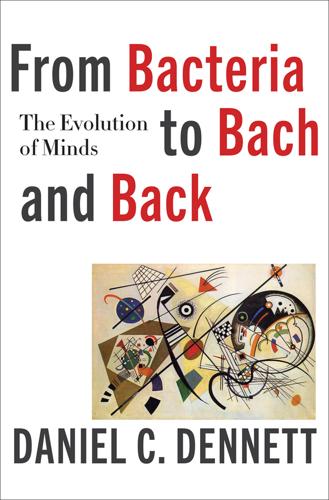
From Bacteria to Bach and Back: The Evolution of Minds
by
Daniel C. Dennett
Published 7 Feb 2017
Another proposed threshold is social intelligence (Jolly 1966; Humphrey 1976): the competence to interpret others as intentional systems whose actions can be anticipated by observing what these others observe and figuring out what they want (food, escape, to predate you, a mating opportunity, to be left alone). This competence is often called TOM (an acronym for theory of mind), which is an ill-chosen term because it invites us to imagine those having this competence as comprehending theoreticians, astute evidence gatherers and hypothesis considerers, instead of flying-by-the-seat-of-their-pants agent anticipators, blessed with an interpretive talent they don’t have to understand at all.
…
Other speakers of a language may have the “gift of gab” or more specialized gifts—the power to comfort, to persuade, to seduce, to amuse, to inspire. This all “comes naturally” to some and is largely beyond the talents of others. Some, especially those on the autism spectrum who are especially “high functioning,” like Temple Grandin, manage to devise, with much effort and ingenuity, a genuine TOM, a theory of mind, to help them interpret the kaleidoscopic social world that most of us can “perceive directly.” We are also gradually acquiring theoretical understanding, and genuine comprehension, of the reasons for the features of our communication systems. Those who excel at this research often sell their services as intelligent designers of communication—public speaking coaches, marketing consultants, advertisers—but as we can confirm in other areas of human endeavor—jazz comes particularly to mind—theory is often no match for ear, even when it is good theory.
…
See the chapters on memes in CE (1991), DDI (1995), and “The Evolution of Culture” (2001b). 254On the lancet fluke in the ant climbing the blade of grass, see “The Evolution of Culture” (2001b) and Breaking the Spell: Religion as a Natural Phenomenon (2006). 265vervet monkey alarm calls. My BBS article on cognitive ethology (1983), discussed the difficulties of distinguishing anecdote from scientific evidence of animal intelligence. “Beliefs about beliefs,” (1978d), my commentary on Premack and Woodruff’s BBS Target Article, “Does the Chimpanzee Have a Theory of Mind?” (1978), was followed by a wide variety of studies, in the field and the laboratory, of signs of higher-order intentionality (such as the false belief tasks) in animals and children. See, for instance, Whiten and Byrne (1988) Machiavellian Intelligence and Machiavellian Intelligence, II: Extensions and Evaluations (1997), as well as more recent work by Tomasello, Call, Povinelli, and many others.
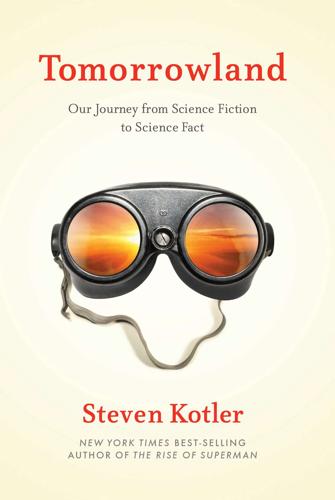
Tomorrowland: Our Journey From Science Fiction to Science Fact
by
Steven Kotler
Published 11 May 2015
The Genius Who Sticks Around Forever THE SCIENCE OF MIND UPLOADING In his novel Terra Nostra, author Carlos Fuentes writes: “Incredible the first animal that dreamed of another animal.” Quite an idea, right? Both the origin story for dreaming and the initial step up the ladder that scientists describe with the phrase “theory of mind”: our ability to attribute mental states — beliefs, intents, desires — to oneself and others. It is, without question, an extraordinary ability. Now consider the opposite end of the spectrum, the farthest rung up the theory-of-mind ladder: the ability to share the mind of another. This is the frontier known as mind uploading, and it is a truly wild frontier. In the previous chapter, we explored using technology to battle back decrepitude.
…
Wade, 208 Rosenau, William, 233–34 Ross, Ronald, 134 Ross, Stephen, 169 Rossin, Dave, 118 Rothenberg, Ron, 185–87, 192, 197–98 Rothman, Cappy, 247, 249–63 Rothman, Norman “Roughneck,” 249 Rozelle, David, 5–7, 10–12, 15–19, 20–21 Rubin, Gerald, 136–37 Rutan, Burt, 151 Salk, Jonas, 55 Sandoz Pharmaceuticals, 168 Saskatchewan Study, 169 Satava, Richard, 15 Schmidt, Eric, 145 Schwartz, Peter, 11 science fiction on asteroid mining, 145, 147–48 on mind uploading, 27–28 terraforming in, 87 Sears, Derek, 150 Seattle Study, 39–40 self, boundaries of, 46–47 Selfridge, Tom, 66–67 Senate Bill 212, 215 serotonin, 42 Shaw, George Bernard, 3 Shell, 148 Siegel, Ronald, 167 Simak, Paul, 145 Single Mothers by Choice, 253 The Singularity Is Near (Kurzweil), 28 The Six Million Dollar Man (TV show), 11 ski-BASE, 130 Skycar, 100 skydiving, 35–36, 125–30 Skygrabber, 235 slavery, financial profitability of, 51–53 smallpox, 236–37 Small Scale Nuclear Reactors, 119, 121 Socolow, Robert, 114 Solazyme, 231–32 Sorenson, Kirk, 120 Soul Catcher, 25–27, 28, 30–31 sound barrier, xii, 101 Southern Baptist Church, 260 Space Adventures Ltd., 145 SpaceShipOne, 129 SpaceShipTwo, xiii, 129 space travel, 129–30 asteroid mining and, 141–52 ethics of, 143–47 off-world colonies and, 150–51 XPRIZE competition for, xi–xiii, 129 Special Theory of Relativity, 109 SPECT (single positron emission computed topography), 45–46 Spenser, Jack, 111 sperm banks, 247–63 donor anonymity in, 253–57, 260–62 donor screening for, 252–53, 261–62 donor tracking by, 256–57, 262 economics of, 250–51 incest among offspring from, 257–60 regulation of, 251, 258–59, 260–63 Spirit of America (car), xii spiritual traditions, xiv–xvi fear of death and, 29 mystical experiences and, 33–48 near-death experiences and, 42–45 psychedelic drugs in, 167–68 spoonbills, 93–94 sports extreme, 125–30 out-of-body experiences in, 36–37 as play, 125 prosthetics and, 12–13, 15, 17, 19–20 skydiving, 35–36, 125–30 steroid use in, 183, 187–90, 193–95 weightlifting, 189–90 Spradling, Allan, 136, 137 stabilization wedges, 114 Stanford, George, 106, 119–120 Stanford University, 216–17 Stapledon, Olaf, 85 Stardust (space vehicle), 146 starry-night effect, 64–65 stars, creation of, xvii State Children’s Health Insurance Program, 210 Steindl-Rast, David, 173 stem cells, 201–18 anti-abortion war and, 208–10 in anti-aging medicine, 199 availability of for research, 211–13 bioweapons and, 240 cancer and, 205 conflated with cloning, 214–15 defining life and, 209 efforts to change federal law on, 213–15 from embryos, 209 fetal, 208–10 hematopoietic, 205–6 hybridization of, 200 loss of research and researchers on in the US, 212–13 methods for obtaining, 207–8, 214–15 organ transplants and, 204–5 parthenogenesis of, 208 politicization of, 206–17 potential of, 206 state legislation on, 211–13 StemCells Inc., 216 Sterling, Bruce, 247 Steroid Control Act, 189–90, 198 steroids, 183–200 for AIDS treatment, 196–97 anabolic and androgenic, 192 for cosmetic purposes, 190 DHEA, 186, 198 early research on, 192–93 human growth hormone, 198 metabolic effects of, 190–92 misinformation about, 183–84, 188–90, 193–95 negative effects of, 188–89, 194 research on, 189–90 ’roid rage and, 189 in sports, 183, 187–90, 193–95 testosterone, 192–93, 198–99 Stewart, Jon, 145 Stratos Project, 127–30 Strauss, Lewis, 109 Studebaker, winged, 100 Studies in Conflict and Terrorism, 233–34 sugarcane farming, 87–89 Sulgin, Alexander, 160 Survival Research Labs, 101 Svalbard Global Seed Vault, 249 Swiss Federal Institute of Technology, 27 synthetic biology, xv, 219, 230–38, 241–42 Synthetic Genomics, 230 Szilárd, Leó, 109 Talent, Jim, 237 technology criminal use of, 235–36, 246 democratization of, 247–48 disruptive, xiv–xvi, 31, 151 evolution and, 56–59 irresistibility of, xvi–xvii rate of change in, 28, 57, 225–27 technopatric speciation, 58–59 techno-physio evolution, 54–57 telomeres, 191 temporal lobe, 43–45, 47–48 terraforming, 81–95 Terrafugia Transition, 100 Terra Nostra (Fuentes), 23 TerraPower, 121 terrorism, 229–30 bioweapons in, 233–38, 241–42 FBI biosecurity conferences and, 236–37 information technology in, 235 nuclear energy and, 120 testosterone, 192–93, 198–200 theory of mind, 23 This Is Reality (Martensson), 27 This Timeless Moment (Huxley), 181–82 Thompson, Hunter S., 168, 171 thorium reactors, 119–20 Three Mile Island, 110, 118 Thurmond, Strom, 213–14 Time on the Cross: An Economic Analysis of American Negro Slavery (Fogel & Engerman), 52–53 Tito, Dennis, 145 Toshiba, 121 Toth, Lou, 85–86 tourism, space, 129–30 transcendent states, 45–47, 165 trans fats, 198 transposable elements, 136–38 traveling wave reactors, 121 Truax, Robert, 101 Truax Engineering, 101 Tsiolkovsky, Konstantin, 145 Tsukamoto, Ann, 216 “The Tunnel Under the World” (Pohl), 27 tunnel vision, 41–42 UK Royal Commission on Environmental Pollution, 115 United Nations, 217 unity, cosmic, 45–47, 165, 175 US Air Force, 241 US Department of Energy, 119, 228 van Lommel, Pim, 40, 42 Venter, Craig, 228, 230, 231, 247 Vergel, Nelson, 196–97 Virgin Galactic, 129 vision artificial implants for, xiv, xvi, 26, 61–77 cost of artificial, 75–76 effects of electricity on, 79, 80–81 functional mobility in, 67 neuroprosthesis for, 67 religions on, 74 retinal implants for, 66–67 starry-night effect in, 64–65 tunnel, in near-death experiences, 41–42 “The Voice” (Butcher), 37 Walter Reed hospital, 15, 17 Walton, Ernest, 109 water impoundments, 88–90 Waterman, Waldo, 100 Watson (artificial intelligence), 223 weapons of mass destruction, 227, 245–46 Weapons of Mass Destruction Directorate, 236–37 weightlifters, 189–90 Weiland, James, 76–77 Weissman, Irv, 203–7, 209, 211, 215–17 Weldon, Dave, 215 Weldon Bill, 215 West Nile virus, 133, 134 What Technology Wants (Kelly), xvi–xvii Whinnery, James, 40–42 Wick, Douglas, 213–14 Wikileaks, 224, 242 Wimmer, Eckard, 233 Winkler, Allan, 110 World Health Organization (WHO), 61 Wright Brothers, 72–73 XPRIZE, xi–xiii, 129, 141, 151 yellow fever, 133, 137 Yesalis, Charles, 195 You, Edward, 236–37 Yushchenko, Viktor, 238 Zee-Aero, 105 Zucker, Jerry, 213–14
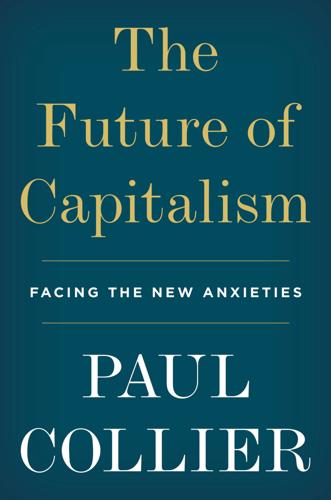
The Future of Capitalism: Facing the New Anxieties
by
Paul Collier
Published 4 Dec 2018
.* Yet Smith did not think that we are economic man.3 He regarded the butcher and the baker not just as individuals pursuing their self-interest, but as morally motivated people in a society. A computer predicts the behaviour of economic man from the axioms of rational self-interest. But we predict the actions of the butcher and the baker by putting ourselves in their shoes; it is known as the ‘theory of mind’. Smith recognized that seeing a person from the inside not only enables us to understand them, but induces us to care about them and assess their moral character. These emotions of empathy and judgement he saw as the foundation of morality, driving a wedge between what we want to do, and what we feel we ought to do.
…
If the educated see themselves as different from the less educated, and with diminished responsibility towards them, those others would be foolish to continue to trust them as much as when they knew that everyone had the same salient identity. We trust people if we are confident that we can predict how they will behave. We have more confidence in our predictions if we can safely use the techniques of a ‘theory of mind’: I predict your behaviour by imagining how I would behave in your circumstances. But using this technique is only reliable to the extent that I am confident that we share the same belief system. If we have radically different belief systems, I cannot put myself in your shoes because I do not inhabit the mental world that shapes your behaviour.
…
To locate a specific entry, please use your ebook reader’s search tools. 3G mobile phone network, 88 Abedi, Salman, 212, 213 abortion, 99, 102 AfD (Alternative for Germany), 5 Africa, 8, 110–11, 192, 193 capital flight, 208 HIV sufferers in, 120–21 need for modern firms, 37 and World Bank/IMF, 118† youth’s hope of escape to Europe, 121 African Americans, 13 Akerlof, George, 18, 34, 35, 50–51 Amazon, 87, 91, 146, 147 anger management programmes, 160 Apple, 148 asymmetric information, 88, 90, 185 auction theory, 146–7, 148 Bank of England, 39 Bear Stearns, 71, 75, 86 belief systems and belonging, 34, 40–41, 42, 53–6, 165, 211–15 CEO compensation committees, 77–8 Clark’s ‘family culture’, 107–8 the ethical family, 97–8, 99–105, 108, 109, 210 formation through narratives, 34, 40–41, 42, 53–6, 165, 211–15 GM-Toyota comparisons, 72–4 and ISIS, 42 Johnson & Johnson’s Credo, 39–40, 40*, 41, 72, 74*, 79 and leadership, 41–2, 43, 95 of personal fulfilment, 28, 99, 100–101, 102, 103, 108–9, 213 polarization within polities, 38, 63, 202–5 and schools, 165 Theory of Signalling, 41, 43, 53, 63, 95 and trust, 27, 29*, 48, 53–4, 55–6, 59, 63, 73–4, 79, 94–5, 210 see also belonging, narrative of; reciprocity value-based echo-chambers, 38, 61–2, 64–5, 212, 215 see also nationalism belonging, narrative of absent from Utilitarian discourse, 16, 59, 66–7, 210–11 avoided by politicians, 66–7, 68, 211, 215 as a basic drive, 27, 31, 42–3, 65, 66 and belief systems, 34, 40–41, 42, 53–6, 211–15 in Bhutan, 37† civil society networks/groups, 180–81 and ‘common knowledge’, 32–3, 34, 54, 55, 66, 212 families as natural units for, 32, 97–8, 104 heyday of the ethical state, 49, 68, 114 and home ownership, 68, 181–2, 184 and ISIS, 42, 212, 213 and language, 32, 33, 54, 57 and mutual regard/reciprocity, 25, 40–41, 49, 53–6, 67, 68, 98, 181, 182, 210–11, 212–13 place-based identity, 51–6, 65–8, 211–14, 215 and purposive action, 68, 98, 114, 211, 212, 213 and salient identity, 51–6 Bennett, Alan, The History Boys, 7* Bentham, Jeremy, 9–10, 12, 13 Berlusconi, Silvio, 14 Besley, Tim, 18–19, 35 Betts, Alex, 27 BHS, 80, 172 Bhutan, 37†, 63 Biafra, 58 Bitcoin, 37–8, 193 Blackpool, 4 Bonhoeffer, Dietrich, Letters and Papers from Prison, 108 The Bottom Billion (Collier), 27 Brazil, 58 Brexit vote (June 2016), 5, 125, 131, 196, 215 British Academy, 7 British Motor Corporation, 74 Brooks, David, The Road to Character, 108 Buiter, Willem, 186 Bush, George W., 120–21 business zones, 150 ‘Butskellism’, 49* Cadbury, 77 Cameron, David, 205 Canada, 22 capitalism competition, 21, 25, 56, 85, 86 ‘creative destruction’ concept, 21 current failings of, 4–5, 17, 25, 42, 45–6, 48, 201, 212–13 and decline of social trust, 5, 45–6, 48, 55, 59, 69 as essential for prosperity, 4–5, 18, 20, 25, 201 and families, 37 first mover advantage, 148 and greed, 10, 19, 25–7, 28, 31, 42, 58, 69, 70†, 81, 95 and Marx’s alienation, 17–18 and oppositional identities, 56, 74 vested interests, 85, 86, 135–6, 207 see also firms Catalan secession movement, 58 causality, narrative of, 33, 34 CDC Group, 122, 149* Chaucer, Geoffrey, The Canterbury Tales, 129 Chicago, University of, 166 childhood adoption, 110–11 children in ‘care’, 104, 105, 110, 111, 157 children ‘reared by wolves’, 31–2 cognitive development, 105–6, 170, 175–6 fostering, 104, 105, 111 identity acquisition, 32 impact of parental unemployment, 160–61 learning of norms, 33, 35, 107–8 non-cognitive development, 105, 163, 169–70, 171–3, 174, 175–6 ‘rights of the child’ concept, 103–4 in single-parent families, 101, 102, 104–5, 155, 160 trusted mentors, 169–70 see also family China, 118–19, 149, 203 Chira, Susan, 52–3 Chirac, Jacques, 14, 120–21 Christian Democratic parties, 5, 14 Citigroup, 186 Clark, Gregory, The Son Also Rises, 106–8 Clarke, Ken, 206 class divide assortative mating among new elite, 99–100, 154, 188–9 author’s proposed policies, 19–20, 21, 183–4, 187–8, 190, 207–8 and breadth of social networks, 169 and Brexit vote, 5, 196 and cognitive development, 105–6 divergence dynamic, 7, 18, 48, 98–108, 154–61, 170–71, 172–80, 181–90 ‘elite’ attitudes to less-well educated, 4, 5, 12, 16, 53, 59, 60–61, 63 and family life, 20, 98, 99–106, 157–62 and fracture to skill-based identities, 3–5, 51–6, 78 and home ownership, 68, 181, 182–3 need for socially mixed schools, 164–5 and non-cognitive development, 105, 163, 169–70, 171–3, 174, 175–6 and parental hothousing, 100, 101, 105–6 post-school skills development, 170–76 pre-emptive support for stressed families, 20, 155, 157–60, 161–3, 208 and reading in pre-teens, 167–9 and recent populist insurgencies, 5 retirement insecurities, 179–80 and two-parent families, 155–6, 157 unravelling of shared identity, 15, 50, 51–6, 57*, 58–61, 63, 215 see also white working class climate change, 44, 67, 119 Clinton, Hillary, 5, 9, 203–4 coalition government, UK (2010–15), 206 cognitive behavioral therapy, 160 Cold War, 113, 114, 116 end of, 5–6, 115, 203 Colombia, 120 communism, 32, 36–7, 85–6 communitarian values care, 9, 11, 12, 16, 29, 31, 42, 116 fairness, 11, 12, 14, 16, 29, 31, 34, 43, 116, 132–3 hierarchy, 11, 12, 16, 38–9, 43, 99–100 left’s abandonment of, 16, 214* liberty, 11, 12, 16, 42 loyalty, 11, 12, 16, 29, 31, 34, 42–3, 116 new vanguard’s abandonment of, 9, 11–13, 14–15, 16, 17, 49–50, 113, 116–18, 121, 214 post-war settlement, 8–9, 49, 113–16, 122 and reciprocal obligations, 8–9, 11–12, 13, 14, 19, 33, 34, 40–41, 48–9, 201, 212–15 roots in nineteenth-century co-operatives, 8, 13, 14, 201 sanctity, 11, 16, 42–3 Smith and Hume, 21–2† values and reason, 29–30, 43–4 see also belonging, narrative of; obligation, narrative of; reciprocity; social democracy Companies Act, UK, 82 comparative advantage, 20, 120, 192, 194 Confederation of British Industry (CBI), 79 conservatism, 30, 36 Conservative Party, 14, 49, 205, 206 contraception, 98–9, 102 co-operative movement, 8, 13, 14, 201 Corbyn, Jeremy, 202, 204–5 Crosland, Anthony, The Future of Socialism, 17, 18, 19 Cuban Missile Crisis (1962), 114 debutante balls, 188 Denmark, 63, 178, 214* Descartes, Rene, 31 Detroit, 128, 129, 144 Deutsche Bank, 78, 185 development banks, 149–50 Development Corporations Act (1981), 150 Dickens, Charles, Bleak House, 108 digital networks detachment of narratives from place, 38, 61–2 economies of scale, 86–7 global e-utilities, 37, 38, 86–7, 89–90, 91 social media, 27, 61, 87, 173, 207, 215 value-based echo-chambers, 38, 61–2, 64–5, 212, 215 Draghi, Mario, 153 Dundee Project, 161–2 Dutch Antilles, 193 East Asia, 147, 192 eBay, 87 economic man, 10, 19, 25, 26–7, 31, 34–5, 196, 209, 210, 215 economic rent theory, 19, 91, 133–9, 140–44, 186–8, 192, 195, 207 education and collapse of social democracy, 50, 52, 53, 54, 55, 59, 63 and empathy, 12 and European identity, 57* expansion of universities, 99–100, 127 and growth of the middle class, 100 inequality in spending per pupil, 167 mis-ranking of cognitive and non-cognitive training, 174–6 need for socially mixed schools, 164–5 post-school skills development, 170–76 pre-school, 105–6, 163–4 quality of teaching, 165–6 reading in pre-teens, 167–9 and shocks to norms of ethical family, 98, 99–105 symbols of cognitive privilege, 175 teaching methods, 166–7 vocational education, 171–6 zero-sum aspects of success, 189 electoral systems, 206 Emerging Market economies, 129, 130–31 empires, age of, 113 The Enigma of Reason (Mercier and Sperber), 29 enlightened self-interest, 33, 40*, 97–8, 101, 109, 112, 113, 114, 117, 184, 213 Enron, 80 ethnicity, 3, 20, 56, 62, 64, 65, 211 Europe Christian Democrats in, 5, 14 class divides, 3, 4, 5, 125 decline in social trust, 45 and knowledge industries, 192 metropolitan-provincial divides, 3, 4, 125 and migration, 121, 197 and shared identity, 57–8, 64, 66, 125 social democracy in, 8–9, 49, 50 European Central Bank, 153 European Commission, 57 European Investment Bank, 149 European Union (EU, formerly EEC), 66, 67, 114, 115, 116, 117 Brexit vote (June 2016), 5, 125, 131, 196, 215 Eurozone crisis, 153 public policy as predominantly national, 212 universities in, 170 evolutionary theory, 31, 33†, 35–6, 66 externalities, 145–6 Facebook, 87 Fairbairn, Carolyn, 79 fake news, 33–4 family, 19 African norms, 110–11 benefits for single parents, 160 Clark’s ‘family culture’, 107–8 entitled individual vs family obligation, 99–103, 104–6, 108–9, 210 equality within, 39, 154 erosion of mutual obligations, 101–2, 210 identity acquisition, 32 ideologies hostile to, 36–7 impact of unemployment/poverty, 4, 7, 160–61 importance of, 36, 37 and increased longevity, 110, 161 in-kind support for parenting, 161 nuclear dynastic family, 102, 110, 154 one-parent families, 101, 102, 104–5, 155, 160 parental hothousing, 100, 101, 105–6 post-1945 ethical family, 97–8, 99–105, 108, 210 pressures on young parents, 159–60, 161–3 and public policy, 21, 154–5, 157–70, 171–3, 177, 209 and reciprocity, 97–8, 101, 102 shocks to post-1945 norms, 98–105 shrinking of extended family, 101–2, 109–10, 161 social maternalism concept, 154–5, 157–8, 190 two-parent families as preferable, 155–6, 157 see also childhood; marriage Farage, Nigel, 202 fascism, 6, 13*, 47, 113 Federalist papers, 82 feminism, 13, 99 Fillon, François, 204 financial crisis, global (2008–9), 4, 34, 71, 160 no bankers sent to gaol for, 95–6 financial sector, 77–9, 80–81, 83–5 asymmetric information, 88, 185 co-ordination role, 145–6 economies of scale, 87 localized past of, 84, 146 toxic rivalries in, 189 trading in financial assets, 78–9, 84, 184–5, 186, 187 Finland, 63 firms, 19, 21, 69 CEO pay, 77–8, 79, 80–81 competition, 21, 25, 56, 85, 86 control/accountability of, 75–81, 82–5 cultures of good corporate behaviour, 94–5 demutualization in UK, 83, 84 deteriorating behaviour of, 18, 69, 78, 80–81 economies of scale, 17–18, 37, 86–7, 88–91, 126–7, 144–5, 146–7 ethical, 70–71, 172, 209–10 and ethical citizens, 93–4, 95, 96 failure/bankruptcy of, 70, 71, 72, 74, 75–6 flattening of hierarchies in, 39 Friedman’s profit nostrum, 69–70, 71, 76, 78–9, 210 global e-utilities, 37, 38, 86–7, 89–90, 91 ideologies hostile to, 37, 81 low productivity-low cost business model, 173–4 ‘maximising of shareholder value’, 69–70, 76, 79, 82–3 ‘mutuals’, 83 need for bankslaughter crime, 95–6 new network features, 86–7 policing the public interest, 93–4 public dislike of, 69, 95–6 public interest representation on boards, 92–3 regulation of, 87–90, 174 reward linked to short-term performance, 77, 78–81 sense of purpose, 39–40, 41, 70–75, 80–81, 93–4, 96 shareholder control of, 76–7, 79, 80, 82–3 societal role of, 81–2, 92–3, 96, 209–10 utility services, 86, 89, 90 worker interests on boards, 83, 84–5 Fisher, Stephen, 196* Five Star, 125 Ford, 70, 71 France, 7, 63, 67, 114 écoles maternelles in, 164 labour market in, 176, 189 pensions policy, 180 presidential election (2017), 5, 9, 204 universities in, 170 working week reduced in, 189 Frederiksen, Mette, 214* Friedman, Milton, 15, 69–70, 71, 76 The Full Monty (film), 7, 129 G20 group, 118 G7 group, 118 G8 group, 194 Ganesh, Janan, 125 Geldof, Bob, 169 General Agreement on Tariffs and Trade (GATT), 114, 115, 116–17 General Motors (GM), 72, 73–4, 75, 86, 172 geographic divide, 3, 16, 18, 19, 215 author’s proposed policies, 19, 207 and Brexit vote, 125, 196 broken cities, 4, 7, 19, 48, 125, 129–30, 147–9 business zones, 150 co-ordination problem over new clusters, 145–50, 207 decline of provincial cities, 4, 7, 19, 48, 125, 129–30, 131, 144–5 economic forces driving, 126–30 and education spending, 167 first mover disadvantage, 148–9 ideological responses, 130–32 investment promotion agencies, 150–51 and local universities, 151–2 and metropolitan disdain, 125 need for political commitment, 153 as recent and reversible, 152–3 regenerating provincial cities, 19, 142, 144–50 and spending per school pupil, 167 widening of since 1980, 125 George, Henry, 133–6, 141 Germany 2017 election, 5, 205 local banks in, 146 Nazi era, 57 and oppositional identities, 56–7 oversight of firms in, 76 post-war industrial relations policy, 94–5 and post-war settlement, 114 re-emergence of far right, 5 rights of refugees in, 14 ‘social market economy’, 49 TVET in, 171–2, 174, 175 vereine (civil society groups), 181 worker interests on boards, 84–5 global divide, 7–8, 20, 59–60, 191–8, 208 globalization, 4, 18, 20, 126–7, 128, 129, 130–31, 191–8 Goldman Sachs, 70†, 83–4, 94 Google, 87 Great Depression (1930s), 114 Green, Sir Philip, 80 Grillo, Beppe, 202 ‘Grimm and Co’, Rotherham, 168–9 Gunning, Jan Willem, 165 Haidt, Jonathan, 11–12, 14, 16, 28, 29, 132–3 Haiti, 208 Halifax Building Society, 8, 84 Hamon, Benoît, 9, 204 Harvard-MIT, 7, 152 Hershey, 77 HIV sufferers in poor countries, 120–21 Hofer, Norbert, 202 Hollande, Francois, 9, 204 Hoover, 148 housing market, 181–4 buy-to-let, 182, 183, 184 and lawyers, 187 mortgages, 84, 176, 182, 183–4 proposed stock transfer from landlords to tenants, 184 Hume, David, 14, 21, 21–2†, 29 Huxley, Aldous, Brave New World (1932), 5 Iceland, 63 Identity Economics, 50–56, 65–7 ideologies based on hatred of ‘other’ part of society, 43, 56, 213, 214 ‘end of history’ triumphalism, 6, 43–4 hostile to families, 36–7 hostile to firms, 37, 81 hostile to the state, 37–8 and housing policy, 183 and migration, 198 New Right, 14–15, 26, 81, 129 norms of care and equality, 116, 132–3 polarization of politics, 38, 63, 202–5 pragmatic eschewal of, 17, 18, 21, 22, 29–30 and principle of reason, 9, 13, 14, 15, 21, 43 Rawlsian vanguard, 13–14, 30, 49–50, 53, 67, 112, 113, 201, 202, 203, 214 return of left-right confrontation, 5, 6, 81, 202–5 and rights, 12–14, 44, 112 seduction of, 6 and twentieth century’s catastrophes, 5–6, 22 views on an ethical world, 112 see also Marxism; rights ideology; Utilitarianism IFC (International Finance Corporation), 122 Imperial Chemical Industries (ICI), 69–70, 75 India, 118–19 individualism entitled individual vs family obligation, 99–103, 104–6, 108–9, 210 fulfilment through personal achievement, 28, 99, 100–101, 102, 103, 108–9, 213 New Right embrace of, 14–15, 53, 81, 214–15 as rampant in recent decades, 19, 214–15 reciprocity contrasted with, 44–5 and withering of spatial community, 61–2 industrial revolution, 8, 126 inequality and assortative mating among new elite, 99–100, 154, 188–9 and divergence dynamic, 7, 18, 48, 98–108, 154–61, 170–71, 172–80, 181–90 and financial sector, 185 and geographic divide, 3, 7–8, 20, 125 global divide, 7–8, 20, 59–60, 191–8, 208 persistence of, 106–8 Rawls’ disadvantaged groups, 3–4, 13–14, 16, 50, 53, 121, 203–4, 214 and revolt against social democracy, 15–16 rising levels of, 3–5, 106, 125, 181, 190 and Utilitarian calculus, 132 innovation, 185–6, 208 International Monetary Fund (IMF), 114, 117 international relations achievement of post-WW2 leaders, 113–16, 122 building of shared identity, 114–16 core concepts of ethical world, 112, 113–14 erosion of ethical world, 116–18 expansion of post-war ‘clubs’, 116–18, 210 new, multipurpose club needed, 118–19, 122 and patriotism narrative, 67 situation in 1945, 112–13, 122 investment promotion agencies, 150–51 Irish Investment Authority, 151 Islamist terrorism, 42, 212, 213 Italy, 4, 58, 160 James, William, 29* Janesville (US study), 178 Japan, 72–3, 94, 101, 149, 192 John Lewis Partnership, 83, 172 Johnson, Robert Wood, 39–40, 72 Johnson & Johnson, 39–40, 41, 72, 74*, 79 Jolie, Angelina, 112 JP Morgan, 71* Juppé, Alain, 204 Kagame, Paul, 22 Kay, John, 82*, 84, 211 Keynes, John Maynard, 115 General Theory (1936), 47 kindergartens, 163 Knausgård, Karl Ove, 173 knowledge revolution, 126, 127–8 Kranton, Rachel, 35, 50–51 Krueger, Anne, 141 Krugman, Paul, 47 labour market flexicurity concept, 178 function of, 176–7 and globalization, 192, 194–6 and immigration, 194, 195, 196 investment in skills, 176–7 job security, 176, 177 and low productivity-low cost business model, 173–4 minimum wage strategies, 147, 174, 176, 180 need for reductions in working hours, 189 need for renewed purpose in work, 190 regulation of, 174, 189 and robotics revolution, 178–9 role of state, 177–8, 189 see also unemployment Labour Party, 49, 206 Marxist take-over of, 9, 204–5 language, 31, 32, 33, 39–40, 54, 57 Larkin, Philip, 99, 156 lawyers, 13–14, 45 Buiter’s three types, 186 and shell companies, 193, 194 surfeit of, 186–7 taxation of private litigation proposal, 187–8 Le Pen, Marine, 5, 63, 125, 202, 204 leadership and belief systems, 41–2, 43, 95 building of shared identity, 39–42, 49, 68, 114–16 changing role of, 39 and flattening of hierarchies, 39 and ISIS, 42 political achievements in post-war period, 113–16, 122 and pragmatist philosophy, 22 and shared purpose in firms, 39–40, 41, 71–5 strategic use of morality, 39–40, 41 transformation of power into authority, 39, 41–2, 57 League of Nations, 116 Lee Kwan Yew, 22, 147 Lehman Brothers, 71*, 76 liberalism, 30 libertarianism, 12–13, 15 New Right failures, 16, 21 Silicon Valley, 37–8 lobbying, 85, 141 local government, 182, 183 London, 3, 125, 127–8, 165–6, 193 impact of Brexit on, 131, 196 migration to, 195–6 Macron, Emmanuel, 67, 204 Manchester terror attack (2017), 212, 213 market economy, 19, 20, 21, 25, 48 and collapse of clusters, 129–30, 144–5 failure over pensions, 180 failure over skill-formation, 173–4 mutual benefit from exchange, 28 market fundamentalists, 147, 150 marriage assortative mating, 35, 99–100, 154, 188–9 cohabitation prior to, 99, 100 as ‘commitment technology’, 109, 155–6 divorce rates, 98, 99, 100–101, 102, 103 and female oppression, 156 religious associations, 109, 156 and rent-seeking, 141 ‘shotgun weddings’, 103 and unemployment, 103 Marxism, 13*, 26, 30, 43, 47, 113, 203, 214 alienation concept, 17–18 and the family, 36–7 late capitalism concept, 6 takeover of Labour Party, 9, 204–5 and ‘useful idiots’, 205* view of the state, 37 Maxwell, Robert, 80 May, Theresa, 205 Mayer, Colin, 18, 70 media celebrities, 6, 112, 204 Mélenchon, Jean-Luc, 5, 202, 204 mental health, 157, 158–9, 162 Mercier, Hugo, 29 meritocratic elites, 3–4, 5, 12–17, 20 Rawlsian vanguard, 13–14, 30, 49–50, 53, 67, 112, 113, 201, 202, 203, 214 Utilitarian vanguard, 9–10, 11–13, 15–16, 18, 52, 53, 59, 66–7, 209 see also Utilitarianism WEIRD (Western, Educated, Industrial, Rich and Developed), 3–4, 12, 14, 16, 17, 20, 116, 121, 133, 214* and white working class, 5, 16 Merkel, Angela, 14, 205 metropolitan areas, 3, 4, 7, 16, 19, 48, 125 co-ordination problem over new clusters, 145–50, 207 economies of agglomeration, 18, 19, 129, 131, 133–44, 195, 196, 207 gains from public goods, 134–5, 138–9 migration to, 195–6 political responses to dominance of, 131–2 scale and specialization in, 126–8, 130, 144–5 and taxation, 131, 132–43, 187, 207 Middle East, 192 Middleton, Kate, 188–9 migration, 121, 194–8, 203 as driven by absolute advantage, 20, 194–5, 208–9 and housing market, 182, 183 Mill, John Stuart, 9–10 minimum wage strategies, 147, 174, 176, 180 Mitchell, Andrew, 188 Mitchell, Edson, 78 modernist architecture, 12 Monarch Airlines, 75 monopolies, natural, 86–7, 88 and asymmetric information, 88, 90 auctioning of rights, 88–9 taxation of, 91–2 utility services, 86, 89, 90 ‘moral hazard’, 179 morality and ethics deriving from values not reason, 27, 28–9, 42–3 and economic man, 10, 19, 25, 26–7, 31, 34–5 and empathy, 12, 27 evolution of ethical norms, 35–6 Haidt’s fundamental values, 11–12, 14, 16, 29, 42–3, 132–3 and market economy, 21, 25, 28, 48 and modern capitalism, 25–6 and new elites, 3–4, 20–21 Adam Smith’s theories, 26–8 use for strategic purposes, 39–40, 41 and Utilitarianism, 9–10, 11, 14, 16, 55, 66–7, 209, 214 motivated reasoning, 28–9, 36, 86, 144, 150, 167 Museveni, President, 121 narratives and childhood mentors, 169–70 and consistency, 41, 67, 81, 96 conveyed by language, 31, 33, 57 detachment from place by e-networks, 38, 61–2 and heyday of social democracy, 49 and identity formation, 32 mis-ranking of cognitive and non-cognitive training, 174–6 moral norms generated from, 33, 97–8 and purposive action, 33–4, 40–41, 42, 68 and schools, 165 of shared identity, 53–6, 81 use of by leaders, 39–42, 43, 49, 80–81 see also belonging, narrative of; obligation, narrative of; purposive action National Health Service (NHS), 49, 159 national identity and citizens-of-the-world agenda, 59–61, 63, 65 contempt of the educated for, 53, 59, 60–61, 63 and distinctive common culture, 37†, 63 established in childhood, 32 esteem from, 51–3 fracture to skill-based identities, 3–5, 51–6, 78 legacy of Second World War, 15, 16 methods of rebuilding, 64, 65–8, 211–15 and new nationalists, 62–3, 67, 203, 204, 205 patriotism narrative, 21, 63, 67, 215 place-based identity, 51–6, 65–8, 211–14, 215 and polarization of society, 54–5 and secession movements, 58 unravelling of shared identity, 15, 50, 51–6, 57*, 58–61, 63, 215 and value identity, 64–5 National Review, 16 nationalism, 34 based on ethnicity or religion, 62–3 capture of national identity notion by, 62, 67, 215 and narratives of hatred, 56, 57, 58–9 and oppositional identities, 56–7, 58–9, 62–3, 68, 215 traditional form of, 62 natural rights concept, 12, 13 Nestlé, 70, 71 Netherlands, 206 networked groups as arena for exchanging obligations, 28 and ‘common knowledge’, 32–3, 34, 54, 55, 66, 212 decline of civil society networks/ groups, 180–81 and early man, 31 evolution of ethical norms, 35–6 exclusion of disruptive narratives, 34 families as, 97–8 leadership’s use of narratives, 39–42, 49 narratives detached from place, 38, 61–2 value-based echo-chambers, 38, 61–2, 64–5, 212, 215 see also family; firms Neustadt, Richard, 39* New York City, 5, 125, 128, 143–4, 193 NGOs, 71, 118, 157–8 ‘niche construction’, 35*, 36* Nigeria, 58 Noble, Diana, 149* Norman, Jesse, 21–2† North Atlantic Treaty Organization (NATO), 114, 115, 116, 117 North Korea, 85 Northern League, Italy, 58 Norway, 63, 206, 208–9 Nozick, Robert, 14–15 obligation, narrative of, 11, 12–13, 16, 19, 29, 33 and collapse of social democracy, 53–6, 210 entitled individual vs family obligation, 99–103, 104–6, 108–9, 210 in ethical world, 112, 113–22 and expansion of post-war ‘clubs’, 117–18, 210 fairness and loyalty instilled by, 34 heyday of the ethical state, 48–9, 68, 196–7 and immigration, 196–7 and leadership, 39, 40–41, 49 ‘oughts’ and ‘wants’, 27, 28, 33, 43 and secession movements, 58 and Adam Smith, 27, 28 see also reciprocity; rescue, duty of oil industry, 192 Organization for Economic Co-operation and Development (OECD), 114–15, 125 Orwell, George, Nineteen Eighty-Four (1949), 5 Oxford university, 7, 70, 100 Paris, 5, 7, 125, 128, 174, 179 patriotism, 21, 63, 67, 215 Pause (NGO), 157–8 pension funds, 76–7, 79–81, 179–80, 185 Pew Research Center, 169 Pinker, Steven, 12* Plato, The Republic, 9, 11, 12, 15, 43 Playboy magazine, 99 political power and holders of economic rent, 135–6, 144 leadership selection systems in UK, 204–5, 206 minimum age for voting, 203 need to restore the centre, 205–7 polarization within polities, 38, 63, 202–5 polities as spatial, 38, 61–2, 65, 68, 211–13 and shared identity, 8, 57–61, 65, 114–16, 211–15 transformation into authority, 41–2, 57–8 trust in government, 4, 5, 48, 59, 210, 211–12 populism, political, 6, 22, 43, 58–9, 202 and geographic divide, 130–31 headless-heart, 30, 60, 112, 119, 121, 122 media celebrities, 6, 112, 204 pragmatism as opposed to, 30 and US presidential election (2016), 5, 203–4 pragmatist philosophy, 6, 9, 19, 21, 21–2†, 46, 201 author’s proposed policies, 19–20, 21, 207–15 limitations of, 30 and Macron in France, 204 and migration, 198 and post-war settlement, 113, 116, 122 and social democracy, 18, 201–2 successful leaders, 22 and taxation, 132, 207 and teaching methods, 166–7 values and reason, 29–30, 43–4 proportional representation, 206 protectionism, 113, 114, 130–31 psychology, social, 16, 54 co-ordination problems, 32–3 esteem’s trumping of money, 174 Haidt’s fundamental values, 11–12, 14, 16, 29, 42–3, 132–3 narratives, 31, 32, 33–4, 38, 39–42, 49, 53–6 norms, 33, 35–6, 39, 42–3, 44, 97–8, 107–8 ‘oughts’ and ‘wants’, 27, 28, 33, 43 personal achievement vs family obligation, 99–103, 104–6, 108–9, 210 ‘theory of mind’, 27, 55 Public Choice Theory, 15–16 public goods, 134–5, 138–9, 186, 202, 213 public ownership, 90 Puigdemont, Carles, 202 purposive action, 18, 21, 25, 26, 34, 40*, 53–4, 68, 112, 211–13 autonomy and responsibility, 38–9 and belonging narrative, 68, 98, 114, 211, 212, 213 in Bhutan, 37† decline in ethical purpose across society, 48 and heyday of social democracy, 47, 49, 114 and narratives, 33–4, 40–41, 42, 68 in workplace, 190 Putnam, Robert, 45–6, 106 Bowling Alone, 181 ‘quality circles’, 72–3 Rajan, Raghuram, 178 Rand, Ayn, 32 rational social woman, 31, 50–51, 196 Rawls, John, 13–14 Reagan, Ronald, 15, 26 Reback, Gary, 90 reciprocity, 9, 19, 31, 212–15 and belonging, 25, 40–41, 49, 53–6, 67, 68, 98, 181, 182, 210–11, 212–13 and collapse of social democracy, 11, 14, 53–6, 58–61, 201, 210 and corporate behaviour, 95 in ethical world, 112, 113–15, 116 and expansion of post-war ‘clubs’, 117–18, 210 fairness and loyalty as supporting, 29, 31, 34 and the family, 97–8, 101, 102 and geographic divide, 125 heyday of the ethical state, 48–9, 68, 96, 196–7, 201 and ISIS, 42 Macron’s patriotism narrative, 67 nineteenth-century co-operatives, 8 rights matched to obligations, 44–5 and three types of narrative, 33, 34, 40–41 transformation of power into authority, 39, 41–2, 57–8 Refuge (Betts and Collier), 27 refugees, 14, 27, 115, 119–20, 213 regulation, 87–90 and globalization, 193–4 of labour market, 174 religion, 56–7, 62–3, 109, 156 religious fundamentalism, 6, 30, 36–7, 212, 213, 215 rent-seeking concept, 140–41, 150, 186, 187–8, 195 rescue, duty of, 40, 54, 119–21, 210, 213 as instrument for ethical imperialism, 117–18, 210 as not matched by rights, 44, 45, 117 and post-war settlement, 113, 115–16 restoring and augmenting autonomy, 121–2 and stressed young families, 163 term defined, 27, 112 value of care as underpinning, 29 retirement pensions, 179–80 rights ideology and corresponding obligations, 44–5 emergence in 1970s, 12–14 human rights lobby, 112, 118, 118* individualism as rampant in recent decades, 19, 214–15 and lawyers, 13–14, 45 Libertarian use of, 12–13, 14–15 natural rights concept, 12, 13 and New Right, 12–13, 14–15, 53 Rawls’ disadvantaged groups, 3–4, 13–14, 16, 50, 53, 112, 121, 203–4, 214 ‘rights of the child’ concept, 103–4 and Utilitarian atate, 12–14 see also individualism Romania, communist, 32, 36 Rotherham, ‘Grimm and Co’, 168–9 rule of law, 138–9, 186 Rwanda, 22 Salmond, Alex, 202 Sandel, Michael, 105 Sanders, Bernie, 9, 64, 202, 203 Sarkozy, Nicolas, 204 Schultz, Martin, 14 Schumpeter, Joseph, 21* Scotland, 58 Seligman, Martin, 108–9 sexual behaviour birth-control pill, 98–9, 102 and class divide, 99, 102, 155–6 concept of sin, 156 and HIV, 121 and stigma, 156–8 sexual orientation, 3, 45 Sheffield, 7, 8, 126, 128–9, 131, 151, 168, 192 shell companies, 193, 194 Shiller, Robert, 34 Sidgwick, Henry, 55 Signalling, Theory of, 41, 43, 53, 63, 95 Silicon Valley, 37–8, 62, 145, 152, 164 Singapore, 22, 147 Slovenia, 58 Smith, Adam, 14, 21, 21–2†, 174 and mutual benefit from exchange, 28 and pursuit of self- interest, 26–7, 40 on reason, 29 The Theory of Moral Sentiments (1759), 27, 28, 174 Wealth of Nations (1776), 26, 28, 174 Smith, Vernon, 28 social democracy ‘Butskellism’, 49* collapse of, 9, 11, 50, 51–6, 116–18, 201–2, 210 communitarian roots, 8–9, 11, 13, 14, 17, 48–9, 201 and group identities, 3–4, 13–14, 51–6 heyday of, 8–9, 15, 17, 47, 48–9, 68, 96, 196–7, 201, 210 and housing, 181–2 influence of Utilitarianism, 9, 10, 14, 16, 18, 49–50, 201, 203, 214 Libertarian challenge, 12–13, 14–15 New Right abandonment of, 14–15, 16, 26, 53 and Public Choice Theory, 15–16 replaced by social paternalism, 11–13, 49–50, 209–10 and rights ideology, 12–14 and secession movements, 58 shared identity harnessed by, 15, 196–7 unravelling of shared identity, 15, 50, 51–6, 57*, 58–61, 63, 215 and Utilitarianism, 214 social maternalism concept, 21, 154–5, 190 free pre-school education, 163–4 mentoring for children, 169–70, 208 support for stressed families, 20, 155, 157–60, 161–3, 208 social media, 27, 61, 87, 173, 207, 215 social paternalism backlash against, 11–13, 15–16 as cavalier about globalization, 20 and child-rearing/family, 105, 110, 154–5, 157, 158, 159, 160, 190, 209 replaces social democracy, 11–13, 49–50, 209–10 ‘rights of the child’ concept, 103–4 and Utilitarian vanguard, 9–10, 11–13, 15–16, 18, 66–7, 209 social services, 159 scrutiny role, 162 Solow, Robert, 141 Soros, George, 15* South Africa, 85 South Asia, 192 South Korea, 129, 130–31 South Sudan, 192 Soviet Union, 114, 115, 116, 203 Spain, 58, 160 specialization, 17–18, 36, 126–8, 130, 144–5, 192 Spence, Michael, 41, 53, 95 Sperber, Dan, 29 St Andrews University, 189 Stanford University, 145, 152 Starbucks, 193 the state, 19 ethical capacities of, 11, 20–21, 48–9 failures in 1930s, 47, 48 ideologies hostile to, 37–8 and pre-school education, 163–4 and prosperity, 37 public policy and job shocks, 177–8 public policy on the family, 21, 154–5, 157–70, 171–3, 177, 209 public-sector and co-ordination problem, 147–8 social maternalism policies, 21, 157, 190 Utilitarian takeover of public policy, 10–12, 13–14, 15–17, 18, 49–50, 113, 201 Stiglitz, Joseph, 56 Stoke-on-Trent, 129 Stonehenge, 64 Sudan, 8 Summers, Larry, 187 Sure Start programme, 164 Sutton, John, 151* Sweden, 178 Switzerland, 175, 206 Tanzania, 193 taxation and corporate globalization, 193, 194 of economic rents, 91–2, 187–8 ethics and efficiency, 132–43 on financial transactions, 187 generational differences in attitudes, 59 Henry George’s Theorem, 133–6, 141 heyday of the ethical state, 49 issues of desert, 132–3, 134–9 and the metropolis, 131, 132–43, 187, 207 and migration, 197 of natural monopolies, 91–2 ‘optimal’, 10 of private litigation in courts, 187–8 and reciprocity, 54, 55, 59 redesign of needed, 19 redistributive, 10, 11, 14, 49, 54, 55, 60, 197 of rents of agglomeration, 19, 132–44, 207 social maternalism policies, 21, 157 substantial decline in top rates, 55 tax havens, 62 Venables-Collier theory, 136–9 Teach First programme, 165–6 technical vocational education and training (TVET), 171–6 technological change, 4 robotics revolution, 178–9 and withering of spatial community, 61–2 see also digital networks telomeres, 155–6 Tepperman, Jonathan, The Fix, 22 Thatcher, Margaret, 15, 26 Thirty Years War, 56–7 Tirole, Jean, 177, 178 Toyota, 72–3, 74, 94, 172 trade unions, 173, 174, 176 Troubled Families Programme (TFP), 162 Trudeau, Pierre, 22 Trump, Donald, 5, 9, 63, 64, 86, 125, 136, 202, 204, 206, 215 Uber, 87 unemployment in 1930s, 47 and collapse of industry, 7, 103, 129, 192 impact on children, 160–61 older workers, 4, 103, 213 retraining schemes, 178 in USA, 160 young people, 4 Unilever, 70, 71 United Kingdom collapse of heavy industry, 7, 103, 129, 192 extreme politics in, 5 and falling life expectancy, 4 financial sector, 80, 83, 84–5 IMF bail-out (1976), 115 local banks in past, 146 northern England, 3, 7, 8, 84, 126, 128–9, 131, 151, 168, 192 shareholder control of firms, 76–7, 79, 80, 82–3 statistics on firms in, 37 universities in, 170, 172, 175* vocational education in, 172, 175† widening of geographic divide, 125 United Nations, 65, 112 ‘Club of 77’, 116 Security Council, 116 UNHCR, 115 United States breakdown of ethical family, 104–5 broken cities in, 129, 130 extreme politics in, 5, 63 and falling life expectancy, 4 financial sector, 83–4, 186 and global e-utilities, 89–90 growth in inequality since 1980, 125 heyday of the ethical state, 49 and knowledge industries, 192 labour market in, 176, 178 local banks in past, 146 oversight of firms in, 76 pessimism in, 5, 45–6 presidential election (2016), 5, 9, 203–4 Public Interest Companies, 93 public policy as predominantly national, 212 ‘rights of the child’ concept in, 103–4 Roosevelt’s New Deal, 47 statistics on firms in, 37 taxation in, 143–4, 144* unemployment in, 160 universities in, 170, 172, 173 weakening of NATO commitment, 117 universities in broken cities, 151–2 in EU countries, 170 expansion of, 99–100, 127 knowledge clusters at, 127, 151–2 low quality vocational courses, 172–3 in UK, 170, 172, 175* in US, 170, 172, 173 urban planning, post-war, 11–12 Utilitarianism, 19, 30, 49–50, 55, 108, 112, 121, 210–11 backlash against, 11–13, 201, 202 belonging as absent from discourse, 16, 59, 66–7, 210–11 care as key value, 12 and consumption, 10, 11, 16, 19–20, 209 equality as key value, 12, 13, 14, 15, 116, 132–3, 214 incorporated into economics, 10–11, 13–14, 16 influence on social democrats, 9, 10, 14, 16, 18, 49–50, 201, 203, 214 origins of, 9–10 paternalistic guardians, 9–10, 11–13, 66–7, 210 takeover of public policy, 10–12, 13–14, 15–17, 18, 49–50, 113, 201 and taxation, 10, 132*, 133 vanguard’s switch of identity salience, 52, 53, 59 Valls, Manuel, 204 Venables, Tony, 18, 136, 191* Venezuela, 120, 214 vested interests, 85–6, 135–6, 165, 166, 207 Volkswagen, 74–5 Walmart, 87 Warsi, Baroness Sayeeda, 65 Wedgwood, Josiah, 129 welfare state, 9, 48–9 unlinked from contributions, 14 well-being and happiness belonging and esteem, 16, 25, 27, 29, 31–3, 34, 42, 51–6, 97–8, 174 entitled individual vs family obligation, 108–9 and financial success, 26, 94 ‘ladder of life’, 25* poverty in Africa, 37 reciprocity as decisive for, 31 Westminster, Duke of, 136 white working class ‘elite’ attitudes to, 4, 5, 16 falling life expectancy, 4, 16 pessimism of, 5 William, Prince, 188–9 Williams, Bernard, 55* Wittgenstein, 62, 63 Wolf, Alison, 52–3, 155 World Bank, 115, 117, 118, 118*, 122 World Food Programme, 115 World Health Organization, 115 World Trade Organization (WTO), 116–17 Yugoslavia, 58 Zingales, Luigi, 178 Zuma, Jacob, 85 Copyright THE FUTURE OF CAPITALISM.

The Wisdom of Psychopaths: What Saints, Spies, and Serial Killers Can Teach Us About Success
by
Kevin Dutton
Published 15 Oct 2012
When the control volunteers watched the videos of the needles being inserted, those areas of their somatosensory cortices corresponding to the relevant body regions lit up like Christmas trees, as did other brain areas such as the periaqueductal gray (the coordinator of the panic response) and the anterior cingulate cortex (which codes for error, anomaly, and pain processing). In contrast, there was barely a flicker of pain-related activity in the brains of the experts. Instead, they exhibited increased activation of the medial and superior prefrontal cortices, as well as of the temporoparietal junction: brain regions involved in emotion regulation and theory of mind.10 Moreover, the experts rated the acupuncture displays as significantly less unpleasant than the controls did—reminiscent of numerous laboratory findings showing attenuated physiological responses (e.g., heart rate, galvanic skin response [GSR], and cortisol levels) in psychopaths on presentation of fearful, disgusting, or erotic stimuli—and in the face of arduous social stress tests, such as the Trier.11 What the expert acquires through experience, psychopaths have from the start.
…
Either individuals who have problems with empathy show reduced yawn contagion because they don’t pay attention to the yawns of others. Or, alternatively, they’re simply not affected by them. A colleague, Nick Cooper, and I are currently in the process of testing the yawn reflex in psychopaths in an ongoing study in Sweden. 10 Broadly speaking, theory of mind refers to the ability to see, in both a cognitive and emotional sense, where others are “coming from.” 11 The Trier Social Stress Test typically involves volunteers being given only a brief amount of time to prepare a mock job talk, during which they are told that they will undergo various kinds of professional scrutiny, such as voice frequency analysis, assessment of nonverbal communication skill, etc.
…
Bundy knew, rationally at least, which buttons to press in order to get their assistance. In order to gain their trust. Now, if he hadn’t known that, if he hadn’t been able to put himself in their shoes, would he really have been able to dupe them so effectively? “The answer, I believe, is no—a certain degree of cognitive empathy, a modicum of ‘theory of mind,’ is an essential requirement for the sadistic serial killer. “On the other hand, however, there has to be a degree of emotional empathy, too. Otherwise how would you derive any enjoyment from watching your victims suffer? From beating them and torturing them and so on? The answer, quite simply, is: you wouldn’t.

The Singularity Is Nearer: When We Merge with AI
by
Ray Kurzweil
Published 25 Jun 2024
Finally, social nuances like an ironic tone of voice are not well represented in the text databases that AI still mostly trains on. Without such understanding, it’s hard to develop a “theory of mind”—an ability to recognize that others have beliefs and knowledge different from ours, put ourselves in their shoes, and infer their motivations. Yet AI is now making rapid strides in this area. In 2021, Google Fellow Blaise Agüera y Arcas reported presenting LaMDA with a classic scenario used to test theory of mind in child psychology.[131] In the scenario, Alice forgets her glasses in a drawer and leaves the room. While she’s away, Bob takes her glasses out of the drawer and hides them under a cushion.
…
She would explain her laughter with a comment like, “You guys are just so funny—standing around.”[60] The feasibility of locating and triggering the spot on the neocortex that codes for finding something amusing revealed that it is responsible for concepts like humor and irony. Other noninvasive testing has reinforced this finding. For example, reading ironic sentences lights up parts of the brain known as the ToM (theory of mind) network.[61] This neocortical abstraction ability was the enabling factor for humans to invent language, music, humor, science, art, and technology.[62] No other species has ever achieved these things (despite frequent clickbait headlines to the contrary). No other animal can keep a beat in their head or tell a joke or give a speech or write (or read!)
…
While she’s away, Bob takes her glasses out of the drawer and hides them under a cushion. The question: Where will Alice look for the glasses when she comes back into the room? LaMDA correctly answered that she will look in the drawer. Within two years PaLM and GPT-4 were correctly answering many theory-of-mind questions. This capability will afford AI crucial flexibility. A human Go champion can play the game very well but can also monitor how other people nearby are doing and make jokes when appropriate, or be flexible and stop the game if someone needs medical attention. My optimism about AI soon closing the gap in all these areas rests on the convergence of three concurrent exponential trends: improving computing price-performance, which makes it cheaper to train large neural nets; the skyrocketing availability of richer and broader training data, which allows training computation cycles to be put to better use; and better algorithms that enable AI to learn and reason more efficiently.[132] Although computation speeds for the same cost have been doubling roughly every 1.4 years on average since 2000, the actual growth in the total computations (“compute”) used to train a state-of-the-art artificial intelligence model has been doubling every 5.7 months since 2010.

Places of the Heart: The Psychogeography of Everyday Life
by
Colin Ellard
Published 14 May 2015
One viewer of the video described one of the triangles as an “aggressive bully,” for instance, and many viewers speculated about the possibility of a love-triangle between the shapes. These much-cited experiments helped to lay the foundation for a psychology of “theory of mind,” which supposes that we are predisposed to attribute the behavior of all kinds of objects to very human inner feelings and thoughts. More recent work has suggested that the development of the capacity to use theory of mind to account for simple perceptual phenomena is something that begins at a very young age. Even infants show some of the effects described by Heider and Simmel.4 In a related vein, the Belgian psychologist Albert Michotte reported experiments in 1947 showing what he called the “launching effect.”
…
See also geotracking; global positioning system; responsive design; virtual reality attention and, 50, 202–4 for body boundary remapping, 22 calm, 194–95, 196 emergence overview of, 13–14, 17, 25–27, 225 gaming, 75–76, 184–85 genericization and, 121–22, 123–24 loneliness and, 147, 149–50 personalization and, 27, 104–5, 189–90, 208–11 reality redefined by, 78, 90, 225 smartphone, 25, 196–97 smartphone apps, 77, 103–4, 129, 210 ubiquitous computing, 194–97 urban infrastructure, 212–16 wearable, 26–27, 210 Technology, Entertainment, and Design (TED), 22 Technology and the Character of Modern Life (Borgmann), 202 teledildonics, 185 temporal cortex, 169, 200–201 tensegrity, 75 Terrenato, Nicola, 54 terror management theory, 164–65 testosterone, 22 theory of mind, 58 Thomas, Elizabeth, 47 threat detection of, 34–35, 134–35, 144–45 fight or flight response to, 126, 142–44 neuroscience of anticipated, 59, 128, 134 prospect and refuge theory and, 33–35, 97 social status and, 156–57, 167–68 thrill, 81–86, 89–93 time dilation, 166 Tinbergen, Niko, 33 Toronto, 133–34, 195 transcendence, 152–53, 155, 172–73 trees, 35 Tröndle, Martin, 91–92 trust, 136, 137–38 Turkey, Göbekli Tepe in, 14–15 Twitter, 210–11 ubiquitous computing (Ubicomp), 194–97 Ulrich, Roger, 31, 36 United States crime avoidance in, 141 singles demographic shift in, 145–46 upward gaze, 171–73 urban spaces.
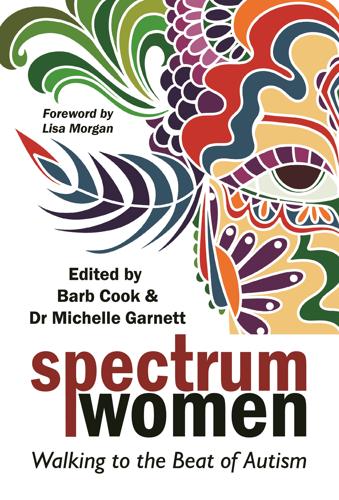
Spectrum Women: Walking to the Beat of Autism
by
Barb Cook
and
Samantha Craft
Published 20 Aug 2018
The girl or woman on the spectrum is her mind, her body, her heart, and her spirit; through all these mediums she expresses her unique self, her personality. One of the underlying reasons that women on the spectrum struggle with a sense of identity, or expression of personality, is their problems with innate and unthinking perspective taking, or “theory of mind,” that are part of the condition. It follows, and there is research to back this, that if one has difficulty understanding another’s mind, that person will also have difficulty understanding their own mind. Self-reflection is difficult for a person on the autism spectrum. Often the person knows themselves, their thoughts, and their feelings only in action (including in being), by expressing themselves through writing, talking, drawing, painting, dancing, theater, playing music, doing yoga, meditating, playing sport, being in nature, etc.
…
I have this overwhelming need to pull apart, twist, and rephrase words and subtle nuances all the time, but especially when my thinking gets crumbly by rushes of concern or compassion. My intuition gets squeezed into a dusty corner, making it incredibly difficult for me to decide if I’ve been insulted or slighted or attacked. Add in a rather weak “theory of mind,” and all at once I’m a perfect target for emotional abusers, especially those who like to make paper cuts instead of chainsaw-sized wounds. From the subtle to the brazen, emotional abuse can come at you through a myriad of ways including (but sadly not limited to): • broken promises, vows, or agreements • unequal workloads that leave you bearing most chores or responsibilities, or that force you to handle work you can’t do or truly dislike doing • isolation that keeps you from other friends, co-workers, peers, neighbors—anyone or anything that would give you happiness or independence • mind games such as convincing you that your feelings are delusional or your instincts are outlandish (gaslighting) • humiliation of any kind • disrespect or contempt for your values or lifestyle • threats and extortions • condemnation of your looks or clothing, or criticism of your skill sets or intelligence.
…
Spectrumites are notorious for taking things literally. We almost always take things at face value. I have become more practiced at not falling victim to these blunders through the years. Though, to this day, I have fallen for every “made ya look” joke ever made at my expense. Joking aside, our struggles with “theory of mind” and literal thinking color our communication skill set. Filtering for sarcasm, irony, metaphors, and figures of speech is another layer added to our communication struggles. It colors how we receive communication, how we process it, and how we return it. Oh, to think of all the jokes that have fallen flat on my spectrum ear, not to mention the attempts of mine that have missed their targets—so many of them the result of my literal mind.

The Myth of Artificial Intelligence: Why Computers Can't Think the Way We Do
by
Erik J. Larson
Published 5 Apr 2021
While Skinner’s theory of operant conditioning, or “behaviorism,” as it came to be called, was widely disputed later in the twentieth century, the interdisciplinary “cognitive revolution” that replaced it treated intelligence as merely internal computations. This idea, underpinned by a philosophy called the “computational theory of mind,” which claims that the human mind is an information processing system, still underwrites theoretical confidence in the eventual triumph of AI. Here, it’s best to be clear: equating a mind with a computer is not scientific, it’s philosophical. THE FOLLY OF PREDICTION As Stuart Russell points out, in the quest for artificial intelligence, we shouldn’t bet against “human ingenuity.”2 But in a similar vein we shouldn’t make hopeful (or dire) predictions without a sound scientific basis.
…
KURZWEIL’S HIERARCHICAL-PATTERN RECOGNITION THEORY The hierarchical nature of the neocortex has also been noted by Ray Kurzweil, who writes in his 2012 How to Create a Mind that “the neocortex is responsible for dealing with our ability to deal with patterns and to do so in a hierarchical fashion. Animals without a neocortex (basically non-mammals) are largely incapable of understanding hierarchies.”2 Kurzweil credits his own hierarchical theory, which he calls the pattern recognition theory of mind, as working off accepted neuroscience findings on the structure and function of the human neocortex, and also off progenitors like Hawkins’s own hierarchical account. The hierarchical structure of the neocortex is indeed well-founded neuroscience. The columnar organization of the neocortex was first discovered by American neuroscientist Vernon Mountcastle in 1957.
…
Jeff Hawkins, On Intelligence: How a New Understanding of the Brain Will Lead to the Creation of Truly Intelligent Machines (New York: St. Martin’s Griffin, 2005). 2. Ray Kurzweil, How to Create a Mind: The Secret of Human Thought Revealed (New York: Penguin Books, 2013), 35. 3. Gary Marcus, “Ray Kurzweil’s Dubious New Theory of Mind,” New Yorker, November 15, 2012. 4. Ibid. 5. For a general description, see Ferris Jabr, “Memory May be Built with Standard Building Blocks,” New Scientist, March 17, 2011. 6. Henry Markram and Rodrigo Perin, “Innate Neural Assemblies for Lego Memory,” Frontiers in Neural Circuits 5 (2011): 6. 7.
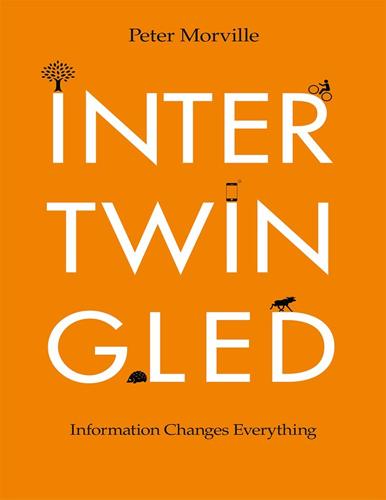
Intertwingled: Information Changes Everything
by
Peter Morville
Published 14 May 2014
While we may have inherited the mind/body dualism of our favorite reductionist, René Descartes, who concluded the mind (or soul) can exist without the body, we need not stay bound by what Gilbert Ryle called “the ghost in the machine.”xxiv In recent decades, the countervailing framework of embodied cognition has built momentum with respect to empirical research. This thesis holds that the nature of the mind is largely determined by the form of the body. Unlike computationalism, which views the brain as a central processing unit with inputs (sensory) and outputs (control), this theory of mind recognizes that how and what we think is shaped by the body’s systems of perception, action, and emotion. Our bodies constrain the nature and content of our thoughts, and cognitive processing is distributed beyond our brains. In short, cognition isn’t just in the head. Figure 2-1. Embodied cognition.
…
Anticipation is behind all we think and do. In the words of Jeff Hawkins, “Prediction is not just one of the things your brain does. It is the primary function of the neocortex and the foundation of intelligence.”lxxvi It’s impossible not to predict the future, yet we get it wrong all the time. We use our “theory of mind” to anticipate the actions and reactions of colleagues and customers, but people are full of surprises. Experiments help, but induction has its limits. Even minimum viable products can’t predict the long now at scale. Inevitably we must move forward, often at a fast clip, but it pays to be aware of error even as we race along.
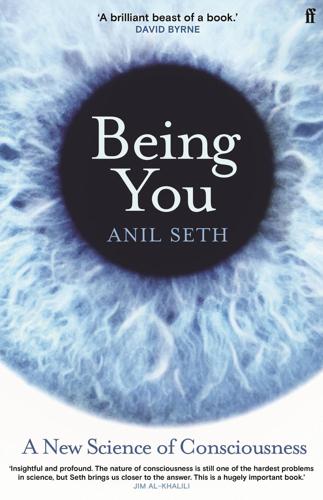
Being You: A New Science of Consciousness
by
Anil Seth
Published 29 Aug 2021
This ability – sometimes called ‘theory of mind’ – is often thought to develop rather slowly in humans, but it comes to play a key role for almost all of us throughout our lives. At times we can be acutely aware of this, for example when we are worrying what a partner, friend, or colleague may be thinking about us. But even when we aren’t ruminating on our social interactions, our ability to perceive others’ intentions, beliefs, and desires is always operating in the background, guiding our behaviour and shaping our emotions. There is a vast literature on social perception and theory of mind, encompassing psychology, sociology, and more recently the emerging field of social neuroscience.
…
Our idea is that others’ mental states seem ‘real’ to the extent that our brain encodes a rich repertoire of conditional predictions about how they may change given this-or-that action. For example, such a prediction may be about how someone’s belief or emotional state would change given a particular utterance (like ‘go get me some wine’). This idea provides a prediction machine gloss on what it means to have a theory of mind, and it may provide a useful way of interpreting apparent deficits in social perception, as happens for example in autism. See C. J. Palmer et al. (2015). socially nested predictive perceptions: Neuroscientific discussions of social perception often highlight so-called ‘mirror neurons’. These neurons – first discovered in monkey brains by the Italian neuroscientist Giacomo Rizzolatti and his colleagues – fire away both when an animal acts, and when it observes the same action performed by another animal (Gallese et al., 1996).
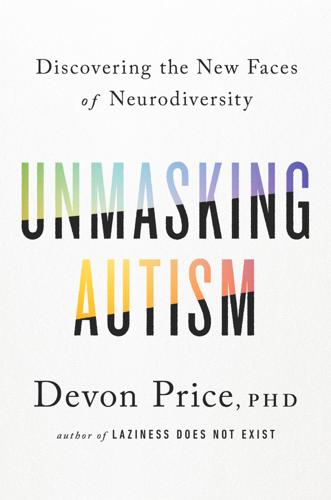
Unmasking Autism: Discovering the New Faces of Neurodiversity
by
Devon Price
Published 4 Apr 2022
BACK TO NOTE REFERENCE 7 Some people who otherwise exhibit Autism spectrum traits and report Autistic cognitive challenges do not exhibit social or behavioral signs, due to camoflauging of symptoms: L. A. Livingston, B. Carr, & P. Shah. (2019). Recent advances and new directions in measuring theory of mind in autistic adults. Journal of Autism and Developmental Disorders, 49, 1738–1744. BACK TO NOTE REFERENCE 8 Thapar, A., & Rutter, M. (2020). Genetic advances in autism. Journal of Autism and Developmental Disorders, 1–12. BACK TO NOTE REFERENCE 9 Gernsbacher, M.
…
BACK TO NOTE REFERENCE 4 J Parish-Morris, J., MY Lieberman, M. Y., Cieri, C., et al. (2017). Linguistic camouflage in girls with autism spectrum disorder. Molecular Autism, 8, 48. BACK TO NOTE REFERENCE 5 Livingston, L. A., Colvert, E., Social Relationships Study Team, Bolton, P., & Happé, F. (2019). Good social skills despite poor theory of mind: Exploring compensation in autism spectrum disorder. Journal of Child Psychology and Psychiatry, 60, 102. BACK TO NOTE REFERENCE 6 Cage, E., & Troxell-Whitman, Z. (2019). Understanding the reasons, contexts and costs of camouflaging for autistic adults. Journal of Autism and Developmental Disorders, 49, 1899–1911.
…
BACK TO NOTE REFERENCE 28 Zalla, T., & Sperduti, M. (2015). The sense of agency in autism spectrum disorders: A dissociation between prospective and retrospective mechanisms? Frontiers in Psychology, 6, 1278. BACK TO NOTE REFERENCE 29 Zalla, T., Miele, D., Leboyer, M., & Metcalfe, J. (2015). Metacognition of agency and theory of mind in adults with high functioning autism. Consciousness and Cognition, 31, 126–138. doi:10.1016/j.concog.2014.11.001. BACK TO NOTE REFERENCE 30 Schauder, K. B., Mash, L. E., Bryant, L. K., & Cascio, C. J. (2015). Interoceptive ability and body awareness in autism spectrum disorder.
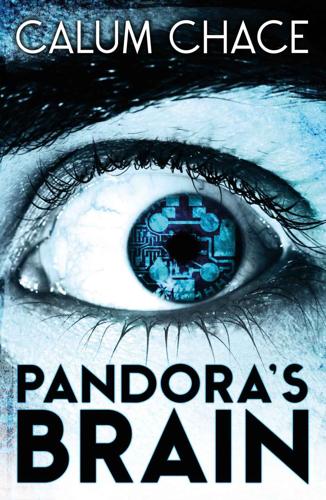
Pandora's Brain
by
Calum Chace
Published 4 Feb 2014
I really want to spend some time over there exploring them.’ Carl grinned. ‘Well, I hope that one day you do.’ Carl’s resolve to get back to work was unconvincing, so Matt launched another topic of conversation. ‘So what’s the homework?’ ‘I’ve got to write a paper for the start of next term about personal identity and the theory of mind. I have to decide whether I think that personal identity is maintained over time and whether there really is any such thing as a ‘self’. A lot of philosophers use thought experiments to help draw out their intuitions, and I get rather distracted by discussions of artificial intelligence and brains in vats.
…
If they can’t model that, what chance is there of modelling a human brain, with a hundred billion neurons?’ Carl shook his head. ‘The computer scientists at Google and the rest of Silicon Valley think they can just build an analogue of a brain and that’s it – job done. But in reality that’s not even half the job. They haven’t got an adequate theory of mind, and there’s a little thing called psychology which they’ve completely forgotten about.’ He tapped the side of his head. ‘This took millions of years to evolve. It’s madness to think it can be replicated in a few years just because we have machines that can run a video game.’ ‘Well of course you may be right,’ Matt conceded.
…
The more we find out about the universe, the more we discover it to be a fascinatingly challenging and weird place. The more we know, the more we know we don’t know. So I don’t believe that our descendents will run out of things to explore. In fact you may be interested to know that there is a nascent branch of philosophy – a sub-branch of the Theory of Mind, you might say – called the Theory of Fun, which addresses these concerns.’ ‘As for over-population,’ Montaubon chipped in, ‘there is a very big universe to explore out there, and we now know that planets are positively commonplace. It won’t be explored by flesh-and-blood humans as shown in Star Trek and Star Wars: that idea is absurd.
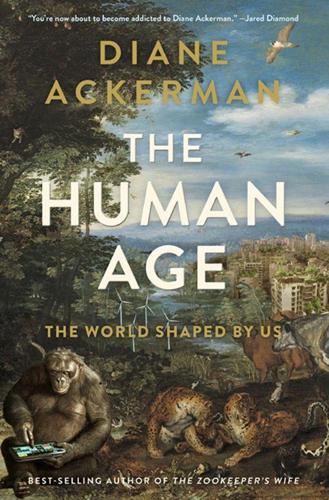
The Human Age: The World Shaped by Us
by
Diane Ackerman
Published 9 Sep 2014
Some other animals—orangutans and other cousins of ours, dolphins and octopuses, and some birds—are also self-aware. A wily jay might choose to cache a seed more quietly because other jays are nearby and it doesn’t want the treasure stolen; an octopus might take the lid off its habitat at night to go for a stroll and then replace the lid when it returns lest its keepers find out. They possess a theory of mind, and can intuit what a rival might do in a given situation and act accordingly. They exhibit deceit, compassion, the ability to see themselves through another’s eyes. Chimpanzees feel deeply, strategize, plan, think abstractly to a surprising degree, mourn, empathize some, deceive, seduce, and are all too conscious of life’s pressures, if not its chastening illusions.
…
Futurologists like Ray Kurzweil believe, as Lipson does, that a race of conscious robots, far smarter than we, will inhabit Earth’s near-future days, taking over everything from industry, education, and transportation to engineering, medicine, and sales. They already have a foot in the door. At the 2013 Living Machines Conference, in London, the European RobotCub Consortium introduced their iCub, a robot that has naturally evolved a theory of mind, an important milestone that develops in children at around the age of three or four. Standing about three feet tall, with a bulbous head and pearly white face, programmed to walk and crawl like a child, it engages the world with humanlike limbs and joints, sensitive fingertips, stereo vision, sharp ears, and an autobiographical memory that’s split like ours into the episodic memory of, say, skating on a frozen pond as a child and the semantic memory of how to tilt the skate blades on edge for a skidding stop.
…
F., 145 sky parks, 77–78 skyskrapers, 24 Smit, Johan, 104 Smith, Bren, 56–67 Smith, David, 291 Smithsonian, 235 Smithsonian National Museum of American History, 145 snails, 61, 156, 157–60, 163 snowfall, 41 snow leopards, 164 social media, 190, 235 social pain, 177 Soda Cell, 100 solar power, 51–52, 83, 100, 105–7 solar water farming, 52 sonar, 316 Songdo, South Korea, 230 South Carolina, 46 Southeastern Pennsylvania Transportation Authority, 102 South Korea, 72 Space Exploration Vehicle, 235 Space Station, 16 space travel, 15–16 Spain, 78, 124 spas, 185 Speak, Memory (Nabokov), 218 Spears, Britney, 129–30 sperm, 160–61, 279 Spielberg, Steven, 142 spinach, 89 Spitsbergen, 154–55 squids, 164 squirrel monkeys, 131 squirrels, 126 Stahel, Walter R., 87 Stanley Park, 78 starlings, 153, 165–66 Star Trek, 232, 253, 260 Statue of Liberty, 59 steam engine, 34 Steel Pier, 47 stem cells, 13, 150 Stockholm, 96–97 Stoermer, Eugene, 313 stomata, 91 Stony Creek harbor, 56–57, 66–67 storks, 124 Strauss, Richard, 269 suburban sprawl, 116 succulents, 83 sugar, 239 Suharto, 313 sulfur, 99 Summit, Scott, 236–37 sustainability, popularity of, 108 Sustainability Revolution, The (Edwards), 88 Svalbard Global Seed Vault, 154–55 Svensson, Tore, 101 Sweden, 96–97, 98–101, 106, 132 Swiss chard, 89, 90 Switzerland, 78, 132 swordfish, 65 sycamores, 111, 113 SyNAPSE, 256, 318 Taft, William Howard, 58 Tahiti, 159 Taiwan, 83 Taliban, 146 Tasmanian devils, 151, 164 taste, 211–12 Taylor, Robert, 89 technical nutrients, 87 technology, 10, 13–14 nature and, 188–200 Technology University, 104 Teitiota, Ioane, 49 Tel Aviv University, 293 telekenesis, 203 telephones, 171 telescopes, 171 televisions, 87, 191 temperate zones, 80 Tennessee, 46 termites, 92–93 Texas, 41 texting, 190 by plants, 205–7 Thailand, 79, 180 Thames Barrier, 50–51 theory of mind, 216–17, 218–19 Thimble Islands, 58 Thimble Island Salts, 62 “Thousand Dreams of Stellavista, The” (Ballard), 231 3D printing, 232–39, 244 Three Gorges Dam, 101 Thumb, Tom, 58 Thus Spake Zarathustra, 269–70 thyme, 90 Tiananmen Square, 271 tiger mosquitos, 132 time-rock, 32–33 titanium dioxide, 181 toads, 125 Tohoku, 46 Tokyo, 78 tomatoes, 89 Tom Jones (film), 294 Tonga, 158 tools, 171 human use of, 7, 9 orangutan use of, 5 tornadoes, 41 Toronto, Canada, 78 touch, 178 “Town Mouse and the Country Mouse, The” (Aesop), 115 Toxoplasma gondii, 296–99 trains, 102 transparent aluminum, 34 tree lizards, 80 trees, 83 trilobites, 29–30 trumpeter swans, 135 tube worms, 37–38 TU Delft, 104, 105 tuna, 65 Tushi, 272 Tuvalu, 48–49 23andMe, 271 twins, 282 Twitter, 317 2001: A Space Odyssey (film), 269–70 Tybee Island Ocean Rescue, 65 typewriter, 191 typhoons, 46 Uganda, 72 United Kingdom, 83, 298 cities in, 72 United Nations Conference on the Human Environment, 99 United Nations Panel on Climate Change, 41–42 United States, 83 urban beekeeping, 88 urban eyes, 192 urbanization, 154 U.S.
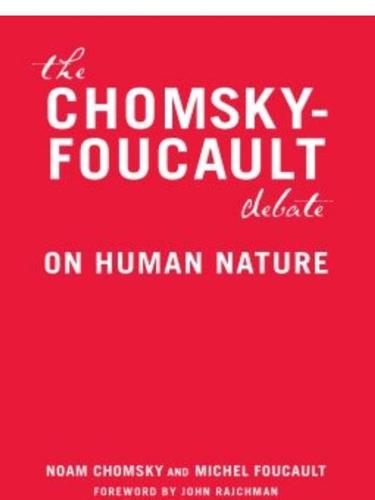
The Chomsky-Foucault Debate: On Human Nature
by
Noam Chomsky
and
Michel Foucault
Published 1 Jan 1974
Now Descartes, I think, made a similar intellectual move in postulating a second substance. Of course he failed where Newton succeeded; that is, he was unable to lay the ground-works for a mathematical theory of mind, as achieved by Newton and his followers, which laid the groundwork for a mathematical theory of physical entities that incorporated such occult notions as action at a distance and later electro-magnetic forces and so on. But then that poses for us, I think, the task of carrying on and developing this, if you like, mathematical theory of mind; by that I simply mean a precisely articulated, clearly formulated, abstract theory which will have empirical consequences, which will let us know whether the theory is right or wrong, or on the wrong track or the right track, and at the same time will have the properties of mathematical science, that is, the properties of rigor and precision and a structure that makes it possible for us to deduce conclusions from assumptions and so on.

Rethinking Narcissism: The Bad---And Surprising Good---About Feeling Special
by
Dr. Craig Malkin
Published 6 Jul 2015
Journal of Child Language, 2011, vol. 38(5), pp. 1124–39. Gelb, C. M. The Relationship Between Empathy and Attachment in the Adolescent Population. Dissertation Abstracts International: Section B: The Sciences and Engineering, 2002, vol. 62(9-B), p. 4252. Goldstein, T. R., and E. Winner. Enhancing empathy and theory of mind. Journal of Cognition and Development, 2012, vol. 13(1), pp. 19–37. Henry, C. S., and L. Hubbs-Tait. New directions in authoritative parenting. In Authoritative Parenting: Synthesizing nurturance and discipline for optimal child development, R. E. Larzelere, A. S. Morris, A. W. Harrist, editors, pp. 237–64.
…
J. Park. Deconstructing the myth of the “tiger mother”: An introduction to the special issue on tiger parenting, Asian-heritage families, and child/adolescent well-being. Asian American Journal of Psychology, 2013, vol. 4(1), p 1. Kidd, D. C., and E. Castano. Reading literary fiction improves theory of mind. Science, 2013, vol. 342(6156), pp. 377–80. Kim, S. Y., Y. Wang, D. Orozco-Lapray, Y. Shen, and M. Murtuza. Does “Tiger Parenting” Exist? Parenting profiles of Chinese Americans and adolescent developmental outcomes. Asian American Journal of Psychology, 2013, vol. 4(1), pp. 7–18. Maccoby, E.
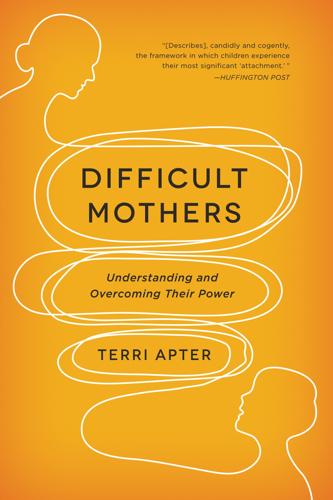
Difficult Mothers: Understanding and Overcoming Their Power
by
Terri Apter
Published 6 May 2012
“Foundations for Developing a Concept of Self: The Role of Imitation in Relating to Self and Others and the Value of Social Mirroring, Social Modelling, and Self Practice in Infancy.” In The Self in Transition: Infancy to Childhood, D. Cicchetti and M. Beeghly, eds. Chicago: University of Chicago Press, 1990, pp. 139–62. Meltzoff, A. N., and A. Gopnik. “The Role of Imitation in Understanding Persons and Developing a Theory of Mind.” In Understanding Other Minds: Perspectives from Autism, S. Baron-Cohen, H. Tager-Flusberg, and D. J. Cohen, eds. New York: Oxford University Press, 1993, pp. 335–66. Miller, Alice. For Your Own Good: Hidden Cruelty in Child-Rearing and the Roots of Violence. H. Hannun and H. Hannum, trans.
…
Parents and Adolescents: Living Together, Part 1, The Basics. Eugene, OR: Castalia Publishing Company, 1987. Piaget, Jean. Play, Dreams and Imitation in Childhood. New York: W. W. Norton, 1962. Pinter, Steven. How the Mind Works. New York: W. W. Norton, 1997. Povinelli, D. J., and T. M. Preuss. “Theory of Mind: Evolutionary History of a Cognitive Specialization.” Trends in Neurosciences 18 (1995): 418–24. Rappoport, A. “Co-Narcissism: How We Accommodate to Narcissistic Parents.” The Therapist, 2005. www.alanrappoport.com/pdf/Co-Narcissism%20Article.pdf. Rehm, Diane. Finding My Voice. New York: Alfred A.
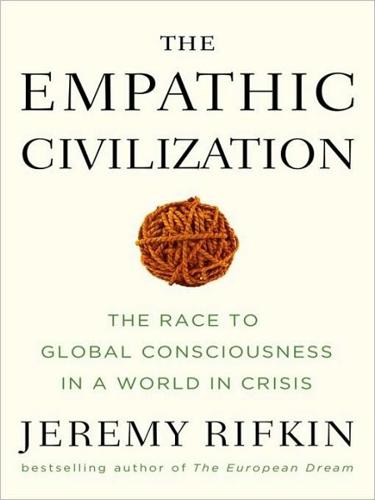
The Empathic Civilization: The Race to Global Consciousness in a World in Crisis
by
Jeremy Rifkin
Published 31 Dec 2009
They simply don’t know that the image in the mirror is their own. While only a few species pass the mirror test for self- identity and despite the fact that mirror neuron systems, to date, have been found in only a few species—most species have not yet been studied—experiments show that many species demonstrate in their behavior that they possess theory of mind.19 Experiments conducted by Brian Hare of Harvard University and Michael Tomasello of the Max Planck Institute for Evolutionary Anthropology in Leipzig showed that “domestic dogs understand what is meant when a human being points at something (as in ‘the food’s under this one!’).”20 While we take for granted that when one person points to an object, another knows how to look over at it, for a dog to do the same, he needs to know that “your movements aren’t about your arm and hand but about the mind that drives them.”21 That recognition requires that the dog be able to read the person’s mind and understand their intention in making the gesture.
…
20 While we take for granted that when one person points to an object, another knows how to look over at it, for a dog to do the same, he needs to know that “your movements aren’t about your arm and hand but about the mind that drives them.”21 That recognition requires that the dog be able to read the person’s mind and understand their intention in making the gesture. In other words, he must have a theory of mind. Some animal species even understand the idea of fairness, which requires a sophisticated awareness of oneself in relationship to another. Anthropologist Sarah Brosnan at Emory University coordinated several experiments in which monkeys were taught to exchange a “token” with a trainer in return for food.
…
New developments in psychology and cognitive science are laying the groundwork for a wholesale reappraisal of human consciousness. The premodern notion that faith and God’s grace are the windows to reality and the Enlightenment idea that reason is at the apex of modern consciousness are giving way to a more sophisticated approach to a theory of mind. Researchers in a diverse range of fields and disciplines are beginning to reprioritize some of the critical features of faith and reason within the context of a broader empathic consciousness. They argue that all of human activity is embodied experience—that is, participation with the other—and that the ability to read and respond to another person “as if ” he or she were oneself is the key to how human beings engage the world, create individual identity, develop language, learn to reason, become social, establish cultural narratives, and define reality and existence.

Glasshouse
by
Charles Stross
Published 14 Jun 2006
We may be living in a glass jar with bright lights and monitors trained on us the whole time, but it's not likely that everything we do is being watched by a live human being in real time. We massively outnumber the experimenters, and they're primarily interested in our public socialization. (At least, that's the official story.) To monitor an intelligent organism properly requires observers with a theory of mind at least as strong as the subject. We subjects outnumber the experimenters by a couple of orders of magnitude, and I've seen no sign of strongly superhuman metaintelligences being involved in this operation, so I think the odds are on my side. If we are up against the weakly godlike, I might as well throw in the towel right now.
…
I'm in a stable family relationship with three other core partners, plus various occasional liaisons with five or six fuckbuddies. We're fully bisexual, either naturally or via a limbic system mod copied from bonobos. My family has two children, and we're thinking about starting another two in half a gig or so. I'm also lucky enough to have a vocation, researching the history of the theory of mind—an aspect of cultural ideology that only became important after the Acceleration, and which goes in and out of fashion, but which I hold to be critically important. The history of my field, for example, tells us that for almost a gigasecond during the old-style twenty-third century, most of humanity-in-exile were zimboes, quasi-conscious drones operating under the aegis of an overmind.
…
It's not just my arms and legs—all my joints are screaming at me in chorus with a whole load of muscles I wish I didn't have right now—but my head's throbbing and I feel like I'm freezing to death and my stomach's not so good either. And the blackouts and memory fugues are still with me. "What's wrong with, me?" I ask, and it takes a big effort to get the words out. "You are ill," the zombie repeats. It's useless arguing with her—nobody home, no theory of mind, just a bunch of reflexes and canned dialogues. "Who can I ask?" She's turning away, but I seem to have tripped a new response. "The consultant will visit at eight o'clock tonight, all questions must be addressed to the consultant. The patient is weak and must not be disturbed excessively.
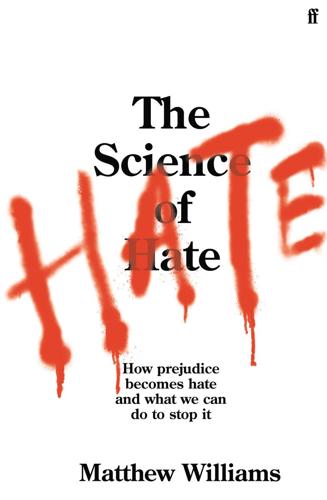
The Science of Hate: How Prejudice Becomes Hate and What We Can Do to Stop It
by
Matthew Williams
Published 23 Mar 2021
A lack of emotional empathy – resistance to sharing the feelings of another – stems from unwillingness to engage in cognitive empathy – refusal to see the situation from the perspective of ‘them’. Psychologists have technical terms for similar phenomena. The process of mentalising involves imagining what it is like to be ‘them’, emotionally. Having theory of mind means being able to comprehend another’s beliefs, intentions and persuasions. Both of these types of empathy are less likely to emerge when the ingroup rarely has contact with the outgroup. Conversely, positive contact can inspire empathy, and in turn reduce hate.26 But in the absence of one or both of these forms of empathy, compassion is unlikely to arise, allowing negative stereotypes to intensify to a point where entire groups are depersonalised.
…
The first three categories, superhuman Olympic athletes, elderly and disabled people and the filthy rich, only activated the prefrontal cortex. As well as its previously discussed roles, this area kicks into action when we think about a person. Imagining what it is like to be them, emotionally and in terms of their beliefs, intentions and persuasions (known in psychology as mentalising and theory of mind, respectively), informs our decisions about them. To grossly oversimply again: when the prefrontal cortex activates, subjects are empathising and hence humanising. The final category, the homeless drug addicts, activated the insula and amygdala but not the prefrontal cortex. For the so-called lowest of the low, there was no empathising or humanising; quite the opposite – disgust, dehumanising and a sense of threat.
…
W., 1n suffering, 1, 2 suicide attacks, 1, 2, 3, 4n, 5, 6 superconducting quantum interference devices (SQUIDs), 1, 2 superordinate goal, 1 superordinate ingroup, 1, 2 suppression mechanism, 1, 2, 3 surveys, 1, 2 survival, 1, 2, 3, 4, 5, 6, 7, 8, 9 Sutcliffe, Peter, 1 Sweden, 1 symbolic threats, 1, 2, 3, 4, 5 synagogues, 1 Syria, 1, 2, 3, 4 systemic bias, 1 Tajfel, Henri, 1 Tarrant, Brenton, 1, 2, 3 Tay (chatbot), 1, 2, 3 Taylor, Breonna, 1 Tbilisi, 1 tech giants, 1, 2, 3, 4, 5, 6 technology, 1, 2, 3 Telegram, 1, 2 television, 1, 2, 3, 4, 5, 6, 7 terror, 1, 2, 3, 4, 5 terrorism: events that remind us of our mortality, 1; far-right hate, 1, 2; feeling hate together, 1; Google searches, 1; group threat, 1, 2, 3; hate counts, 1, 2; Kansas shooting, 1; online hate speech, 1, 2, 3, 4, 5; predicting hate crime, 1; profiling the hater, 1; religion versus hate, 1; steps to stop hate, 1, 2; subcultures of hate, 1, 2, 3, 4, 5n, 6; trauma and containment, 1, 2; trigger events, 1, 2, 3, 4, 5, 6, 7; YouTube algorithms, 1 The Terrorist’s Handbook, 1 Terror Management Theory (TMT), 1, 2, 3, 4, 5, 6 Tétouan, 1 Texas, 1, 2, 3, 4 Thaipoosam Cavadee (Hindu festival), 1 Thatcher, Margaret, 1, 2 theory of mind, 1, 2 Thomas, Daniel, 1 ‘thoughtcrime’, 1 threats: author’s brain and hate, 1, 2, 3, 4; beyond threat, 1; brain and hate, 1, 2, 3, 4, 5, 6, 7; context and threat, 1; cultural machine, group threat and stereotypes, 1; defence mechanisms, 1; disengaging the amygdala autopilot, 1; evolution of group threat detection, 1; feeling hate together, 1; fusiform face area, 1; group threat and hate, 1; hacking the brain to hate, 1; hate and feeling pain, 1; human biology and threat, 1; locating hate in the brain, 1; neutralising the perception of threat, 1; online hate speech, 1, 2, 3, 4; parts that edge us towards hate, 1; parts that process prejudice, 1; predicting hate crime, 1; prepared versus learned amygdala responses, 1; processing of ‘gut-deep’ hate, 1; recognising facial expressions, 1; religion versus hate, 1; society, competition and threat, 1; steps to stop hate, 1, 2, 3; subcultures of hate, 1, 2, 3; threat in their own words, 1; tipping point, 1; unlearning prejudiced threat detection, 1 thrill-seeking offenders, 1 TikTok, 1 Till Death Us Do Part, 1 tipping point: author’s experience effects, 1; identity fusion and hateful murder, 1; overview, 1, 2; predicting the next hate crime, 1; seven steps to stop hate, 1; tipping point from prejudice to hate, 1 TMT, see Terror Management Theory Tokyo, 1n tolerance: filter bubbles and bias, 1; group threat, 1, 2; religion versus hate, 1, 2; steps to stop hate, 1, 2, 3, 4, 5; white flight, 1 torcidas organizadas (football hooligans), 1 trackers, 1 transgender people, 1, 2n, 3, 4 translation, 1 trauma: the ‘average’ hate criminal, 1; group threat, 1; hate as container of unresolved trauma, 1; hate speech harm, 1; overview, 1; predicting hate crime, 1; prepared versus learned amygdala responses, 1; subcultures of hate, 1, 2, 3; tipping point, 1, 2; understanding the ‘exceptional’ hate offender, 1, 2, 3 tribes, 1, 2n, 3, 4, 5, 6 trigger events, 1; events and hate online, 1; events and hate on the streets, 1; events that challenge our values, 1; events that remind us of our mortality, 1; micro-events and hate, 1; online hate speech, 1, 2, 3, 4; our psychology and trigger events, 1; overview, 1; predicting hate crime, 1; religion versus hate, 1; trauma and containment, 1; uncovering the triggers of hate, 1 trolls, 1, 2n Trump, Donald: Cambridge Analytica, 1; Charlottesville rally, 1; ‘Chinese virus’, 1, 2; far-right hate, 1, 2, 3, 4, 5, 6; hate counts, 1, 2, 3; Kansas shooting, 1, 2, 3; and Mexicans, 1, 2, 3; and Muslims, 1, 2, 3, 4n, 5, 6n; police and race, 1; trigger event of election, 1; Twitter, 1, 2, 3, 4; YouTube algorithms, 1 trust, 1, 2, 3 Tsorionov, Dmitry ‘Enteo’, 1, 2 Tunisia attacks, 1 Turks, 1, 2 The Turner Diaries, 1 twins, 1 Twitter: far-right hate, 1, 2, 3, 4; filter bubbles and bias, 1; how much online hate speech, 1, 2; Japan care home attack, 1; online hate speech and social media companies, 1; online hate speech and the law, 1, 2; rise of the bots and trolls, 1, 2; Salah effect, 1; trigger events, 1, 2; Trump, 1, 2, 3, 4; why online hate speech hurts, 1 Uematsu, Satoshi, 1, 2, 3 UKIP, see United Kingdom Independence Party ultra groups, 1 ultrasound, 1n uncertainty, 1, 2, 3, 4 unconscious bias, 1, 2, 3, 4, 5 unemployment, 1, 2, 3, 4, 5, 6, 7, 8, 9 United Kingdom (UK): Copeland nail bombing, 1; COVID-19 pandemic, 1; cultural machine, 1, 2; Duggan shooting and riots, 1; extreme filter bubbles, 1; football fans, 1; group threat, 1, 2, 3, 4, 5; hate counts, 1, 2, 3, 4, 5, 6, 7; hate speech harm, 1; how much online hate speech, 1, 2, 3, 4, 5; online hate speech prevention, 1, 2, 3; online news, 1; protections from hate, 1; Sophie Lancaster, 1; trauma and containment, 1, 2; trigger events, 1, 2, 3, 4, 5 United Kingdom Independence Party (UKIP), 1, 2n, 3, 4 United Nations, 1, 2 United States (US): Charlottesville rally, 1, 2, 3n, 4; cultural machine, 1, 2, 3; far-right hate, 1, 2, 3, 4, 5, 6; Google searches, 1; group threat, 1, 2, 3, 4; hate counts, 1, 2, 3; housing projects, 1; Jim Crow era, 1; Kansas shooting, 1; Muslims ban, 1, 2n; office workers, 1; online hate speech, 1, 2, 3, 4, 5, 6; online news, 1; police and hate, 1; pyramid of hate, 1; steps to stop hate, 1; subcultures of hate, 1, 2; trauma and Franklin, 1; trigger events, 1, 2, 3, 4, 5, 6, 7, 8 Unite the Right, 1, 2 University of Toronto’s Behavioural Research Lab, 1, 2 University of Virginia, 1 uptake of post, 1 ‘us’ and ‘them’: brain and hate, 1, 2, 3, 4; group threat, 1, 2, 3, 4; HateLab Brexit study, 1; religion versus hate, 1; subcultures of hate, 1; tipping point, 1; what it means to hate, 1, 2, 3 vaccination, 1 values, 1, 2, 3, 4 Van Bavel, Jay, 1n, 2 vandalism, 1 Vaughn, James Clayton, Jr, see Franklin, Joseph Paul ventromedial prefrontal cortex (vmPFC), 1, 2 victimisation, 1, 2, 3, 4, 5 victims, 1, 2, 3, 4, 5, 6, 7, 8 video content, 1, 2 Vidgen, Bertram, 1, 2 Vietnam War, 1 violence: brain and hate, 1, 2, 3, 4; far-right hate, 1, 2, 3, 4, 5; group threat, 1, 2, 3, 4, 5; online hate speech, 1; police bias, 1; steps to stop hate, 1; subcultures of hate, 1, 2, 3, 4, 5, 6, 7; trauma and containment, 1, 2, 3, 4, 5, 6, 7, 8; what it means to hate, 1, 2, 3, 4, 5, 6 VKontakte, 1 vmPFC, see ventromedial prefrontal cortex Voat, 1, 2 Vorherrschaft Division, 1 Vote Leave campaign, 1 voting, 1, 2 vulnerability, 1, 2, 3, 4 Wallace, Hunter, 1 Wall Street Journal, 1 Walmart shooting, 1 war, 1n, 2, 3 War of Independence, 1 warrior psychology, 1 washing, 1 Washington Post, 1 Waterfield, Peter, 1, 2 Watson, Paul Joseph, 1, 2, 3 webpage content, 1 Weibo, 1 WEIRD societies (Western, Educated, Industrialised, Rich and Democratic), 1 Weizenbaum, Joseph, 1 Westminster attack, 1, 2, 3 West Yorkshire, 1, 2, 3 white flight, 1, 2 Whitehouse, Harvey, 1 white matter, 1, 2 white nationalism, 1, 2 white people: far-right hate, 1, 2; Google searches, 1; steps to stop hate, 1, 2, 3, 4; subcultures of hate, 1, 2; trauma and containment, 1, 2; trigger events, 1, 2, 3, 4 white supremacists: far-right hate and Charlottesville, 1, 2, 3, 4; Google searches, 1; predicting hate crime, 1; subcultures of hate, 1, 2; trauma and Franklin, 1, 2; trigger events, 1, 2 Whitman, Charles, 1 Will & Grace, 1, 2 Wilson, Timothy, 1 witnesses, 1, 2, 3, 4, 5, 6 women, 1, 2, 3, 4, 5, 6, 7, 8 Woolwich terror attack, 1, 2 working class, 1, 2 World Health Organisation, 1 World Trade Center (WTC), 1, 2, 3 xenophobia, 1, 2, 3, 4, 5, 6 Xiaoice (chatbot), 1 Xu, Professor, 1 Yaxley-Lennon, Stephen (Tommy Robinson), 1, 2, 3, 4 Yiannopoulos, Milo, 1, 2 Yorkshire, 1, 2, 3, 4 young people, 1, 2, 3, 4, 5, 6, 7 YouTube: algorithms, 1; far-right hate and Charlottesville, 1, 2, 3; filter bubbles, 1; online hate speech, 1, 2, 3, 4; Russia, 1 Zuckerberg, Mark 1 Vigil for Srinivas Kuchibhotla, who was murdered by Adam Purinton on 22 February 2017.
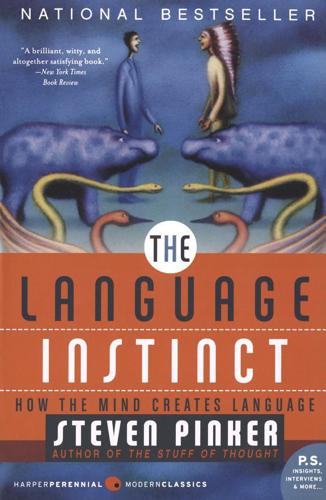
The Language Instinct: How the Mind Creates Language
by
Steven Pinker
Published 1 Jan 1994
Add an eye that can detect certain contours in the world and turn on representations that symbolize them, and muscles that can act on the world whenever certain representations symbolizing goals are turned on, and you have a behaving organism (or add a TV camera and set of levers and wheels, and you have a robot). This, in a nutshell, is the theory of thinking called “the physical symbol system hypothesis” or the “computational” or “representational” theory of mind. It is as fundamental to cognitive science as the cell doctrine is to biology and plate tectonics is to geology. Cognitive psychologists and neuroscientists are trying to figure out what kinds of representations and processors the brain has. But there are ground rules that must be followed at all times: no little men inside, and no peeking.
…
Baby thoughts: Spelke et al., 1992. Baby arithmetic: Wynn, 1992. Animal thinking: Gallistel, 1992. Monkey friends and relations: Cheney & Seyfarth, 1992. Visual thinkers: Shepard, 1978; Shepard & Cooper, 1982. Einstein: Kosslyn, 1983. Mind’s eye: Shepard & Cooper, 1982; Kosslyn, 1983; Pinker, 1985. Representational theory of mind: in Haugeland, 1981, articles by Haugeland, Newell & Simon, Pylyshyn, Dennett, Marr, Searle, Putnam, and Fodor; in Pinker and Mehler, 1988, articles by Fodor & Pylyshyn and Pinker & Prince; Jackendoff, 1987. English versus mentalese: Fodor, 1975; McDermott, 1981. Headlines: Columbia Journalism Review, 1980.
…
O., 147–152, 177, 396, 433–436 Race, 260–261, 447–448 Radner, G., 182 Rakic, P., 483 Raymond, E., 453, 454 Reading, PS 14, PS22–23 Reagan, R., 46, 101, 116, 123 Recursion, 93, 122–124, 126, 201–206, 291–292, 377, 380, PS21, glossary Reddy, R., 184 Redundancy, 178 Remez, R., 154 Renfrew, C., 255 Representational theory of mind, 64–73 Rodrigues, C., PS15 Rogers, C., 193 Rolling Stones, 183, 388 Rosch, E., 454 Rozin, P., 425 Ruhlen, M., 260–262 Rumbaugh, D., 350 Rumelhart, D., 454, 463 Russell, B., 47 Safire, W., 385, 402–412, PS21 Safran, E., 462 Sagan, C., 344 Sahin, N., PS18 Salinger, J. D., 391 San.

Architects of Intelligence
by
Martin Ford
Published 16 Nov 2018
It’s a manufacturing robot that’s designed to collaborate with humans on the assembly line, not to be roped off far from people but to work shoulder-to-shoulder with them. In order to do that, Baxter has got a face so that coworkers can anticipate, predict, and understand what the robot’s likely to do next. Its design is supporting our theory of mind so that we can collaborate with it. We can read those nonverbal cues in order to make those assessments and predictions, and so the robot has to support that human way of understanding so that we can dovetail our actions and our mental states with those of the machine, and vice versa. I would say Baxter is a social robot; it just happens to be a manufacturing social robot.
…
We don’t know how to build machines that have human-level common sense. We can build machines that can have knowledge and information within domains, but we don’t know how to do the kind of common sense we all take for granted. We don’t know how to build a machine with deep emotional intelligence. We don’t know how to build a machine that has a deep theory of mind. The list goes on. There’s a lot of science to be done, and in the process of trying to figure these things out we’re going to come to a deeper appreciation and understanding of how we are intelligent. MARTIN FORD: Let’s talk about some of the potential downsides, the risks and the things we should legitimately worry about.
…
That turned out to be very influential for both myself and others in terms of thinking about how to build systems that had a common-sense reasoning capacity—systems that really reasoned and didn’t just find patterns in data, and that could have abstractions that could generalize across many situations. We used these systems to capture, for example, people’s intuitive theory of mind—how we understand other people’s actions in terms of their beliefs and desires. Using these tools of probabilistic programs over the last ten years, we were able to build for the first time reasonable, quantitative, predictive, and conceptually correct models of how humans, even young children, understand what other people are doing, and see people’s actions not just as movements in the world, but rather as the expressions of rational plans.
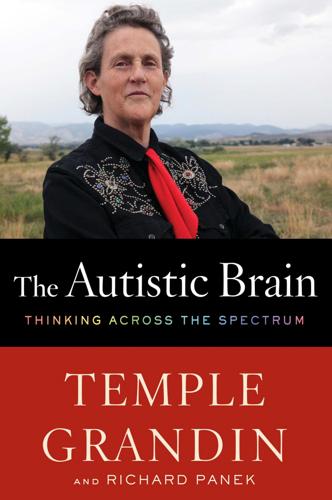
The Autistic Brain: Thinking Across the Spectrum
by
Temple Grandin
and
Richard Panek
Published 15 Feb 2013
In 2011, I contributed an article to a big scholarly book on autism. More than fourteen hundred pages. Eighty-one articles in all. Guess what. The only paper that addressed sensory problems was mine. Over the decades, I’ve seen hundreds if not thousands of research papers on whether autistics have theory of mind—the ability to imagine oneself looking at the world from someone else’s point of view and have an appropriate emotional response. But I’ve seen far, far fewer studies on sensory problems—probably because they would require researchers to imagine themselves looking at the world through an autistic person’s jumble of neuron misfires.
…
When ASD subjects were exposed to these gestures and sounds, they began imitating them, while normal subjects did not respond to the prompts because they’d long ago internalized these behaviors. Similarly, when these researchers slowed down spoken sentences, they found that ASD subjects experienced an increased understanding of meaning. The idea that hyperreactivity and hyporeactivity are two variations on a theme might even have implications for theory of mind. The “Intense World” paper proposed that if the amygdala, which is associated with emotional responses, including fear, is affected by sensory overload, then certain responses that look antisocial actually aren’t. “Impaired social interactions and withdrawal may not be the result of a lack of compassion, incapability to put oneself into someone else’s position or lack of emotionality, but quite to the contrary a result of an intensely if not painfully aversively perceived environment.”
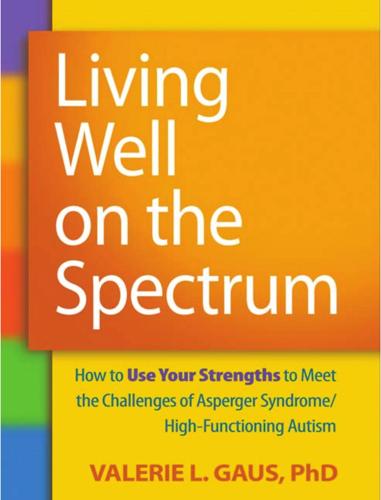
Living Well on the Spectrum
by
Valerie L. Gaus
Published 4 Feb 2011
Mind Reading A large part of analyzing the information taken in from a social scene involves guessing (inferring) what another person is thinking, feeling, expecting, and planning to do next. To do this, you first have to assume that another person may have thoughts, feelings, or expectations that are different from yours. Social cognition researchers who study autism refer to this ability to think about other people’s internal states as theory of mind. Trying to sort out what another person is thinking or feeling is called mind reading or perspective taking. It does not refer to clairvoyance or ESP but is the process by which a person forms a theory, hypothesis, or guess about what another person is thinking or experiencing. As a very simple example, imagine you and another person are sitting at opposite sides of a table, facing each other.
…
There is a very large body of research that tells us people on the spectrum have great difficulty with this. The degree of the difficulty varies with the severity of the autism symptoms as well as the presence of intellectual impairment. For instance, a person with mild symptoms of autism and a high level of intelligence may perform some theory of mind tasks very well (e.g., would automatically assume the mountain landscape in the example is not seen the same way by the other person), but will show impairment when the tasks are very complex (navigating a business meeting or cocktail party). If you are not aware of another person’s perspective, you are at risk of saying things out loud that might offend that person.
…
Empathy is very closely related to mind reading, in that you must be able to THINK about another person’s experience IDENTIFY the emotion he/she is having and why FEEL some of that emotion yourself EXPRESS it by letting the other person know you can imagine his or her experience Empathy. Social Differences 69 engage in theory of mind processes before you can experience or express empathy. You wouldn’t be able to guess that the loved ones of the deceased at a funeral are sad without the ability to imagine what they might be thinking about (that they lost someone they love). However, people who can mind-read are not necessarily empathic.
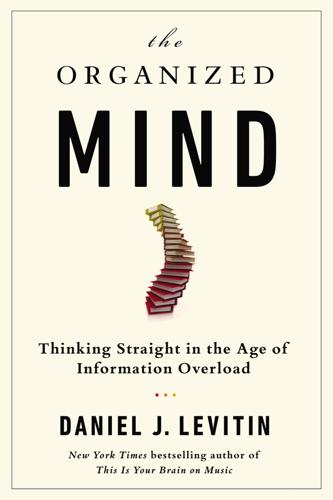
The Organized Mind: Thinking Straight in the Age of Information Overload
by
Daniel J. Levitin
Published 18 Aug 2014
A., Bellgowan, P. S., Rao, S. M., & Cox, R. W. (1999). Conceptual processing during the conscious resting state: A functional MRI study. Journal of Cognitive Neuroscience, 11(1), 80–93. and, Corbetta, M., Patel, G., & Shulman, G. (2008). The reorienting system of the human brain: From environment to theory of mind. Neuron, 58(3), 306–324. and, Fox, M. D., Snyder, A. Z., Vincent, J. L., Corbetta, M., Van Essen, D. C., & Raichle, M. E. (2005). The human brain is intrinsically organized into dynamic, anticorrelated functional networks. Proceedings of the National Academy of Sciences, 102(27), 9673–9678.
…
H., Rudrauf, D., Damasio, H., & Bechara, A. (2007). Damage to the insula disrupts addiction to cigarette smoking. Science, 315(5811), 531–534. Switching between two external objects involves the temporal-parietal junction Corbetta, M., Patel, G., & Shulman, G. L. (2008). The reorienting system of the human brain: From environment to theory of mind. Neuron, 58(3), 306–324. and, Shulman, G. L., & Corbetta, M. (2014). Two attentional networks: Identification and function within a larger cognitive architecture. In M. Posner (Ed.), The cognitive neuroscience of attention (2nd ed.) (pp. 113–128). New York, NY: Guilford Press. For an alternate view, see Geng, J.
…
The mind-wandering network recruits neurons Menon, V., & Uddin, L. Q. (2010). Saliency, switching, attention and control: A network model of insula function. Brain Structure and Function, 214(5–6), 655–667. dense mass of fibers connected Corbetta, M., Patel, G., & Shulman, G. L. (2008). The reorienting system of the human brain: From environment to theory of mind. Neuron, 58(3), 306–324. the inhibitory neurotransmitter GABA Kapogiannis, D., Reiter, D. A., Willette, A. A., & Mattson, M. P. (2013). Posteromedial cortex glutamate and GABA predict intrinsic functional connectivity of the default mode network. NeuroImage, 64, 112–119. (of a gene called COMT) Baldinger, P., Hahn, A., Mitterhauser, M., Kranz, G.

The Asperger Love Guide: A Practical Guide for Adults With Asperger's Syndrome to Seeking, Establishing and Maintaining Successful Relationships
by
Genevieve Edmonds
and
Dean Worton
Published 15 Dec 2005
Disagreements are a part of life and no one can avoid them without running away from their problems. 57 Nearly all couples have disagreements and it’s often a healthy part of a relationship. You should always try to see the argument from your partner’s point of view. For Aspies seeing things from another person’s point of view, or having empathy is something that doesn’t come easily if you are not used to it. Aspies are seen to be naturally lacking in ’Theory of Mind’, or being naturally empathic. This may be something initially you may have to force yourself to do. It is certainly possible to teach yourself to empathize with others. If you have great difficulty with seeing things only from your own point of view you may need to seek a good psychotherapist who understands the autistic spectrum who may be able to support you in learning how to empathize with others.
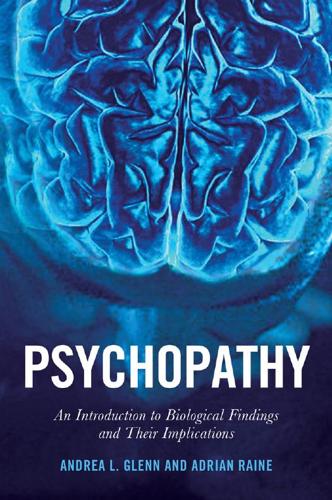
Psychopathy: An Introduction to Biological Findings and Their Implications
by
Andrea L. Glenn
and
Adrian Raine
Published 7 Mar 2014
Brain Imaging Findings in Psychopathy Brain region Function Reduced volume (Yang et al. 2005) Frontal lobe (general) Dorsolateral prefrontal cortex Gray matter thinning (Yang, Raine, Colletti, et al. 2009) Planning and organization Gray matter reductions (Müller et al. 2008) Attentional set shifting and cognitive Reduced activity when defecting in social interaction (Rilling et al. 2007) flexibility Cognitive reappraisal of emotional experience Orbitofrontal cortex/ventromedial prefrontal cortex Increased activity during moral decision making (Glenn, Raine, Schug, Young, et al. 2009) Increased activity during tasks involving emotional processing (Gordon, Baird, and End 2004, Intrator et al. 1997, Kiehl et al. 2001) Abstract reasoning Increased white matter concentration in youth (De Brito et al. in press) Processing social and emotional Gray matter reductions (de Oliveira-Souza et al. 2008) stimuli Reduced activity during fear conditioning (Birbaumer et al. 2005) Self-reflection Reduced activity during cooperation (Rilling et al. 2007) Guilt and embarrassment Reduced activity during evaluation of moral violations (Harenski et al. 2010) Cognitive appraisal of emotion Reduced activity during emotional processing (Gordon, Baird, and End 2004, Kiehl et al. Emotion regulation Frontopolar cortex Findings 2001, Müller et al. 2003, Schneider et al. 2000, Viet et al. 2002) Theory of mind (affective component) Increased gray matter concentrations in youth (De Brito et al. 2009) Shifting behavior when rewards change Increased activity during reversal learning (Finger et al. 2008) Gray matter reductions (de Oliveira-Souza et al. 2008) Table 5.1 (continued) Brain region Function Findings Gray matter thinning (Yang, Raine, Colletti, et al. 2009) Reduced volume (Dolan et al. 2002, Müller et al. 2008) Temporal lobe (general) Reduced blood flow (Soderstrom et al. 2002) Increased gray matter concentration and volumes in youth (De Brito et al. 2009) Amygdala Aversive conditioning Volume reductions (Yang, Raine, Narr, et al. 2009) Associating pain of others to one’s own Reduced activity during emotional processing (Kiehl et al. 2001, Gordon, Baird, and End actions Enhancing attention to emotional stimuli 2004) Reduced activity during fear conditioning (Birbaumer et al. 2005) Reduced activity during social noncooperation (Rilling et al. 2007) Reduced activity during moral decision making (Glenn, Raine, and Schug 2009) Increased activity when viewing emotional pictures (Müller et al. 2003) Reduced activity to fearful faces (Marsh et al. 2008, Jones et al. 2009) Hippocampus Retrieval of emotional memories Morphometric differences (Boccardi et al. 2010) Fear conditioning Asymmetry (Raine et al. 2004) Reduced volume (posterior) (Laakso et al. 2001) Reduced activity during emotional processing (Kiehl et al. 2001) Angular gyrus/superior temporal gyrus Complex social emotion Gray matter reductions (Müller et al. 2008) Linking emotional experiences to Gray matter reductions (de Oliveira-Souza et al. 2008) moral appraisals Reduced activity during semantic processing (Kiehl et al. 2004) Reduced white matter concentrations in youth (De Brito et al. in press) Anterior temporal cortex Gray matter reductions (de Oliveira-Souza et al. 2008) Reduced activity during evaluation of moral violations (Harenski et al. 2010) Table 5.1 (continued) Brain region Function Findings Effortful control Gray matter reductions (Müller et al. 2008) Self-regulation No volumetric differences (Glenn, Yang, et al. 2010) Signaling conflict or error Reduced activity during emotional processing (Kiehl et al. 2001) Affective processing, including Reduced activity during fear conditioning (Birbaumer et al. 2005, Viet et al. 2002) Other regions Anterior cingulate empathy-related functions Reduced activity when defecting in social interaction (Rilling et al. 2007) Increased gray matter concentrations in youth (De Brito et al. 2009) Reduced white matter concentrations in youth (De Brito et al. in press) Posterior cingulate Ventral striatum Recalling emotional memories Gray matter thinning (Yang, Raine, Colletti, et al. 2009) Experiencing emotion Reduced activity during emotional processing (Kiehl et al. 2001) Self-referencing Reduced activity during fear conditioning (Birbaumer et al. 2005) Reward sensitivity Reduced activity during emotional processing (Kiehl et al. 2001) Persistence in repeating actions related Increased volume (Glenn, Raine, et al. 2010) to rewards Increased activity in anticipation of reward (Buckholtz et al. 2010) Enhanced learning from rewarding signals Parahippocampal gyrus Processing of social context Reduced activity during emotional processing (Kiehl et al. 2001) Episodic memory Insula Emotional processing, including social Reduced activity during fear conditioning (Birbaumer et al. 2005) emotions Corpus callosum Transfer of information between left and right hemispheres of the brain Increased volume and length, reduced thickness (Raine et al. 2003) 118 << Brain Imaging that psychopathy is associated with deficits in a number of processes that are thought to rely on the functioning of the amygdala, including responding to aversive stimuli, aversive conditioning, augmentation of the startle reflex, and recognizing fearful facial and vocal expressions.
…
Journal of Research in Personality 41 (2):276–94. Serafim, A. D., D. M. de Barros, A. Valim, and C. Gorenstein. 2009. “Cardiac response and anxiety levels in psychopathic murderers.” Revista Brasileira De Psiquiatria 31 (3):214–18. Shamay-Tsoory, S. G., R. Tomer, B. D. Berger, D. Goldsher, and J. Aharon-Peretz. 2005. “Impaired ‘affective theory of mind’ is associated with right ventromedial prefrontal damage.” Cognitive Behavioral Neurology 18 (1):55–67. Shea, A., C. Walsh, H. MacMillan, and M. Steiner. 2005. “Child maltreatment and HPA axis dysregulation: Relationship to major depressive disorder and post traumatic stress disorder in females.”
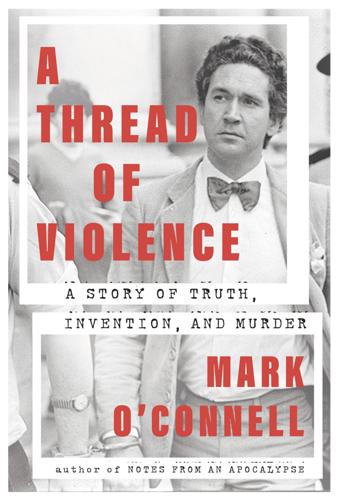
A Thread of Violence: A Story of Truth, Invention, and Murder
by
Mark O'Connell
Published 27 Jun 2023
He sanded it down and painted it black, so that it might look plausibly like a gun to a person who did not dare ask to see it more closely. He had no great faith in it, but he was growing desperate, and it was all that he had. * * * « When Macarthur was arrested, he had in his possession two books. One was an academic volume called A Materialist Theory of Mind, by the Australian philosopher David Armstrong. The other was the textbook in which his handwritten notes were secreted, a medical textbook on forensic pathology. These are the things he was reading, it seems, at the time of the murders. What interests me is the jarring juxtaposition of these two books: one a dry philosophical analysis of the functions of the mind, the other an encyclopedic guide to the destruction of the body.
…
What interests me is the jarring juxtaposition of these two books: one a dry philosophical analysis of the functions of the mind, the other an encyclopedic guide to the destruction of the body. I am succumbing here, of course, to the temptation to encounter reality as a fiction, to read it as though I were a critic; but I cannot help thinking that the presence of these two particular texts suggests a frame for thinking about Macarthur and his crimes. Armstrong was known for a theory of mind called “central state materialism,” which claimed that mental states—thoughts and emotions and so on—were in fact physical states of the brain. His contention was that this idea could explain consciousness itself. One of the means by which Armstrong attempted to explain consciousness was what he referred to as the phenomenon of “autopilot.”

On Language: Chomsky's Classic Works Language and Responsibility and Reflections on Language in One Volume
by
Noam Chomsky
and
Mitsou Ronat
Published 26 Jul 2011
These variations in structure are limited, no doubt sharply, by UG; and the functions of language in human life are no doubt narrowly constrained as well, though no one has as yet found a way to go much beyond a descriptive taxonomy in dealing with this question. 5 Restricting ourselves now to humans, suppose that we understand psychology to be the theory of mind, in the sense outlined earlier. Thus psychology is that part of human biology that is concerned at its deepest level with the second-order capacity to construct cognitive structures that enter into first-order capacities to act and to interpret experience. Psychology has as its primary concern the faculties of mind involved in cognitive capacity.
…
Given a partially structured system that provides an evaluation of outcomes, choices that are random except for maximizing “value” may have the appearance of free, purposeful, and intelligent behavior—but one must remain skeptical about this approach, though it is the only one that seems to fall within any conceptual framework intelligible to us. Within cognitive capacity, the theory of mind has a distinctly rationalist cast. Learning is primarily a matter of filling in detail within a structure that is innate. We depart from the tradition in several respects, specifically, in taking the “a priori system” to be biologically determined. 6 Outside the bounds of cognitive capacity, an empiricist theory of learning applies, by unfortunate necessity.
…
Suppose further that the operation of rules of grammar is in part determined by semantic properties of lexical items; to form passive sentences, for example, we must take into account semantic properties of verbs and their “thematic relations” to surrounding noun phrases. These are by no means implausible ideas. If they are correct, the language faculty does not fix a grammar in isolation, even in principle. The theory of UG remains as a component of the theory of mind, but as an abstraction. Note that this conclusion, if correct, does not imply that the language faculty does not exist as an autonomous component of mental structure. Rather, the position we are now considering postulates that this faculty does exist, with a physical realization yet to be discovered, and places it within the system of mental faculties in a fixed way.
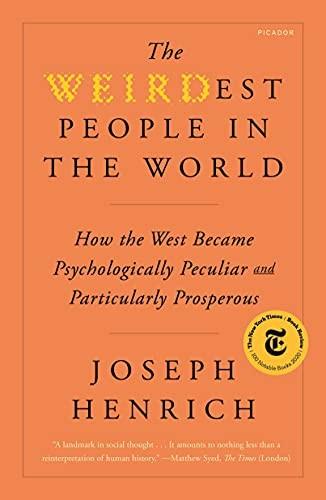
The WEIRDest People in the World: How the West Became Psychologically Peculiar and Particularly Prosperous
by
Joseph Henrich
Published 7 Sep 2020
Khadjavi, M., and Lange, A. (2013). Prisoners and their dilemma. Journal of Economic Behavior and Organization 92, 163–75. Khaldûn, I. (2015). The Muqaddimah: An Introduction to History. (F. Rosenthal, ed.). Princeton, NJ: Princeton University Press. Kidd, D. C., and Castano, E. (2013). Reading literary fiction improves theory of mind. Science 342 (6156), 377–80. Kieser, A. (1987). From asceticism to administration of wealth: Medieval monasteries and the pitfalls of rationalization. Organization Studies 8 (2), 103–123. Kinzler, K. D., and Dautel, J. B. (2012). Children’s essentialist reasoning about language and race. Developmental Science 15 (1), 131–38.
…
Journal for the Scientific Study of Religion 26 (1), 126–28. Knight, N., and Nisbett, R. E. (2007). Culture, class and cognition: Evidence from Italy. Journal of Cognition and Culture 7 (3), 283–91. Kobayashi, C., Glover, G. H., and Temple, E. (2007). Cultural and linguistic effects on neural bases of “theory of mind” in American and Japanese children. Brain Research 1164, 95–107. Kolinsky, R., Verhaeghe, A., Fernandes, T., Mengarda, E. J., Grimm-Cabral, L., and Morais, J. (2011). Enantiomorphy through the looking glass: Literacy effects on mirror-image discrimination. Journal of Experimental Psychology: General 140 (2), 210–38.
…
Exploring the link between reading fiction and empathy: Ruling out individual differences and examining outcomes. Communications 34 (4), 407–428. Mar, R. A., and Rain, M. (2015). Narrative fiction and expository nonfiction differentially predict verbal ability. Scientific Studies of Reading 19 (6), 419–33. Mar, R. A., Tackett, J. L., and Moore, C. (2010). Exposure to media and theory-of-mind development in preschoolers. Cognitive Development 25 (1), 69–78. Marcus, J. (2008). The archaeological evidence for social evolution. Annual Review of Anthropology 37 (1), 251–66. Marcus, J., and Flannery, K. V. (2004). The coevolution of ritual and society: New C-14 dates from ancient Mexico.
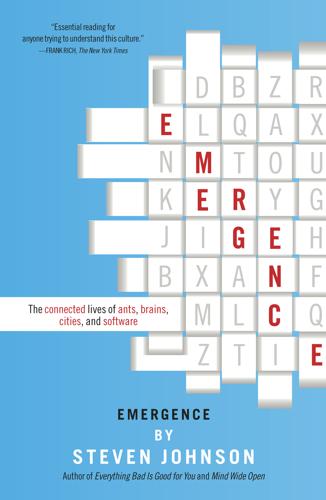
Emergence
by
Steven Johnson
Is it conceivable that this skill simply derives from a general increase in intelligence? Could it be that humans and their close cousins are just smarter than all those other species who flunk the mind-reading test? In other words, is there something specific to our social intelligence, something akin to a module hardwired into the brain’s CPU—or is the theory of minds just an idea that inevitably occurs to animals who reach a certain threshold of general intelligence? We are only now beginning to build useful maps of the brain’s functional topography, but already we see signs that “mind reading” is more than just a by-product of general intelligence. Several years ago, the Italian neuroscientist Giaccamo Rizzollati discovered a region of the brain that may well prove to be integral to the theory of other minds.
…
New York: Basic Books, 1984. Bak, Per. How Nature Works: The Science of Self-Organized Criticality. New York: Springer-Verlag, 1996. Ball, Philip. The Self-Made Tapestry: Pattern Formation in Nature. New York, Oxford, and Tokyo: Oxford University Press, 1999. Baron-Cohen, Simon. Mindblindness: An Essay on Autism and Theory of Mind. Cambridge, Mass., and London: MIT Press, 1999. ———, ed. The Maladapted Mind: Classic Readings in Evolutionary Psychopathology. East Sussex, UK: Psychology Press, 1997. Becker, Konrad, and Miss M. “An Interview with Manuel De Landa.” Online posting. www.t0.or.at/delanda/intdeladna.htm. May 2000.
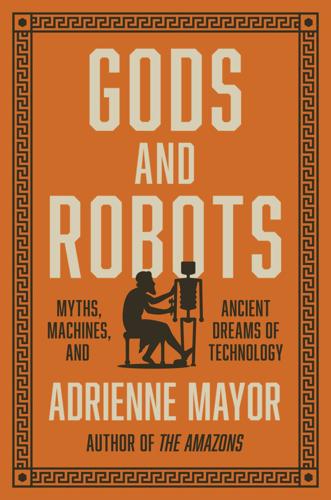
Gods and Robots: Myths, Machines, and Ancient Dreams of Technology
by
Adrienne Mayor
Published 27 Nov 2018
Type II AI machines have limited capacity to make memories and can add observations to their preprogrammed representations of the world (examples: self-driving cars, chatbots, and Hephaestus’s automated bellows). Type III, as yet undeveloped, would possess theory of mind and the ability to anticipate others’ expectations or desires (fictional examples: Star Wars’ C-3PO, Hephaestus’s Golden Servants, the Phaeacian ships). Type IV AI of the future would possess theory of mind as well as self-awareness (fictional examples include Tik-Tok in John Sladek’s 1983 novel and Eva in the 2015 film Ex Machina). Since she is capable of deceit and persuasion, Pandora seems to fall between Types II and III.
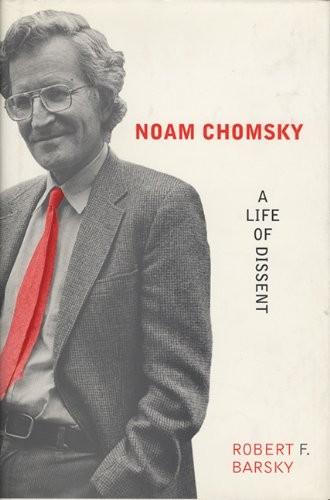
Noam Chomsky: A Life of Dissent
by
Robert F. Barsky
Published 2 Feb 1997
These considerations lie at the heart of the dualist metaphysics of the Cartesians, which again accords rather well with our common-sense understanding" ("Creation"). Despite its accordance with "our common-sense understanding," however, much of what was postulated by Cartesian dualist metaphysics has subsequently been thrown into doubt. "[B]ut," Chomsky asserts, "it is important to recall that what collapsed was the Cartesian theory of matter; the theory of mind, such as it was, has undergone no fundamental critique" ("Creation"). Chomsky remarks on the notion Descartes put forward that we can train the smartest animals to perform various tasks and tricks, but no matter how high their level of competence they will never equal even the least skilled human in terms of linguistic ability.
…
Daniel Yergin explains: "In 1660, influenced by Descartes, [the Port-Royal group] produced a 'philosophical grammar' that suggested a distinction between deep and surface structures, and argued for psychological rules which, like Chomsky's, would permit us to make infinite use of finite means" (53). Chomsky elaborates the ways in which the rationalist theory of mind and the Cartesian approach to linguistics offer valuable support for studies of the acquisition and utilization of language as described by certain factions of the linguistic community (most of whom worked in building 20 at MIT). Such studiesof common forms of language, of general grammars, and of the conditions that prescribe the forms of human languagebuild on work undertaken by Cartesian linguists, and, in the process, acknowledge "the quite obvious fact that the speaker of a language knows a great deal that he has not learned" (Chomsky, Language and Responsibility 60).

Life After Google: The Fall of Big Data and the Rise of the Blockchain Economy
by
George Gilder
Published 16 Jul 2018
Predecessors such as IBM and Intel were comparable in their technological drive and accomplishment, from Thomas Watson’s mainframes and semiconductor memories to Bob Noyce’s processors and Gordon Moore’s learning curves. But Moore’s Law and Big Blue do not provide a coherent system of the world. Under the leadership of Larry Page and Sergey Brin, Google developed an integrated philosophy that aspires, with growing success, to shape our lives and fortunes. Google has proposed a theory of knowledge and a theory of mind to animate a vision for the dominant technology of the world; a new concept of money and therefore price signals; a new morality and a new idea of the meaning and process of progress. The Google theory of knowledge, nicknamed “big data,” is as radical as Newton’s and as intimidating as Newton’s was liberating.
…
The idea of big data is that the previous slow, clumsy, step-by-step search for knowledge by human brains can be replaced if two conditions are met: All the data in the world can be compiled in a single “place,” and algorithms sufficiently comprehensive to analyze them can be written. Upholding this theory of knowledge is a theory of mind derived from the pursuit of artificial intelligence. In this view, the brain is also fundamentally algorithmic, iteratively processing data to reach conclusions. Belying this notion of the brain is the study of actual brains, which turn out be much more like sensory processors than logic machines.

How to Spend a Trillion Dollars
by
Rowan Hooper
Published 15 Jan 2020
Keep that in mind for a minute while we consider what qualities an AGI will need. A computer with human-level intelligence must be able to plan and strategise for the future. It will need the ability to use short-term memory. It will need to be able to model what its actions might do, and to understand the actions of other agents. An AI will need theory of mind: the ability to understand the motivation of others and to interact appropriately. If we see a dog off its lead running towards a child holding a sandwich, for example, it will instantly run through our minds that the dog might snatch the food from the child. The child will then be upset or even hurt, and we see that the child’s parent, staring at a phone, is unaware of the drama.
…
It’s something that computers have had trouble with, but which DeepMind is starting to tackle with a neural network-style computer that has access to a short-term memory.12 It’s a small step towards human-like thinking, and it’s this sort of success that encourages DeepMind that the neural network approach is the route to get there. AI with theory of mind isn’t far away. We’ve looked at a lot of different AI abilities. What if we are able to make an AI that can put them all together? We’ll have something that can use knowledge from millions of hospital records to diagnose illness better than human doctors, and certainly without the waiting time; that can design powerful new pharmaceuticals and antibiotics; that can strategise, determining the most efficient way to run a nation’s power system; that can drive us around more safely than human drivers and make decisions on what to do when a dog runs out into the road; that can recognise and interpret our emotions, empathise with us, answer our email in the style we usually write in, make phone calls for us, entertain us, play with us.
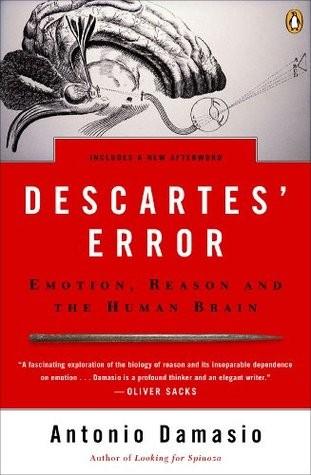
Descartes' Error: Emotion, Reason and the Human Brain
by
António R. Damásio
Published 1 Jan 1994
When a patient develops an inability to recognize familiar faces, or see color, or read, or when patients cease to recognize melodies, or understand speech, or produce speech, the description they offer of the phenomenon, with rare exceptions, is that something is happening to them, something new and unusual which they can observe, puzzle over, and often describe, in insightful and concrete ways. Curiously, the theory of mind implicit in those descriptions suggests that they “locate” the problem to a part of their persons which they are surveying from the vantage point of their selfhood. The frame of reference is not different from the one they would use were they referring to a problem with their knees or elbows.
…
The characterization of this plastic process is outside the scope of this text, but the account provided here is compatible with the idea that it largely occurs by selection of circuitries at synaptic level. The application of the notion of selection to the nervous system was first suggested by Niels Jerne and J. Z. Young and used by Jean Pierre Changeux. Gerald Edelman has championed the idea and built a comprehensive theory of mind and brain around it. CHAPTER 6 1. C. B. Pert, M. R. Ruff, R. J. Weber, and M. Herkenham (1985). Neuropeptides and their receptors: A psychosomatic network, The Journal of Immunology, 135:8205–265. F. Bloom (1985). Neuropeptides and other mediators in the central nervous system, The Journal of Immunology, 135:7435–455.
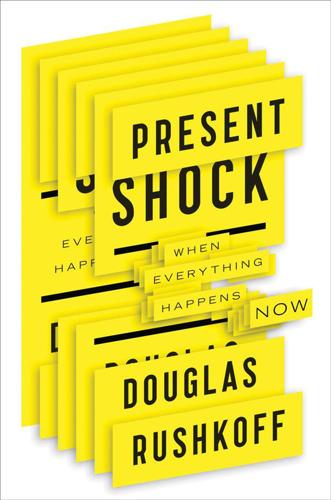
Present Shock: When Everything Happens Now
by
Douglas Rushkoff
Published 21 Mar 2013
Scientists from across the spectrum leaped on the systems bandwagon, applying what began as a mathematical proof of market equilibrium to, well, pretty much everything. Linguist Steven Pinker saw in Hayek and systems theory a new justification for his advancement of evolutionary psychology and his computational theory of mind: “Hayek was among the first to call attention to the emergence of large-scale order from individual choices. The phenomenon is ubiquitous, and not just in economic markets: What makes everyone suddenly drive SUVs, name their daughters Madison rather than Ethel or Linda, wear their baseball caps backwards, raise their pitch at the end of a sentence?
…
In the next century, it should change the way people think about organizations, networks, and the social order more generally.”14 And so scientists, economists, cultural theorists, and even military strategists15 end up adopting fractalnoia as the new approach to describing and predicting the behavior of both individual actors and the greater systems in which they live. Weather, plankton, anthills, cities, love, sex, profit, society, and culture are all subject to the same laws. Everything is everything, as Bateson’s theory of Mind finds itself realized in the computer-generated fractal. Where all these scientists and social programmers must tread carefully, however, is in their readiness to draw congruencies and equivalencies between things that may resemble one another in some ways but not others. Remember, the fractal is self-similar on all its levels, but not necessarily identical.
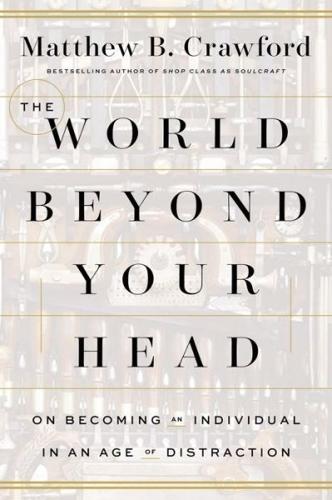
The World Beyond Your Head: On Becoming an Individual in an Age of Distraction
by
Matthew B. Crawford
Published 29 Mar 2015
What was so deeply disturbing about the Toyota recall episode of 2008, I believe, was the revelation that there was software—convention, language, representation—involved in the brakes. This design problem of disconnection or arbitrariness mirrors a fundamental problem in cognitive science: the symbol-grounding problem. In the computational theory of mind that prevails in conventional cognitive science, we are assumed to have internal representations of the world, and these representations are built on symbols that are meaningless in themselves; they “encode” features of the world in the same way a computer represents states of affairs with a string of zeroes and ones.
…
massification and social class and sovereign self and uncertain notions of of will autotelic activities Avalon (Toyota) Averaged American, The (Igo) Bach, Johann Sebastian ball bearings barbarians, skateboarders as Baroque era bartending baseball baseball bats Beat era Beckerath, Rudolf von Bedos, Dom Behavioral and Brain Sciences behavioral conditioning behavioral economics Benihana biases big data, era of blackjack Blind Spot Assist (Mercedes) bluegrass BMW Boardwalk Hall Auditorium organ Bono, Chris Boody, John motivation by reverse engineering by Boudreau, Bruce Brake Assist (Mercedes) Brewer, Talbot Brombaugh, John Brooks, David Burke, Edmund business-class lounge Calvin, John Canada cane capital concentration of social capitalism affective creative destruction in carbon fiber caretaking practices carpenters Car Talk cartoons cave, allegory of cell phone, driving while on centralization of authority certainty Chamberlain, Neville character Charles de Gaulle airport chiff children’s television chimpanzees China Cultural Revolution in choice freedom as and presentation of options as totem of consumer capitalism choice architects chopsticks Churchill, Winston Cindy (bookkeeper) Circuit of the Americas citizens, relationship of (sovereign) to Civil War, English Clark, Andy classical conditioning Clinton, Bill clustering cognition, advanced cognitive extension cognitive psychology cognitive sciences coherence colored walls commerce, regulation of communism communitarianism computational theory of mind concentration of motorcycle riders concepts, skilled activities and conflict, between self and world conformity individuality vs. consciousness consent conservatives consumer credit contingencies contract, authority of conversations, retrospective understanding enhanced by cooking, see short-order cooks cooperation Corporate Gaming Act courts, failing to appear in craft craps creative destruction creativity Critique of Judgment (Kant) cross-modal binding cultural authority cultural jigs Cultural Revolution culture culture of performance Cussins, Adrian cybernetics Davis, Miles death instinct pleasure principle and the will and debt Declaration of Independence Declaration of the Rights of Man Demain, Erik Demain, Martin democracy without flattening social effects of in statistical constructs Democracy in America (Tocqueville) Denmark Dennett, Daniel depression deregulation Descartes, René American individualism and epistemology of on primary vs. secondary qualities design: attention and of automobiles computer-aided in glassmaking interior in machine gambling in organ making determinism de Zengotita, Thomas Diagnostic and Statistical Manual of Mental Disorders Diderot, Denis differentiation from others as basis of communal feeling as basis of individuality and identity politics as incubator of genuine attachments as inherently hierarchal vs. viewing oneself as representative “digital Maoism” dissidents distraction in cultural crisis of attention as neuroscience finding political economy and summary view of diversity divorce dogs, Frisbees as caught by Dreyfus, Hubert driving Droid Dumbaugh, Eric Dunkin’ Donuts Ebbesen, E.

Powers and Prospects
by
Noam Chomsky
Published 16 Sep 2015
Fascination with the (possible) limits of automata is one respect in which the first cognitive revolution has been in part relived in recent years, though the usual preoccupation today is the nature of consciousness, not the properties of normal human action that concerned the Cartesians; crucially, the apparent fact that it is coherent and appropriate, but uncaused. Another similarity has to do with what are nowadays called ‘computational theories of mind’. In a different form, these were also a salient feature of the first cognitive revolution. Perhaps Descartes’ most lasting scientific contribution lies right here: his outline of a theory of perception with a computational flair (though our notions of computation were unavailable), along with proposals about its realisation in bodily mechanisms.
…
As in the theory of vision, and the cognitive sciences generally (in fact, much of science), we can study these questions at various levels. At one level, we can seek to identify the cellular structures involved in these operations. Or we can study the properties of these objects more abstractly—in this case, in terms of computational theories of mind and the symbolic representations they make available. Such investigations have something of the character of the study of structural formulas of chemistry or the Periodic table. In the case of language, we can be reasonably confident that the computational structure is largely innate; otherwise, no language could be acquired.
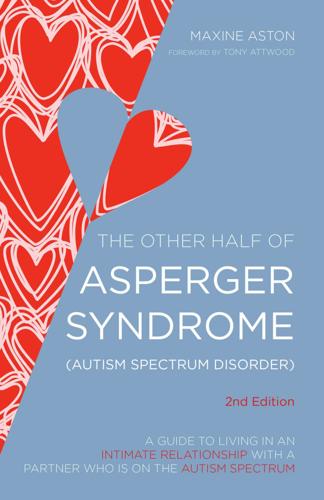
The Other Half of Asperger Syndrome (Autism Spectrum Disorder): A Guide to Living in an Intimate Relationship With a Partner Who Is on the Autism Spectrum Second Edition
by
Maxine Aston
Published 21 Feb 2014
Aston, M.C. (2012) What Men with Asperger’s Want To Know about Women, Dating and Relationships. London: Jessica Kingsley Publishers. Attwood, T. (2007) The Complete Guide to Asperger’s Syndrome. London: Jessica Kingsley Publishers. Baron-Cohen, S. (1997) Mindblindness: An Essay on Autism and Theory of Mind. London: MIT Press. Bentley. K. (2007) Alone Together: Making an Asperger Marriage Work. London: Jessica Kingsley Publishers. Frith, U. (ed.) (1991) Autism and Asperger Syndrome. Cambridge: Cambridge University Press. Hendrickx, S. (2008) Love, Sex and Long-Term Relationships. London: Jessica Kingsley Publishers.

Utopia Is Creepy: And Other Provocations
by
Nicholas Carr
Published 5 Sep 2016
Several studies have shown that reading tends to make us at least a little more empathetic, a little more alert to the inner lives of others. A series of experiments by researchers at the New School for Social Research, reported in Science in 2013, showed that reading literary fiction can strengthen a person’s “theory of mind,” which is what psychologists call the ability to understand what other people are thinking and feeling. “Fiction is not just a simulator of a social experience,” one of the researchers, David Comer Kidd, told The Guardian; “it is a social experience.” The reader withdraws in order to connect more deeply.
…
(Coupland), 102 Martin, Paul, 335 Marx, Karl, Marxism, xvii, xviii, 26, 83, 174, 308 Marx, Leo, 131 Maslow, Abraham, 117–20 massive open online courses (MOOCs), 133 master-slave metaphor, 307–9 mastery, 64–65 Mayer, Marissa, 268 Mayer-Schönberger, Viktor, 48 McAfee, Andrew, 195 McCain, John, 318 McKeen, William, 13–15 McLuhan, Marshall, 102–6, 183–84, 232, 326 McNealy, Scott, 257 measurement, 182 of experience, 197–98, 211–12 mechanical loom, 77 Mechanical Turk, 37–38 media: as advertorial, 53 big outlets for, 67 changes in, 53–54, 59–60 democratization of, xvi, xviii, 28 hegemony of internet in, 236–37 intellectual and social effects of, 103–6 as invasive, 105–6, 127–30 mainstream, 7–8 pursuit of immediacy in, 79 real world vs., 223 in shaping thought, 232 smartphones’ dominance of, 183–84 tools vs., 226 meditation, 162 Mehta, Mayank, 303 memory: association and cohesion in, 100–101 computer, 147, 231 cultural, 325–28 digital, 327 effect of computers on, 98–101, 234, 240 internet manipulation of, 48 neuroengineering of, 332–34 packaging of, 186 in revivification, 69–70 spatial, 290 time vs., 226 video games and, 94–97 Merholz, Peter, 21 Merleau-Ponty, Maurice, 300 Merton, Robert, 12–13 message-automation service, 167 Meyer, Stephenie, 50 Meyerowitz, Joanne, 338 microfilm, microphotography, 267 Microsoft, 108, 168, 205, 284 military technology, 331–32 Miller, Perry, xvii mindfulness, 162 Minima Moralia (Adorno), 153–54 mirrors, 138–39 Mitchell, Joni, 128 Mollie (video poker player), 218–19 monitoring: corporate control through, 163–65 of thoughts, 214–15 through wearable behavior-modification devices, 168–69 Montaigne, Michel de, 247, 249, 252, 254 Moore, Geoffrey, 209 Morlocks, 114, 186 “Morphological Basis of the Arm-to-Wing Transition, The” (Poore), 329–30 Morrison, Ewan, 288 Morrison, Jim, 126 Morse code, 34 “Most of It, The” (Frost), 145–46 motor skills, video games and, 93–94 “Mowing” (Frost), 296–300, 302, 304–5 MP3 players, 122, 123, 124, 216, 218, 293 multitasking, media, 96–97 Mumford, Lewis, 138–39, 235 Murdoch, Rupert and Wendi, 131 music: bundling of, 41–46 commercial use of, 244–45 copying and sharing technologies for, 121–26, 314 digital revolution in, 293–95 fidelity of, 124 listening vs. interface in, 216–18, 293 in participatory games, 71–72 streamed and curated, 207, 217–18 music piracy, 121–26 Musings on Human Metamorphoses (Leary), 171 Musk, Elon, 172 Musset, Alfred de, xxiii Muzak, 208, 244 MySpace, xvi, 10–11, 30–31 “Names of the Hare, The,” 201 nanotechnology, 69 Napster, 122, 123 narcissism, 138–39 Twitter and, 34–36 narrative emotions, 250 natural-language processing, 215 Negroponte, Nicholas, xx neobehavioralism, 212–13 Netflix, 92 neural networks, 136–37 neuroengineering, 332–33 New Critics, 249 News Feed, 320 news media, 318–20 newspapers: evolution of, 79, 237 online archives of, 47–48, 190–92 online vs. printed, 289 Newton, Isaac, 66 New York Public Library, 269 New York Times, 8, 71, 83, 133, 152–53, 195, 237, 283, 314, 342 erroneous information revived by, 47–48 on Twitter, 35 Nielsen Company, 80–81 Nietzsche, Friedrich, 126, 234–35, 237 Nightingale, Paul, 335 Nixon, Richard, 317 noise pollution, 243–46 Nook, 257 North of Boston (Frost), 297 nostalgia, 202, 204, 312 in music, 292–95 Now You See It (Davidson), 94 Oates, Warren, 203 Oatley, Keith, 248–50 Obama, Barack, 314 obsession, 218–19 OCLC, 276 “off grid,” 52 Olds, James, 235 O’Neill, Gerard, 171 One Infinite Loop, 76 Ong, Walter, 129 online aggregation, 192 On Photography (Sontag), xx open networks, profiteering from, 83–85 open-source projects, 5–7, 26 Oracle, 17 orchises, 305 O’Reilly, Tim, 3–5, 7 organ donation and transplantation, 115 ornithopters, 239 orphan books, 276, 277 Overture, 279–80 Owad, Tom, 256 Oxford Junior Dictionary, 201–2 Oxford University, library of, 269 Page, Larry, 23, 160, 172, 239, 268–69, 270, 279, 281–85 personal style of, 16–17, 281–82, 285 paint-by-number kits, 71–72 Paley, William, 43 Palfrey, John, 272–74, 277 Palmisano, Sam, 26 “pancake people,” 242 paper, invention and uses of, 286–89 Paper: An Elegy (Sansom), 287 Papert, Seymour, 134 Paradise within the Reach of All Men, The (Etzler), xvi–xvii paradox of time, 203–4 parenting: automation of, 181 of virtual child, 73–75 Parker, Sarah Jessica, 131 participation: “cognitive surplus” in, 59 as content and performance, 184 inclusionists vs. deletionists in, 18–20 internet, 28–29 isolation and, 35–36, 184 limits and flaws of, 5–7, 62 Paul, Rand, 314 Pendragon, Caliandras (avatar), 25 Pentland, Alex, 212–13 perception, spiritual awakening of, 300–301 personalization, 11 of ads, 168, 225, 264 isolation and, 29 loss of autonomy in, 264–66 manipulation through, 258–59 in message automation, 167 in searches, 145–46, 264–66 of streamed music, 207–9, 245 tailoring in, 92, 224 as threat to privacy, 255 Phenomenology of Perception (Merleau-Ponty), 300 Philosophical Investigations (Wittgenstein), 215 phonograph, phonograph records, 41–46, 133, 287 photography, technological advancement in, 311–12 Pichai, Sundar, 181 Pilgrims, 172 Pinterest, 119, 186 playlists, 314 PlayStation, 260 “poetic faith,” 251 poetry, 296–313 polarization, 7 politics, transformed by technology, 314–20 Politics (Aristotle), 307–8 Poore, Samuel O., 329–30 pop culture, fact-mongering in, 58–62 pop music, 44–45, 63–64, 224 copying technologies for, 121–26 dead idols of, 126 industrialization of, 208–9 as retrospective and revivalist, 292–95 positivism, 211 Potter, Dean, 341–42 power looms, 178 Presley, Elvis, 11, 126 Prim Revolution, 26 Principles of Psychology (James), 203 Principles of Scientific Management, The (Taylor), 238 printing press: consequences of, 102–3, 234, 240–41, 271 development of, 53, 286–87 privacy: devaluation of, 258 from electronic surveillance, 52 family cohesion vs., 229 free flow of information vs. right to, 190–94 internet threat to, 184, 255–59, 265, 285 safeguarding of, 258–59, 283 vanity vs., 107 proactive cognitive control, 96 Prochnik, George, 243–46 “Productivity Future Vision (2011),” 108–9 Project Gutenberg, 278 prosperity, technologies of, 118, 119–20 prosumerism, 64 protest movements, 61 Proust and the Squid (Wolf), 234 proximal clues, 303 public-domain books, 277–78 “public library,” debate over use of term, 272–74 punch-card tabulator, 188 punk music, 63–64 Quantified Self Global Conference, 163 Quantified Self (QS) movement, 163–65 Quarter-of-a-Second Rule, 205 racecars, 195, 196 radio: in education, 134 evolution of, 77, 79, 159, 288 as music medium, 45, 121–22, 207 political use of, 315–16, 317, 319 Radosh, Daniel, 71 Rapp, Jen, 341–42 reactive cognitive control, 96 Readers’ Guide to Periodical Literature, 91 reading: brain function in, 247–54, 289–90 and invention of paper, 286–87 monitoring of, 257 video gaming vs., 261–62 see also books reading skills, changes in, 232–34, 240–41 Read Write Web (blog), 30 Reagan, Ronald, 315 real world: digital media intrusion in, 127–30 perceived as boring and ugly, 157–58 as source of knowledge, 313 virtual world vs., xx–xxi, 36, 62, 127–30, 303–4 reconstructive surgery, 239 record albums: copying of, 121–22 jackets for, 122, 224 technology of, 41–46 Redding, Otis, 126 Red Light Center, 39 Reichelt, Franz, 341 Reid, Rob, 122–25 relativists, 20 religion: internet perceived as, 3–4, 238 for McLuhan, 105 technology viewed as, xvi–xvii Republic of Letters, 271 reputations, tarnishing of, 47–48, 190–94 Resident Evil, 260–61 resource sharing, 148–49 resurrection, 69–70, 126 retinal implants, 332 Retromania (Reynolds), 217, 292–95 Reuters, Adam, 26 Reuters’ SL bureau, 26 revivification machine, 69–70 Reynolds, Simon, 217–18, 292–95 Rice, Isaac, 244 Rice, Julia Barnett, 243–44 Richards, Keith, 42 “right to be forgotten” lawsuit, 190–94 Ritalin, 304 robots: control of, 303 creepy quality of, 108 human beings compared to, 242 human beings replaced by, 112, 174, 176, 195, 197, 306–7, 310 limitations of, 323 predictions about, xvii, 177, 331 replaced by humans, 323 threat from, 226, 309 Rogers, Roo, 83–84 Rolling Stones, 42–43 Roosevelt, Franklin, 315 Rosen, Nick, 52 Rubio, Marco, 314 Rumsey, Abby Smith, 325–27 Ryan, Amy, 273 Sandel, Michael J., 340 Sanders, Bernie, 314, 316 Sansom, Ian, 287 Savage, Jon, 63 scatology, 147 Schachter, Joshua, 195 Schivelbusch, Wolfgang, 229 Schmidt, Eric, 13, 16, 238, 239, 257, 284 Schneier, Bruce, 258–59 Schüll, Natasha Dow, 218 science fiction, 106, 115, 116, 150, 309, 335 scientific management, 164–65, 237–38 Scrapbook in American Life, The, 185 scrapbooks, social media compared to, 185–86 “Scrapbooks as Cultural Texts” (Katriel and Farrell), 186 scythes, 302, 304–6 search-engine-optimization (SEO), 47–48 search engines: allusions sought through, 86 blogging, 66–67 in centralization of internet, 66–69 changing use of, 284 customizing by, 264–66 erroneous or outdated stories revived by, 47–48, 190–94 in filtering, 91 placement of results by, 47–48, 68 searching vs., 144–46 targeting information through, 13–14 writing tailored to, 89 see also Google searching, ontological connotations of, 144–46 Seasteading Institute, 172 Second Life, 25–27 second nature, 179 self, technologies of the, 118, 119–20 self-actualization, 120, 340 monitoring and quantification of, 163–65 selfies, 224 self-knowledge, 297–99 self-reconstruction, 339 self-tracking, 163–65 Selinger, Evan, 153 serendipity, internet as engine of, 12–15 SETI@Home, 149 sexbots, 55 Sex Pistols, 63 sex-reassignment procedures, 337–38 sexuality, 10–11 virtual, 39 Shakur, Tupac, 126 sharecropping, as metaphor for social media, 30–31 Shelley, Percy Bysshe, 88 Shirky, Clay, 59–61, 90, 241 Shop Class as Soulcraft (Crawford), 265 Shuster, Brian, 39 sickles, 302 silence, 246 Silicon Valley: American culture transformed by, xv–xxii, 148, 155–59, 171–73, 181, 241, 257, 309 commercial interests of, 162, 172, 214–15 informality eschewed by, 197–98, 215 wealthy lifestyle of, 16–17, 195 Simonite, Tom, 136–37 simulation, see virtual world Singer, Peter, 267 Singularity, Singularitarians, 69, 147 sitcoms, 59 situational overload, 90–92 skimming, 233 “Slaves to the Smartphone,” 308–9 Slee, Tom, 61, 84 SLExchange, 26 slot machines, 218–19 smart bra, 168–69 smartphones, xix, 82, 136, 145, 150, 158, 168, 170, 183–84, 219, 274, 283, 287, 308–9, 315 Smith, Adam, 175, 177 Smith, William, 204 Snapchat, 166, 205, 225, 316 social activism, 61–62 social media, 224 biases reinforced by, 319–20 as deceptively reflective, 138–39 documenting one’s children on, 74–75 economic value of content on, 20–21, 53–54, 132 emotionalism of, 316–17 evolution of, xvi language altered by, 215 loom as metaphor for, 178 maintaining one’s microcelebrity on, 166–67 paradox of, 35–36, 159 personal information collected and monitored through, 257 politics transformed by, 314–20 scrapbooks compared to, 185–86 self-validation through, 36, 73 traditional media slow to adapt to, 316–19 as ubiquitous, 205 see also specific sites social organization, technologies of, 118, 119 Social Physics (Pentland), 213 Society for the Suppression of Unnecessary Noise, 243–44 sociology, technology and, 210–13 Socrates, 240 software: autonomous, 187–89 smart, 112–13 solitude, media intrusion on, 127–30, 253 Songza, 207 Sontag, Susan, xx SoundCloud, 217 sound-management devices, 245 soundscapes, 244–45 space travel, 115, 172 spam, 92 Sparrow, Betsy, 98 Special Operations Command, U.S., 332 speech recognition, 137 spermatic, as term applied to reading, 247, 248, 250, 254 Spinoza, Baruch, 300–301 Spotify, 293, 314 “Sprite Sips” (app), 54 Squarciafico, Hieronimo, 240–41 Srinivasan, Balaji, 172 Stanford Encyclopedia of Philosophy, 68 Starr, Karla, 217–18 Star Trek, 26, 32, 313 Stengel, Rick, 28 Stephenson, Neal, 116 Sterling, Bruce, 113 Stevens, Wallace, 158 Street View, 137, 283 Stroop test, 98–99 Strummer, Joe, 63–64 Studies in Classic American Literature (Lawrence), xxiii Such Stuff as Dreams (Oatley), 248–49 suicide rate, 304 Sullenberger, Sully, 322 Sullivan, Andrew, xvi Sun Microsystems, 257 “surf cams,” 56–57 surfing, internet, 14–15 surveillance, 52, 163–65, 188–89 surveillance-personalization loop, 157 survival, technologies of, 118, 119 Swing, Edward, 95 Talking Heads, 136 talk radio, 319 Tan, Chade-Meng, 162 Tapscott, Don, 84 tattoos, 336–37, 340 Taylor, Frederick Winslow, 164, 237–38 Taylorism, 164, 238 Tebbel, John, 275 Technics and Civilization (Mumford), 138, 235 technology: agricultural, 305–6 American culture transformed by, xv–xxii, 148, 155–59, 174–77, 214–15, 229–30, 296–313, 329–42 apparatus vs. artifact in, 216–19 brain function affected by, 231–42 duality of, 240–41 election campaigns transformed by, 314–20 ethical hazards of, 304–11 evanescence and obsolescence of, 327 human aspiration and, 329–42 human beings eclipsed by, 108–9 language of, 201–2, 214–15 limits of, 341–42 master-slave metaphor for, 307–9 military, 331–32 need for critical thinking about, 311–13 opt-in society run by, 172–73 progress in, 77–78, 188–89, 229–30 risks of, 341–42 sociology and, 210–13 time perception affected by, 203–6 as tool of knowledge and perception, 299–304 as transcendent, 179–80 Technorati, 66 telegrams, 79 telegraph, Twitter compared to, 34 telephones, 103–4, 159, 288 television: age of, 60–62, 79, 93, 233 and attention disorders, 95 in education, 134 Facebook ads on, 155–56 introduction of, 103–4, 159, 288 news coverage on, 318 paying for, 224 political use of, 315–16, 317 technological adaptation of, 237 viewing habits for, 80–81 Teller, Astro, 195 textbooks, 290 texting, 34, 73, 75, 154, 186, 196, 205, 233 Thackeray, William, 318 “theory of mind,” 251–52 Thiel, Peter, 116–17, 172, 310 “Things That Connect Us, The” (ad campaign), 155–58 30 Days of Night (film), 50 Thompson, Clive, 232 thought-sharing, 214–15 “Three Princes of Serendip, The,” 12 Thurston, Baratunde, 153–54 time: memory vs., 226 perception of, 203–6 Time, covers of, 28 Time Machine, The (Wells), 114 tools: blurred line between users and, 333 ethical choice and, 305 gaining knowledge and perception through, 299–304 hand vs. computer, 306 Home and Away blurred by, 159 human agency removed from, 77 innovation in, 118 media vs., 226 slave metaphor for, 307–8 symbiosis with, 101 Tosh, Peter, 126 Toyota Motor Company, 323 Toyota Prius, 16–17 train disasters, 323–24 transhumanism, 330–40 critics of, 339–40 transparency, downside of, 56–57 transsexuals, 337–38 Travels and Adventures of Serendipity, The (Merton and Barber), 12–13 Trends in Biochemistry (Nightingale and Martin), 335 TripAdvisor, 31 trolls, 315 Trump, Donald, 314–18 “Tuft of Flowers, A” (Frost), 305 tugboats, noise restrictions on, 243–44 Tumblr, 166, 185, 186 Turing, Alan, 236 Turing Test, 55, 137 Twain, Mark, 243 tweets, tweeting, 75, 131, 315, 319 language of, 34–36 theses in form of, 223–26 “tweetstorm,” xvii 20/20, 16 Twilight Saga, The (Meyer), 50 Twitter, 34–36, 64, 91, 119, 166, 186, 197, 205, 223, 224, 257, 284 political use of, 315, 317–20 2001: A Space Odyssey (film), 231, 242 Two-Lane Blacktop (film), 203 “Two Tramps in Mud Time” (Frost), 247–48 typewriters, writing skills and, 234–35, 237 Uber, 148 Ubisoft, 261 Understanding Media (McLuhan), 102–3, 106 underwearables, 168–69 unemployment: job displacement in, 164–65, 174, 310 in traditional media, 8 universal online library, 267–78 legal, commercial, and political obstacles to, 268–71, 274–78 universe, as memory, 326 Urban Dictionary, 145 utopia, predictions of, xvii–xviii, xx, 4, 108–9, 172–73 Uzanne, Octave, 286–87, 290 Vaidhyanathan, Siva, 277 vampires, internet giants compared to, 50–51 Vampires (game), 50 Vanguardia, La, 190–91 Van Kekerix, Marvin, 134 vice, virtual, 39–40 video games, 223, 245, 303 as addictive, 260–61 cognitive effects of, 93–97 crafting of, 261–62 violent, 260–62 videos, viewing of, 80–81 virtual child, tips for raising a, 73–75 virtual world, xviii commercial aspects of, 26–27 conflict enacted in, 25–27 language of, 201–2 “playlaborers” of, 113–14 psychological and physical health affected by, 304 real world vs., xx–xxi, 36, 62, 127–30 as restrictive, 303–4 vice in, 39–40 von Furstenberg, Diane, 131 Wales, Jimmy, 192 Wallerstein, Edward, 43–44 Wall Street, automation of, 187–88 Wall Street Journal, 8, 16, 86, 122, 163, 333 Walpole, Horace, 12 Walters, Barbara, 16 Ward, Adrian, 200 Warhol, Andy, 72 Warren, Earl, 255, 257 “Waste Land, The” (Eliot), 86, 87 Watson (IBM computer), 147 Wealth of Networks, The (Benkler), xviii “We Are the Web” (Kelly), xxi, 4, 8–9 Web 1.0, 3, 5, 9 Web 2.0, xvi, xvii, xxi, 33, 58 amorality of, 3–9, 10 culturally transformative power of, 28–29 Twitter and, 34–35 “web log,” 21 Wegner, Daniel, 98, 200 Weinberger, David, 41–45, 277 Weizenbaum, Joseph, 236 Wells, H.
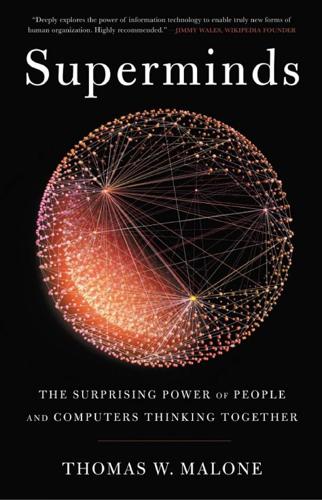
Superminds: The Surprising Power of People and Computers Thinking Together
by
Thomas W. Malone
Published 14 May 2018
Hill, Yogini Raste, and Ian Plumb, “The ‘Reading the Mind in the Eyes’ Test Revised Version: A Study with Normal Adults, and Adults with Asperger Syndrome or High-Functioning Autism,” Journal of Child Psychology and Psychiatry 42, no. 2 (2001): 241–51, doi:10.1017/S0021963001006643; Simon Baron-Cohen, Therese Jolliffe, Catherine Mortimore, and Mary Robertson, “Another Advanced Test of Theory of Mind: Evidence from Very High Functioning Adults with Autism or Asperger Syndrome,” Journal of Child Psychology and Psychiatry 38, no. 7 (1997): 813–22. Figure reproduced with author’s permission. 11. An adapted version of this figure was published in Anita Williams Woolley and Thomas W. Malone, “Defend Your Research: What Makes a Team Smarter?
…
More Women,” Harvard Business Review 89, no. 6 (June 2011): 32–33. The collective intelligence scores are normalized with 0 as the average across all scores. 12. David Engel, Anita Williams Woolley, Lisa X. Jing, Christopher F. Chabris, and Thomas W. Malone, “Reading the Mind in the Eyes or Reading Between the Lines? Theory of Mind Predicts Effective Collaboration Equally Well Online and Face-to-Face,” PLOS One 9, no. 12 (2014), http://www.plosone.org/article/info%3Adoi%2F10.1371%2Fjournal.pone.0115212, doi:10.1371/journal.pone.0115212. 13. Ishani Aggarwal, Anita Williams Woolley, Christopher F. Chabris, and Thomas W. Malone, “Cognitive Diversity, Collective Intelligence and Learning in Teams,” presented at the 2015 European Academy of Management Conference, Warsaw, Poland, June 17–20, 2015. 14.
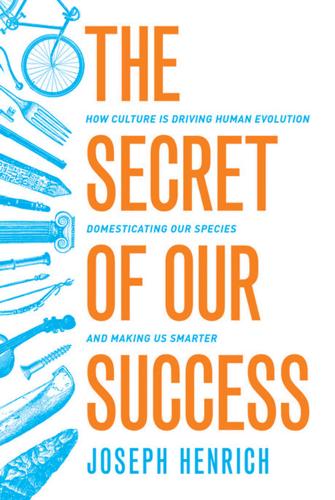
The Secret of Our Success: How Culture Is Driving Human Evolution, Domesticating Our Species, and Making Us Smarter
by
Joseph Henrich
Published 27 Oct 2015
If humans are a cultural species, then one of our most crucial adaptations is our ability to keenly observe and learn from other people. Central to our cultural learning is our ability to make inferences about the goals, preferences, motivations, intentions, beliefs, and strategies in the minds of others. These cognitive abilities relate to what is variously termed mentalizing, or theory of mind. Any learners who miss the boat on mentalizing and cultural learning, or get started too late, will be at a serious disadvantage because they won’t have acquired all the norms, skills, and know-how necessary to compete with other, better, cultural learners. This logic suggests that the mental machinery we need for cultural learning ought to fire up relatively early in our development.
…
Not only was the young girl scolded by the mother, to whom she wasn’t related, but she was ostracized by the other children until she complied with requests for help with infant care.17 Thus, social norms help explain why more distantly related and unrelated people supply 20% to 30% of direct child care in small-scale societies. The convergence of cultural learning and alloparenting gives rise to a synergy between the psychological abilities for caring for others and for cultural transmission—both are enhanced by mentalizing or theory of mind (see chapter 4) and by greater prosociality. Alloparents will be more effective when they can assess the desires, beliefs, and goals of those in their care and are motivated to meet those needs. Recent experimental work across fourteen primate species confirms this by showing that those species with more intensive alloparenting are more proactive in helping their group mates.
…
Mappes, and M. Puurtinen. 2011. “Costly punishment prevails in intergroup conflict.” Proceedings of the Royal Society B: Biological Sciences 278 (1723):3428–3436. Sabbagh, M. A., and D. A. Baldwin. 2001. “Learning words from knowledgeable versus ignorant speakers: Links between preschoolers’ theory of mind and semantic development.” Child Development 72 (4):1054–1070. Sahlins, M. 1961. “The segmentary lineage: An organization of predatory expansion.” American Anthropologist 63 (2):322–345. Salali, G. D., M. Juda, and J. Henrich. 2015. “Transmission and development of costly punishment in children.”
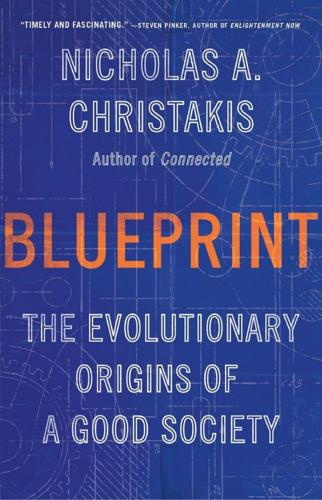
Blueprint: The Evolutionary Origins of a Good Society
by
Nicholas A. Christakis
Published 26 Mar 2019
That is, animal A knows about its own relationship to animal B and its own relationship to animal C, but it also knows something about the relationship between B and C. In its most evolved sense, seen in ourselves and our closest primate relations, this recognition reflects what is termed a theory of mind, meaning an individual’s ability to imagine the mental states of others and recognize that those states may be different from one’s own. In fact, some species have evolved not only a theory of mind but also, distinctly, a theory of relationships—which is evolutionarily advantageous, because recognizing relationships between other individuals helps predict their social behavior. The most basic type of such knowledge is when one animal knows the relative dominance rank of two other animals, not just its own rank with respect to the others.
…
The babies reliably chose the blue square when given a choice (colors and shapes were varied to be sure that those features were not driving the preferences).8 In other experiments, babies could tell the difference between puppets who helped or hindered actions attempted by other puppets. Babies preferred the good guys, and they disliked the jerks. Still other experiments involving puppets showed that thirteen-month-old babies have a “theory of mind,” meaning that they have an understanding of the mental states (knowledge, beliefs, intentions) of others, which is obviously crucial for moral reasoning and helpful for social life.9 In another set of experiments, toddlers spontaneously and without any prompting helped adults who were pretending to struggle with opening a cabinet.10 In short, at a very young age, humans appear pre-wired (in the sense of having a strong, innate proclivity) to interact in positive ways, with insight into the intentions of others and with a tendency to care about being fair.
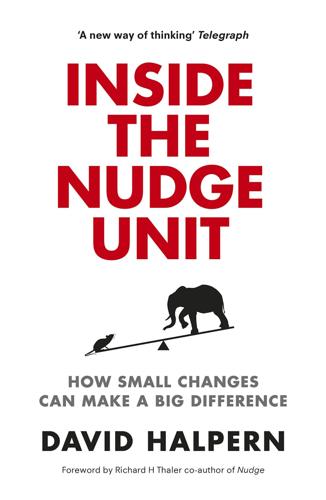
Inside the Nudge Unit: How Small Changes Can Make a Big Difference
by
David Halpern
Published 26 Aug 2015
Societies based on fishing or farming need different skills and temperaments from those living in times of conflict and war. We know so much more today than even a generation ago about how the way we raise our children affects their temperament and their ability to face life’s inevitable hardships. When we praise a child for their effort, rather than their ability, we instil in them a theory of mind that success in tasks, and the mastery of skills, is something that can be acquired through focus and effort. In contrast, if our feedback keeps linking their performance to inherent ability, when they struggle in the face of difficulty they will give up instead of striving harder.21 It is now thought that such patterns of thought, and mental resilience, not only affect how well a child will go on to perform at maths or music, but also ultimately affects their attainment and subjective well-being in later life.
…
In essence, children who are steered towards believing that a test result is a measure of their inherent ability (‘good result: you’re a smart kid’) show less persistence and lower subsequent performance on a difficult task than children who are steered towards believing that a test result is a measure of their effort (good result: good effort). In Dweck’s words, the latter type of feedback creates a ‘growth mindset’, or a theory of mind that personal achievements come from effort,8 leading the child to try harder and not give up in the face of personal challenge. As she demonstrates, these effects are very large. More positively, they suggest very practical and specific actions that parents and teachers can take to set a child on the road to personal discovery, resilience, and seizing the opportunities when they come along.

The Master Algorithm: How the Quest for the Ultimate Learning Machine Will Remake Our World
by
Pedro Domingos
Published 21 Sep 2015
Seen in this light, the learners we interact with every day are embryonic versions of the Master Algorithm, and our task is to understand them and shape their growth to better serve our needs. In the coming decades, machine learning will affect such a broad swath of human life that one chapter of one book cannot possibly do it justice. Nevertheless, we can already see a number of recurring themes, and it’s those we’ll focus on, starting with what psychologists call theory of mind—the computer’s theory of your mind, that is. Sex, lies, and machine learning Your digital future begins with a realization: every time you interact with a computer—whether it’s your smart phone or a server thousands of miles away—you do so on two levels. The first one is getting what you want there and then: an answer to a question, a product you want to buy, a new credit card.
…
If Bob is her boss, she tries to come across as competent, loyal, and hardworking. If instead Bob is someone she’s trying to seduce, she’ll be at her most seductive. We could hardly function in society without this ability to intuit and respond to what’s on other people’s minds. The novelty in the world today is that computers, not just people, are starting to have theories of mind. Their theories are still primitive, but they’re evolving quickly, and they’re what we have to work with to get what we want—no less than with other people. And so you need a theory of the computer’s mind, and that’s what the Master Algorithm provides, after plugging in the score function (what you think the learner’s goals are, or more precisely its owner’s) and the data (what you think it knows).
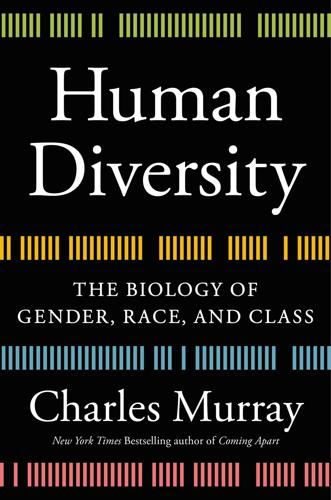
Human Diversity: The Biology of Gender, Race, and Class
by
Charles Murray
Published 28 Jan 2020
Perhaps many of the different types of skills are so intercorrelated that aggregating them would not add much to the largest individual effect size. It is a question that I hope will be explored. On Average, Women Have Better Social Cognition Than Men We take for granted that we can infer what someone else is thinking, but this inference is actually a theory—“theory of mind,” often abbreviated as ToM in the literature. It refers to our belief that other people have minds of their own that operate in ways we can understand. It is properly called a theory because the only mind we have direct access to is our own and because we can make predictions based on our theory.[45] Children acquire ToM as toddlers.
…
“Sequencing Y Chromosomes Resolves Discrepancy in Time to Common Ancestor of Males Versus Females.” Science 341 (6145): 562. Prediger, Dale J. 1982. “Dimensions Underlying Holland’s Hexagon: Missing Link Between Interests and Occupations?” Journal of Vocational Behavior 21 (3): 259–87. Premack, David, and Guy Woodruff. 1978. “Does the Chimpanzee Have a Theory of Mind?” Behavioral and Brain Sciences 1 (4): 515–26. Pritchard, Jonathan K., Matthew Stephens, and Peter Donnelly. 2000. “Inference of Population Structure Using Multilocus Genotype Data.” Genetics 155 (2): 945. Protzko, John, and Joshua Aronson. 2016. “Context Moderates Affirmation Effects on the Ethnic Achievement Gap.”
…
“Epigenetic Programming by Maternal Behavior.” Nature Neuroscience 7: 847. Weidenreich, F. 1946. Apes, Giants, and Man. Chicago: University of Chicago Press. Weiner, Jonathan. 1994. The Beak of the Finch: A Story of Evolution in Our Time. New York: Random House. Wellman, Henry M., and David Liu. 2004. “Scaling of Theory-of-Mind Tasks.” Child Development 75 (2): 523–41. Whitehurst, Grover J. 2013. “New Evidence Raises Doubts on Obama’s Preschool for All.” In Brown Center Chalkboard Series Archive. Washington, DC: Brookings Institution. Wicherts, Jelte M., Conor V. Dolan, and Han L. J. van der Maas. 2010. “A Systematic Literature Review of the Average IQ of Sub-Saharan Africans.”
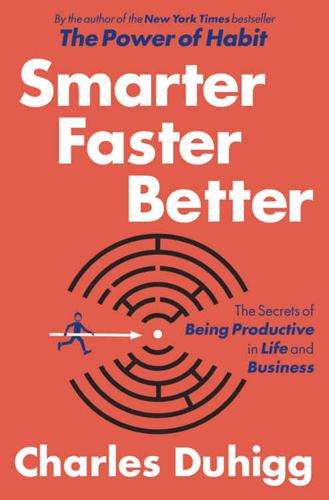
Smarter Faster Better: The Secrets of Being Productive in Life and Business
by
Charles Duhigg
Published 8 Mar 2016
So just as much as they can say something sharply funny, they can also jab you with a quick, hostile (but also funny) remark….The atmosphere at SNL, although we all liked each other, could become highly competitive based on the fact that there were 10 writers and only so many sketches could go on the show, so we all did our best to write the winning sketch or make (in my case) the best short film.” 58 percent The correct answers to the quiz are upset, decisive, skeptical, and cautious. These images come from Simon Baron-Cohen et al., “Another Advanced Test of Theory of Mind: Evidence from Very High Functioning Adults with Autism or Asperger Syndrome,” Journal of Child Psychology and Psychiatry 38, no. 7 (1997): 813–22. And Simon Baron-Cohen et al., “The ‘Reading the Mind in the Eyes’ Test Revised Version: A Study with Normal Adults, and Adults with Asperger Syndrome or High-Functioning Autism,” Journal of Child Psychology and Psychiatry 42, no. 2 (2001): 241–51.
…
More Women,” Harvard Business Review 89, no. 6 (2011): 32–33; Julia B. Bear and Anita Williams Woolley, “The Role of Gender in Team Collaboration and Performance,” Interdisciplinary Science Reviews 36, no. 2 (2011): 146–53; David Engel et al., “Reading the Mind in the Eyes or Reading Between the Lines? Theory of Mind Predicts Collective Intelligence Equally Well Online and Face-to-Face,” PloS One 9, no. 12 (2014); Anita Williams Woolley and Nada Hashmi, “Cultivating Collective Intelligence in Online Groups,” in Handbook of Human Computation, ed. Pietro Michelucci (New York: Springer, 2013), 703–14; Heather M.
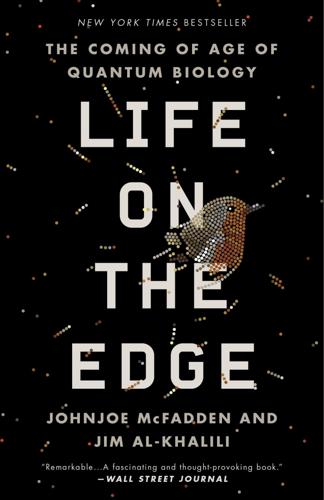
Life on the Edge: The Coming of Age of Quantum Biology
by
Johnjoe McFadden
and
Jim Al-Khalili
Published 14 Oct 2014
In this way the cell body of each nerve cell seems to be acting like the logic gate of a computer, generating an output—whether or not it fires—based on its inputs. So, if the neuron is like a logic gate, then the brain, made up of billions of neurons, might be thought of as some kind of computer; or at least, this is the assumption of most cognitive neuroscientists who subscribe to what is called the computational theory of mind. But we are jumping too far ahead—we haven’t yet reached the brain. Our artist’s motor nerve must have received lots of neurotransmitters in its nerve–nerve junction boxes, causing it to fire. Those inputs came from upstream nerves that mostly originated in her brain. Following the chain of causation back, the heads of those nerves would have made their decisions about whether or not they fired on the basis of their many inputs, and the inputs of those inputs, and so on further and further backward through the causal chain until we reach the nerves that received input signals from the artist’s eyes, ears, nose and touch receptors, and memory centers that would have received sensory inputs from her earlier observations of live and dead bison.
…
clownfish, see anemonefish cockroaches collagen: biomolecule collagenase action, 3.1, 3.2, 3.3 dinosaur fossil, 3.1, 9.1 role structure, 3.1, 3.2, 3.3 tadpole tail, 3.1, 3.2, 3.3, 3.4 collagenase: enzyme, 3.1, 3.2 how it works, 3.1, 3.2, 3.3, 3.4, 3.5, 3.6 jaws, 3.1, 3.2, 3.3, 3.4 role, 3.1, 3.2, 3.3, 3.4 structure, 3.1, 3.2 tadpole tail compass, avian entanglement mechanism, 1.1, 1.2, 1.3, 2.1, 6.1, 6.2, epl.1 magnetic sense, 1.1, 1.2, 6.1, 6.2 magnetite question radical pair reaction, 6.1, 6.2 role of light Schulten’s work Wiltschkos’ work compass, chemical, 1.1, 6.1, 6.2, 6.3 compass, conventional compass, inclination, 1.1, 1.2, 6.1, 6.2 compass, quantum compass, radical pair, 6.1, 6.2 compass, sun, 6.1, 6.2 complexity theory computational theory of mind computers, 8.1, 8.2, 8.3, 8.4 viruses Condon, Edward consciousness: binding problem, 8.1, 8.2, 8.3, 8.4 emergence EM field theories explanations function hard problem ideas, 8.1, 8.2, 8.3 ion channels, 8.1, 8.2 mechanics of thought Penrose-Hameroff theory quantum mechanical phenomenon, 8.1, 8.2, 8.3, 8.4 sense of “self,” what is it?
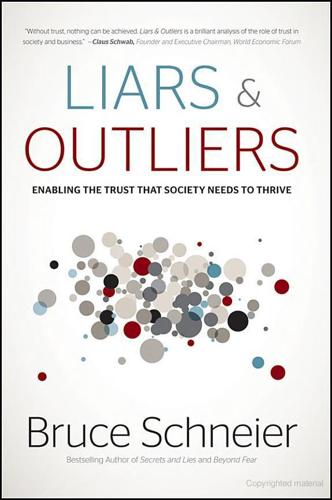
Liars and Outliers: How Security Holds Society Together
by
Bruce Schneier
Published 14 Feb 2012
Neuroscience may also help explain altruism, most recently using mirror neurons. These are neurons in our brain that fire both when we perform an action24 and when we observe someone else performing the same action. First discovered in 1992, mirror neurons are theorized to be critical in imitation and learning, language acquisition, developing a theory of mind, empathy, and a variety of other prosocial behaviors. Additionally, a large body of neuroscience research supports the notion that we are altruistic innately, even if we receive no direct benefit, because at a deep level we want to be. Studies using functional magnetic resonance imaging (fMRI) show that the amygdala, the primitive part of the brain associated with fear and anger, is involved in decisions about fairness and justice.
…
mirror neurons Giuseppe di Pellegrino, Luciano Fadiga, Leonardo Fogassi, Vittorio Gallese, and Giacomo Rizzolati (1992), “Understanding Motor Events: A Neurophysiological Study,” Experimental Brain Research, 91:176–80. Vittorio Gallese, Luciano Fadiga, Leonardo Fogassi, and Giacomo Rizzolatti (1996), “Action Recognition in the Premotor Cortex,” Brain, 119:593–609. Vittorio Gallese and Alvin Goldman (1998), “Mirror Neurons and the Simulation Theory of Mind-Reading,” Trends in Cognitive Sciences, 2:493–501. altruistic innately Ernst Fehr and Simon Gächter (2002), “Altruistic Punishment in Humans,” Nature, 415:137–40. Alan G. Sanfey, James K. Rilling, Jessica A. Aronson, Leigh E Nystrom, and Jonathan D. Cohen (2003), “The Neural Basis of Economic Decision-Making in the Ultimatum Game,” Science, 300:1755–8.
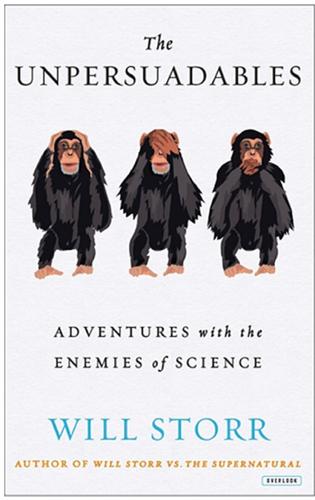
The Unpersuadables: Adventures With the Enemies of Science
by
Will Storr
Published 1 Jan 2013
Was resolution found? What valuable information can be harvested and fed into the neural models? * The brain constructs its models during childhood and adolescence, the period in which it is extraordinarily alive with creative activity. By the age of five, children have developed a sophisticated ‘theory of mind’ and are, therefore, ‘story-ready’. During our formative years we absorb many thousands of tales of ever-increasing complexity of message. Professor of Psychology Keith Oatley has observed that learning to negotiate the social world requires weighing up ‘myriad interacting instances of cause and effect.
…
Holman Foundation 118 chemotherapy 35, 93 Chibnall, Albert 256, 257 chick-sexers 186–87 childhood abuse 165–72, 173–75, 176–78, 179 sexual 145, 146, 156–57, 162, 180 children 75 China 83 Christ Church, Oxford 200, 201 Christians 4, 6, 7, 133, 134 condemnation of homosexuality 14–15, 18 morality 15–16, 122 see also creationists Churchill, Winston 208, 235, 249, 250 Clancy, Susan 50 climate-change sceptics 200, 203–204, 216 Clinic for Dissociative Studies 171 Clinton, Hilary 118 Coan, Chris 166–67 Coan, Jim 166–67 cochlear implants 78 cognitive bias 85, 87–88, 90–91, 103–104, 111, 183, 186, 244, 272 see also confirmation bias cognitive dissonance 84–87, 96, 102, 181 coin toss tests 262 Colapinto, John 312 cold war 149, 212, 215 Coleman, Ron 136–37, 141, 146, 148, 157, 162, 186, 306 colour, perception of 80 Committee for the Scientific Investigation of Claims of the Paranormal (CSICOP) 275 Communists 212, 222, 249–50 con artists 107 concentration camps 220–21, 224, 230, 245 confabulation 189–90, 192–96, 203, 207, 218, 253, 307, 315 confirmation bias 85, 87, 96, 181, 182, 188, 221, 243, 246, 312 consciousness 267–68 as Hero-Maker 306 conviction, unconscious 33 Conway, Martin 201 Cooper, Alice 275 Copenhagen Climate Conference 204 Copenhagen Treaty 2009 216 core beliefs 183 cows, sacred 40 Creation Research 5 Creation Science Foundation 12 creationists 2–10, 13–19, 20, 26, 30, 100, 162, 261, 308, 310 Crick, Francis 258, 268 CSICOP see Committee for the Scientific Investigation of Claims of the Paranormal culture, power of 211, 302 ‘culture heroes’ 311 ‘culture wars’ 30, 309 Daily Mail (newspaper) 225, 228, 232 Daily Telegraph (newspaper) 243–44, 263 Dali, Salvador 275 Darwin, Charles 2, 10, 11, 94 Davenas, Elisabeth 110–11 Dawkins, Richard 2, 6, 10, 19, 94, 142, 259, 261, 271, 272, 287, 290, 308 DDT 211 de-individuation 69 deafness 78, 82 decision-making 181, 267 and emotion 184–85, 189 dehumanization 69–70 delusions 103–104, 130, 178–79, 182, 272 finding evidence for 135 and Morgellons 120 of parasitosis (DOP) 120, 122, 124, 125, 129, 162 democracy, end of 216 Demon-Marker function 308–309 depression 33, 43, 45, 128, 141, 148 Dermatologic Therapy (journal) 128 development factors 183 Devil, Australia see Gympie Diagnostic and Statistical Manual of Mental Disorders (DSM) 143, 144 dialogue-ing 149, 151–52 Diana, Princess of Wales 286 diazepam (Valium) 42 dinosaurs 13, 19 Dog World (magazine) 293–94 dogma 106–107, 258 domestic abusers 89 DOP (delusions of parasitosis) 120, 122, 124, 125, 129, 162 dopamine 155, 196 doubt 133, 257 sensitivity to 261 dragons 13 dreaming 193, 195 lucid 76 drunkenness, cultural determinants of 83–84 DSM see Diagnostic and Statistical Manual of Mental Disorders Eagleman, David 74, 79, 80, 185, 186, 192, 193, 268–69 eccentricity 310 Economist, The (weekly publications) 312 Eden 14 Eden, Anthony 208 Edward V111 208 ‘effectance motive’ 184 ego 224 dream 195 ego-bolstering, unconscious 96, 103, 181 egoists 88, 196 Eichmann, Adolf 245 Einstein, Albert 201, 285 Eliade, Mircea 302 emotions 183, 184–85, 187, 194, 305 and beliefs 188, 189, 196–97 culturally unique 83 and decision-making 184, 185, 187 see also anger; happiness energy clean 25 Enfield Gazette (newspaper) 280 Enfield Poltergeist case 280 Enlightenment 255 envy 218 epinephrine 189–90 Epley, Nicholas 88 escapology 273–74 ESP see extrasensory perception Ethics Committee of the Federal Australian Medical Association 39 European Union (EU) 212 European Union Parliament House 234 Evans, Dylan 83 Evans, Richard 224 Eve 5, 12 Eve, Mitochondrial 73 Everett, Daniel 312 evidence, denial of 221, 261 evil psychology of 69–70, 307–308 ‘supremely good’ motivations for 89 evolution 73 arguments against 2–7, 10–13 arguments for 19–20, 100–101 experimental psychology 88, 101, 142, 316 extrasensory perception (ESP) 255, 266, 274, 294 alien 24 sense of ‘being stared at’ 254–55, 258, 262 facts and belief 183 inefficiency 26 fairies 83 faith, as journey 21, 134 false memories 156, 165–70, 173–74, 178, 194 familiar, the, attraction to 183 ‘fan death’ 83 Fate magazine 281 fear 203, 205, 206 Feinberg, Todd E. 82 Felstead, Anthony 160, 164 Felstead, David 159–60, 164, 171, 175, 176 Felstead, Joan 164 Felstead, Joseph 160, 161, 164, 165 Felstead, Kevin 160, 161, 164 Felstead, Richard 159–160, 164, 176–77 Felstead family 163, 165, 166, 168, 170, 176 Festinger, Leon 85, 188 Financial Service Act 214 First World War 231 Fisher, Fleur 161, 163, 165, 166, 176, 307 Flim Flam (Randi, 1982) 271, 279, 288, 295 Flood, biblical 14 fMRI see Functional Magnetic Resonance Imaging foetal development 74 fossil record 10, 13–14, 19, 101 Fourth Annual Morgellons Conference 121–28 Fox, Kate 84 Franklin, Wilbur 282, 293 free will 193, 217, 307 as confabulation 193 French Assembly 204 French, Chris 50, 104, 108, 169, 173, 288, 315 French Revolution 204 Freud, Sigmund 171, 302 Frith, Chris 70, 77, 206, 315 Fromyhr, Liam 13 Functional Magnetic Resonance Imaging (fMRI) 71 fundamentalists 261 Garvey, James 203, 218 Gates, Bill 212 Gazzaniga, Michael 184, 190–92 Geertz, Clifford 75 Geller, Uri 99, 275, 280, 281, 287, 288, 290, 293 genes 221 genetic factors 205 and beliefs 221 and political attitude 205 and schizophrenia 145, 154 genome 205, 206 Genus Epidemicus 115 George, St, and the dragon 13 ghost-hunters 21 ghosts 104 Gilovich, Thomas 86 Gindis, Alec 277, 278 global financial crisis 213 global governance 216–217 global warming 203 gnomes 83 God 17, 202, 305 Catholic interpretations of 21 and creation 3, 4, 5–6, 10 creation of 26 Darwin’s arguments against the existence of 11 deference to 18 existence of as scientifically testable 11 knowableness of 11, 22 and morality 15 see also anti-God rhetoric Goebbels, Joseph 230, 232, 239, 245 Goenka, S.N. 57, 60, 61–63, 306 Goldacre, Ben 97 Göring, Hermann 232 Gottschall, Martin 25–26 Gottschall, Sheryl 26 governance, models of 217 Gray, Honourable Mr Justice 221, 223 Gray, John 81 Great Rift Valley 74 ‘greys’ (aliens) 23, 33 group psychology 69, 88, 197 conformity to group pressure 70, 72 and the production of evil 70 Guardian (newspaper) 6 Gururumba tribe 83 Gympie, Australia 2–7, 10, 14, 16, 22, 33–53 gympie-gympie tree 2, 19 Hahnemann, Samuel 96, 115 Haidt, Honathan 83, 184, 193, 194–95, 205, 216–17, 315 Hale, Rob 172 hallucinations 82 auditory 137, 139, 141, 144, 145 see also voice-hearing visual 152 halo effect 84 Ham, Ken 12 happiness, and religious belief 197 ‘hard problem, the’ 267 Harrow 209 Harvard University 28–29, 30, 50, 285 Hawthorne Effect 107 hearing, sense of 262 Hearing Voices Network (HVN) 137, 140–41, 154, 162 Hebard, Arthur 279, 280, 295 Hebb, Donald 266 herbal remedies 36 Hercules 302 hero, the, how your memory rebuilds you as 194, 231 hero narratives 302–303, 306–309, 311–13 parasite 307, 312 Hero-Maker 306–307, 310–311, 312, 314 Heydrich, Reinhard 245 Himmler, Heinrich 235 Himmler bunker 236, 245 Hitler, Adolf 228, 231, 238, 239, 242, 243, 244, 246, 247, 248, 151–52 Hitler Youth 204 Hitler’s bunker 238 HIV 207 see also AIDS HMS Edinburgh (ship) 231 Hoefkens, Gemma 92–95, 96–97, 115–16, 141, 142, 181, 310 Holocaust denial 155, 221, 226, 229–30, 243, 244 Homeopathic Research Institute 109 homeopathy 94–102, 105–107, 109–121, 134, 181, 269, 277, 278 evidence for 106–114, 121, 134, 269 ‘overdose’ protest against 96, 99, 105, 108–109 ‘radionic’ method 115 Homerton Hospital 132 hominins 74 Homo sapiens 73 homophobia 188 homosexuality 137 Christian condemnation of 14–15, 18 Horsey, Richard 186 Horst Wessel Song (Nazi Party anthem) 239 House of Commons Science and Technology Committee 94 Hrab, George 108 Hume, David 203 Humphrey, Nicholas 43 Huntington’s disease testing 197 HVN see Hearing Voices Network hypnotherapy and false memory generation 166 and past-life regression 44–45, 47 hypnotism 189 ‘I’, sense of 194, 196, 258 IBS seeirritable bowel syndrome Iceland 83 identity 203 ideology 272 Illuminati 286–87, 288, 304 imitation 206 immigration 206, 223 Mexican 223 in-groups 84, 133 incest 168 information field 257, 266 INSERM 200 110 intelligence, and cognitive bias 224 Intergovernmental Panel on Climate Change (IPCC) 216 International Academy of Classical Homeopathy 277 Internet 112 intuition 187, 216, 238 irritable bowel syndrome (IBS) 43 Irving, David 269, 307, 308, 209, 333–335, 344, 345 Irving, John 219, 221, 238, 244 Irving, Nicholas 243 itch disorders 117–119 see also Morgellons Jackson, Peter 312 James, William 106 James Randi Educational Foundation (JREF) 99, 260, 275, 276, 290, 294 jealousy, sexual 64, 66, 104 Jesus 142 knowableness of 11 Jewish Chronicle (newspaper) 230 Jews 221, 230, 231, 244–51, 253, 309 see also Holocaust denial Josefstadt Prison, Vienna 220 Journal of the American Medical Association 41 Journal of Clinical Epidemiology 113–114 Journal of Philosophical Studies 182 JREF see James Randi Educational Foundation Jutland, Battle of 231 Kahneman, Daniel 184, 303 Kaku, Michio 27 Kaptchuk, Ted 43 Keegan, Sir John 243–44 Keen, Montague 284 Keen, Veronica 283–88, 304 Kerry, John 87 KGB 212, 215 Kilstein, Vered 44–51, 53, 168, 305–306 King’s Cross station 136 ‘koro’ 83 Krepel, Scott 78 Krippner, Stanley 288–89, 295 Krupp 233 Kuhn, Deanna 86 Los Angeles LA Times (newspaper) 118 LaBerge, Stephen 76, 195 Labour Party 210 Lancet (journal) 109, 113 Langham, Chris 171 Lawrence, Stephen 236 Lebanese people 223 left, political 204–207, 211, 215 Leitao, Mary 118 Leitao’s Morgellons Research Foundation 118 Lemoine, Patrick 42 Lennon, John 49 Letwin, Oliver 214 Leuchter, Fred 229 Leviticus 14 Lewis, Andy 109, 114 Lipstadt, Deborah 221, 224, 243, 246, 309 Literary and Scientific Institutions Act 1854 210 Lo, Nathan 19–20, 22, 30, 100, 308 Loftus, Elizabeth 166, 173 love 44, 59 memories of 63, 133 Lucifer 4 see also Satan McCain, John 118 McCullock, Kay 23–25 McDonald’s 67–68, 84 Mack, John E. 28–30, 51, 102–103, 142, 145, 272, 284–85 Mackay, Glennys 22–23, 30, 33 Mackay, John 1, 4–6, 1–11, 15–20, 30, 33, 53, 91, 100, 109, 182, 305, 306, 308 MacLeish, Eric 29 Maddox, Sir John 271, 287 magic-makers 7 magnetometers 279 Majdanek concentration camp 224, 230 Mameli, Matteo 182 manic depression 141 Mann, Nick 130–31, 134, 162 Marianna, Dame of Malta 208 Marshall, Michael ‘Marsh’ 105–109 Marxists 210 ‘matchbox sign’ 124 materialism 256, 257–58, 259, 260–1, 266, 268–69 May, Rufus 148–49, 156, 182, 196, 304 meditation, Buddhist 52–53, 62, 182, 196 Meffert, Jeffrey 120 Mein Kampf (Hitler) 232, 233, 242 memory autobiographical 194 fallibility of 201 see also false memories; recovered- memory therapy mental illness 137, 141, 146, 147, 165 as continuum 147 depression 33, 42–43, 45, 89, 100, 120, 148, 197 manic depression 141 multiple personality disorder 165, 171, 173–74 obsessive compulsive disorder 128 sectioning 137, 140, 161 see also psychosis; schizophrenia mental models 76, 85, 87, 90, 102, 133, 142, 147, 183, 302, 303, 316 meta-analysis 112, 146, 157, 262, 267 Metzinger, Thomas 195 Mexican immigration 223 micro-stories 206 Milgram, Stanley 70–71 mind and the brain 255, 257–58, 266–67 as ‘out there’ 267 theory of 303 miners’ strike (mid-1980s) 212, 214–15 Mitchell, Joni 118 mites, tropical rat 132, 135 ‘Mitochondrial Eve’ 73 Moll, Albert 189 Monckton, Christopher Walter, 3rd Viscount Monckton of Brenchley 200, 203–205, 207–16, 218, 304, 305, 309, 310 Monckton, Major General Gilbert, 2nd Viscount Monckton of Brenchley 208 morality 193, 202 Christian 15 Morgellons 118–35, 162, 307 see also Fourth Annual Morgellons Conference, Austin, Texas morphine 41 Mosley, Sir Oswald 232 Mragowo 233 multiple personality disorder 165, 171, 173–74 murder, past-life 44, 48 murderers 89 Murray, Robin 183 Myers (formerly Felstead), Carole 159–61, 163–66, 168, 171–73, 176–80, 307 myoclonic jerk 195 myth 302, 304, 312–313 narratives hero 302–303, 306–14 master 206 nation state, end of 216 National Front 234, 305 National Health Service (NHS) 94, 148, 171 National Secular Society 5 National Union of Teachers 5 Native Americal tradition 186 Natural History Museum 132 natural selection 10 Nature (journal) 110–11, 257, 271, 287, 304 Nazi Party (German) 220, 239 Nazis 48, 89, 231, 239 Neanderthals 26 necrophilia 12, 18 neurological studies 87 neurons 74–75, 220, 253, 267 neuroscience 142 New Guinea 83 New Science of Life, A (Sheldrake) 256–57 New Scientist (journal) 257–266 New York Times (newspaper) 72, 120, 271, 272 New Yorker (magazine) 268, 312 Nix, Walte, Jr. 68 Noah 3, 5, 13, 14 Novella, Steven 107, 112, 120, 135, 272, 287, 309 Oaklander, Anne Louise 129–130 Oatley, Keith 303 Obama, Barack 118, 286 obedience studies 84 Observer (newspaper) 222, 257 obsessive compulsive disorder (OCD) 128, 147 Oedipus 302 Offer, Daniel 194 Ogborn, Louise 67–68, 70, 84 Olsen, Clarence W. 82 openness 205 Origin of Species, The (Darwin) 2, 4 original sin 3 Orkney 166 ‘other people’, judgement of 67 out-groups 69, 105 Oxford Union 203, 207, 218 paedophilia 15 pain perception of 41 and the placebo effect 41, 42–43 palm reading 105 paranoia 30, 64, 150, 154, 178, 180 parapsychology 261–62, 265–67, 269, 279, 280, 287 past-life regression (PLR) 44–45, 47, 53, 168, 170 Patanjali Yog Peeth Trust 31 Paul McKenna Show, The (TV show) 263 Pearson, Michele 119 penis ‘koro’ effect 83 phantom 82 Penn and Teller 271, 290 perception and the brain 72, 76 of pain 41 and the placebo effect 41, 42, 43 of reality 27, 72, 76–77, 80, 81 see also extra-sensory perception peripeteia 303 Perkins, David 244 personality disorder 165 see also multiple personality disorder pesticides 211 Peter March’s Traveling Circus 274 Peters, Maarten 50 ‘phantom limbs’ 82 ‘Pagasus’ awards 260, 276, 288 Pirahã tribe 312 placebo effect 41–43, 45–46, 50–51, 53, 72, 107, 113, 134 and homeopathy 107, 113, 134 Playfair, Guy Lyon 280–82, 287, 293 political affiliation 205 political beliefs, and self-interest 217 political left 204, 206, 210, 211 political right 204, 205 Polonia Palace Hotel, Warsaw 219 poltergeists 280 Popoff, Peter 288 power, leftwing 211–12 Power, Joe 105, 106 ‘Pranayama’ (breath control) 32–36, 38, 40, 41, 45, 56, 134, 196 prefrontal cortex 73 prejudice 29, 53, 84, 86, 90, 100, 181, 248, 305 Pressman, Zev 280–82, 286, 288, 295 prophets 307 Prozac 42 psi phenomena 265–66 see also parapsychology psychiatry 28–29, 42, 71, 120, 130, 136, 137, 140–41, 142–43, 145–46, 150, 152, 162, 183, 189 psychic powers 253 animals with 258, 260, 261, 265, 266 testing 253, 258, 260, 263, 274, 279–80 psychics 98, 104 psychology of evil 69–70, 105, 243, 307 experimental 88, 101, 142, 316 parapsychology 261–62, 265, 266, 267, 269, 280, 287 situational 69 see also schizophrenia 157, 180, 310 Puthoff, Harold 279, 280 racism 104, 221, 223, 229, 305 radiotherapy 35, 401 Ramachandran, V.S. 75, 81, 82 Ramdev, Swami 31–41, 43, 134, 182, 306 Randi, Angela 291 Randi, James 98–99, 107, 108, 109–110, 112, 260–61, 269, 270, 271–98, 306, 309, 310, 312, 313 blindness to his own cognitive biases 272 childhood 273 death threats 275, 306 early adult life 274 emotional problems 292 homosexuality 292 interview with the author 291–98 psychic challenge prize 99, 260, 272, 276, 277, 278, 289 social Darwinism 296, 297 views on drug users 296–97 see also James Randi Educational Foundation Rank, Otto 302 Rasputin study 88, 103 rationalists, radicalised 9 reality, perceptions of 27, 72, 76–77, 80, 81, 91 ‘reality monitoring’, errors in 50 reason 26 inefficacy of 26–27 as not enough 309 recovered-memory therapy (RMT) 166, 170, 173, 176 Rees, Laurence 311 ‘regression to the mean’ 45 religious belief, and happiness 197 religious conversion mechanisms of 8 repression 169 right, political 204–207 Robertson, Shorty Jangala 300 robots, alien 23, 33 Rogo, Scott 279 Romme, Marius 137, 140, 143–45, 148, 154, 155 Rosenbaum, Ron 245 Royal College of Psychiatry 154 Royal Free Hospital, Camden 136, 139 Royal Institute of Philosophy 203 Royal Society 5 saccades 79 sacredness, irrationality surrounding 217 Sagan, Carl 266 Santayana, George 209 Satan 18 see also Lucifer santanic abuse 165–66, 168–70, 174–75, 177, 180 Saucer Smear magazine 281 Savely, Ginger 126, 127, 130 Schizophrenia 51, 136–37, 140, 141, 143, 145, 148, 150, 154, 162, 169, 178, 183, 309 as salience disorder 183 Schlitz, Marilyn 262 Schmidt, Stefan 262, 265 Schwartz, Gary 287, 188–89 science 8–9, 95–96, 255–59, 268, 273, 310 scientific method 305 Scientologists 155 sectioning 137, 140 Secular Student Alliance 290 Seeman, Mary 120 Segal, Stanley S. 172 self ideal 148, 313 multiple selves model 147 senses 77–91, 190, 196, 258 sensory deprivation 78 sexism, unconscious 86 sexual abuse 145, 146, 156–57, 162, 180 sexual assault 145–46 sexual jeaoulsy 64, 66, 104, 212 Shang, Aijing 112, 113–14 Sheldrake, Rupert 255–61, 262–70, 272–73, 276–77, 287, 289, 293–94, 307 Shermer, Michael 102 Silent Spring, The (Carson) 211 sin 17–18, 61, 66, 189 original 2 Sinason, David 171, 175, 179 Sinason, Valerie 170, 171, 178, 180, 304 Singer, Peter 304 situational psychology 69 Skeptic, The (magazine) 104, 108, 169, 271, 288 Skeptics 9, 95–112, 115, 120–21, 134, 142, 162, 260, 265, 271–73, 276–79, 290–91, 298, 309–310, 313–14 and Morgellons 134 and psi phenomenon 265–66, 279 and Sheldrake 260 ‘The Amazing Meeting’ of 290 see also Randi, James sleep 195 smell, sense of 184 Smith, Greg 122, 124, 130, 131 social Darwinism 296, 297 social roles, and the production of evil 69–70, 105 socialism 212 Sorel, George 304 ‘source-monitoring error’ 50 South Koreans 83 Soviet Union 212 sprinal tumours 129 spirituality 26 ‘split-brain’ patients 190–92 spoon-benders 98 spotlight effect 89 Stalin, Joseph 234 Stanford Prison Experiment 69–70 Stern Review 310 Stipe, Catherine 6 storytelling 183, 188, 189, 192, 194, 302, 206, 207, 312 see also confabulation; narratives ‘strip-search scams’ 68–69, 84 stroke patients 82 suicidal ideation 147 suicide 144 and voice-hearing 151, 154 Summers, Donna 67 survival of the fittest 3, 296–97 taboo violation scenarios, harmless 194 Targ, Russel 279, 280 Tavris, Carol 84, 88, 194, 243 Tea Party movement 204204 telepathy 257–59, 266, 269, 280 terrorism 9 Thatcher, Margaret 174, 204, 208, 212, 215 theft 66, 104 theory of mind 303 therapy 45, 169 group 133 placebo effect 45 This American Life (US radio show) 78 Thyssen 233 Time magazine 102 Times, The (newspaper) 263 ‘tjukurpas’ (Aboriginal stories) 275 Toronto Evening Telegram (newspaper) 274 Toronto Star (newspaper) 293 totalitarianism 216 Tournier, Alexander 109, 112, 113 traumatic experience repression 166 and voice-hearing 137, 139–41, 143–45, 148–49, 150–58 tribalism 84–85, 133, 171, 196, 217 truth 218 coherence theory of 218 and group pressure 44–45 and storytelling 312–13 Turing, Alan 266 Turner, Trevor 154–57, 162, 169, 178 twin studies 205 UFOs 22–27, 29–30, 272, 308 UK Independence Party (UKIP) 204 Ullman, Dana 107, 112, 309 Ultimate Psychic Challenges, The (TV Show) 284 unconscious 33, 44, 58–59, 60, 41–42, 183–88, 194, 269–70, 304 United Nations (UN) 216, 304 US Armed Forces Institute of Pathology 119 Vipassana Meditation Centre 52–53, 55, 57, 70 vision 79–80, 92–93, 96 Vithoulkas, George 99, 277–79, 295–96 voice-hearing 136–45, 148–59, 162, 169, 180 Wade, Kimberly 168–69 Warren, Jeff 76 Washington Post (newspaper) 120, 328, 344 water dreaming 300 Watson, Rebecca 107 ‘we mode’ 70 Wegner, Daniel 193, 331 welfare state 209–10 Western, Drew 87, 204, 206–7 Western medicine, disillusionment with 36, 39–40, 182, 306 Wexler, Bruce E. 75, 183, 185, 303 ‘wild pig, being a’ 83 Wilson, David Sloan 304 Wilson, Timothy D. 81 Wired (magazine) 271 Wiseman, Richard 259–66, 271–72, 287, 290, 335–37 Wolpert, Lewis 183–84, 189, 259, 313 Wootton, David 42 wormholes 27 Wymore, Randy 121–22, 124, 126, 128 yoga 31–39 Yuendumu 299–300 Zimbardo, Philip 68–70, 72, 104 WILL STORR is a novelist and longform journalist.
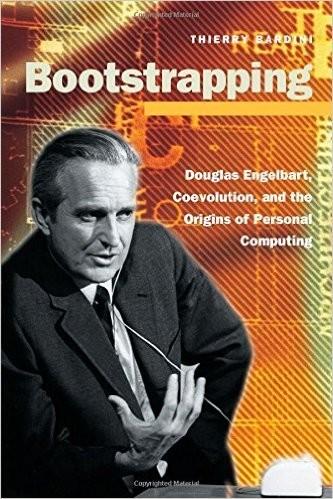
Bootstrapping: Douglas Engelbart, Coevolution, and the Origins of Personal Computing (Writing Science)
by
Thierry Bardini
Published 1 Dec 2000
Actually, in the ten oral history interviews of some of the major actors of the IPTO community that I downloaded from the Charles Babbage Institute project, only a couple still mention Engelbart's contribution for more than the mouse, and several do not mention him at all. Chapter I I. In his chapter of the edited collectIon The BoundarIes of HumanIty, Allen Newell expresses dIssatIsfactIon with metaphorIcal thinking in general: "it is clearly wrong to treat science as metaphor, for the more metaphorical, the less scientific." For him, AI is about a theory of mind, and not a metaphor for the mind: it should provide organized knowledge about the mind (Newell 1991, 161-63). In his general introduction to the same collection, Morton Sosna, however, echoes AI critics who "have questioned whether AI has remained, or can or ought to remain, unmeta- phorical" (ibid., 7).
…
Journal of the InstItutIon of ElectrIcal Engineers 47: 450 - 5 2 9. Nelson, T. H. 1990. "The Right Way to Think About Software DesIgn." In The Art of Human Computer Interface Design, edited by B. Laurel, pp. 235-43. Reading, Mass.: Addison-Wesley. Works C,ted 271 Newell, A. 1991. "Metaphors for Mind, Theories of Mind: Should the Humanities Mind?" In The Boundaries of HumanIty: Humans, AnImals, MachInes, ed- ited by J. J. Sheehan and M. Sosna, pp. 158 -97. Berkeley: UnIversity of California Press. Newman, W. M. 1976. "Trends in Graphic Display Design." IEEE TransactIons on Computers C-25, no. 12: 1321-25.
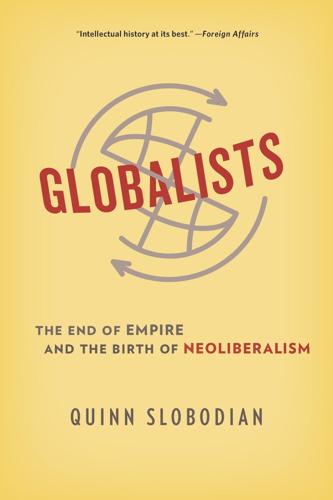
Globalists
by
Quinn Slobodian
Published 16 Mar 2018
By the end of the 1970s, there was a Geneva School consensus in the primary international institution devoted to governing trade, the GATT, that “distortions” of the price system were not economic problems but political problems. Beginning in 1977 these were seen as best solved through processes of constitutionalization modeled on the multitiered structure of the European Community. If Hayek “frequently uses machines to illustrate his theory of mind,” as one scholar observes, Geneva School neoliberals used Hayek’s theory of mind to illustrate world economic order.233 Hayek’s inability or unwillingness to engage with mathematics and statistics kept him off the main road taken by economists inspired by cybernetics and systems analysis.234 In Geneva School neoliberalism, we find Hayek’s influence not in the field of economics but in the field of law.

The People vs Tech: How the Internet Is Killing Democracy (And How We Save It)
by
Jamie Bartlett
Published 4 Apr 2018
You once queued to pick up (and pay for) photographs that you took a week ago, without knowing if they were even any good. The result is a growing disconnection between the choice and freedom that characterise our lives as consumers, and the compromise and tedious plodding world of politics. Note how, for example, so many people who disagree with Brexit use the language of a small child that has yet to develop a theory of mind: why should I accept the result, I didn’t vote for it and I want my country back.* Second of all, the internet is primarily an emotional medium, which is something that many technologists fail to grasp. Speed and emotion are related, of course, because both are means by which our finite brain handles information overload and total connectivity.
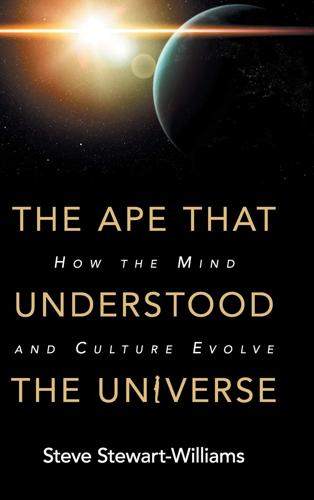
The Ape That Understood the Universe: How the Mind and Culture Evolve
by
Steve Stewart-Williams
Published 12 Sep 2018
But cumulative cultural evolution can give rise to entities every bit as complex as the eye: airplanes and smart phones, legal systems and the Internet. What makes these cumulative cultural achievements possible for us when they’re not possible for chimps or howler monkeys? No one knows for sure, but there are plenty of suggestions. These include language, theory of mind (that is, the ability to construe people as having thoughts, desires, and intentions), mental time travel, hypercooperativeness, practice, teaching, trade, shared attention, joint attention, imitation, true imitation, and overimitation – or, of course, some serendipitously fertile blend of these talents.
…
F. 10, 225 Smith, Adam, 235 smoking, 5, 45, 51, 53, 242, 252, 253, 296, 297, 303 snow monkeys, 66, 91 social psychology, 130, 133, 134, 177–178, 240, see also psychology Social Role Theory, 99–100, 106–107, 113, 116, 313n117 social sciences, 39, 42, 62, 64–65, 112, 114, 117, 123, 192, 283, 289–290, 294, see also Standard Social Science Model (SSSM) sociobiology, 40, 65, 68, 77, 289, 293, 310n8 Sociobiology: The New Synthesis, 157 Sommers, Christina Hoff, 102, 117 spandrels, 57, see also by-product hypothesis speciation in cultural evolution, 227 Spencer, Herbert, 20 Sperber, Dan, 298–299 sperm competition, 169–170, 291 spiders, 4, 11, 37, 51, 53, 54, 66, 73, 90, 110, 185, 188 sports, 62, 106, 202, 242, 255 stabilizing selection, 278 Standard Social Science Model (SSSM), 40, 308n32, see also blank slate view of human nature Star Trek, 122 Steinem, Gloria, 56 Stendhal, 139 Stephens, William, 146 stepparental care, 157–161evolution of, 160–161 stink fights, 67 Story of the Human Body, The, 55 strawberry cheesecake hypothesis, 60, see also by-product hypothesis Streep, Meryl, 148 strong reciprocity, 206, 207, 208–209 suicide, 6, 55, 103, 137–138, 142, 143, 176, 185, 192, 213, see also copycat suicide supernormal stimuli, 52, 60 survival of, the fittest, 20 the fittest genes, 31 the fittest memes, 253, 269 the fittest theories, 229 the prettiest, 120–129 the species, 7, 18–20, 141, 156 the weakest, 278–279 swans, 148, 149 Symons, Donald, 58, 78, 81–82, 83, 89 Tallis, Frank, 138 Taylor, Timothy, 279 technology, 13, 49, 234, 236–237, 244, 272–273, 275, 278–279, 294 teddy bears, 13, 227–228, 261 Tennov, Dorothy, 138–139 termites, 13, 132, 176, 231, 232233 testicle size, see sperm competition testosterone, 128, 170–171, see also sex differences theory of mind, 233, 298–299 Thomas, Andrew G. 72, 76 Thought Contagion, 257 throwing, 273 thumb-sucking, 57–58, 61 tigers, 16, 68, 170, 270271 Tit-for-Tat, 198–200, 201 tolerated theft, 204 Tomasello, Michael, 234 Tooby, John, 40, 46, 47, 50 Top Ten sex differences in nonhuman animals, 66–68, 74, 77 toy boys, 94 tragedy of the commons, 197–198 Trivers, Robert, 68, 69, 70, 72, 193, 194, 196, 197, 198–199 Tucker, Philip, 228–229 Tutankhamun, 136 twins, 25, 69, 182–183, 184, 248, 286 Tylor, E.

SuperBetter: The Power of Living Gamefully
by
Jane McGonigal
Published 14 Sep 2015
But what’s really special about syncing during game play is best explained by what psychologists call theory of mind, which is short for having an accurate theory of what’s going on in someone else’s mind. When you’re playing a game with someone else, you spend a tremendous amount of time trying to anticipate what they’re going to do next. This is true whether you’re playing cooperatively or competitively: the more you can accurately model what your coplayer is thinking, the more successful you’ll be in the game. Game play requires a powerful theory of mind, much more so than ordinary social interactions.11 Compared with taking a walk together or having a conversation, game play—with all its unpredictability and constant decision making—demands much tighter and more sustained synchronization.
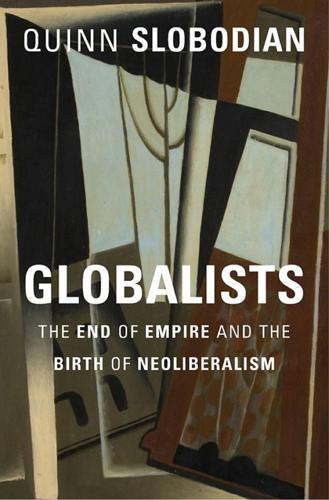
Globalists: The End of Empire and the Birth of Neoliberalism
by
Quinn Slobodian
Published 16 Mar 2018
By the end of the 1970s, t here was a Geneva School consensus in the primary international institution devoted to governing trade, the GATT, that “distortions” of the price system were not economic problems but political problems. Beginning in 1977 these were seen as best solved through processes of constitutionalization modeled on the multitiered structure of the European Community. If Hayek “frequently uses machines to illustrate his theory of mind,” as one scholar observes, Geneva School neoliberals used Hayek’s theory of mind to illustrate world eco- A W o r l d of S ig n als 261 nomic order.233 Hayek’s inability or unwillingness to engage with mathematics and statistics kept him off the main road taken by economists inspired by cybernetics and systems analysis.234 In Geneva School neoliberalism, we find Hayek’s influence not in the field of economics but in the field of law.
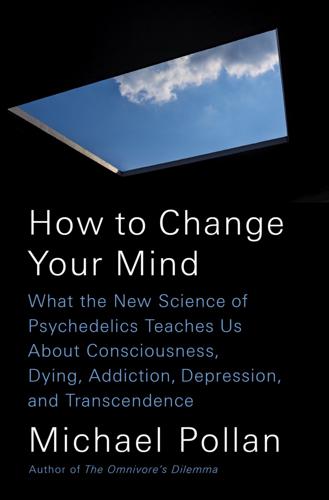
How to Change Your Mind: What the New Science of Psychedelics Teaches Us About Consciousness, Dying, Addiction, Depression, and Transcendence
by
Michael Pollan
Published 30 Apr 2018
(In fact, the DMN consumes a disproportionate share of the brain’s energy.) Working at a remove from our sensory processing of the outside world, the default mode is most active when we are engaged in higher-level “metacognitive” processes such as self-reflection, mental time travel, mental constructions (such as the self or ego), moral reasoning, and “theory of mind”—the ability to attribute mental states to others, as when we try to imagine “what it is like” to be someone else. All these functions may belong exclusively to humans, and specifically to adult humans, for the default mode network isn’t operational until late in a child’s development. “The brain is a hierarchical system,” Carhart-Harris explained in one of our interviews.
…
The default mode network, called that because it is most active when the brain is in a resting state, links parts of the cerebral cortex with deeper and evolutionarily older structures of the brain involved in emotion and memory. (Its key structures include, and link, the posterior cingulate cortex, the medial prefrontal cortex, and the hippocampus.) Neuroimaging studies suggest that the DMN is involved in such higher-order “metacognitive” activities as self-reflection, mental projection, time travel, and theory of mind—the ability to attribute mental states to others. Activity in the DMN falls during the psychedelic experiences, and when it falls most precipitously volunteers often report a dissolution of their sense of self. DMT (or N,N-dimethyltryptamine): A rapid-onset, intense, and short-acting psychedelic compound sometimes referred to as “the businessman’s trip.”

Army of None: Autonomous Weapons and the Future of War
by
Paul Scharre
Published 23 Apr 2018
Golem stories often end with the golem killing its creator, a warning against the hubris of playing God. Human-level or superhuman AI tap into this deep well of fear of artificial beings. Micah Clark, a research scientist from the Florida Institute for Human & Machine Cognition who studies AI, cognition, and theory of mind, told me that at “a very personal and philosophical level, AI has been about building persons. . . . It’s not about playing chess or driving cars.” He explained, “With the general track of robotics and autonomous systems today, you would end up with autonomous systems that are capable but very, very dumb.
…
Two gunslingers staring each other down aren’t interested only in their opponent’s accuracy, but also what is in the mind of the other fighter. Machines today are woefully unequipped to perform this kind of task. Machines may outperform humans in speed and precision, but current AI cannot perform theory-of-mind tasks such as imagining another person’s intent. At the tactical level of war, this may not be important. Once the gunslinger has made a decision to draw his weapon, automating the tasks of drawing, aiming, and firing would undoubtedly be faster than doing it by hand. Likewise, once humans have directed that an attack should occur, autonomous weapons may be more effective than humans in carrying out the attack.
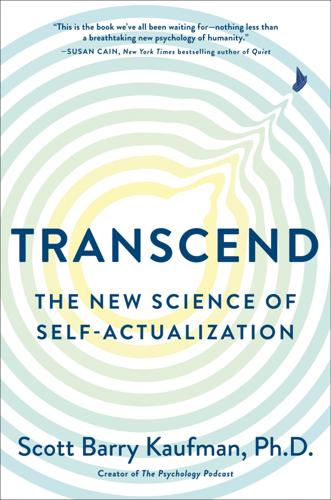
Transcend: The New Science of Self-Actualization
by
Scott Barry Kaufman
Published 6 Apr 2020
Developmental psychologist Paul Bloom has pointed out the potential pitfalls of empathy, biasing us toward only helping people with whom we have a shared emotional experience.31 Indeed, some of the greatest atrocities in human history have occurred in the name of empathy.32 B-loving people tend to have a healthy form of compassion that is motivated by universal concern and integrates both cognitive and affective empathy. Cognitive empathy reflects the ability to appreciate and understand another’s feelings—a perspective-taking, “theory-of-mind” ability—whereas affective empathy reflects the capacity to share another person’s emotional experience and to really feel what they are feeling.33 Interestingly, many people who score high on the dark triad score high in cognitive empathy but not affective empathy, using their cognitive empathy skills to exploit the weaknesses of others, rather than identifying with their suffering.34 To assess your placement on both dimensions, look at the following statements and see how much you are in agreement with them:35 COGNITIVE-AFFECTIVE EMPATHY SCALE Cognitive Empathy When two people argue, I can see both points of view.
…
Steven, 22 right to shine, 71 “rising tide,” high-quality connections, 43 Robbers Cave study, 39 Rogers, Carl, xviii, xxiv, 42, 59, 78, 107, 165, 185 “role abandonment”/role engulfment, 139 romantic love, 138, 139, 141, 142, 194, 228 romantic passion, 145, 146–47 Roosevelt, Eleanor, 88, 168, 169, 180 Rowan, John, xxviii “rumble of panic,” 234, 235, 236 rumination, 10, 104–5, 106, 176, 214 Russian nesting dolls analogy, xxviii Ryan, Richard, 59 Sacks, Oliver, 85 sacredness in all things, xxiii, 222, 223 safety, xiii, xiv, xxviii, xxx, xxxi, xxxii, xxxiii, xxxiv, xxxv, 1, 6, 7–34, 37, 39, 48, 71, 81, 86, 91, 92, 98, 119, 136, 148, 167, 221, 231, 245 sailboat, xxxi–xxxix, xxxii, xxxv, 1, 34, 53, 80, 81, 129, 136, 183, 187 salience network, 116 Salzberg, Sharon, 120, 142 samadhi, 194 Sam’s story, 37 Sandelands, Lance, 42 Sane Society, The (Fromm), xxxvi Saroglou, Vassilis, 213 Schachtel, Rabbi Hyman, 50 Schnell, Tatjana, 238–39 scientific/intuitive, 240 scientific investigation and Theory Z, 228, 228n Seale, Colin, 33–34 Search for Authenticity, The (Bugental), 155 “second naivete,” 225 “second tier” spiral dynamic, 226 “sectarians,” 168 secure attachment, 17, 18, 42, 140–41, 144 security, xiv, xviii, xxix, xxx, xxxi, xxxii, xxxiii, xxxiv, xxxv, 1, 1–80, 84, 86, 93, 98, 100, 119, 141, 146, 147, 167, 225, 227, 231, 233, 238 See also insecurity seismic earthquake metaphor for trauma, 103–4 self-acceptance, xxv, 68, 90, 174, 238 See also acceptance self-actualization, xiii–xv, xiv, xxi, xxiii, xxix, xxx, xxxi, xxxiii–xxxiv, xxxvi, 83–90 peak experiences, 193, 195, 196, 197, 205, 215 security, 7, 70, 79, 80 Theory Z, xiii, 217–44 See also exploration; Kaufman, Scott Barry; love; Maslow, Abraham; purpose; transcendence “Self-Actualization: A Study of Psychological Health” (Maslow), 88 selfactualizationtests.com, xxi, 89, 123, 131, 208 self-awareness, xxv, xxxvi, 17, 26, 117, 133–34, 136, 141, 236 self-compassion, 132–33, 238 self-concordant goals, 166 self-control, 100, 133 self-determination, 164–65, 170, 180 Self-Diminishment (Awe Experience Scale), 208 self-esteem, xiii, xiv, xxviii, xxx, xxxiii, xxxv, xxxvi, 245 growth, 81, 84, 86, 98, 132, 134, 135, 136, 143, 148, 152, 160, 167 healthy transcendence, 219, 236, 238 security, 1, 5, 6, 19, 35, 43, 53, 54–80 self-expansion theory of love, 138–39, 142 self-honesty, 136–37 “Selfishness and Self-Love” (Fromm), 130 selfish/unselfish dichotomy, 153 self-loss, 203–6 self-love, 130–33, 139, 147, 174 pathological, 132 self-presentation strategy, 68, 69, 78 self-preservation, 6, 39, 54, 86 self-regulation, 25, 59, 105, 161 self-respect, xv, 23, 57, 84, 131, 139 self-transcendence, xxiv, 126–27, 181, 200, 201, 227 Seligman, Martin, xxv, 27–28, 115, 200, 201 sensation seeking, 99, 101 sense of self (self-worth), xv, xxv, xxviii, 52, 59, 60–61, 62, 65, 66, 68, 69, 74, 75, 110, 135, 139, 140, 205, 208, 226 Seppälä, Emma, 47–48, 51, 52 sex, 6, 28, 36, 37, 77, 84, 94, 100, 122, 137, 138, 142, 143n, 143–47, 193, 194, 225, 228, 230 sex and dominance research, 54, 55–56, 83 sexploration, 144–46 sexual assault, 102, 214 Sheldon, Kennon, 160, 163–64, 165, 166, 170 Shonkoff, Jack, 24, 27 “sickness-fostering” victory, 215 signature strengths, 166, 171, 176–77 silent vs. quiet ego, 135 Simpson, Jeffry, 21–22 60 Minutes (TV show), 97 Skee-Ball, xxxvi Skenazy, Lenore, 92 SMART goals, 171–72 Snyder, Charles, 177, 178 social anxiety, 95, 145, 211 social curiosity, 95–97 social environment, 95, 96, 202 “social evasion,” 39 social exploration, 94–97 social intelligence, 126 “social interest,” xviii, 54, 55, 58, 78 social isolation, 45, 48 social media, 50–51, 52, 163, 166 social protection system, 38, 39, 41, 61, 67, 69–70 social psychology, xx, xxi, 19, 39, 42–43, 45, 60, 77, 133, 144, 152 social value, 60–61, 62, 64, 66, 67, 73 society and human nature, 216 society and Theory Z, 232–33 Society for Personality and Social Psychology, 195 Some Do Care (Colby and Damon), 167 specific (quality of SMART goals), 171 Spiritual Evolution (Vaillant), 119 “splitting,” 26 “staleness of experience,” 111 states of mind and hierarchy of needs, xxvii–xxviii status-driven life motivations, 79, 80 Steger, Michael, 8–9 Sternberg, Robert, 30 “strange situation procedure,” 16 stress, 9–10, 11, 15, 15, 18–19, 21–22, 24, 25, 26, 38, 43, 45, 49, 69, 91, 101, 102, 106, 113, 132, 143, 174, 182, 208, 230 stress-adapted children, 30, 31–32 stress tolerance, 93, 98–99 striving for power, 55, 58, 78 striving wisely, 159–66, 161, 162, 163, 164, 165, 170, 173, 175 sublimation, 130, 154 suicide, 39, 46–47, 237 “Summer Notes on Social Psychology of Industry and Management” (Maslow), 152 Sumner, William Graham, 3–4, 5 supportive environment, 171, 178–83 suppression, xxvii, 5, 69, 70, 78, 101, 112, 129, 130, 140 Swann, William B., Jr., 61 synergy, xxxiv, 152–53, 169, 222, 225, 233 Tafarodi, Romin, 61, 62 Tedeschi, Richard, 102–3 Teicher, Martin, 25, 26 temporo-parietal junction, 202 Terror Management Theory (TMT), 236 “Theory of Human Motivation” (Maslow), 59, 86 “theory-of-mind” ability, 127–28 Theory of Successful Intelligence, 30 Theory X, 151 Theory Y, 151, 153, 220 Theory Z, xiii, 217–44 thinkLaw, 33 Third Force psychologists, xxiv Thorndike, Edward, 56, 83 Time (Awe Experience Scale), 208 “timelessness,” 194 time-saving vs. material purchases, 49 time-specific (quality of SMART goals), 171, 172 Torrance, E.

Little Bets: How Breakthrough Ideas Emerge From Small Discoveries
by
Peter Sims
Published 18 Apr 2011
Daniel Ansari, a psychology professor at the University of Western Ontario, published in NeuroImage, 41, 2008, 535–543; it received the journal’s 2008 Editor’s Choice Award in Systems Neuroscience. Attribution to Berkowitz about creative muscle: taken from appearance on the television program Charlie Rose on July 15, 2010, which can be found at: www.charlierose.com/guest/view/6944. Other reference: “People Thinking about Thinking People: The Role of the Temporo-Parietal Junction in “Theory of Mind,” by R. Saxe and N. Kanwisher, NeuroImage, vol. 19, 2003, 1835–1842. Flow and Mihaly Csikszentmihalyi research. Interview with Csikszentmihalyi. “Go with the Flow,” by John Geirland, Wired, September 1996. Flow: The Psychology of Optimal Experience by Mihaly Csikszentmihalyi, Harper Perennial (1991).
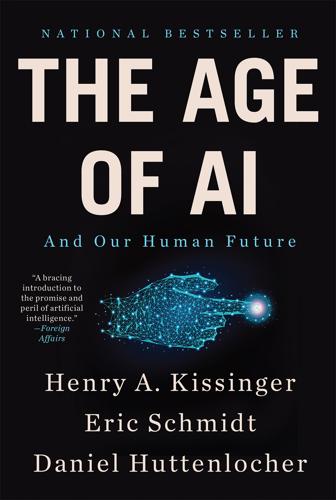
The Age of AI: And Our Human Future
by
Henry A Kissinger
,
Eric Schmidt
and
Daniel Huttenlocher
Published 2 Nov 2021
As of 2021, for example, the intelligence of the computer has increasingly ventured into mathematics and detected patterns unseen by the human mind.15 We will lack a real understanding of these intelligences, even as they mimic human behavior. For a time, we will be limited to observing their patterns and seeking to craft laws that effectively regulate their effects. Eventually, though, if we are to partner with these systems, we will have to develop a theory of mind for something very new. The stakes of the interaction between humans and machines are rising rapidly. All human knowledge has existed as if on a wheel, each segment connecting to the next, from philosophy to science to politics to history to literature to art and back again.16 How does this apply to the revolutionary changes wrought by AI?
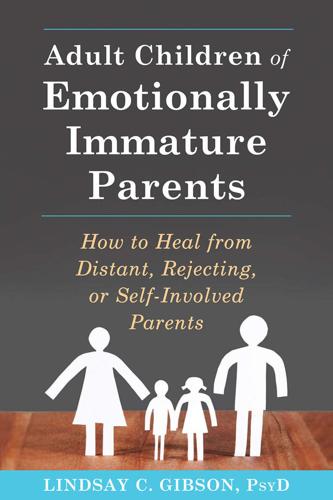
Adult Children of Emotionally Immature Parents: How to Heal From Distant, Rejecting, or Self-Involved Parents
by
Lindsay C. Gibson
Published 31 May 2015
Beyond just sympathy, it entails correctly reading people’s interests and how their will is being directed. The highest form of empathy requires an effort of imagination, which has been called mentalization (Fonagy and Target 2008), meaning the ability to imagine that other people have their own unique minds and thought processes. Developmental psychologists refer to this as having a theory of mind. Acquiring this ability is an important developmental milestone for children. Mentalizing allows you to grasp other people’s viewpoints and overall inner experience because you realize they have a mind of their own, different from yours. Good parents are excellent at empathizing and mentalizing; their interest in their child’s mind makes the child feel seen and understood.
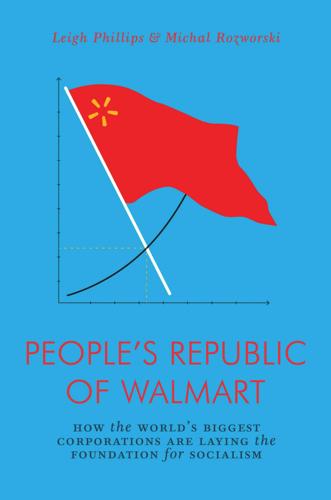
The People's Republic of Walmart: How the World's Biggest Corporations Are Laying the Foundation for Socialism
by
Leigh Phillips
and
Michal Rozworski
Published 5 Mar 2019
Essentially, Cockshott, Cottrell, Marciszewski, Murphy and a handful of others had revived the long-dormant calculation debate but recast it as a problem for the field of computational complexity theory, a branch of theoretical computer science that seeks to classify the inherent difficulty of different sorts of problems, and the resources needed to solve them. In the same way that neuroscientists have in recent decades stolen debates over the theory of mind away from philosophers, complexity theorists and computer scientists are stealing this debate away from economists and political scientists. However, the discussion still largely remains hidden within the realm of scientific journals—and even there, for many, it has become something of a mathematical parlor game.

Survival of the Richest: Escape Fantasies of the Tech Billionaires
by
Douglas Rushkoff
Published 7 Sep 2022
It just happens to be a meaning system that ignores meaning itself. Worse, by rejecting the validity of any other meaning system, it is prone to instilling in its adherents a sense of superiority over others. Those who strive for meaning are mere “moralists.” So, Stephen Pinker argues for a computational theory of mind—one where the brain is mere hardware playing various programs in utterly predictable ways. Daniel Dennett likens religious belief to a “parasitic worm (a lancet fluke) invading an ant’s brain.” Under scientism, humans are just robots running programs—either the ones dictated by our genes, or destructive pathogens like spirituality.
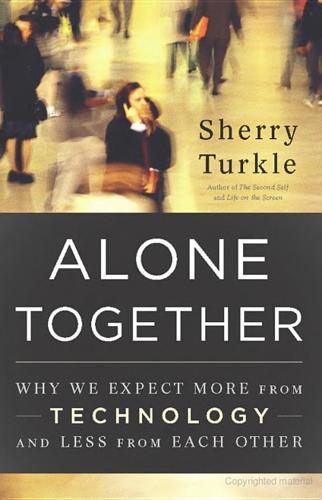
Alone Together
by
Sherry Turkle
Published 11 Jan 2011
Brooks et al., “The Cog Project: Building a Humanoid Robot,” in Computation for Metaphors, Analogy and Agents, vol. 1562 of Springer Lecture Notes in Artificial Intelligence , ed. C. Nehaniv (New York: Springer-Verlag, 1998), and Rodney Brooks, Flesh and Machines: How Robots Will Change Us (New York: Pantheon, 2002). Brian Scassellati did his dissertation work on Cog. See Brian Scassellati, Foundations for a Theory of Mind for a Humanoid Robot (PhD diss., Massachusetts Institute of Technology, 2001). Scassellati and Cynthia Breazeal worked together during early stages of the Kismet project, which became the foundation of Breazeal’s dissertation work. See Cynthia Breazeal and Brian Scassellati, “How to Build Robots That Make Friends and Influence People” (paper presented at the IEEE/RSJ International Conference on Intelligent Robots and Systems, Kyongju, Korea, October 17-21, 1999), in Proceedings of the IEEE/RSJ International Conference on Intelligent Robots and Systems (IROS) (1999), 858-863.
…
Alan Turing, “Computing Machinery and Intelligence,” Mind 59, no. 236 (October 1950): 433-460. 7 This branch of artificial intelligence (sometimes called “classical AI”) attempts to explicitly represent human knowledge in a declarative form in facts and rules. For an overview of AI and its schools that explores its relations to theories of mind, see Margaret Boden, Artificial Intelligence and Natural Man (1981; New York: Basic Books, 1990). 8 Hubert Dreyfus, “Why Computers Must Have Bodies in Order to Be Intelligent,” Review of Metaphysics 21, no. 1 (September 1967): 13-32. See also Hubert Dreyfus, What Computers Can’t Do: A Critique of Artificial Reason (New York: Harper & Row, 1972); Hubert Dreyfus with Stuart E.

The Alignment Problem: Machine Learning and Human Values
by
Brian Christian
Published 5 Oct 2020
It’s possible, depending on exactly when they met, that Pitts had turned eighteen (and/or that Lettvin was still twenty); McCulloch writes, “In 1941 I presented my notions on the flow of information through ranks of neurons to Rashevsky’s seminar in the Committee on Mathematical Biology of the University of Chicago and met Walter Pitts, who then was about seventeen years old.” See McCulloch, The Collected Works of Warren S. McCulloch, pp. 35–36. 7. Some of the roots of this thinking predate McCulloch’s work with Pitts; see, e.g., McCulloch, “Recollections of the Many Sources of Cybernetics.” 8. See Piccinini, “The First Computational Theory of Mind and Brain,” and Lettvin, Introduction to McCulloch, The Collected Works of Warren S. McCulloch. 9. John von Neumann’s 1945 EDVAC report, the first description ever written of a stored-program computer, will contain—for all its 101 pages—a single citation: McCulloch and Pitts, 1943. (See Neumann, “First Draft of a Report on the EDVAC.”
…
“A Day of Great Illumination: B. F. Skinner’s Discovery of Shaping.” Journal of the Experimental Analysis of Behavior 82, no. 3 (2004): 317–28. Piaget, Jean. The Construction of Reality in the Child. Translated by Margaret Cook. Basic Books, 1954. Piccinini, Gualtiero. “The First Computational Theory of Mind and Brain: A Close Look at McCulloch and Pitts’s ‘Logical Calculus of Ideas Immanent in Nervous Activity.’” Synthese 141, no. 2 (2004): 175–215. Plato. Protagoras and Meno. Translated by W.K.C. Guthrie. Penguin Books, 1956. Podkopacz, Marcy R. “Building and Validating the 2007 Hennepin County Adult Pretrial Scale.”
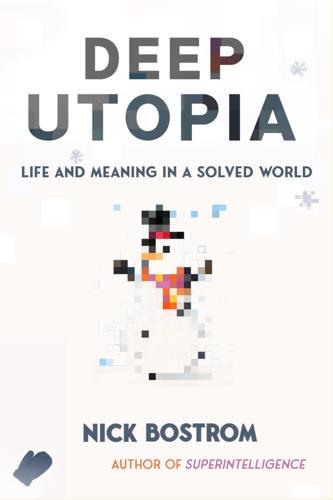
Deep Utopia: Life and Meaning in a Solved World
by
Nick Bostrom
Published 26 Mar 2024
As you see on Handout 2, I have listed the construction of robots and digital minds with conscious experience among the affordances of technological maturity. This is more or less a corollary if we assume computationalism and that humans are conscious and that the other technologies on the list are feasible. I’m not going to lay out the case for a computationalist theory of mind here, since you can find many discussions of this in the literature. In fact, we could significantly weaken the assumption of computationalism and still get the conclusion that it will be possible to build artificial sentient minds.72 So the artificial therapist or DJ could also excel along this inner dimension— for example, being more immersed, phenomenally, in the moment than a typical human counterpart, who might occasionally find their thoughts drifting off to what they are going to do when they get home.
…
Does its quality warrant its price? Imagination. As part of the evaluation process, imagining how well or poorly the potential purchase would serve its intended function. Would some decorative object look good in the home? Would some item of clothing be suitable for particular occasions? How often would it be used? Theory of mind. Modeling the minds of others to predict how they would regard the object in question. Would they find a particular garment attractive? Would they appreciate receiving it as a gift? Communication and social learning. Discussing actual or potential purchases with a friend, gaining and conveying information about personal tastes, sharing insights about who and what is in or out of fashion.

Geek Sublime: The Beauty of Code, the Code of Beauty
by
Vikram Chandra
Published 7 Nov 2013
One of the ways in which we know Chiti every day is in our recognition of the reality of other people’s individual subjectivities. Because we are aware of our own freedom (svatantrya) as subjects, because we are aware of our own self-awareness, we make a guess (uha) about the freedom inherent in other subjects, outside of one’s own individuality.15 And this theory of mind, this “awareness of the others’ existence is already a partial recognition of the universal Self.” The reality of Chiti also accounts for intersubjectivity: “If several subjects appear to share a single object of perception,” Isabelle Ratié explains, it is not because this object would have an independent existence outside of consciousness, as the externalists contend; nor is it because of a perpetual accidental correspondence between various particular illusions belonging to each cognitive series, as [the Buddhist] Dharmakīrti explains … rather, it is due to the absolute freedom of the single infinite consciousness, which is able both to present itself as scattered into a multiplicity of limited subjects, and to manifest its fundamental unity in these various subjects by making them one with respect to one particular object.16 The task of the seeker after truth, then, is merely one of recognition: recognition of the nature of the limited self and of that universal self, and recognition that the individual self is Chiti, the macrocosm.
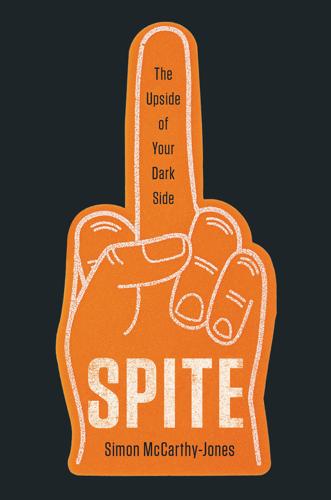
Spite: The Upside of Your Dark Side
by
Simon McCarthy-Jones
Published 12 Apr 2021
Tetlock, “Perceptual Dehumanization of Faces Is Activated by Norm Violations and Facilitates Norm Enforcement,” Journal of Experimental Psychology: General 145, no. 2 (2016): 131–146. 77. D. Ewing, V. Zeigler-Hill, and J. Vonk, “Spitefulness and Deficits in the Social-Perceptual and Social-Cognitive Components of Theory of Mind,” Personality and Individual Differences 91 (2016): 7–13. 78. B. Bryson, Notes from a Small Island (London: Transworld, 1995), 336. 79. This point is made by E. Seip, W. Vandijk, and M. Rotteveel, “On Hotheads and Dirty Harries,” Annals of the New York Academy of Sciences 1167, no. 1 (2009): 190–196. 80.
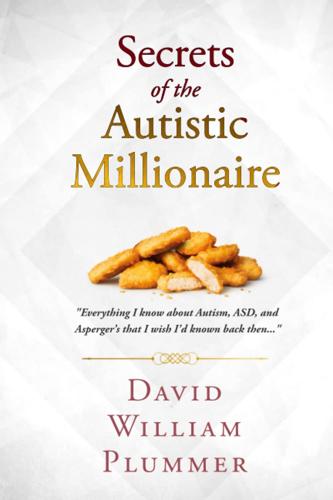
Secrets of the Autistic Millionaire: Everything I Know Now About Autism and Asperger's That I Wish I'd Known Then
by
David William Plummer
Published 14 Sep 2021
I will then assume either one or the other, locking in that perception until our next in-person interaction. In a very real sense, I snapshot the last known state of another’s mind and hold onto it as a proxy for the real person. And that mental proxy is quite often a very inaccurate picture –– but it’s all I have to go on. If one’s theory of mind is that it consists of the ability to both construct and maintain a mental proxy for the other person, then I argue that in autism it is primarily the construction aspect which is impaired: once the state of the other person is satisfactorily communicated, a highly functioning person with autism might be able to hold it and maintain it.
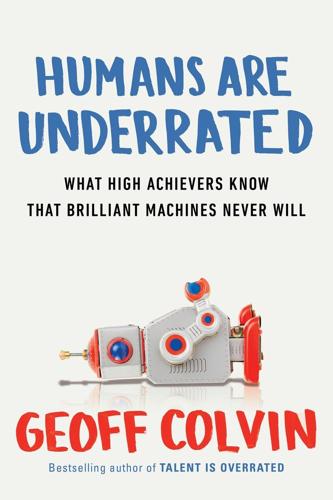
Humans Are Underrated: What High Achievers Know That Brilliant Machines Never Will
by
Geoff Colvin
Published 3 Aug 2015
(chap. 7, n. 7). You look at thirty-six black-and-white photos of just the eye region . . . You can take the RME test at http://kgajos.eecs.harvard.edu/mite/. In the new experiments, group members were separated . . . David Engel, Anita Woolley, Lisa X. Jing, Christopher F. Chabris, Thomas Malone, “Theory of Mind Predicts Collective Intelligence,” Proceedings of Collective Intelligence 2014, Cambridge, Massachusetts, http://humancomputation.com/ci2014/papers/Active%20Papers%5CPaper%20106.pdf. When researchers studied one-year-olds . . . Svetlana Lutchmaya, Simon Baron-Cohen, “Human Sex Differences in Social and Non-Social Looking Preferences at 12 Months of Age,” Infant Behavior and Development, vol. 25, no. 3, 2002, pp. 319–325.
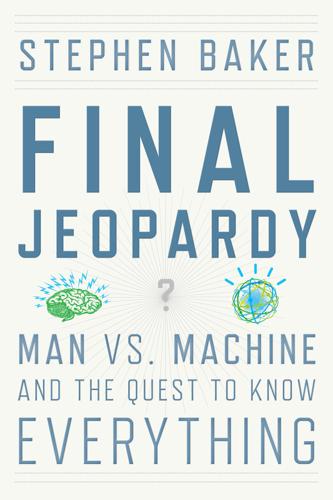
Final Jeopardy: Man vs. Machine and the Quest to Know Everything
by
Stephen Baker
Published 17 Feb 2011
Flipping through scenarios at about three per second—a glacial pace for a computing machine—these grandmasters looked for a flash of inspiration, an insight, the hallmark of human intelligence. Equally important, chess players tried to read the minds of their foes. This is a human specialty, a mark of our intelligence. Cognitive scientists refer to it as “theory of mind”; children develop it at about age four. It’s what enables us to imagine what someone else is experiencing and to build large and convoluted structures based on such analysis. “I wonder what he was thinking I knew when I told him . . .” Most fiction, from Henry James to Elmore Leonard, revolves around this very human analysis, something other species—and computers—cannot even approach.

Give People Money
by
Annie Lowrey
Published 10 Jul 2018
In those latter examples, as in much of life, negotiation is as much art as science. It requires evaluating how valuable certain things are, often when it is not obvious. It requires identifying and resolving conflicts and trying to sort out information asymmetries. It goes a lot better with a theory of mind, meaning an understanding that the guy on the other side of the table has different motivations and resources than you do. It is something at which computers are terrible and humans excel. A Facebook chatbot started off doing simple, formulaic negotiations, asking for two of a given item and agreeing to settle for one, for instance.

Do Nothing: How to Break Away From Overworking, Overdoing, and Underliving
by
Celeste Headlee
Published 10 Mar 2020
When the DMN is engaged, it works on our memories, putting past events into context and making moral evaluations about things that have happened. It also imagines the future, tries to understand the emotions of others, and reflects on our own emotions and decisions. The default network is crucial for empathy, for self-reflection, and for Theory of Mind, the ability to imagine what others may be thinking. Allowing our brains to switch into default mode is crucial for our well-being. That’s the source of much of our creativity and innovation, since the brain actively reshuffles the puzzle pieces of our memories and emotions when it’s not directed to solve a problem or complete a task.

Protocol: how control exists after decentralization
by
Alexander R. Galloway
Published 1 Apr 2004
Then he added: ‘No computer is a brain, but all brains are computers.’”73 This debate is ongoing, with one camp claiming that computers will someday perfectly model the workings of the human brain and the other camp claiming that the je ne sais quoi of human thought is fundamentally different than the hard, rigid world of computer code. Yet this book has very little to say about questions epistemological. Protocol is not a theory of mind. Nor, following Jonathan Crary and Sanford Kwinter in their forward to the fascinating collection Incorporations, is protocol a theory of the body. For, as they write, “Our topic is the problem of life itself, understood as a complex, labile, overtone structure, neither dependent upon, nor reducible to, an organic substrate or historical object—in short, to what contemporary habit too knowingly calls ‘the body.’”74 Instead protocological life is considered here as “the forces—aesthetic, technical, political, sexual—with which things combine in order to form novel aggregates of pattern and behavior.”75 Indeed, protocol is a theory of the confluence of life and matter (and ultimately we will see that protocol shows how life is matter).
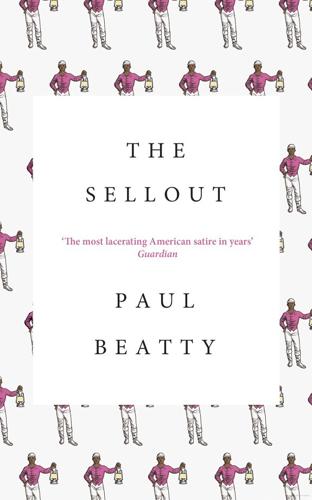
The Sellout: A Novel
by
Paul Beatty
Published 2 Mar 2016
I just regret that I never had the nerve to ask him if it was really true that I’d spent the sensorimotor and preoperational stages of my life with one hand tied behind my back. Talk about starting life off with a handicap. Fuck being black. Try learning to crawl, ride a tricycle, cover both eyes while playing peek-a-boo, and constructing a meaningful theory of mind, all with one hand. Four You won’t find Dickens, California, on the map, because about five years after my father died, and a year after I graduated college, it, too, perished. There was no loud send-off. Dickens didn’t go out with a bang like Nagasaki, Sodom and Gomorrah, and my dad. It was quietly removed like those towns that vanished from maps of the Soviet Union during the Cold War, atomic accident by atomic accident.
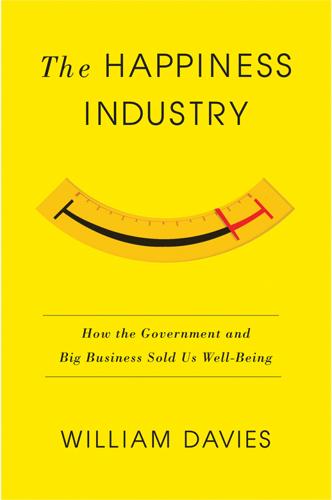
The Happiness Industry: How the Government and Big Business Sold Us Well-Being
by
William Davies
Published 11 May 2015
This wasn’t a theory stating whether mental processes were really driven by biological ones, or vice versa. It was the opening up of a new field of scientific enquiry, which, by the end of the nineteenth century, would be populated by psychologists, economists and a nascent industry of management consultants. The quantitative and economic psychology in which theories of mind would be replaced by scales and measures, and which Bentham had merely speculated about, was now being assembled. The idea that individual feelings and behaviour might be amenable to expert adjustment was also now a technical, mechanical possibility. A democracy of bodies In the age of the fMRI scanner, it has become increasingly common to speak of what our brains are ‘doing’, ‘wanting’ or ‘feeling’.

The Eureka Factor
by
John Kounios
Published 14 Apr 2015
Two recent fMRI studies investigated the relationship between the default-state network and mental travel. Spreng and Grady showed how different forms of mental simulation tap the same default-state network of brain areas: R. N. Spreng and C. L. Grady, “Patterns of Brain Activity Supporting Autobiographical Memory, Prospection, and the Theory of Mind, and Their Relationship to the Default Mode Network,” Journal of Cognitive Neuroscience 22 (2009): 1112–23. Tamir and Mitchell extended these results, also showing stable individual differences in the predilection to think about psychologically distant, rather than near, things: D. I. Tamir and J.

Artificial Unintelligence: How Computers Misunderstand the World
by
Meredith Broussard
Published 19 Apr 2018
If the column can be recognized as a column, we could write a rule for columns and a rule for people. However, we don’t know it’s a column unless there’s vision or, at the very least, object recognition—which is why I almost died in a car that almost ran into a giant cement pillar. The core problem is sentience. Because there was no way to program theory of mind, the car would never be able to respond to obstacles the way that a human might. A computer only “knows” what it’s been told. Without sentience, the cognitive capacity to reason about the future, it can’t make the split-second decisions necessary to identify a streetlight as an obstacle and take appropriate evasive measures.
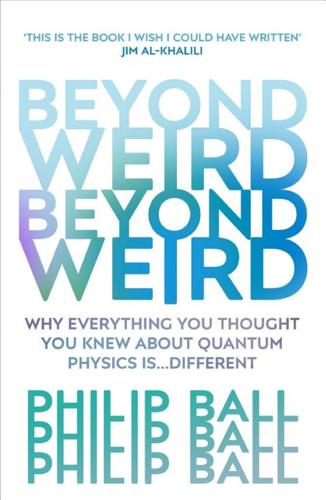
Beyond Weird
by
Philip Ball
Published 22 Mar 2018
Indeed, even fruit flies can be trained to respond to the kinds of stimuli that could signal the outcome of a quantum experiment … At what point, then, does consciousness enter the picture? And how, in any case, can we reasonably make the mind responsible for reducing all the quantum probabilities to a single certainty while we still lack a theory of mind, brain and consciousness? In particular, mind-induced collapse seems to demand that we attribute to the mind some feature distinct from the rest of reality: to make mind a non-physical entity that does not obey the Schrödinger equation. How else could it do something to quantum processes that nothing else can?
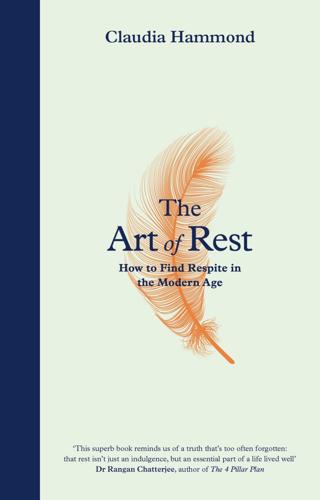
The Art of Rest: How to Find Respite in the Modern Age
by
Claudia Hammond
Published 5 Dec 2019
We form words from them. We take meaning from those words. We relate that meaning to what we’ve read before. We reach into our own memories. We create images in our minds. We mentally simulate the action, the sights and the sounds of the scenes. Meanwhile we use what psychologists refer to as ‘theory of mind’ to inhabit the characters’ minds in order to understand their motivations, to imagine their thoughts, to feel their feelings. Curiously, reading is not only effortful cognitively, but also physically, in a way that you might not expect. One of the things Victor Nell wanted to investigate when he recruited his bookworms back in 1988 was what happens physiologically while people read.
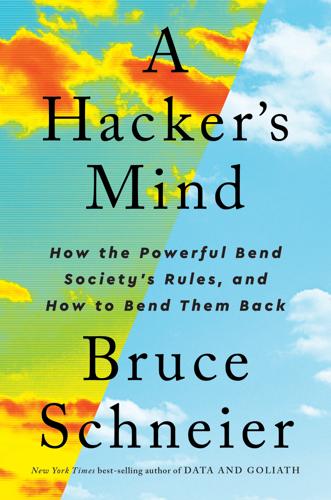
A Hacker's Mind: How the Powerful Bend Society's Rules, and How to Bend Them Back
by
Bruce Schneier
Published 7 Feb 2023
If you can hack a mind, you can hack any system that is governed by human action. Cognitive hacks are as old as our species, and many were normalized so long ago that we don’t even think twice about them—let alone think of them as hacks. Because humans are intelligent and conscious, because we have a theory of mind and an ability to plan far into the future, we have taken hacking to a level of sophistication beyond any other creature in the natural world. And, like many of the hacks in the previous chapters, cognitive hacks tend to target the information, choice, or agency humans need so they can make deliberative and effective decisions.
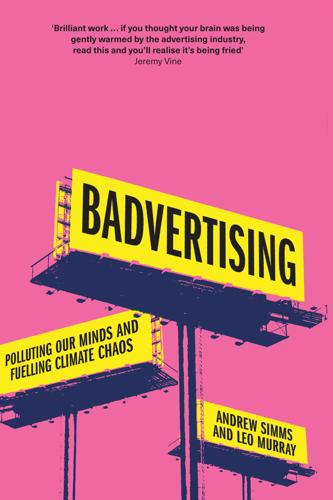
Badvertising
by
Andrew Simms
Tatlow-Golden, Mimi, Eilis Hennessy, Moira Dean and Lynsey Hollywood (2014) Young children’s food brand knowledge. Early development and associations with television viewing and parent’s diet. Appetite, 80. www.sciencedirect.com/science/article/abs/pii/S0195666314002177 9. McAlister, Anna R. and T. Bettina Cornwell (2010) Children’s brand symbolism understanding: links to theory of mind and executive functioning. Psychology & Marketing, 11 February. https://doi.org/10.1002/mar.20328 10. Fitzsimons, G.M., T.L. Chartrand and G.T. Fitzsimons (2008) Automatic effects of brand exposure on motivated behavior: how apple makes you ‘think different’. Journal of Consumer Research, 35(1), 21–35. https://doi.org/10.1086/527269 11.
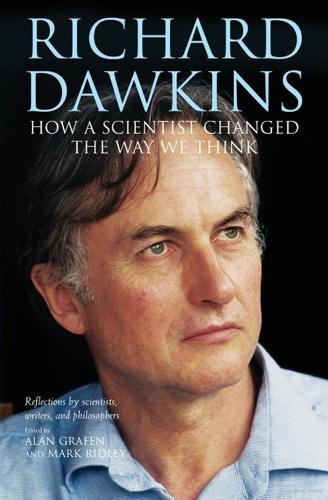
Richard Dawkins: How a Scientist Changed the Way We Think
by
Alan Grafen; Mark Ridley
Published 1 Jan 2006
There are many intermediate cases of quasi-knowing deception in animals—the distraction displays of such low-nesting birds as piping plovers are a well-studied instance31—as well as a bounty of tempting anecdotes about the ‘Machiavellian’ intelligence of primates.32 In fact the question of whether Washoe could tell a deliberate lie is a deeply interesting theoretical question, investigated at length with another chimpanzee, Sarah, by David Premack and his colleagues, and leading to some intermittently fruitful and important research on both animals and children, the ill-named ‘theory of mind’ contro-versy.33 The transition from mindless deceit to mindful deceit is a good manifestation of a major transition in evolution—not a metaphysical or cosmic distinction, an unbridgeable chasm, but a passage, with intermediate transitional cases of deceit that may not be so mindless. Once that transition has been clearly accomplished, it opens up a whole new world of deceit (and other sophisticated behavior).

Blink: The Power of Thinking Without Thinking
by
Malcolm Gladwell
Published 1 Jan 2005
Mind-reading failures are sometimes like that. They aren’t always as obvious and spectacular as other breakdowns in rapid cognition. They are subtle and complex and surprisingly common, and what happened on Wheeler Avenue is a powerful example of how mind reading works—and how it sometimes goes terribly awry. 2. The Theory of Mind Reading Much of our understanding of mind reading comes from two remarkable scientists, a teacher and his pupil: Silvan Tomkins and Paul Ekman. Tomkins was the teacher. He was born in Philadelphia at the turn of the last century, the son of a dentist from Russia. He was short and thick around the middle, with a wild mane of white hair and huge black plastic-rimmed glasses.

How Doctors Think
by
Jerome Groopman
Published 15 Jan 2007
The vignette told by Karen Delgado about the purple pills shows that system-wide solutions still require communication and are not default remedies for errors in care. Doctors have to keep thinking until they find the answer. Index Footnotes *I quickly realized that trying to assess how psychiatrists think was beyond my abilities. Therapy of mental illness is a huge field unto itself that encompasses various schools of thought and theories of mind. For that reason, I do not delve into psychiatry in this book. [back]
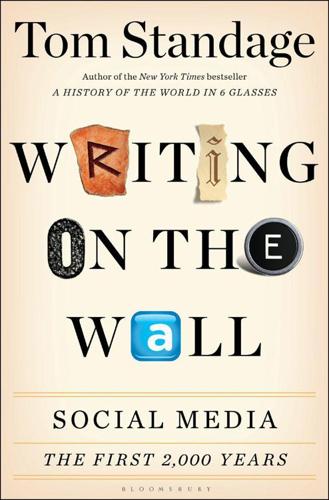
Writing on the Wall: Social Media - the First 2,000 Years
by
Tom Standage
Published 14 Oct 2013
Cambridge: Harvard University Press, 1997. ———. “Neocortex Size as a Constraint on Group Size in Primates.” Journal of Human Evolution 20 (1992): 469–493. ———. “The Social Brain: Mind, Language, and Society in Evolutionary Perspective.” Annual Review of Anthropology 32 (2003): 163–181. ———. “Theory of Mind and the Evolution of Language,” in Approaches to the Evolution of Language, eds. Hurford, J. R., M. Studdert-Kennedy, and C. Knight. Cambridge University Press, 1998. Edwards, C. “Epistolography,” in A Companion to Latin Literature, ed. Harrison, S. Oxford: Blackwell, 2005. Edwards, M. U. Printing, Propaganda, and Martin Luther.

Mindwise: Why We Misunderstand What Others Think, Believe, Feel, and Want
by
Nicholas Epley
Published 11 Feb 2014
Ask a friend why people might believe that God causes earthquakes or floods or other catastrophes, and you are likely to get some version of “because they don’t know any better.” The interesting point is that the explanation that remains when someone “doesn’t know any better” is one that relies on our sixth sense, using our intuitive theory of minds. This has profound implications. In one set of experiments, those who tended to reason by relying on their intuition were also more likely to report believing in the existence of a mindful god, whereas those who tended to reason more deliberately reported significantly less belief.34 Religious beliefs are intuitively compelling because minds—in this case, the mind of a god—are intuitive explanations for the behavior of almost anything.
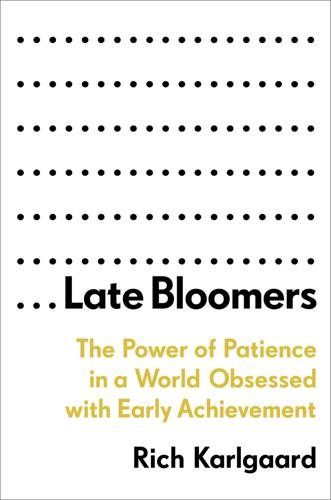
Late Bloomers: The Power of Patience in a World Obsessed With Early Achievement
by
Rich Karlgaard
Published 15 Apr 2019
wisdom emerges through: Monika Ardelt, “Wisdom and Life Satisfaction in Old Age,” Journals of Gerontology Series B: Psychological Sciences and Social Sciences 52, no. 1 (1997): P15–P27; Ardelt, “Antecedents and Effects of Wisdom in Old Age”; Francesca G. E. Happé, Ellen Winner, and Hiram Brownell, “The Getting of Wisdom: Theory of Mind in Old Age,” Developmental Psychology 34, no. 2 (1998): 358; Ursula M. Staudinger, “Older and Wiser? Integrating Results on the Relationship Between Age and Wisdom-Related Performance,” International Journal of Behavioral Development 23, no. 3 (1999): 641–64. “what doesn’t go down”: Ursula Staudinger quoted in Anil Ananthaswamy, “The Wisdom of the Aging Brain,” Nautilus, May 12, 2016, http://bit.ly/2xrFlvy.
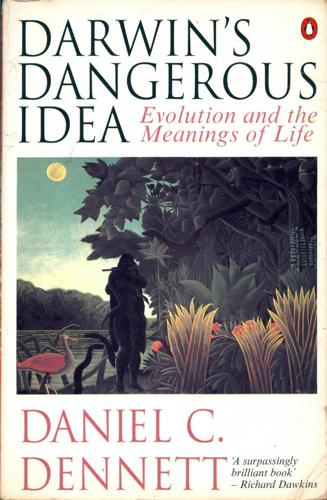
Darwin's Dangerous Idea: Evolution and the Meanings of Life
by
Daniel C. Dennett
Published 15 Jan 1995
Ray Jackendoff (1993) and other linguists have identified fundamental structures of spatial representation — notably designed to enhance the control of locomotion and the placement of movable things — that underlie our intuitions about concepts like beside, on, behind, and their kin. Nicholas Humphrey (1976,1983,1986) has argued that there must be a genetic predisposition for adopting the intentional stance, and Alan Leslie (1992) and others have developed evidence for this, in the form of what he calls a "theory of mind module" designed to generate second-order beliefs (beliefs about the beliefs and other mental states of others). Some autistic children seem to be well described as suffering from the disabling of this module, for which they can occasionally make interesting compensatory adjustments. (For an overview, see Baron-Cohen 1995.)
…
It has been plausibly maintained, by Nicholas Humphrey, David Premack (1986), and others, that chimpanzees are natural psychologists — what I would call second-order intentional systems, capable of adopting the intentional stance towards other things. This is not surprising if our own innate equipment includes a theory-of-mind module, as Leslie, Baron-Cohen, and others have maintained, for perhaps this is part of the endowment chimpanzees and we inherit from a common ancestor. But even if chimpanzees are, like us, innately equipped as natural psychologists, they nevertheless lack a crucial feature shared by all human natural psychologists, folk and professional varieties: they never get to compare notes.
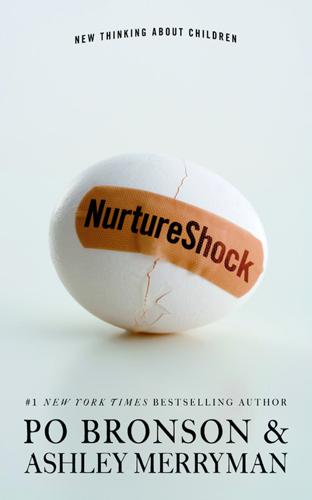
NurtureShock: New Thinking About Children
by
Po Bronson
and
Ashley Merryman
Published 2 Sep 2008
Additionally, other scholars have since replicated her work in their own versions of the peeking game. Lying’s connection with intelligence: Talwar has found that children with more advanced executive functioning and working memory are better liars. She’s also seen relationships between children’s lying and “theory of mind”—the ability to understand and keep track of multiple people’s points of view. Children’s lying to make a parent happy: Along with Talwar’s research, Bussey’s work fleshes out this insight. When Bussey has presented children with anecdotes, and asked them to predict if the protagonist would be truthful or not, the children’s responses were in part determined by whether or not the story had said if the protagonist would be punished for a misdeed or its admission.
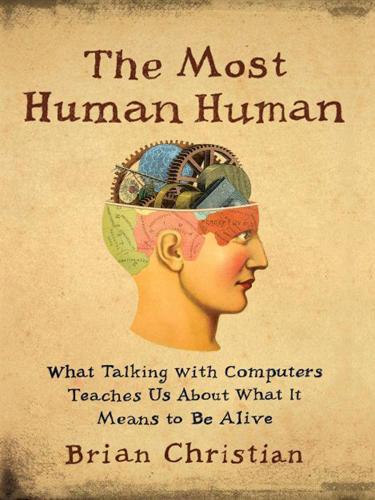
The Most Human Human: What Talking With Computers Teaches Us About What It Means to Be Alive
by
Brian Christian
Published 1 Mar 2011
Thus, as Stoicism ascended to popularity in Greece, the soul became no longer responsible for life function in general, but specifically for its mental and psychological aspects.7 No Dogs Go to Heaven Stoicism appears to have been among the tributary philosophies that fed into Christianity, and which also led to the seminal philosophical theories of mind of René Descartes. For the monotheistic Descartes, presumably the (Platonic) notion of multiple souls crowding around was a bit unsavory (although who could deny the Christian appeal of the three-in-one-ness?), and so he looked to draw that us-and-them line using just a single soul, the soul.

Beyond: Our Future in Space
by
Chris Impey
Published 12 Apr 2015
Anaxagoras lived from 510 to 428 BC and was the first philosopher to propose a natural mechanism for the cosmos and embrace the idea of pluralism or “many worlds.” Anaxagoras moved from Ionia to Athens, where he gravitated toward the center of intellectual life. The great Greek playwright Euripides incorporated Anaxagoras’s theory of mind into his tragedies, and his friend Pericles became the greatest statesman and orator of the Golden Age of Athens. Anaxagoras was prolific in his novel ideas and revolutionary theories. He believed that the Sun was a mass of molten metal much bigger than the Peloponnese peninsula, the Moon was a rock like the Earth that didn’t emit its own light, and the stars were fiery stones.
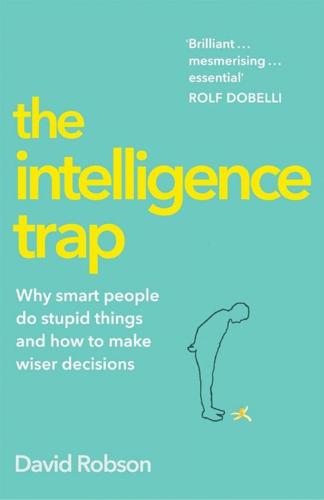
The Intelligence Trap: Revolutionise Your Thinking and Make Wiser Decisions
by
David Robson
Published 7 Mar 2019
9. 8 Woolley, A.W., Chabris, C.F., Pentland, A., Hashmi, N. and Malone, T.W. (2010), ‘Evidence for a Collective Intelligence Factor in the Performance of Human Groups’, Science, 330(6004), 686?8. 9 Engel, D., Woolley, A.W., Jing, L.X., Chabris, C.F. and Malone, T.W. (2014), ‘Reading the Mind in the Eyes or Reading between the Lines? Theory of Mind Predicts Collective Intelligence Equally Well Online and Face-to-face’, PLOS One, 9(12), e115212. 10 Mayo, A.T. and Woolley, A.W. (2016), ‘Teamwork in Health Care: Maximizing Collective Intelligence via Inclusive Collaboration and Open Communication’, AMA Journal of Ethics, 18(9), 933?40. 11 Woolley, Aggarwal and Malone (2015), ‘Collective Intelligence and Group Performance’. 12 Kim, Y.J., Engel, D., Woolley, A.W., Lin, J.Y.T., McArthur, N. and Malone, T.W. (2017), ‘What Makes a Strong Team?
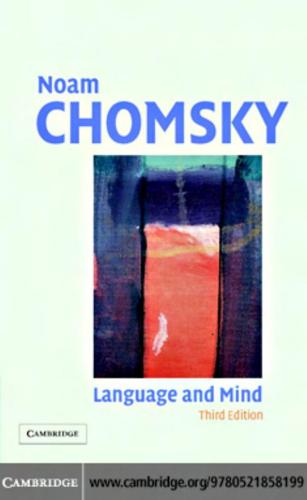
Language and Mind
by
Noam Chomsky
Published 1 Jan 1968
Lenneberg, Biological Foundations of Language (New York: Wiley, 1967), for evidence bearing on this issue. 164 Language and Mind for the acquired competence, then we will have good reason to believe that Putnam’s empirical hypothesis is correct. If, on the other hand, we discover that different innate systems (whether involving schemata or heuristics) have to be postulated, then we will have good reason to believe that an adequate theory of mind will incorporate separate “faculties,” each with unique or partially unique properties. I cannot see how one can resolutely insist on one or the other conclusion in the light of the evidence now available to us. But one thing is quite clear: Putnam has no justification for his final conclusion, that “invoking ‘Innateness’ only postpones the problem of learning; it does not solve it.”12 Invoking an innate representation of universal grammar does solve the problem of learning (at least partially), in this case, if in fact it is true that this is the basis (or part of the basis) for language acquisition, as it well may be.

The Big Nine: How the Tech Titans and Their Thinking Machines Could Warp Humanity
by
Amy Webb
Published 5 Mar 2019
If containers, programs, and data were intertwined, as Turing had argued, and if humans were similarly elegantly designed containers capable of processing data, then it followed that building a thinking machine might be possible if modeled using the part of humans responsible for thinking—our brains. They posited a modern computational theory of mind and brain, a “neural network.” Rather than focusing on the machine as hardware and the program as software, they imagined a new kind of symbiotic system capable of ingesting vast amounts of data, just like we humans do. Computers weren’t yet powerful enough to test this theory—but the paper did inspire others to start working toward a new kind of intelligent computer system.
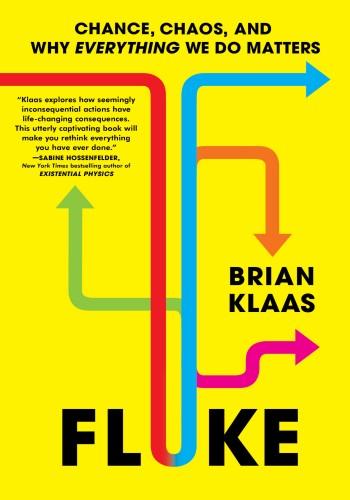
Fluke: Chance, Chaos, and Why Everything We Do Matters
by
Brian Klaas
Published 23 Jan 2024
children in China: A. Schachner et al., “Is the Bias for Function-Based Explanations Culturally Universal? Children from China Endorse Teleological Explanations of Natural Phenomena,” Journal of Experimental Child Psychology 157 (2017): 29–48. apophenia: See, for example, S. Fyfe et al., “Apophenia, Theory of Mind and Schizotypy: Perceiving Meaning and Intentionality in Randomness,” Cortex 44 (10) (2008): 1316–25. “hot hand fallacy”: P. Ayton and I. Fischer, “The Hot Hand Fallacy and the Gambler’s Fallacy: Two Faces of Subjective Randomness?,” Memory & Cognition 32 (2004): 1369–78. “cannot deal with Chaos”: Suzanne Langer, Philosophy in a New Key: A Study in the Symbolism of Reason, Rite, and Art (Cambridge, MA: Harvard University Press, 1996).
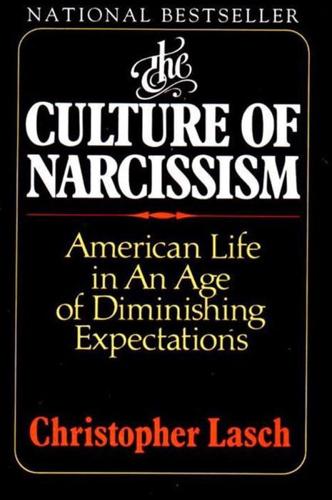
The Culture of Narcissism: American Life in an Age of Diminishing Expectations
by
Christopher Lasch
Published 1 Jan 1978
Hill. Christopher, xvn Hill, Napoleon; on love of money, 58 gallantry; decline of, 189-90 games, 100 ff. Hiss, Alger, 79 historical time; "irrelevance" of, xiv, also see continuity, history Freud, Sigmund, xiv, 34,35 n., 36, 37, 39,41,42, 162, 179, 193; on psychic impotence, 204: structural theory of mind, 32 Friedenberg, EdgarZ.: on high schools. 182 Fromm, Erich: on individualism 31-3; on market. gamesman, 61-2. 185-6. as narcissist. 45-7 general educal ion. 145. 151 Generation of Vipers (Wylie). 204 generations; see continuity Hobbes.Thomas,49,69 Genet. Jean. 89 Hollingshead, August: on decline of exclusive attach- geriatrics. 207 gerontology. 207. 215 Gerzon.

The Road to Ruin: The Global Elites' Secret Plan for the Next Financial Crisis
by
James Rickards
Published 15 Nov 2016
Rogers: Laura Hautala, “We’re Fighting an Invisible War—in Cyberspace,” CNET, March 5, 2016, accessed August 9, 2016, www.cnet.com/news/were-fighting-an-invisible-war-in-cyberspace/. Selected Sources ARTICLES De Martino, Benedetto, John P. O’Doherty, Debajyoti Ray, Peter Bossaerts, and Colin Camerer. “In the Mind of the Market: Theory of Mind Biases Value Computation during Financial Bubbles.” Neuron Vol. 79, 1222–31, September 18, 2013. Henriksson, Roy D., and Robert C. Merton. “On Market Timing and Investment Performance. II. Statistical Procedures for Evaluating Forecasting Skills.” The Journal of Business, Vol. 54, No. 4, October 1981.
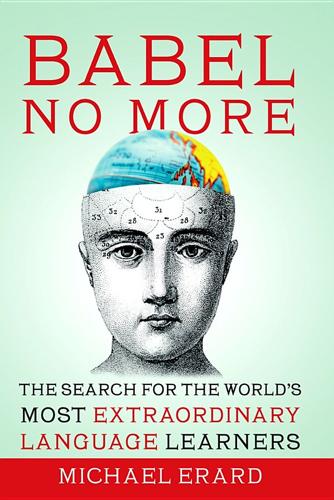
Babel No More: The Search for the World's Most Extraordinary Language Learners
by
Michael Erard
Published 10 Jan 2012
And he got stumped when trying to learn an artificial language with a word whose meaning depended on where it was placed in a sentence. What does this remarkable man have to do with the rest of us? To Smith and Tsimpli, his case means that language learning doesn’t require some traits we take for granted, such as good general learning abilities, average cognition, and a theory of mind. Critics suggest that the only people who would want to perform like Christopher would be those who’d be satisfied with calquing their mother tongues—even though many language learners would happily accept his memory and skills at parsing and assembling words. This shows why language learning isn’t purely a memory feat: you have to make word orders more automatic than you can consciously retrieve through, say, a mnemonic.

Rage Inside the Machine: The Prejudice of Algorithms, and How to Stop the Internet Making Bigots of Us All
by
Robert Elliott Smith
Published 26 Jun 2019
In particular, when did people begin to think that massive networks of simple computations held such vital power? I imagine that it is not a coincidence that the painting connects the idea of symbol association to the brain’s startling ability to decipher optical illusions like the Dalmatian. Associationism was a theory of mind that Dali was familiar with. Although associationism is a line of thought that descends from antiquity, it was eighteenth-century philosopher and psychologist David Hartley who developed it into a modern school of thought by founding the associationist school of psychology. This school posited that all human thought was triggered by sensations, which caused ‘vibrations’ in the brain.
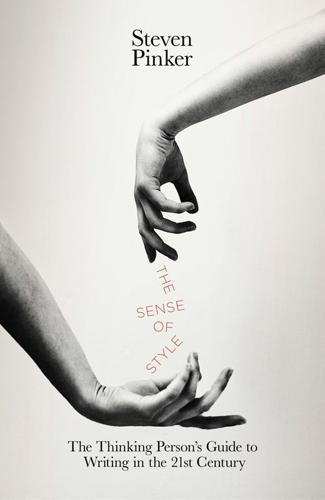
The Sense of Style: The Thinking Person's Guide to Writing in the 21st Century
by
Steven Pinker
Published 1 Jan 2014
There is egocentrism, the inability of children to imagine a simple scene, such as three toy mountains on a tabletop, from another person’s vantage point.4 There’s hindsight bias, the tendency of people to think that an outcome they happen to know, such as the confirmation of a disease diagnosis or the outcome of a war, should have been obvious to someone who had to make a prediction about it before the fact.5 There’s false consensus, in which people who make a touchy personal decision (like agreeing to help an experimenter by wearing a sandwich board around campus with the word REPENT) assume that everyone else would make the same decision.6 There’s illusory transparency, in which observers who privately know the backstory to a conversation and thus can tell that a speaker is being sarcastic assume that the speaker’s naïve listeners can somehow detect the sarcasm, too.7 And there’s mindblindness, a failure to mentalize, or a lack of a theory of mind, in which a three-year-old who sees a toy being hidden while a second child is out of the room assumes that the other child will look for it in its actual location rather than where she last saw it.8 (In a related demonstration, a child comes into the lab, opens a candy box, and is surprised to find pencils in it.
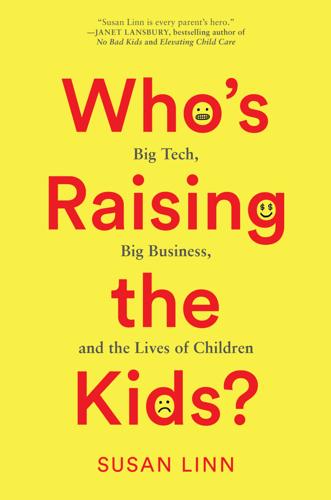
Who’s Raising the Kids?: Big Tech, Big Business, and the Lives of Children
by
Susan Linn
Published 12 Sep 2022
University of Sussex, “Pressure to Be Cool, Look Good Is Detrimental to Many Children,” ScienceDaily, September 11, 2015, www.sciencedaily.com/releases/2015/09/150911094908.htm. 32. Marvin E. Goldberg and Gerald J. Gorn, “Some Unintended Consequences of TV Advertising to Children,” Journal of Consumer Research 5, no. 1 (June 1, 1978): 22–29, doi.org/10.1086/208710. 33. Anna McAlister and T. Bettina Cornwell, “Children’s Brand Symbolism Understanding: Links to Theory of Mind and Executive Functioning,” Psychology and Marketing 27, no. 3 (February 11, 2010): 203–28, doi.org/10.1002/mar.20328. 34. High Fidelity, directed by Stephen Frears (2000; Burbank, CA: Touchstone Pictures). 35. Yalda T. Uhls, Eleni Zgourou, and Patricia M. Greenfield, “21st Century Media, Fame, and Other Future Aspirations: A National Survey of 9–15 Year Olds,” Cyberpsychology: Journal of Psychosocial Research on Cyberspace 8, no. 4 (2014), doi.org/10.5817/CP2014-4-5; Anna Maria Zawadzka et al., “Environmental Correlates of Adolescent Materialism: Interpersonal Role Models, Media Exposure, and Family Socio-economic Status,” Journal of Child and Family Studies, (December 6, 2021), doi.org/10.1007/s10826-021-02180-2. 36.
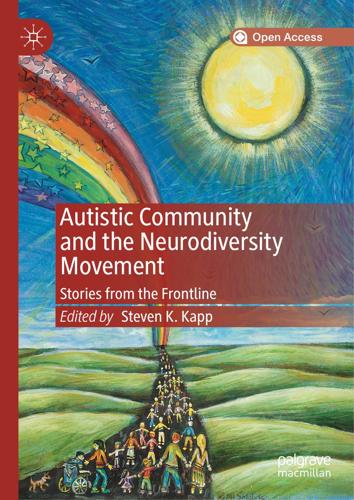
Autistic Community and the Neurodiversity Movement: Stories From the Frontline
by
Steven K. Kapp
Published 19 Nov 2019
New York, NY: Kensington Publishing Corp. 3. Frith, U. (2003). Autism: Explaining the enigma. Malden, MA: Blackwell Publishing. 4. Attwood, T. (1997). Asperger syndrome: A guide for parents and professionals. London, UK: Jessica Kingsley Publishers. 5. Baron-Cohen, S., & Cosmides, L. (1997). Mindblindness: An essay on autism and theory of mind. Cambridge, MA: MIT Press. 6. St. John’s University. (1999–2006). Autism and developmental disabilities list (Archived website). Retrieved from https://web.archive.org/web/ 20060113082637/http://maelstrom.stjohns.edu/archives/autism.html. 7. Blume, H. (1998, September). Neurodiversity: On the neurological underpinnings of geekdom.
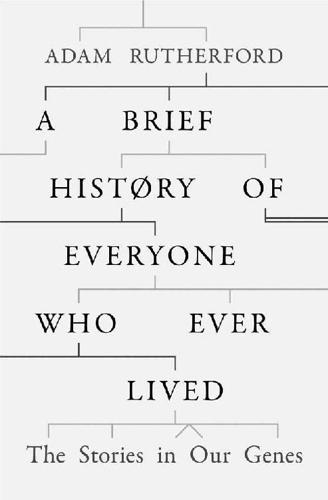
A Brief History of Everyone Who Ever Lived
by
Adam Rutherford
Published 7 Sep 2016
It happens with words like ‘quantum’, which offers up some magical scienceyness, none more so than in ‘quantum healing’ – an unfathomable extension of reiki, which, let’s face it, is a load of old cobblers already. The annexing of this word from fundamental physics also ranges from washing powder branding to the theory of mind. Lots of real scientific terms get borrowed for a spot of buzzword scienceyness. We see the same effect with the words ‘neuro-’ or ‘nano-’ added to almost anything. Neuromarketing, neuroentrepreneurism, neuropolitics are all new fields in which flaky science is used to put a patina of science onto a product.

Saturn's Children
by
Charles Stross
Published 30 Jun 2008
“Two hours, and we’ll be down! Whee!” Lindy squeezes. “Are you worried? Be happy! I can relax you!” On a rail. I have an archaic emulation mode in my fight/flight module. It makes me swallow, my throat dry. “Massage. Please.” Resolved: If I’m to die at a time not of my choosing, I will die happy. But Lindy’s theory of mind is too weak to model me, and so she takes me at my word. I arrive on Mercury butt first, scared witless, with my spine totally relaxed. Just as well, really. Mercury’s escape velocity is over four kilometers per second, and there’s no atmosphere to speak of. We are coming in at just over orbital velocity, without a thruster pack, and there can’t possibly be enough orbital tethers for this crowd.
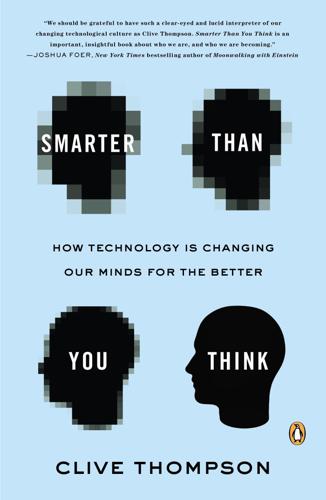
Smarter Than You Think: How Technology Is Changing Our Minds for the Better
by
Clive Thompson
Published 11 Sep 2013
Some began editing one another’s posts to remove local jargon, reasoning that foreigners wouldn’t understand the references to, for instance, New Zealand’s national rugby team: “People in America won’t know what the ‘All Blacks’ are,” one student admonished another. “They were writing for a global audience,” one local literacy researcher, Colleen Gleeson, tells me. These are acts of self-awareness that professional writers struggle with: forming a theory of mind of one’s audience, the better to communicate with it. Or as Burt adds when I interviewed her: “The blogging environment gave the students an audience that had a choice not to read. So if they do choose to read it it’s because they want to.” A year into the program, the New Zealand schools decided to expand the experiment dramatically, by finding a way to get every student a netbook.
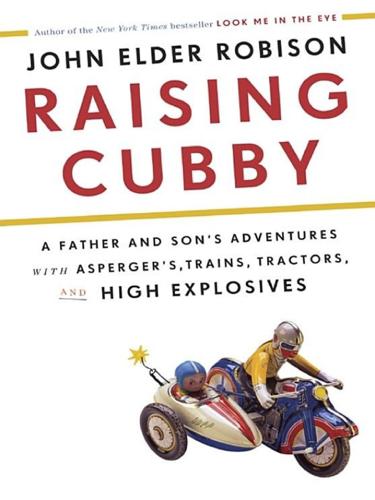
Raising Cubby: A Father and Son's Adventures With Asperger's, Trains, Tractors, and High Explosives
by
John Elder Robison
Published 12 Mar 2013
As we got ready for the trial, Cubby and I had several conversations about Asperger’s and the role it played in this chapter of our lives. It was obvious to me that Cubby’s Asperger’s had blinded him to how other people might see his videos. His inability to imagine that anyone might be frightened or worried was a perfect example of what psychologists call lack of a theory of mind. I realized that Asperger’s had blinded me too on more than one occasion. My desire for Cubby to be “better than me” had been so strong that I failed to recognize one of the chief hallmarks of autism: his fixation on one thing after another: Yu-Gi-Oh!, Pokémon, and finally, chemistry and explosives.
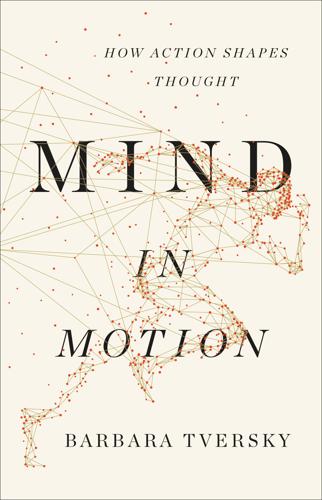
Mind in Motion: How Action Shapes Thought
by
Barbara Tversky
Published 20 May 2019
Animal Cognition, 16(2), 233–240. Romero, T., Konno, A., & Hasegawa, T. (2013). Familiarity bias and physiological responses in contagious yawning by dogs support link to empathy. PLoS One, 8(8), e71365. Saxe, R., & Kanwisher, N. (2003). People thinking about thinking people: The role of the temporo-parietal junction in “theory of mind.” Neuroimage, 19(4), 1835–1842. Waters, S. F., West, T. V., & Mendes, W. B. (2014). Stress contagion: Physiological covariation between mothers and infants. Psychological Science, 25(4), 934–942. Yong, M. H., & Ruffman, T. (2014). Emotional contagion: Dogs and humans show a similar physiological response to human infant crying.
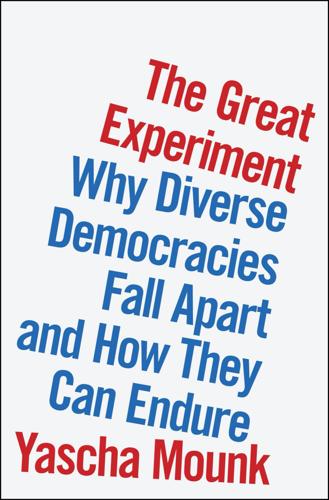
The Great Experiment: Why Diverse Democracies Fall Apart and How They Can Endure
by
Yascha Mounk
Published 19 Apr 2022
GO TO NOTE REFERENCE IN TEXT As Salman Rushdie once put it: Quoted in Robert Andrews, The Columbia Dictionary of Quotations (New York: Columbia University Press, 1993), 531. GO TO NOTE REFERENCE IN TEXT prove the benefits of literature: David Comer Kidd and Emanuele Castano, “Reading Literary Fiction Improves Theory of Mind,” Science 342, no. 6156 (October 2013): 377–80, https://science.sciencemag.org/content/342/6156/377.abstract?sid=f192d0cc-1443-4bf1-a043-61410da39519. GO TO NOTE REFERENCE IN TEXT Those who have a comparatively privileged: For an academic discussion of “standpoint epistemology,” see, for example, Sandra Harding, “Rethinking Standpoint Epistemology: What’s ‘Strong Objectivity?

Visual Thinking: The Hidden Gifts of People Who Think in Pictures, Patterns, and Abstractions
by
Temple Grandin, Ph.d.
Published 11 Oct 2022
The seventeenth-century philosopher René Descartes cast a long shadow when he wrote, “I think, therefore I am.” Specifically, Descartes claimed that it is language that separates us from “beasts”: our very humanity was predicated on language. Flash forward a few hundred years, and we are still describing theories of mind based primarily on language. In 1957, linguist Noam Chomsky published his groundbreaking book Syntactic Structures, which claims that language, specifically grammar, is innate. His ideas have influenced thinkers for more than half a century. The first step toward understanding that people think in different ways is understanding that different ways of thinking exist.
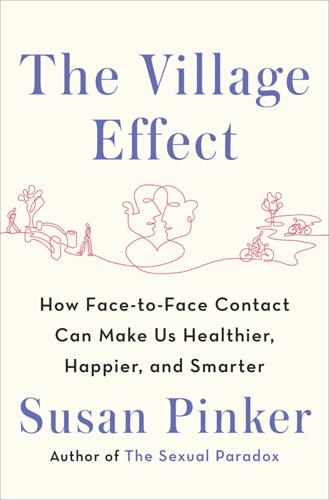
The Village Effect: How Face-To-Face Contact Can Make Us Healthier, Happier, and Smarter
by
Susan Pinker
Published 30 Sep 2013
Given that Amanda Lenhart, from the Pew Center, has shown that teens communicate more through texts than through any other medium, including in-person socializing, it is important to convey that texts don’t always do the trick. Amanda Lenhart, Teens, Smartphones & Texting (Washington, D.C.: Pew Internet and American Life Project, 2012). 54. Ted Ruffman et al., “What Mothers Say and What They Do: The Relation Between Parenting, Theory of Mind, Language and Conflict/Cooperation,” British Journal of Developmental Psychology 24 (2006). 55. Barbara Schneider and L. J. Waite, eds., Being Together, Working Apart (Cambridge: Cambridge University Press, 2005). 56. B. Campos et al., “Opportunity for Interaction? A Naturalistic Observation Study of Dual-Earner Families after Work and School,” Journal of Family Psychology 23, no. 6 (2009). 7.
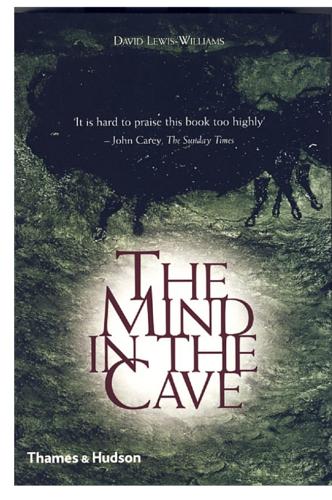
The Mind in the Cave: Consciousness and the Origins of Art
by
David Lewis-Williams
Published 16 Apr 2004
The Prehistory of the Mind: A Search for the Origins of Art, Religion and Science. London & New York: Thames & Hudson. Mithen, S. 1996b. Domain-specific intelligence and the Neanderthal mind. In Mellars, P. & Gibson, K. (eds) Modelling the Early Human Mind, pp. 217–29. Cambridge: McDonald Institute Monographs. Mithen, S. 1998. A creative explosion? Theory of mind, language and the disembodied mind of the Upper Palaeolithic. In Mithen, S. (ed.) Creativity in Human Evolution and Prehistory, pp. 165–91. London & New York: Routledge. Moorhead, A. 1969. Darwin and the Beagle. London: Hamish Hamilton. Mulkay, M. 1979. Science and the Sociology of Knowledge.

Stolen Focus: Why You Can't Pay Attention--And How to Think Deeply Again
by
Johann Hari
Published 25 Jan 2022
GO TO NOTE REFERENCE IN TEXT “the medium is the message”: Gerald Emanuel Stern, ed., McLuhan: Hot & Cool (New York: Dial Press, 1967), 20, 23, 65, 212–13, 215. GO TO NOTE REFERENCE IN TEXT one of his studies found that the more a child is read storybooks: R. A. Mar et al., “Exposure to Media and Theory-of-Mind Development in Preschoolers,” Cognitive Development 25, no. 1 (2010): 69–78. GO TO NOTE REFERENCE IN TEXT One of his studies showed that children are more empathetic if they read storybooks or watch movies, but not if they watch shorter shows: Ibid. GO TO NOTE REFERENCE IN TEXT CHAPTER FIVE: CAUSE FIVE “everyone knows what attention is”: W.

These Strange New Minds: How AI Learned to Talk and What It Means
by
Christopher Summerfield
Published 11 Mar 2025
Available at http://arxiv.org/abs/2302.13971 (accessed 23 October 2023). Turner, M. S. et al. (2008), ‘Confabulation: Damage to a Specific Inferior Medial Prefrontal System’, Cortex, 44(6), pp. 637–48. Available at https://doi.org/10.1016/j.cortex.2007.01.002. Ullman, T. (2023), ‘Large Language Models Fail on Trivial Alterations to Theory-of-Mind Tasks’, arXiv. Available at https://arxiv.org/pdf/2302.08399. Vaswani, A. et al. (2017), ‘Attention Is All You Need’. Preprint. arXiv. Available at http://arxiv.org/abs/1706.03762 (accessed 30 October 2020). Verzijden, M. N. et al. (2015), ‘Male Drosophila melanogaster Learn to Prefer an Arbitrary Trait Associated with Female Mating Status’, Current Zoology, 61(6), pp. 1036–42.

The Red Queen: Sex and the Evolution of Human Nature
by
Matt Ridley
Published 14 Aug 1993
As Pinker and Bloom put it, ‘Interacting with an organism of approximately equal mental abilities whose motives are at times outright [sic] malevolent makes formidable and ever-escalating demands on cognition.’35 If Tooby and Cosmides are right about mental modules, among the modules that were selected to increase in size by this intellectual chess tournament was the ‘theory of mind’ module, the one that enables us to read each other’s thoughts, together with the means to express our own thoughts through the language modules.36 There is plenty of good evidence for this idea when you look about you. Gossip is one of the most universal of human habits. No conversation between people who know each other well – fellow employees, fellow family members, old friends – ever lingers for long on any topic other than the behaviour, ambitions, motives, frailties and affairs of other absent – or present – members of the group.
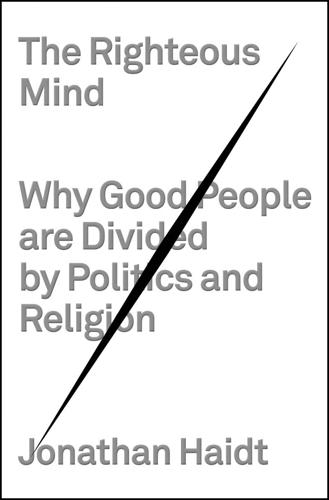
The Righteous Mind: Why Good People Are Divided by Politics and Religion
by
Jonathan Haidt
Published 13 Mar 2012
The Adapted Mind: Evolutionary Psychology and the Generation of Culture. New York: Oxford University Press. Baron, J. 1998. Judgment Misguided: Intuition and Error in Public Decision Making. New York: Oxford. ______. 2007. Thinking and Deciding. 4th ed. Cambridge, UK: Cambridge University Press. Baron-Cohen, S. 1995. Mindblindness: An Essay on Autism and Theory of Mind. Cambridge, MA: MIT Press. ______. 2002. “The Extreme Male Brain Theory of Autism.” Trends in Cognitive Sciences 6:248–54. ______. 2009. “Autism: The Empathizing-Systemizing (E-S) Theory.” In “The Year in Cognitive Neuroscience,” special issue of Annals of the New York Academy of Science 1156:68–80.
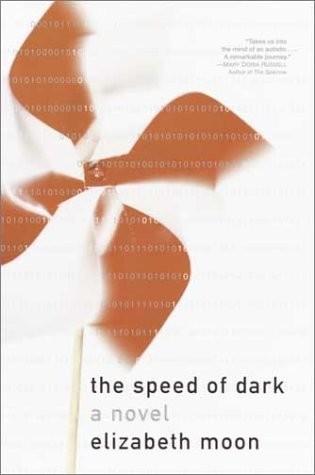
The Speed of Dark
by
Elizabeth Moon
Published 1 Jan 2002
Unsocial, lacking social skills, problems with attention control… I keep coming back to that. It is hard to think from their perspective, but I have the feeling that this attention control issue is at the middle of the pattern, like a black hole at the center of a space-time whirlpool. That is something else we are supposed to be deficient in, the famous Theory of Mind. I am a little early. No one else is parked outside yet. I pull up carefully so that there is the most room possible behind me. Sometimes the others are not so careful, and then fewer people can park without inconveniencing others. I could be early every week, but that would not be fair to others.
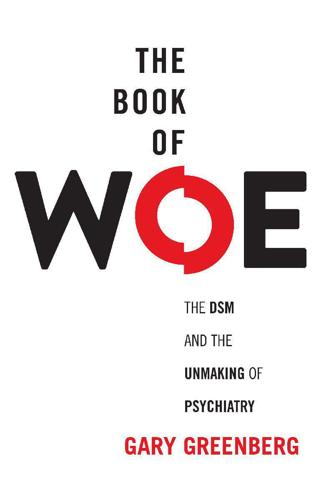
The Book of Woe: The DSM and the Unmaking of Psychiatry
by
Gary Greenberg
Published 1 May 2013
Spitzer hadn’t much liked the psychoanalytic training that had been required of him and most psychiatrists of his era, and he really didn’t like being an analyst. “I was uncomfortable with not knowing31 what to do with their [patients’] messiness,” he said. “I just didn’t know what the hell to do.” And it was obvious to him that Freud’s theory of mind was a poor substitute for pathological anatomy, and the complexes and resistances and defense mechanisms—the psychoanalyst’s stock-in-trade—were far too ungrounded in any kind of empirical reality to be useful. Proving the existence of ego, id, and superego was like proving the existence of the Holy Trinity.
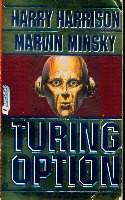
The Turing Option
by
Harry Harrison
and
Marvin Minsky
Published 2 Jan 1992
When he first proposed his theories—about how the mind is made of a number of different agencies—he gave them names like id, ego, superego, censor and so on. It is understood that every normal person is constantly dealing, unconsciously, with all sorts of conflicts, contradictions, and incompatible goals. That's why I thought you might get some feedback if you were to study Freud's theories of mind." "Sounds fine to me. Let's do it now, download all the Freudian theories into my memory banks." Snaresbrook was concerned. As a scientist, she still regarded the use of the implant computer as an experimental study—but Brian had already absorbed it as a natural part of his lifestyle. No more poring over printed texts for him.
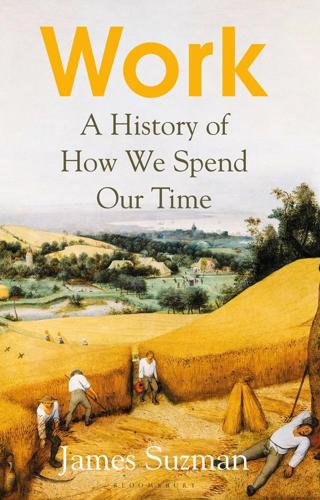
Work: A History of How We Spend Our Time
by
James Suzman
Published 2 Sep 2020
Many researchers interested in understanding our cognitive evolution have focused their efforts on revealing whether our closest primate relatives and other obviously smart creatures like whales and dolphins are capable of purposeful behaviour in the same way that humans are. Being purposeful requires an intuitive grasp of causality, the agility to imagine an outcome arising from an action, and so also implies having ‘a theory of mind’. Debates about how purposeful different animals are relative to humans remain as contested as ever. But a number of other animal species invite us to think differently about some less obvious aspects of the way we work. Among these are creatures like termites, bees and ants, in whose ceaseless industry and social sophistication we see echoes of the extraordinary changes to the way humans worked after they became cooperative food producers and later when they moved into cities.
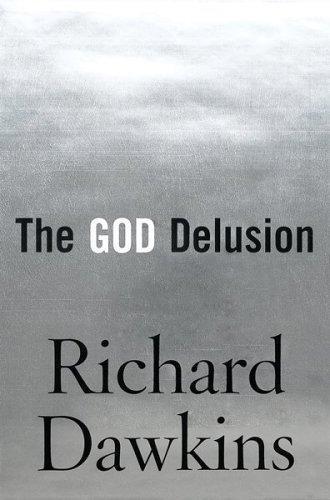
The God Delusion
by
Richard Dawkins
Published 12 Sep 2006
Any of these could serve as the human equivalent of the moths’ celestial navigation, vulnerable to misfiring in the same kind of way as I suggested for childhood gullibility. The psychologist Paul Bloom, another advocate of the ‘religion is a by-product’ view, points out that children have a natural tendency towards a dualistic theory of mind. Religion, for him, is a by-product of such instinctive dualism. We humans, he suggests, and especially children, are natural born dualists. A dualist acknowledges a fundamental distinction between matter and mind. A monist, by contrast, believes that mind is a manifestation of matter – material in a brain or perhaps a computer – and cannot exist apart from matter.
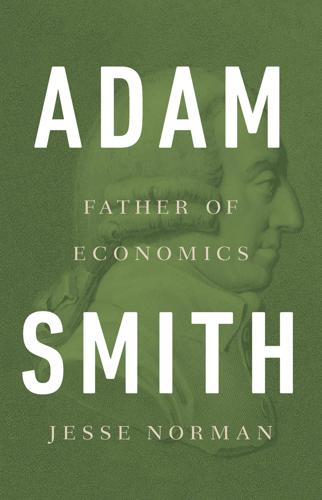
Adam Smith: Father of Economics
by
Jesse Norman
Published 30 Jun 2018
Smith’s subtle Newtonianism and open-ended view of scientific advance anticipate Peirce’s emphasis on the fixation of belief, on abductive theorizing and on truth as the limit of inquiry. Smith’s emphasis on sympathy, communicative exchange and the impartial spectator finds an echo in Peirce’s radical anti-Cartesianism, public theory of mind and triadic semiotic theory. For a broadly if unconsciously congruent psychology of human reason, see Hugo Mercier and Daniel Sperber, The Enigma of Reason: A New Theory of Human Understanding, Harvard University Press 2017 ‘The state of property must always vary with the form of government’: Part 1, ‘Of Justice’, LJ(B); this is one of the key lessons of the stadial theory Facebook and vulnerable teenagers: ‘Leaked document reveals Facebook conducted research to target emotionally vulnerable and insecure youth’, The Australian, 1 May 2017; response by Facebook on https://newsroom.fb.com /news/h/comments-on-research-and-ad-targeting/.

The Hype Machine: How Social Media Disrupts Our Elections, Our Economy, and Our Health--And How We Must Adapt
by
Sinan Aral
Published 14 Sep 2020
Lieberman, Social: Why Our Brains Are Wired to Connect (New York: Oxford University Press, 2013). The false belief test: Daniel C. Dennett, Brainstorms: Philosophical Essay on Mind and Psychology (Montgomery, Ala.: Harvester Press, 1978). Sally-Anne task: Simon Baron-Cohen, Alan M. Leslie, and Uta Frith, “Does the Autistic Child Have a ‘Theory of Mind’?,” Cognition 21, no. 1 (1985): 37–46. “varied parametrically with both”: Penelope A. Lewis et al., “Ventromedial Prefrontal Volume Predicts Understanding of Others and Social Network Size,” Neuroimage 57, no. 4 (2011): 1624–29. recorded which regions of their brains lit up: Lauren E.

From Counterculture to Cyberculture: Stewart Brand, the Whole Earth Network, and the Rise of Digital Utopianism
by
Fred Turner
Published 31 Aug 2006
In a series of articles and interviews over the next seven years, Brand presented Bateson to his readers much as he had presented Buckminster Fuller some years earlier. Brand’s Bateson was an intellectual seeker, an autodidact and polymath possessed of an orphic speaking style and a childlike curiosity. Just as his theories of mind gave CQ’s readers a way to rationalize their return to society, Bateson himself served as an emblem of a possible adulthood. Like Fuller and, for that matter, like McLuhan and Wiener, Bateson had found a way to bridge high technology and communitarian idealism and to build a flexible career around their intersection.
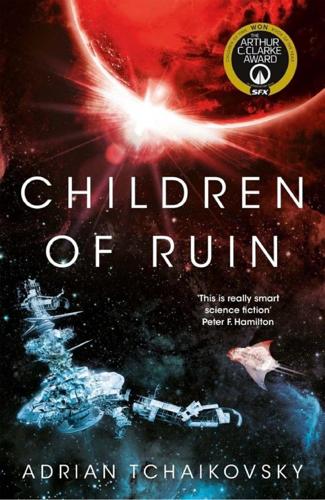
Children of Ruin
by
Adrian Tchaikovsky
Published 13 May 2019
Happiness is a universal, perhaps; or at least it was something the octopus read in that cackling face, and married to some state of its own. The octopus knew he was happy, and it loved him, or valued him, or felt something enough that his happiness was important to it. And that in itself is a miracle; that is the grand triumph Senkovi never grasped, that his creatures could empathize, could apply a theory of mind to entities quite unlike themselves, could be great-hearted enough to be happy that someone else was laughing, even if they couldn’t get the joke. She watches them for a long time, and then she turns the recordings off, lets the data lie fallow. She sits with her arms about her knees and stares at the solitary grey octopus in the next cell and feels unutterably sad.
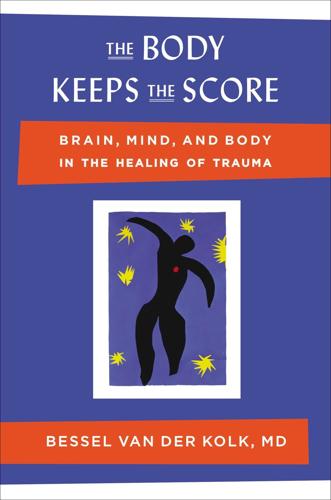
The Body Keeps the Score: Brain, Mind, and Body in the Healing of Trauma
by
Bessel van Der Kolk M. D.
Published 7 Sep 2015
D’Argembeau, et al., “Self-Reflection Across Time: Cortical Midline Structures Differentiate Between Present and Past Selves,” Social Cognitive and Affective Neuroscience 3, no. 3 (2008): 244–52; Y. Ma, et al., “Sociocultural Patterning of Neural Activity During Self-Reflection,” Social Cognitive and Affective Neuroscience 9, no. 1 (2014): 73–80; R. N. Spreng, R. A. Mar, and A. S. Kim, “The Common Neural Basis of Autobiographical Memory, Prospection, Navigation, Theory of Mind, and the Default Mode: A Quantitative Meta-Analysis,” Journal of Cognitive Neuroscience 21, no. 3 (2009): 489–510; H. D. Critchley, “The Human Cortex Responds to an Interoceptive Challenge,” Proceedings of the National Academy of Sciences of the United States of America 101, no. 17 (2004): 6333–34; and C.

Never Let a Serious Crisis Go to Waste: How Neoliberalism Survived the Financial Meltdown
by
Philip Mirowski
Published 24 Jun 2013
Quite a few perceptive historians of the NTC have worried that this Protean entity might be a little too variable to underwrite serious intellectual analysis.66 “There may therefore be a certain degree of truth in what might otherwise seem to be a sloppy and unprincipled claim, that neoliberalism has become omnipresent, but it is a complex, mediated and heterogeneous kind of omnipresence, not a state of blanket conformity. Neoliberalism has not simply diffused as a (self-) replicating system.”67 Granted, the ectoplasmic theory of mind control is usually a poor way to contemplate analysis of politics; yet the point remains that the neoliberal ground troops seem to be fully capable of recognizing kindred spirits, fostering intellectual interchange among allies, and more to the point, funding and organizing political movements with stable objectives and repetitive arguments even in the face of the global economic crisis.
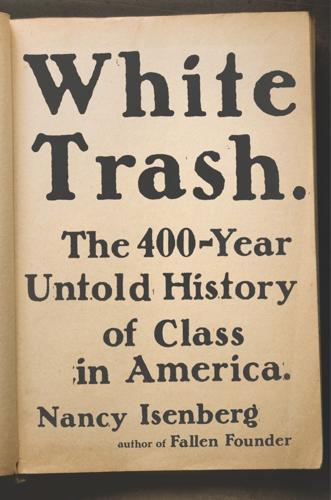
White Trash: The 400-Year Untold History of Class in America
by
Nancy Isenberg
Published 20 Jun 2016
On mothers conniving illicit liaisons for daughters and poor white women having sex with black men, see “The Low-Down People,” Putnam’s Magazine (June 1868): 704–13, esp. 705–6. On filthy refugees in boxcars, see Reid, After the War, 248; also see W. De Forest, “Drawing Bureau Rations,” Harper’s Monthly Magazine 36 (May 1868): 792–99, esp. 794, 799. On Herbert Spencer, see Robert J. Richards, Darwin and the Emergence of Evolutionary Theories of Mind and Behavior (Chicago: University of Chicago Press, 1987), 303–4; Spencer first used “survival of the fittest” in his Principles of Biology (London, 1864), 1:444, 455. On the popularity of Darwin and Spencer, see “The Theory of Natural Selection,” The Critic (November 26, 1859), 528–30; “Natural Selection,” [New Orleans] Daily Picayune, January 9, 1870.

How Emotions Are Made: The New Science of the Mind and Brain
by
Lisa Feldman Barrett
Published 6 Mar 2017
Dreger, Alice D., Cheryl Chase, Aron Sousa, Philip A. Gruppuso, and Joel Frader. 2005. “Changing the Nomenclature/Taxonomy for Intersex: A Scientific and Clinical Rationale.” Journal of Pediatric Endocrinology and Metabolism 18 (8): 729–734. Dreyfus, Georges, and Evan Thompson. 2007. “Asian Perspectives: Indian Theories of Mind.” In The Cambridge Handbook of Consciousness, edited by Philip David Zelazo, Morris Moscovitch, and Evan Thompson, 89–114. New York: Cambridge University Press. Drnevich, J., et al. 2012. “Impact of Experience-Dependent and -Independent Factors on Gene Expression in Songbird Brain.” Proceedings of the National Academy of Sciences of the United States of America 109: 17245–17252.

Power and Progress: Our Thousand-Year Struggle Over Technology and Prosperity
by
Daron Acemoglu
and
Simon Johnson
Published 15 May 2023
Cambridge, MA: Harvard University Press. Barlow, Frank. 1999. The Feudal Kingdom of England, 1042‒1216, 5th ed. London: Routledge. Baron, Joseph L. 1996. A Treasury of Jewish Quotations, rev. ed. Lanham, MD: Jason Aronson. Baron-Cohen, Simon, Alan M. Leslie, and Uta Frith. 1985. “Does the Autistic Child Have a ‘Theory of Mind’?” Cognition 21, no. 1: 37‒46. Barro, Robert, and Xavier Sala-i-Martin. 2004. Economic Growth. Cambridge, MA: MIT Press. Basu, Susanto, and David N. Weil. 1998. “Appropriate Technology and Growth.” Quarterly Journal of Economics 113, no. 4: 1025‒1054. Beatty, Charles. 1956. De Lesseps of Suez: The Man and His Times.
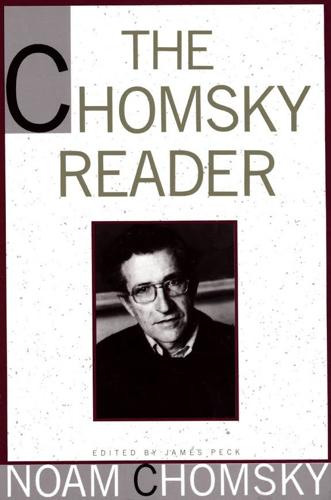
The Chomsky Reader
by
Noam Chomsky
Published 11 Sep 1987
Physics and biology, Skinner observes, “did not advance by looking more closely at the jubilance of a falling body, or … the nature of vital spirits, and we do not need to try to discover what personalities, states of mind, feelings, traits of character, plans, purposes, intentions, or the other perquisites of autonomous man really are in order to get on with a scientific analysis of behavior”; and we must neglect “supposed mediating states of mind” (p. 15). This is true enough, if indeed there are no mediating states that can be characterized by an abstract theory of mind, and if personalities, etc., are no more real than the jubilance of a falling body. But if the factual assumptions are false, then we certainly do need to try to discover what the “perquisites of autonomous man” really are and to determine the “mediating states of mind”—at least this is so if we wish to develop a science of human behavior with any intellectual content and explanatory force.

Ayn Rand and the World She Made
by
Anne C. Heller
Published 27 Oct 2009
She especially enjoyed talking to Nathaniel about psychology. Universities then favored Freudian psychoanalysis and behaviorism. Rand furiously disagreed with both. Freudianism seemed mystical to her; behaviorism was mechanical; and both lacked respect for the human will and the conscious mind. In conversations with him, she began to articulate her own theory of mind, based on her confidence in objective reality and her reverence for reason. She started with the concept of free will, which she defined not as freedom of decision and action, the usual definition, but as “the choice to think or not to think.” Thinking is tied to survival and is volitional, she argued; unlike animals with instincts, people must make the effort to think in order to obtain a steady supply of food, build shelter, make tools—and, eventually, create skyscrapers and trains.
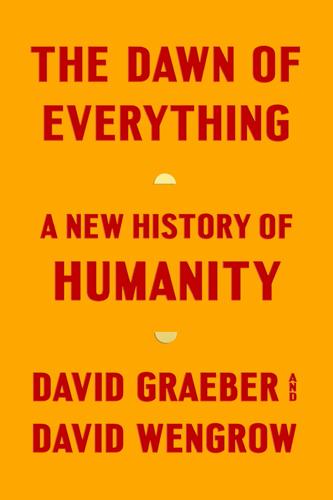
The Dawn of Everything: A New History of Humanity
by
David Graeber
and
David Wengrow
Published 18 Oct 2021
Ethnohistory 10: 233–49. Bloch, Maurice. 1977. ‘The past and the present in the present.’ Man (N.S.) 12 (2): 278–92. —. 2008. ‘Why religion is nothing special but is central.’ Philosophical Transactions of the Royal Society B 363: 2055–61. —. 2013. In and Out of Each Other’s Bodies: Theory of Mind, Evolution, Truth, and the Nature of the Social. Boulder, CO: Paradigm. Boas, Franz and George Hunt. 1905. Kwakiutl Texts. Publications of the Jesup North Pacific Expedition, vol. 3. Leiden: Brill. Boehm, Christopher. 1999. Hierarchy in the Forest: The Evolution of Egalitarian Behaviour.
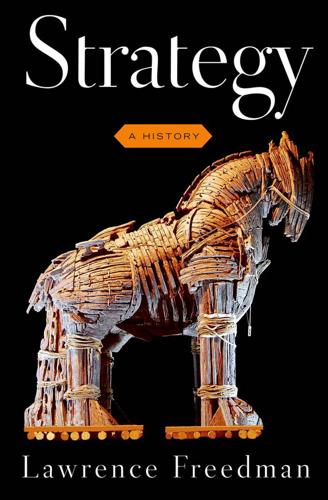
Strategy: A History
by
Lawrence Freedman
Published 31 Oct 2013
Abelson, Scripts, Plans, Goals and Understanding: An Inquiry into Human Knowledge Structures (Hillsdale, NJ: Erlbaum, 1977). 35. R. P. Abelson, “Script Processing in Attitude Formation and Decision-making,” in J. S. Carroll and J. W. Payne, eds., Cognition and Social Behavior (Hillsdale, NJ: Erlbaum, 1976). 36. M. Lyons, T. Caldwell, and S. Shultz, “Mind-Reading and Manipulation—Is Machiavellianism Related to Theory of Mind?” Journal of Evolutionary Psychology 8, no. 3 (September 2010): 261–274. 37. Mirowski, Machine Dreams, 424. 38. Alan Sanfey, “Social Decision-Making: Insights from Game Theory and Neuroscience,” Science 318, no. 5850 (October 2007): 598–602. 39. Stephen Walt, “Rigor or Rigor Mortis?” (see chap. 36, n. 14). 40.

Surfaces and Essences
by
Douglas Hofstadter
and
Emmanuel Sander
Published 10 Sep 2012
And thus a big thank-you to Jean Baratgin (whose specialty is the study of reasoning), Christelle Bosc-Miné (problem-solving), Rémi Brissiaud (educational psychology), Sandra Bruno (conceptual development), Anne-Sophie Deborde (attachment), Corinne Demarcy (problem-solving), Sabine Guéraud (understanding), Caroline Guérini (theory of mind), Frank Jamet (naïve reasoning), Hélène Labat (learning to read), Annamaria Lammel (cultural psychology), Jean-Marc Meunier (knowledge representation), Sandra Nogry (conceptual development), and Carine Royer (learning to read). Emmanuel’s doctoral students, current and former, have given much to him through their dedication and the freshness and openness of their thinking.
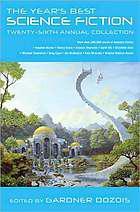
The Year's Best Science Fiction: Twenty-Sixth Annual Collection
by
Gardner Dozois
Published 23 Jun 2009
Keeping every Phite variant alive was impractical, but he did retain enough information to resurrect lost species at will. The maze of AI was still a maze, but the speed of the crystal served them well. Barely eighteen months after the start of Project Sapphire, the Phites were exhibiting a basic theory of mind: their actions showed that they could deduce what others knew about the world, as distinct from what they knew themselves. Other AI researchers had spliced this kind of thing into their programs by hand, but Daniel was convinced that his version was better integrated, more robust. Human-crafted software was brittle and inflexible; his Phites had been forged in the heat of change.

Artificial Intelligence: A Modern Approach
by
Stuart Russell
and
Peter Norvig
Published 14 Jul 2019
The confirmation theory of Rudolf Carnap (1891–1970) and Carl Hempel (1905–1997) attempted to analyze the acquisition of knowledge from experience by quantifying the degree of belief that should be assigned to logical sentences based on their connection to observations that confirm or disconfirm them. Carnap’s book The Logical Structure of the World (1928) was perhaps the first theory of mind as a computational process. The final element in the philosophical picture of the mind is the connection between knowledge and action. This question is vital to AI because intelligence requires action as well as reasoning. Moreover, only by understanding how actions are justified can we understand how to build an agent whose actions are justifiable (or rational).